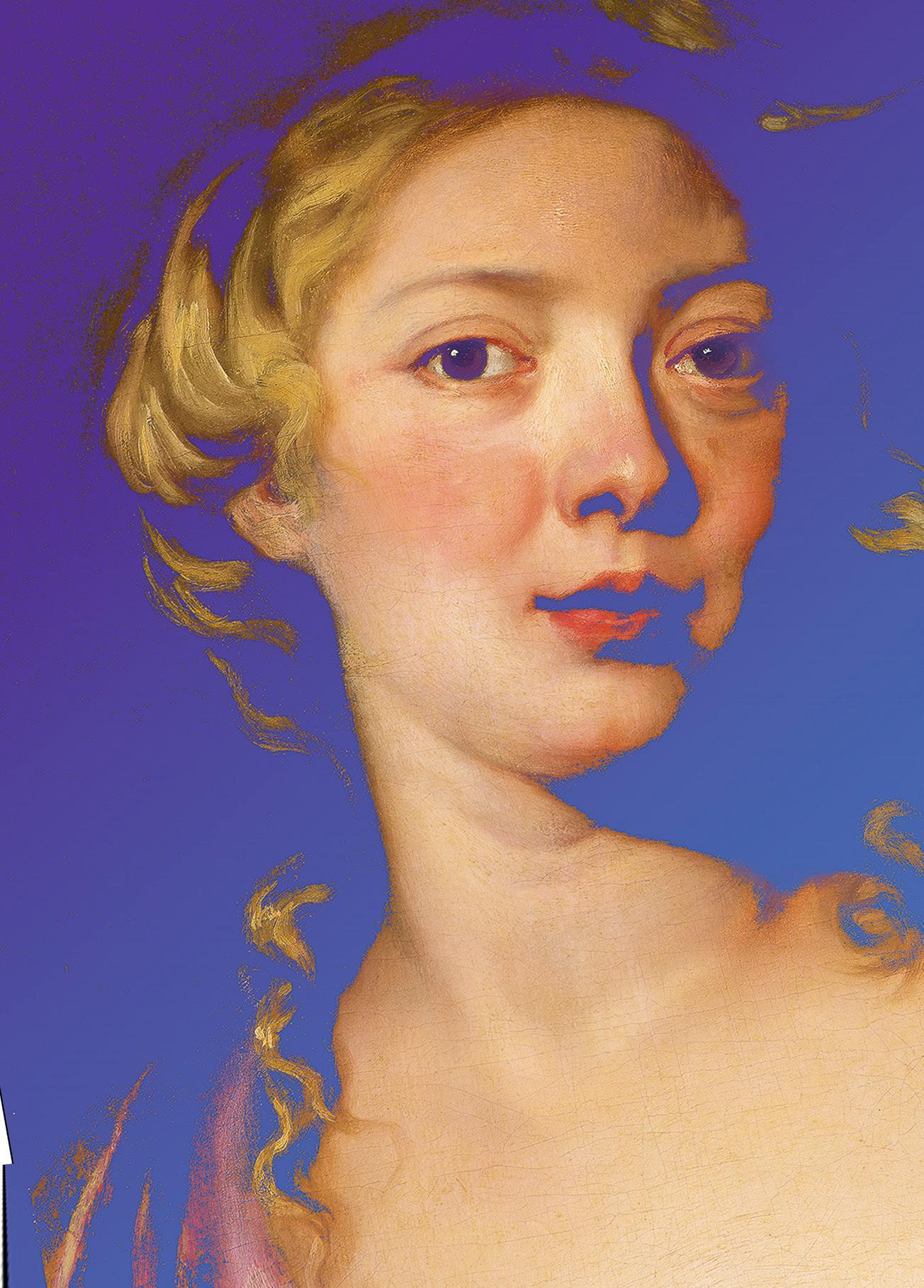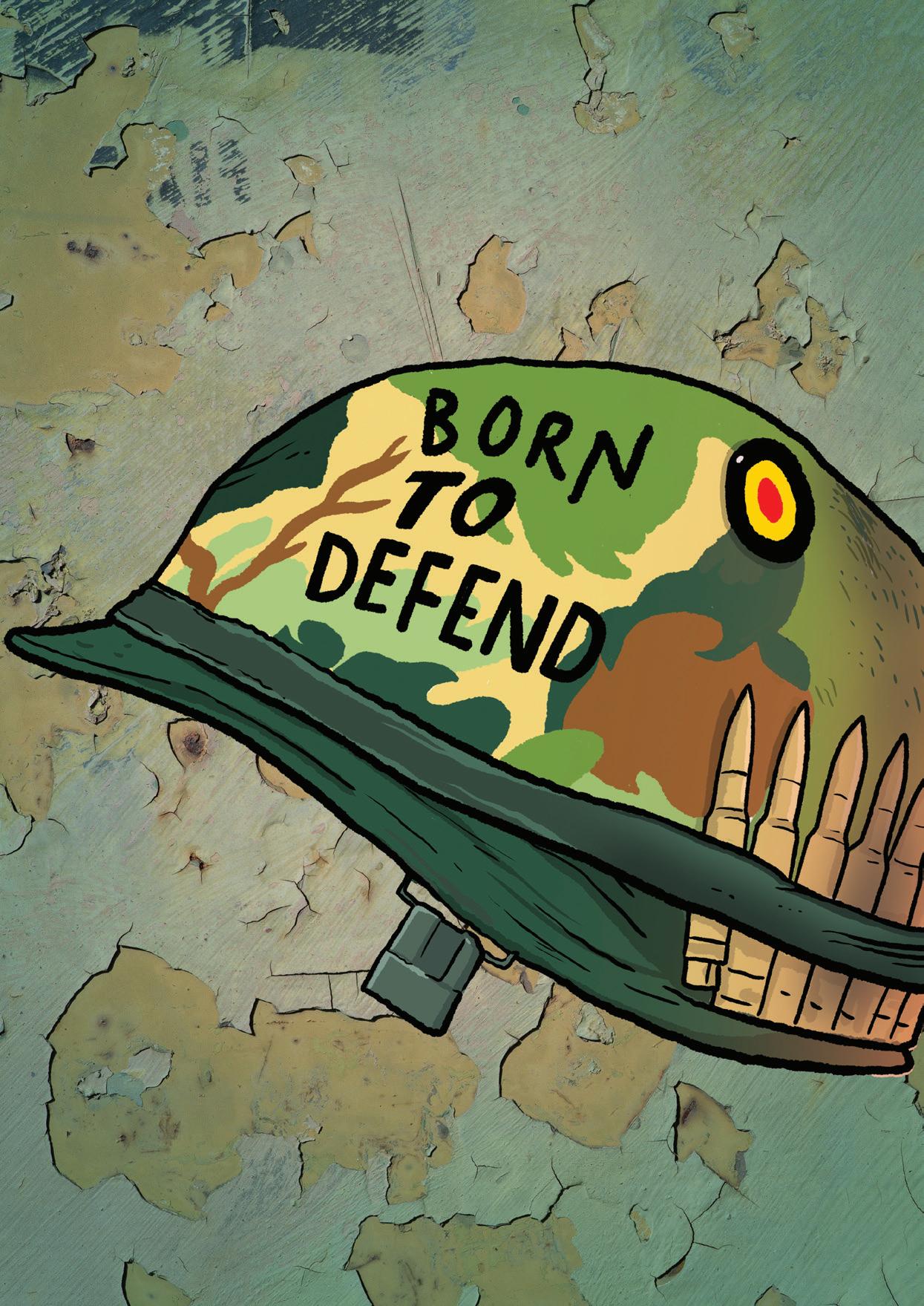
The Dardennes' guide to grit, silence and unexpected joy Blades beat fossils: Why Belgium is betting on wind
The North Sea horseback shrimp riders




The Dardennes' guide to grit, silence and unexpected joy Blades beat fossils: Why Belgium is betting on wind
The North Sea horseback shrimp riders



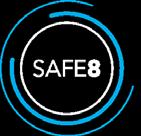




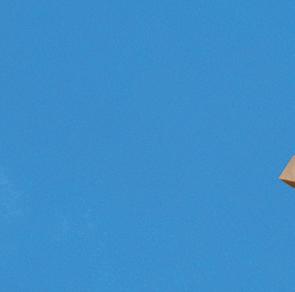
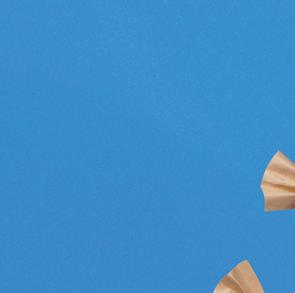


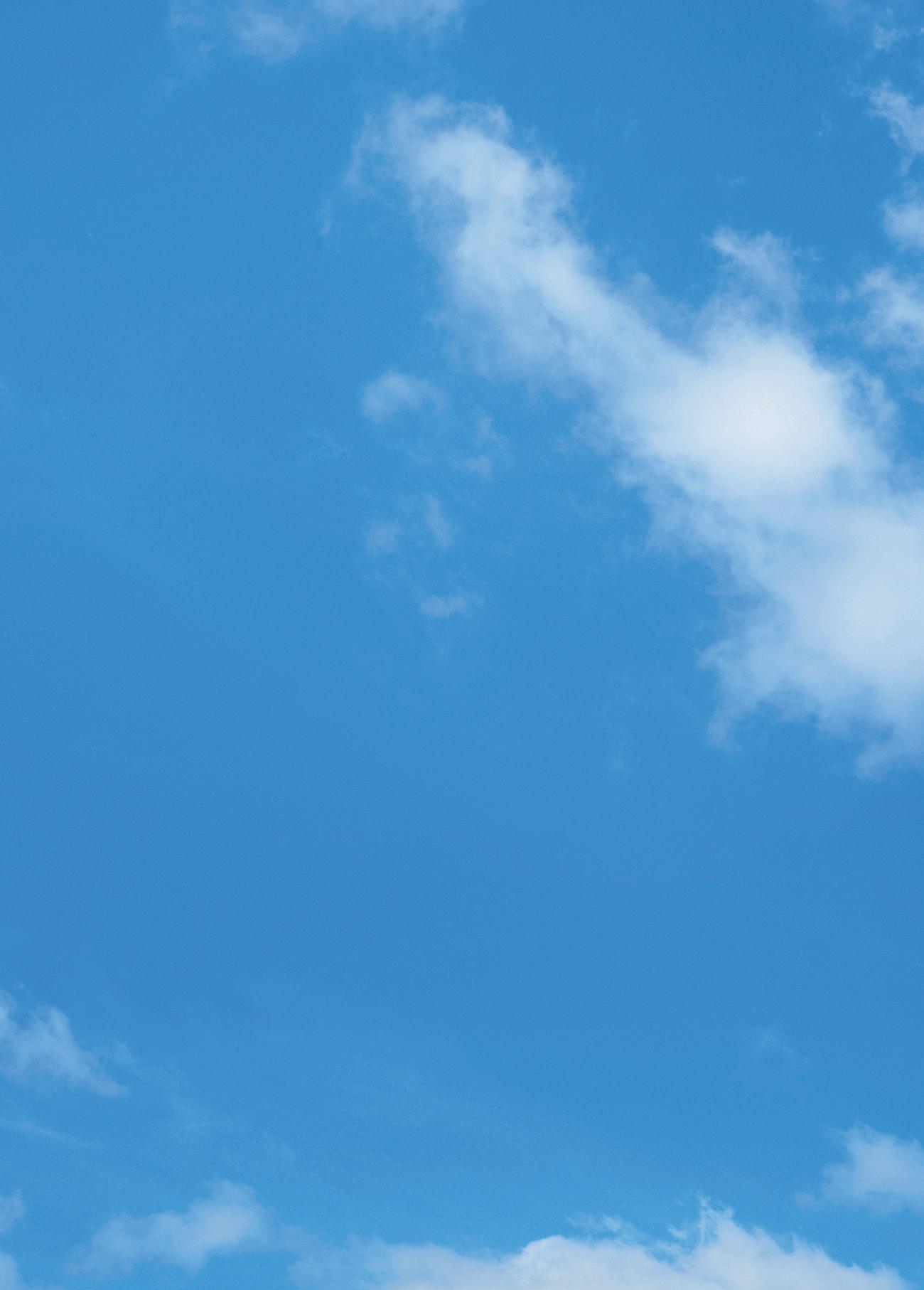

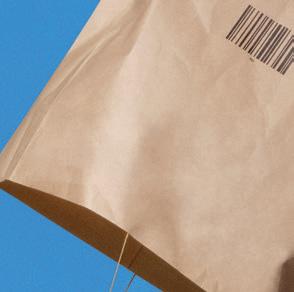

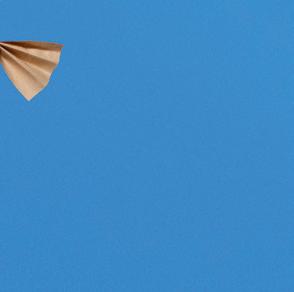
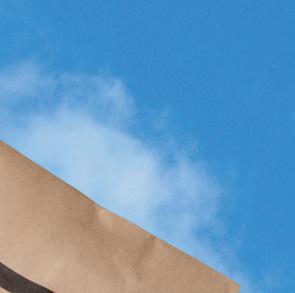
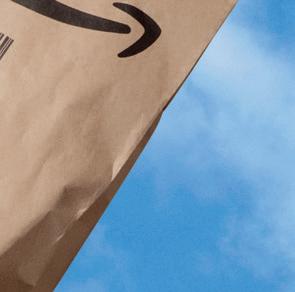
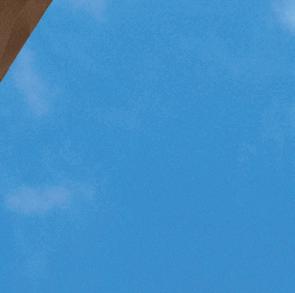
We’ve made our packaging lighter.
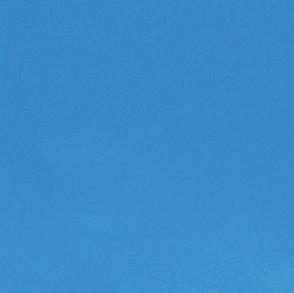
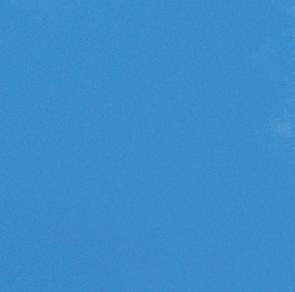
As part of our sustainability efforts we’ve reduced the weight of our packaging by more than 40%* .
*average weight per delivery since 2015. Visit aboutamazon.eu/sustainability
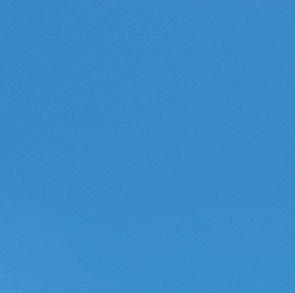

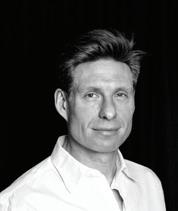
Belgium’s most paradoxical export isn’t beer, chocolate or surrealism. It’s firepower.
A trip to the FN Browning weapons plant in Herstal, the country’s quietly world-class arms factory, reveals more than just precision engineering. It’s a crash course in Europe’s rearmament angst. A continent that dreams of peace, dithers over policy and reluctantly reaches for a gun — made in Wallonia. FN’s assault rifles may be sleek, but Europe’s defence strategy is still a work in progress.
At FN, pacifism is welded to pragmatism. High ideals meet hard steel. The aim is to build up defences through deterrence. As Jon Eldridge reports from the workshops in Herstal, FN is bracing itself to meet the moment (cover by 2024 European Cartoon Award winner Lectrr).
We also have commentaries on the challenges Belgium faces to rebuild its defences after decades of decline, from retired Belgian army Lieutenant-General Marc Thys and Egmont fellow Wannes Verstraete
Staying in Liège, Dennis Abbott meets the Dardennes brothers, whose awardwinning movies, mostly set in the Seraing neighbourhood, have shone a light on gritty personal dramas.
Belgium’s ambitions for wind power are tangled in red tape, regional rivalries — and even Dutch accusations of meteorological theft, but as Dafydd Ab Iago reports, the country is slowly building its wind capabilities. Meanwhile, as technology catches up with snail mail, Derek Blyth wonders how the Belgian postal service can survive the modern era.
As universities in the US face unprecedented threats from the Trump administration, Philippe Van Parijs, a veteran of both Harvard and Leuven universities, looks at how Belgium has dealt with questions of academic freedom.
On the edge of the forest, the Tournay-Solvay Park in Boitsfort is a hidden gem in Brussels. David Labi ventures into the green idyll and admires the once-crumbling château at its heart, now restored as a research facility. David also previews the new galleries in the Art & History Museum in the Cinquantenaire that celebrate Art Nouveau and Art Deco.
Antoine Courtens created some of the most memorable buildings in Brussels, and they are receiving renewed recognition in this centenary year of Art Deco as Frédéric Moreau writes. Simon Taylor, meanwhile, discovers how Renaissance polyphonists created new sounds as the Museum of the Royal Library of Belgium (KBR) reopens.
Angela Dansby takes a weekend break to Hasselt, which fancies itself as a fashion city along the Albert Canal. And she reports from the coast on the hallowed tradition of horseback shrimp fishermen (and fisherwomen). Also at the beach is photographer Jorge Gutierrez Lucena, who offers a perspective on the dunes, piers, hotels, monuments, amusement parks and forgotten campsites.
Having exhausted the entire Brussels tram network in his travel dispatches, Hugh Dow embarks on a new role as our Senior Cemetery Correspondent, beginning with the Laeken graveyard, and the Salu funerary workshop.
Breandán Kearney examines how Belgian brewers are meeting the challenge of becoming more sustainable; Hughes Belin tries out the Frank restaurant, SCOB tea, Kafei café and Nats Rawline cakes – and checks out the newly-opened Frietmuseum; while Kurt Karlsson highlights current and upcoming events worth checking out.
And finally, Geoff Meade returns to his old hunting ground, the Berlaymont, as the Eurocrat HQ opens its doors to the hoi polloi on Europe Day.
Leo Cendrowicz
Editor, The Brussels Times Magazine
Summer 2025
The Brussels Times Avenue Louise 54
1050 Brussels
+32 (0)2 893 00 67
info@brusselstimes.com
ISSN Number: 0772-1633
On the Cover Illustration by Lectrr
Editor Leo Cendrowicz
Publishers
Jonadav Apelblat
Omry Apelblat
Graphic Designer Marija Hajster
Contributors
Dafydd Ab Iago, Dennis Abbott, Hughes Belin, Derek Blyth, Angela Dansby, Hugh Dow, Jon Eldridge, Jorge Gutierrez Lucena, Kurt Karlsson, Breandán Kearney, David Labi, Lectrr, Geoff Meade, Frédéric Moreau, Simon Taylor, Marc Thys, Philippe Van Parijs, Wannes Verstraete
Commercial Partnerships Director
David Young
Advertising
Caroline Dierckx
Nataliya Moroz
Klaas Olbrechts
Ilham Rzayev
Gidon Tannenbaum
Please contact us on advertise@brusselstimes.com or +32 (0)2 893 00 67 for information about advertising opportunities.
Photo Credits
Lectrr: Cover, 144 Belga: 6-3, 31, 40-44, 131-132
Angela Dansby: 6, 80-82, 85-85, 111-116
Ars Mechanica: 18, 22-23
FN Browning: 6, 18-21, 21, 23
Bpost: 28
Leo Cendrowicz: 32, 76-79, 114, 119-123
Christine Plenus: 58-60, 64, 65
© Sofhie Legein - Municipality of Koksijde: 83
Jorge Gutierrez Lucena: 86-87
Admirable Facades/Jean Jacques EVRARD: 90-92, 94-95
Art & History Museum: 100-105
Royal Library of Belgium (KBR): 106-107
123RF: 124-125, 130
European Commission: 145-146

17
Trigger points: How FN Browning could lead Europe’s rearmament
Jon Eldridge
26 How many more wake-up calls do we need?
Wannes Verstraete
27 Why Belgium needs to rearm
Marc Thys
29 The last post: Can the Belgian postal service survive the digital age?
Derek Blyth
41 Why Belgium’s energy future is blowing in the wind
Dafydd Ab Iago
49 Academics under attack: When professors are pushed out
Philippe Van Parijs
59 Roll camera, cue grit: The Dardennes keep it real
Dennis Abbott
71 The recycled city
David Labi
77 Park apart: The forgotten gardens of Tournay-Solvay
David Labi
81 Shrimp riders of the North Sea
Angela Dansby
86 Along the Belgian coastline
Jorge Gutierrez Lucena
91 The Art Deco disciple: Antoine Courtens reclaimed
Frédéric Moreau
101 Echoes in bronze and glass: Inside the lavish revival of Belgium’s Art Nouveau and Art Deco heritage
David Labi
106 A Golden Age reheard
Simon Taylor
111 Sass in Hasselt
Angela Dansby
119 Stone, silence and solstice light: The hidden histories of Laeken Cemetery
Hugh Dow
125 From grain to green: The sustainable shift in Belgian brewing
Breandán Kearney
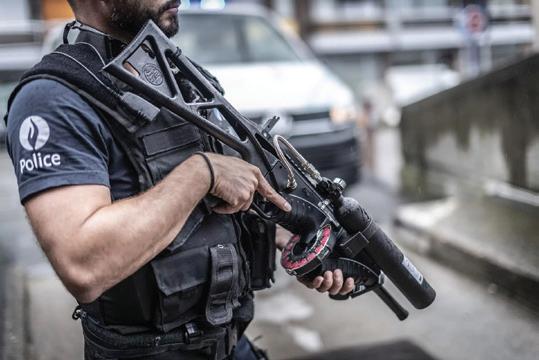
130 Golden obsession: How Belgium built a culture around chips
Hughes Belin
134 Food & Drink
Hughes Belin
138 Art and events
Kurt Karlsson
144 Ursula, Moomins and me: My day in the Eurocrat funhouse
Geoff Meade
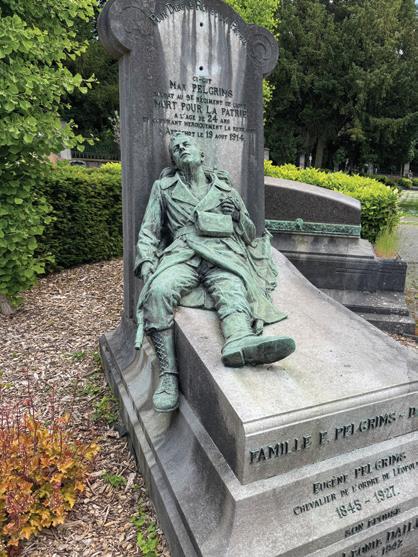
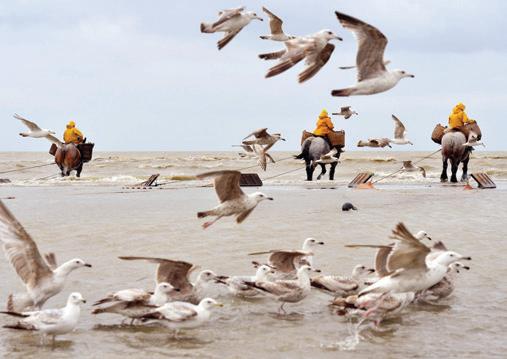
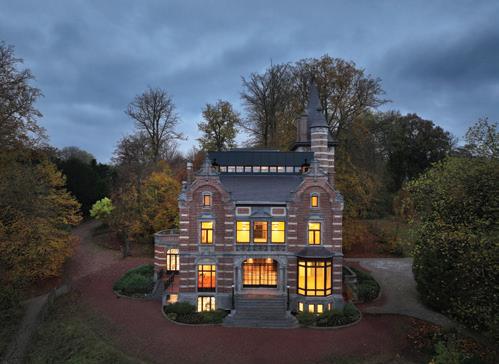
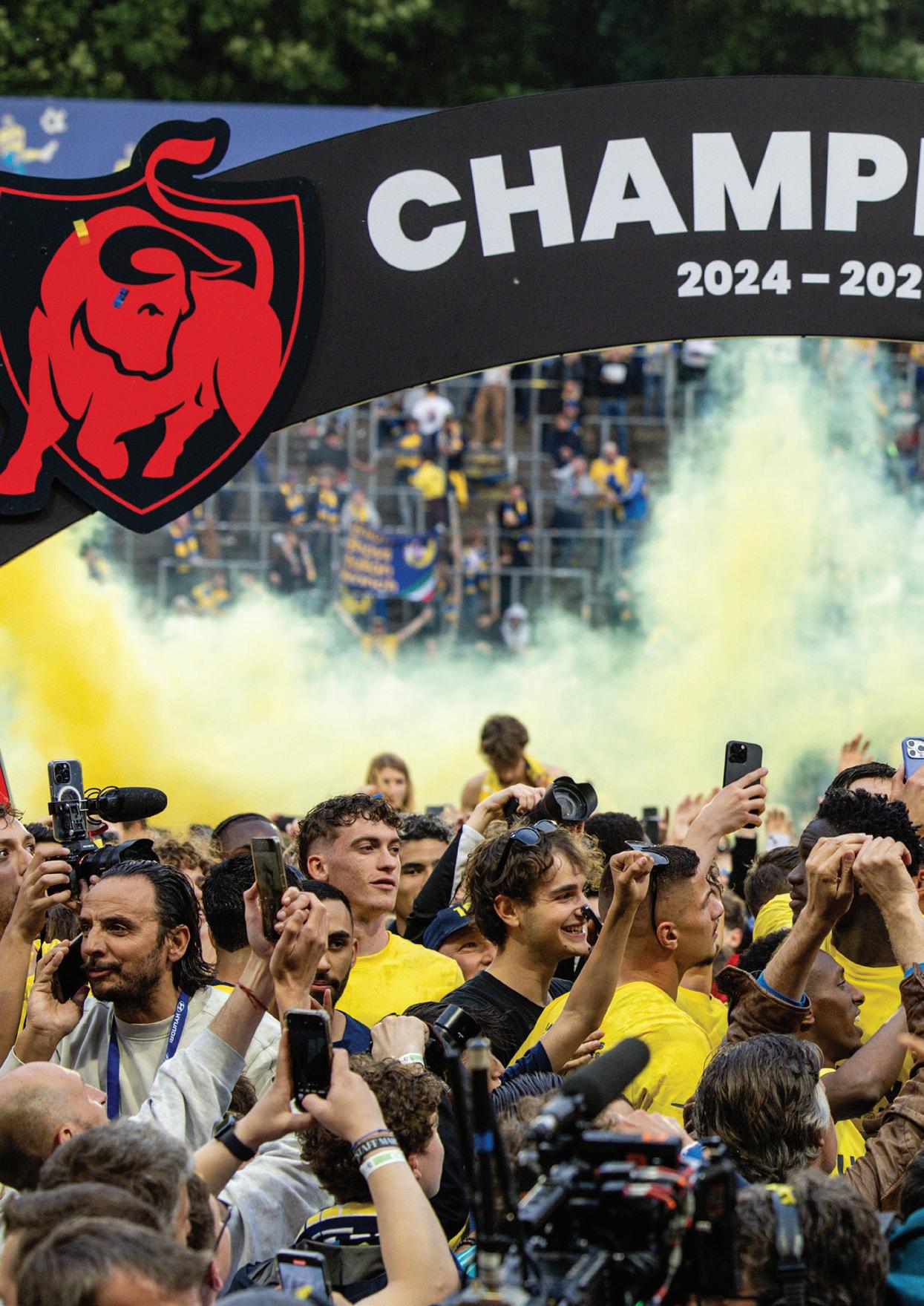
Royale Union Saint-Gilloise star Promise David celebrates with his teammates after securing the Jupiler Pro League title on the last day of the season. It was the first time Union had been Belgian champions since 1935. The club, whose Joseph Marien stadium is next door to Saint-Gilles, in Forest, only returned to the Belgian Pro League in 2021, after 48 years outside Belgium’s top tier. Next season, they will play the likes of Barcelona, Liverpool and Bayern Munich.


A riot of colour on legs, the Brussels Pride parade sashayed through the city with all the subtlety of a disco ball in a library. Sequins shimmered, flags fluttered and somewhere beneath a feather boa, someone was almost certainly quoting Cher. It’s part protest, part party, all pageantry — a jubilant reminder that LGBTQIA+ visibility never goes out of fashion, and that love, when properly accessorised, really does conquer all.
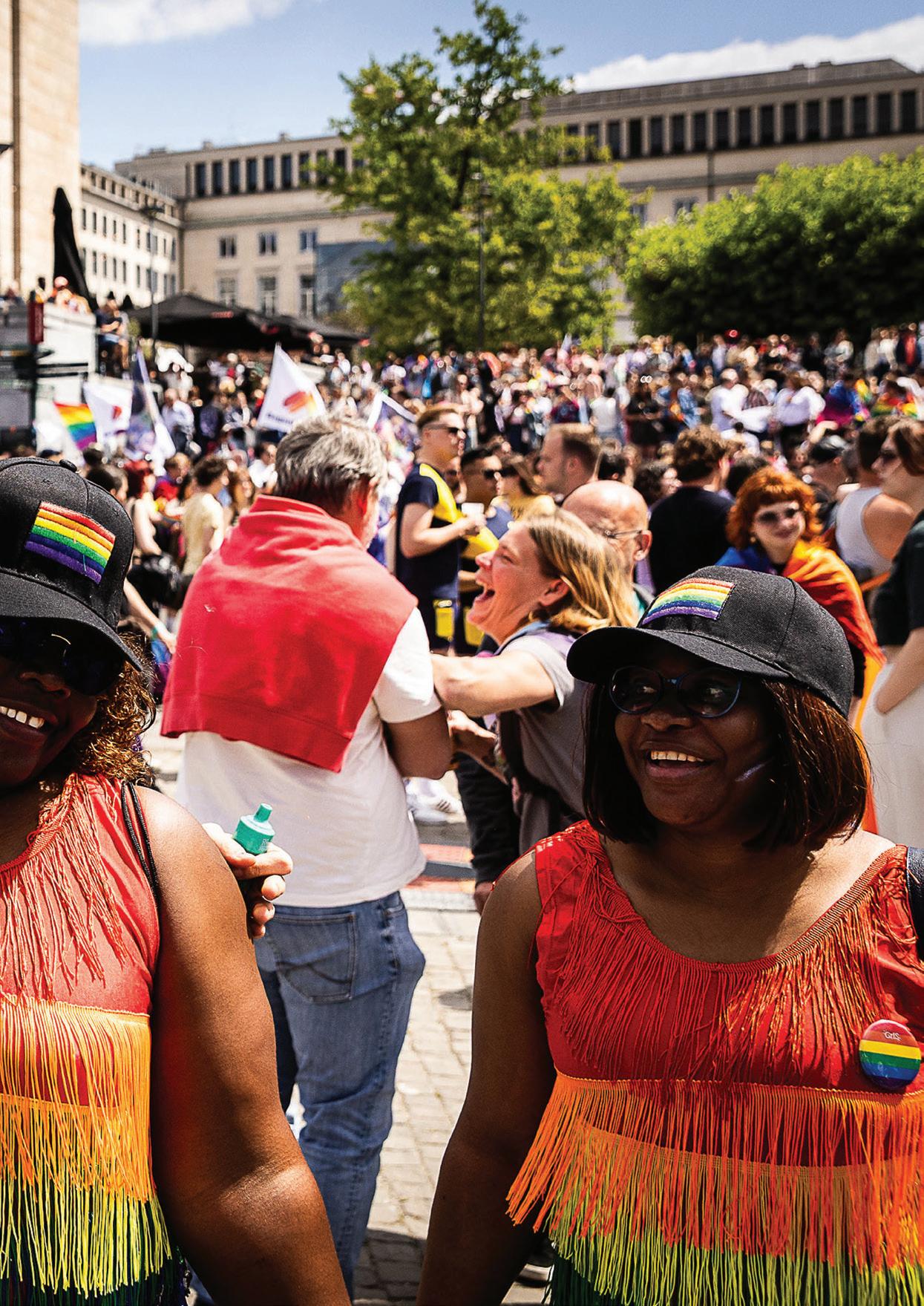
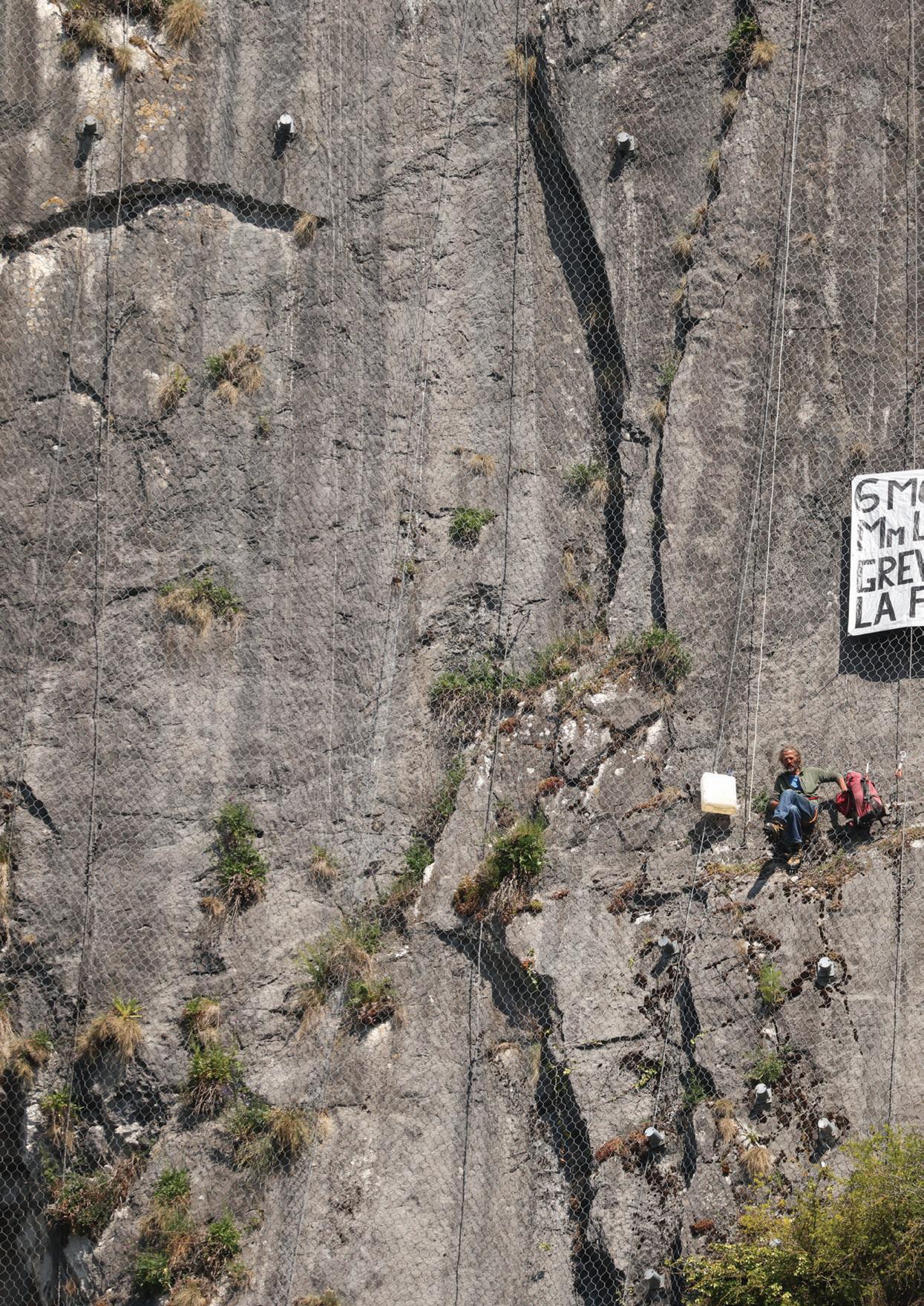
Some protests take to the streets; this one took to the cliffs. Dangling somewhere between defiance and vertigo, Jeff Roba clung to the rock face of the Citadel of Dinant with the tenacity of someone who really, really wants to make a point — and preferably not fall while doing it. It was a protest against a court ruling ordering him to demolish his illegally built hut in the Freyr forest near Dinant. After seven days on the cliff face, he climbed down, saying he was "fed up".
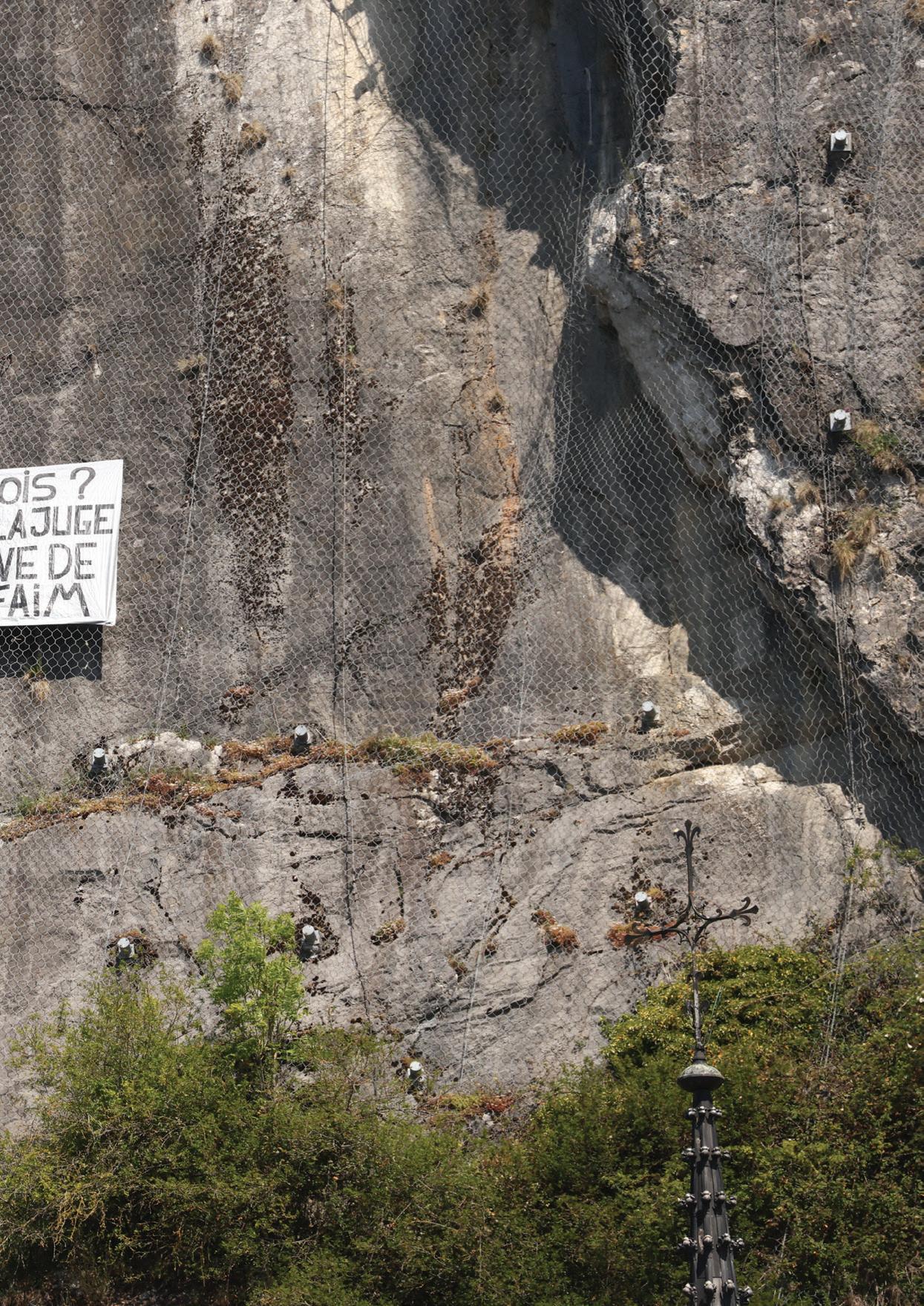


Amid growing recognition across Europe of the need for states to reinforce their defences and increase military spending, Jon Eldridge visits the Herstal headquarters of Belgian arms group FN Browning, which is celebrating its colourful history with an exhibition in Liège Jon Eldridge
A war is not something that’s very easy to deal with for a factory like ours. We don't have a second factory waiting for a war to start.
In the assembly section of the 13-hectare manufacturing site of FN Browning in Herstal, Liège province, the atmosphere is one of relaxed concentration. A handful of men, mostly wearing smart black T-shirts featuring the company logo, are putting together by hand the separately manufactured parts of the firm’s latest order. The completed firearms will then be tested for accuracy in an adjacent 50-metre corridor.
Automation has significantly slashed the size of the company’s workforce – from 12,000 in the 1980s to 1,500 today – but Henry de Harenne, head of communications, tells me that robots cannot replace these employees, who have around five to seven years of training. And unlike their co-workers in other noisier rooms of the factory, these skilled hands can enjoy the radio over the hubbub (although the incongruous strains of Billie Eilish’s latest hit bring a smile to this visitor’s face).
The employment of women becomes more apparent in the packaging area of the same hall. Indeed, the company does not shy away from acknowledging their role in its 136-year story.
In 1966, around 3,000 women at the factory, more than a third of the workforce, staged a 12-week strike demanding equal pay under the 1957 Treaty of Rome, the EU’s founding treaty.
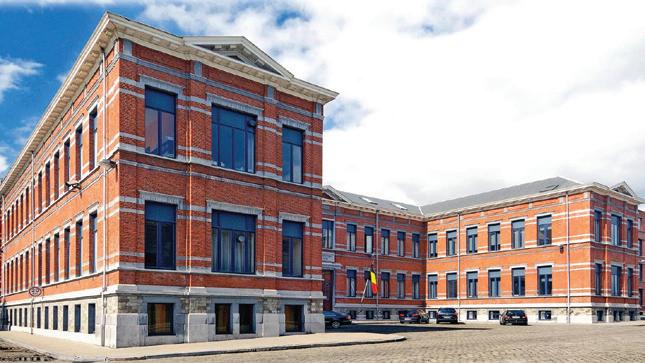

Their action was both bold and unusual: led by rank-and-file women, not union leaders, and infused with the rhetoric of both economic justice and feminist awakening. Their chant – “À travail égal, salaire égal” – became a rallying cry, putting the issue of gender pay inequality on the national agenda.
The FN Herstal strike is featured in the group’s history display panels jotted around the factory, alongside other company landmarks, like the acquisition of Japan’s Miroku a year earlier and the establishment of the Browning Viana subsidiary in Portugal in 1973.
The group’s latest acquisition, Sofisport, was agreed last November and is expected to be completed in September. De Harenne points out that the purchase of the Paris-based softshell manufacturer, which has facilities in France, Italy and Spain, aligns with the recommendations of last year’s report on European competitiveness authored by former Italian prime minister Mario Draghi. “The Draghi report highlights the need for European companies to consolidate,” he says. “Since 1989, most European countries have not invested heavily in defence, and many have paid little attention to the origin of their equipment.”
Russia’s annexation of Crimea in 2014 reversed this downward trend in investment in Europe, although at the start of the full-scale invasion of Ukraine eight years later, some 80% of the ammunition of European armed forces was still produced outside the EU, according to the European Commission. The European defence sector had become reliant on exports, but that situation has changed. “Ten years ago, orders from European countries comprised just a minority of our production. Now they represent the overwhelming majority,” says de Harenne. Indeed, the assembly plant lists deliveries to Denmark, France, the Netherlands, Norway and Sweden.
The company is steadily scaling up production to meet rising demand, but de Harenne emphasises that the group’s priority is to understand a country’s long-term approach to defence. He says the policies of FN Herstal’s clients – state defence departments, along with security forces – determine the size of the future market and not the outbreak of war.
“You do not build new production lines because of a war,” he says. “I hope, pretty much like you, that the war in Ukraine will stop tomorrow. But a war is not something that’s very easy to deal with for a factory like ours. We don't have a second factory waiting for a war to start. We have our people, our production tools, and for a defence company like ours, you can only invest if you have some commitment from your clients.”
The €1.3 billion, 20-year contract to supply the Belgian army that FN Herstal agreed in June of last year is a good example of the long-term commitment that the group is seeking, with FN Browning Group CEO Julien Compère saying it will give
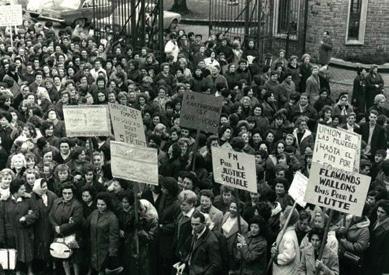
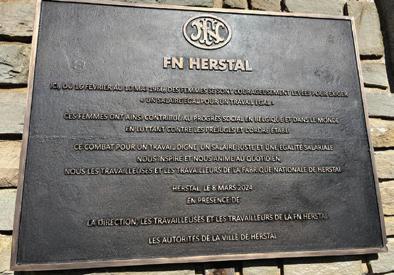
them the visibility need to invest in new production lines (see separate box). The geopolitical uncertainty has not changed the company’s bottom line much: in June this year, it posted turnover of €934 million in 2024, up from €908 million in 2023. However, the Walloon region also said it would inject an extra €100 million into the group.
Amnesty International, among other NGOs, has criticised the sale of arms to countries with poor human rights records by FN Herstal, among other arms manufacturers in Wallo-
nia. Published last year, the latest Observatory of Walloon Arms report singled out the sale of machine guns to the Nigerian army despite allegations of attacks on the civilian population and called on the Walloon government to cancel the issue of certain export licences.
De Harenne says he respects that NGOs are “doing their jobs”, but he insists that it’s not the responsibility of arms manufacturers to determine the countries to which they can export. “We are a tool for the state, first, for their security; and we are also a tool for diplomacy – with countries that are your allies,” he says, although he acknowledges that it can happen
Hard target: FN’s plans to lead Europe’s defence renewal
The world has changed profoundly since FN Browning Group was set up in 1889 as Fabrique Nationale d'Armes de Guerre, but for its CEO, Julien Compère, the aim remains the same: to make dependable and innovative defence and security solutions for governments.
Compère the former head of the Liège University Hospital for eight years, including during the Covid-19 crisis, took the helm of the group in 2021, before Russia’s full-scale invasion of Ukraine, but as European countries were already boosting their defence budgets.
He points to contracts like FN’s recent 20-year deal with Belgium’s Ministry of Defence as key to the group’s growth. “This commitment gives us the visibility we need to invest in new production lines, which we are currently doing,” he says. “It will guarantee the strategic autonomy and security of supply of Belgium in the field of small arms and ammunition.
The 47-year-old who studied law at the University of Liège (ULiège) and later became chief of staff of Walloon Economy Minister Jean-Claude Marcourt, has led a more open approach to the media and politicians: before he arrived, the group did not have communications or government relations departments.
Compère does not shy from inevitable questions about the ethics of weapons manufacturing, insisting that FN always carries out due diligence analyses for each project – and notes that the Wallonia region is responsible for ensuring that export licences meet national, European and UN standards. “No firearms manufactured by our company leave Belgium without such an export licence,” he says. “It is then up to the states to comply with their obligations and international law.”
He also champions European defence programmes, citing projects supported by the European Defence Fund, including the MARTE (Main ARmoured Tank of Europe), E-CUAS (European system to
Company employees readily repeat the on-brand message that FN Herstal, as both a manufacturer of arms and ammunition, has been uniquely placed to drive innovation in the industry over the years.
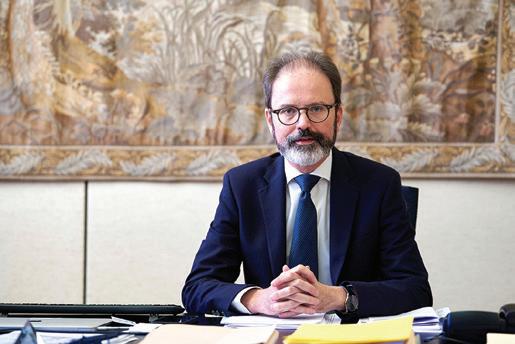
Counter Unmanned Aerial Systems) and SAAT (Small Arms Ammunition Technologies), which FN coordinates with ministries in nine European countries. “These projects are good examples of how the EU can support cutting-edge innovation and bring European countries and industries closer together,” he says.
And while he is cautious about offering a political stance, he does suggest that Europe’s increasingly unstable security implies more coordination amongst the continent’s NATO members.
“The continent's peace and security are linked to its defence capabilities in the broadest sense, which requires a local, competitive and innovative defence industry,” he says. “There is a very clear awareness of this in Europe. The strategic autonomy and security of supply of European states is an essential element of their security. In other words, there can be no peace without security, no security without defence, and no defence without defence industries.”
In the company showroom, I’m handed one of the company’s latest cutting-edge developments: the ‘less lethal launcher’ FN 303 MK2, which has been designed for law enforcement uses such as crowd dispersal or individuals violently resisting arrest.

that the company chooses not to supply a certain country for other reasons.
The FN Browing group describes itself as one of the largest players in the small arms sector for military suppliers, with annual sales revenues of between €900 million and €1 billion. While its income may be a fraction of that earned by major companies such as the UK’s
Rearming Europe: An investment opportunity?

Belgium’s Defence Minister Theo Francken announced earlier this year that the federal Belgian government plans to increase investment in defence by €4bn this year to hit the current NATO spending target for member countries of 2% of national GDP.
The government had previously committed to raising the current level of 1.3% to this target by 2035. Francken says some of the extra money will go towards buying more ammunition, noting that NATO requires members to have a 30-day supply and not, in his words, a few days at best at present “before throwing stones”. The government has clearly been bounced into going further and faster by US President Donald Trump’s perceived lack of commitment to NATO and his administration’s wavering support for the defence of Ukraine against Russian aggression.
On a wider scale, the European Union has unveiled its ReArm Europe Plan/Readiness 2030, which aims to mobilise up to €800 billion for defence investments by issuing bonds and loosening regulations. The plan includes a new financial instrument, Security Action for Europe (SAFE), for carrying out urgent and massive
BAE Systems, its importance to the regional economy should not be underestimated.
Two years ago, FN Herstal asked the University of Liège to carry out an analysis of its supply chain, recognising the need to ensure its security. The study highlighted the large number of local companies that have depended on FN for the past 80 to 90 years, noting that 90% of the
defence investment through common procurement. It will provide member states with up to €150 billion in loans backed by the EU budget.
Regardless of how member states such as Belgium decide to fund additional defence spending – whether through taxation or cuts to other departments – a significant question is raised: what will Europe’s new-found urgency to rearm mean for arms manufacturers including FN Browning?
The STOXX Europe Aerospace & Defence Index jumped 7.5% on March 3, its largest rise since 2020, with major players recording gains of around 15%. Although stocks plummeted in the week after President Trump’s so-called ‘reciprocal’ tariff announcements, they have continued to rise. It should be noted that FN Browning is 100% owned by the Walloon Region, and since shares are not publicly traded, it is not possible to gauge any increase in value of the group by following its share price.
The growing trend in investment, certainly before Russia's 2022 invasion of Ukraine, has been sustainable finance – for example, investing in funds that align with environmental, social and governance (ESG) criteria. ESG-oriented funds often avoid investing in the arms sector or apply strict criteria for doing so. However, some analysts argue that since defence companies play a role in securing peace and protecting democratic value, investing in the sector is therefore not incompatible with ESG principles.
Investing in defence companies, needless to say, is not without risks, and the market has a high degree of volatility. Since major contracts could be awarded to a rival firm to the one invested in, financial advisors commonly suggest spreading investment in the sector. European and global exchange traded funds focusing on defence and aerospace have been launched that allow investors easy access to a broad range of stocks. However, caution is advised. While share prices have risen steadily for the past couple of years, buoyed by the promise of future growth, a disappointing announcement, or any such unexpected intervention, could trigger a market correction.
company’s 1,200 suppliers are based in Belgium and neighbouring countries, with just 2% from non-European states. According to De Harenne, the industry’s supply chains are much more local than those of other sectors. He says that government investment in new production lines also benefits local companies that are not directly involved in the defence sector.
Company employees readily repeat the onbrand message that FN Herstal, as both a manufacturer of arms and ammunition, has been uniquely placed to drive innovation in the industry over the years. In fact, de Harenne enthuses that innovation is “in the company’s DNA”, pointing out that the group spends between 10% and 15% of its revenues on R&D activities, supporting more than 200 people. He says that such investment levels are more typical of an innovative start-up.
The company is proud of the role it has played in defining standard calibre cartridges for NATO. It should be remembered that allied forces could not share ammunition during World War II due to a lack of standardisation. The two most important calibres – the 7.62 x 51mm calibre adopted in 1954 and 5.56 x 45mm in 1980 – were developed at Herstal.
One of its most influential weapons, the 7.62 x 51mm calibre FN MAG machine gun, has been adopted by more than 90 countries since its launch in the 1950s. It was created as a General Purpose Machine Gun (GPMG) by an FN team headed by Belgian firearms designer Ernest Vervier. The resulting design, the Mitrailleuse À Gaz (gas-operated machine gun) with belt feed and quick-change barrel locks was even adopted by the US Army in the 1970s for the M1 Abrams tank and the M2 Bradley infantry Fighting Vehicle.
In 2011, the group acquired Finnish optoelectronics company Noptel, which specialises in laser range finders. The subsidiary is an integral part of the group’s strategy to remain ahead of the curve.
In the company showroom, I’m handed one of the company’s latest cutting-edge developments: the ‘less lethal launcher’ FN 303 MK2, which has been designed for law enforcement uses such as crowd dispersal or individuals violently resisting arrest. This is part of a range of weapons that aim to neutralise without causing severe or permanent injury whilst maintaining a safe standoff distance.
Kevin Criekemans, product and field promotion manager, tells me FN 303 MK2 uses compressed air rather than pyrotechnics and fires plastic projectiles that break up on impact with a force four times that of a standard paintball.
The model is a good example of how the company is applying artificial intelligence solutions, Criekemans says. “The gun will look for human features and create a safety area around
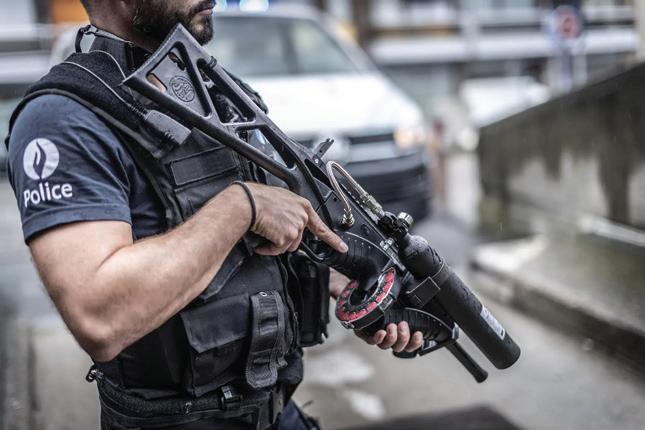
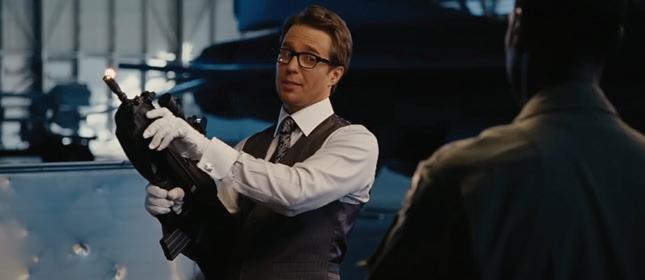

Top: One of FN’s ‘less lethal’ weapons. Below: Marvel’s Justin Hammer brandishing an FN gun. Above: The ‘less lethal’ projectiles
the head, blocking the system when it's pointing towards it,” he explains.
Many such interesting items – from the early Mauser rifles to the FN FAL rifle that Sir Winston Churchill advised the British Army to adopt in the 1950s – are currently on display to the public at the La Boverie, a grand exhibition space near the Liège-Guillemins railway station. The exhibition, Ars Mechanica – La Force d'innover/Driving innovation, was curated by the group’s foundation and traces the manufacturer’s long and prestigious history, featuring examples of its bicycles, motorcycles, cars, jet engines and even typewriters and milking machines (it runs until July 27).
The company’s capacity for invention brings to mind the quip of Sam Rockwell's weapons manufacturer, Justin Hammer, in Iron Man 2, as he wields an FN 2000: “They do make something better than waffles!”
In other words, there can be no peace without security, no security without defence, and no defence without defence industries.
From Mauser deals to mopeds and a Mormon gunsmith, the story of FN Browning is a very Belgian mix of precision engineering, foreign intrigue, and stubborn reinvention, says Jon Eldridge

In 1896, the German group Ludvig Loewe acquired a majority stake in FN, a transaction that kicked up a stir in the Belgian press. Le Soir, for example, questioned whether the company should be still called Fabrique Nationale.
The FN Browning Group has its roots in a limited company incorporated by a group of leading arms manufacturers from the Liège region who decided to join forces in 1889 to help win orders. Seven of the industrialists behind the company, Fabrique Nationale d’Armes de Guerre had formed an earlier partnership, but it wasn’t until alliances with another syndicate that the group acquired enough heft to become a competitive player on the scene. The prize: the award of a contract to supply the Belgian army with 150,000 Mauser rifles after the state acquired the licence.
At this time, the development of a rifle capable of firing several shots in succession without reloading, the repeating rifle, was reaching maturity, and Belgium, along with neighbouring countries, was seeking to upgrade its firearms. High-precision parts were in demand that could be easily interchanged, providing a distinct advantage on the battlefield.
Advances in mechanisation were turning high-skilled craftsmen – working from home or in the suburbs on specific aspects of gun production – into manufacturing specialists. And industrialised Liège, with its coal mines, found-
ries, blast furnaces and steam engines, was at the heart of this development.
In 1890, FN bought six hectares of land in Herstal for 50,000 Belgian francs for the site of its first factory. But right from these early days, the company sought to diversify to ensure its long-term survival. A year later, FN snapped up manufacturing equipment to produce cartridges for the Mauser rifle, announcing that it was capable of “producing 25,000 war cartridges in 10 working hours”. Through a Russian contact, the company also secured an order to convert 400,000 rifles for the Russian army.
In 1896, the German group Ludvig Loewe acquired a majority stake in FN, a transaction that kicked up a stir in the Belgian press. Le Soir, for example, questioned whether the company should be still called Fabrique Nationale. However, the takeover ended the threat of legal action from the parent company, which was contesting whether FN was licenced to supply Mauser rifles outside Belgian and meet an order from Chile for 60,000 items. Nevertheless, the disadvantages of now belonging to an effective cartel were also apparent: some markets became closed to the company and orders could also be shared among the group’s businesses. Hence, FN would follow other arms manufacturers in further diversification – beginning with the production of bicycle parts.
The chance encounter in the US in 1897 between FN’s commercial director and firearms inventor John Moses Browning looms large in the FN story. Many of his patents were being manufactured in the US by Winchester, Remington and Colt, but a year after the meeting, the inventor left his hometown of Ogden, Utah, and the family arms business run by his brothers, for Herstal to oversee production of his automatic pistol. As many as 500 a day were being produced, and soon all officers in the Belgian army would be equipped with the gun.
In 1902, Browning tried to interest US manufacturers in his automatic shotgun, a world first, but it was FN that would acquire the licence, firming up the relationship with Browning Bros. FN was granted the right to use Browning as

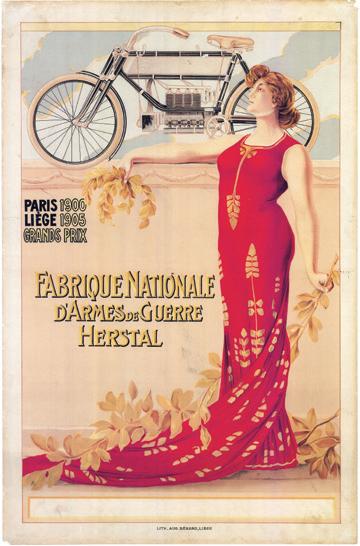
a trademark several years later. John Browning would later die from a heart attack on the premises of FN in 1926.
Towards the end of 19th century, FN began developing its bicycle business, from initially producing ‘nipples’ that fix wheel spokes to the rim to designing a bespoke frame – and in 1898 the company produced a chainless bicycle, which found a regular customer in the Belgian gendarmerie. That same year, the company hired a motor specialist to develop a voiturette, a small car with a three-horsepower engine.
The manufacture of mopeds – attaching a motor to a reinforced bicycle frame – followed suit, along with a four-cylinder engine motorcycle in 1905. Some 9,000 copies of the model, the first of its kind to be mass produced, were sold in the three years leading up to the outbreak of World War I, with the Belgian and Russian armies regular clients.
The occupying German army requisitioned FN machinery at the start of the war, but the company’s board resisted the German government’s attempts to restart production, despite most of the directors being German. Managing director Alfred Andri was later imprisoned in Germany for this act of defiance, while chairman Georges Laloux endured a similar fate for his part in resisting German intentions. At the end of the conflict, German-held shares in FN were sold, and the company embarked on a process of restoration, mainly focused on its depleted range of machine tools.
The interwar years for FN were marked by the challenge of responding to a changing commercial environment of fluctuating retail prices, custom barriers and the protectionist policies of key export markets, and the depre -
ciation of the Belgian franc and unfavourable exchange rates.
Faced with the mass production know-how of US carmakers like Ford, General Motors and Chrysler – which all established assembly plants in Antwerp in the roaring twenties – FN refocused its automobile business on luxury, highend models. It produced 20,000 cars in 1927, making it the second-largest Belgian manufacturer after Minerva. However, the company could not compete with international rivals and ceased making cars in 1935. Nevertheless, production of specialist trucks, motorcycles adapted for the military and the three-wheeled Tricar (the Belgian army acquired 300 copies of this large motorcycle capable of transporting goods and people) continued…until another period of turmoil was heralded by the onset of World War II.
Recent historical landmarks:
1938
Ammunition factory in Bruges moves to a site in Zutendaal that is still in operation.
1952
Manufacture of engines and valves for aircraft and rockets begins (ending in 1990s).
1977
The group acquires Browning Arms Company.
1991
FN Herstal restructures around holding company, Herstal SA.
1997
Walloon Region acquires 100% stake in the almost bankrupt group for a symbolic Belgian franc.
2021-22
FN Herstal launches production line for electronic boards.
2024
Herstal Group formally changes its name to FN Browning Group.

HIV, tuberculosis, viral hepatitis and sexually transmitted infections are causing unnecessary suffering across Europe – it is time to take action.
The Sustainable Development Goals (SDGs), adopted by the United Nations in 2015, offer a shared global vision for a more prosperous and equitable world.
SDG 3 focuses on ensuring healthy lives and promoting well-being for all, and Tar-
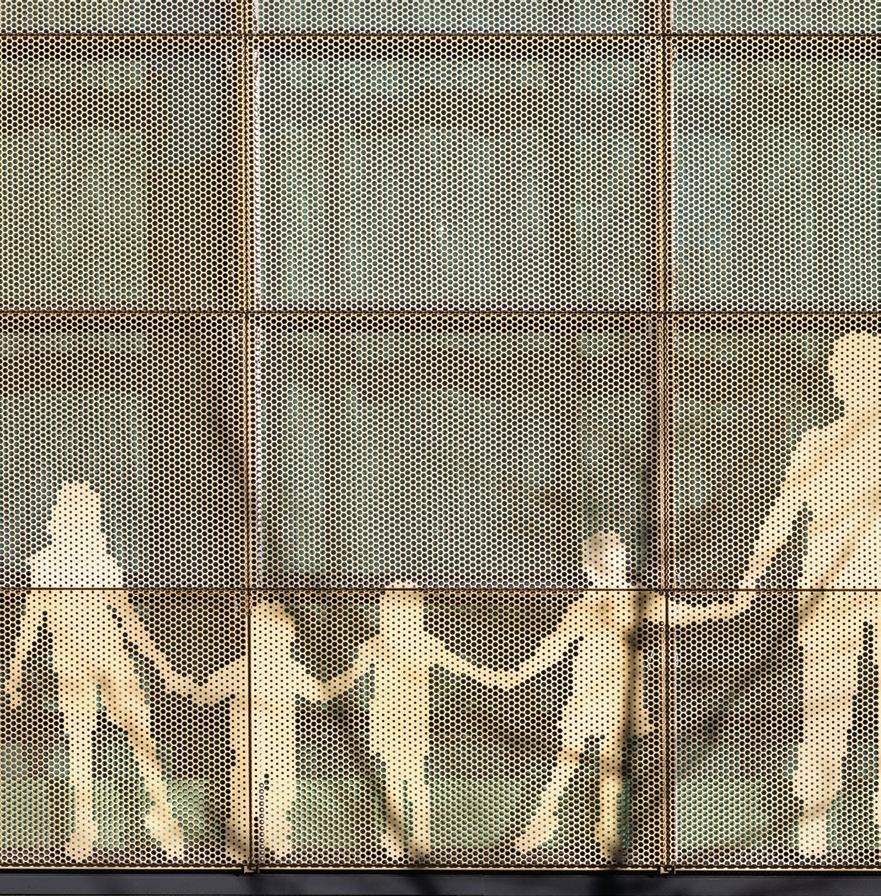
get 3.3 sets the ambitious aim of ending the epidemics of AIDS, tuberculosis (TB), and combating hepatitis and sexually transmitted infections (STIs) by 2030.
Although preventable, 820 000 people were living with HIV, 3.2 million with hepatitis B and 1.8 million with hepatitis C in the EU/EEA as of the end of 2023, and tens of thousands were diagnosed with TB or STIs such as gonorrhoea, chlamydia or syphilis. While Europe has made strides in public health, progress towards SDG 3.3 reveals a critical moment requiring renewed focus and urgent action.
The data that the European Centre for Disease Prevention and Control has collected and presented in its newly released progress report shows a concerning picture. While
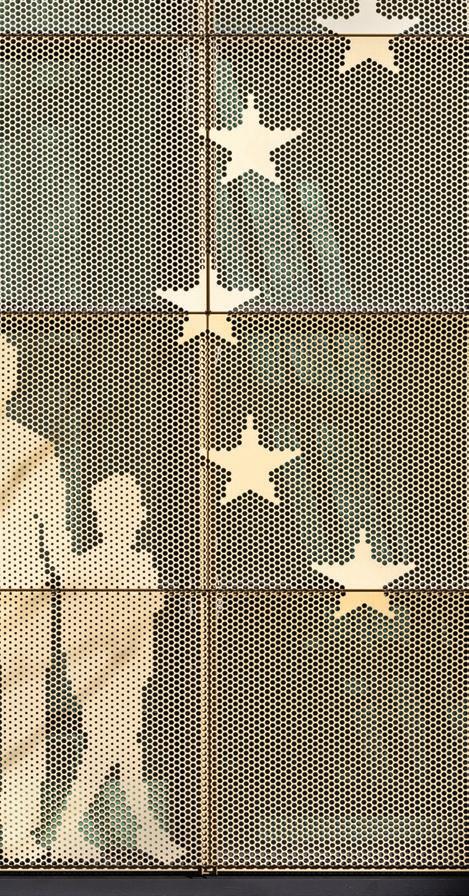
progress has been made in reducing new HIV and TB infections, the current pace is insufficient to meet the 2030 targets. Alarmingly, some STIs, such as gonorrhoea and syphilis, are also resurging across Europe, and a lack of crucial data obscures the true scale of the challenges posed by chronic hepatitis B and C.
More than a quarter of a million cases of HIV, TB, viral hepatitis, and STIs were reported last year in the EU/EEA, but these aren't just statistics. The numbers represent human suffering, lives at risk, families impacted, and a significant burden on healthcare systems and economies. Despite being preventable, every year, over 57 000 people in the EU/EEA die from AIDS, TB, and hepatitis – a high toll for a continent with available resources, knowledge and effective tools for prevention and control.
The path forward needs courage and commitment, requiring a ramping up of efforts across three key areas:
Prevention: Proven interventions like condom use, PrEP for HIV, preventative TB treatment, needle exchange programs, and hepatitis B vaccination should be scaled up and equitable access ensured.
Testing and treatment: Early detection and effective treatment are crucial, both for the health of the individuals impacted and to stop onward transmission of these infections. We must break down barriers to access and ensure everyone receives the care they need.
Monitoring and surveillance: Robust data collection and surveillance systems are essential to tailor interventions effectively for everyone, including vulnerable populations.
Addressing these challenges requires focused action. Greater emphasis must be placed on scaling up proven prevention measures and ensuring equitable access to testing and treatment. Sustained efforts are needed to reduce mortality from preventable diseases, and improving the availability and quality of surveillance data is fundamental to track progress accurately.
Europe needs a strong and united effort at all levels to accelerate progress, securing health for all today and the years to come.
Despite
being preventable, every year, over 57 000 people in the EU/EEA die from AIDS, TB, and hepatitis – a high toll for a continent with available resources, knowledge and effective tools for prevention and control.
From Putin’s early sabre-rattling to Trump’s demands for NATO burden-sharing, Belgium has ignored one warning after another. Wannes Verstraete, Associate Fellow at Egmont, the Royal Institute for International Relations, says the country must finally confront its chronic underinvestment

That complacency shattered in February 2022. Russia’s fullscale invasion of Ukraine forced even the most sceptical to confront a new era of collective defence.
Europe’s security landscape has shifted dramatically over the past two decades, yet while most of its neighbours have gradually adapted to the wake-up calls, Belgium remains locked in a slumber — always reaching for the snooze button.
In hindsight, the early warnings were unmistakable. One of the first came in February 2007, when Russian President Vladimir Putin used his now-famous Munich Security Conference speech to lambast the unipolar world order and NATO’s eastward enlargement – or “expansion”. A year later, Russia launched a military assault on Georgia — its first act of cross-border aggression in the 21st century. Yet Belgium and much of the West remained preoccupied with the financial crisis and the ongoing global war on terror.
The next wake-up call came in 2014. Following Ukraine’s pro-European Maidan Revolution, Russia responded by illegally annexing Crimea and funnelling weapons and troops into eastern Ukraine. Even then, it failed to prompt serious Belgian reflection.
When Donald Trump first entered the White House in 2017, he made it abundantly clear: Europe had to do more. NATO’s burden-sharing was no longer optional. Belgium responded with modest gestures. Prime Minister Charles Michel’s first government, from 2014–2018, laid out a ‘Strategic Vision’ and committed to upgrade some air, land, and maritime capabilities. But there was little sense of urgency — and no serious attempt to meet the NATO benchmark
of 2% of GDP on defence.
That complacency shattered in February 2022. Russia’s full-scale invasion of Ukraine forced even the most sceptical to confront a new era of collective defence. Belgium launched the STAR plan, under the Alexander De Croo government, which set modest increases in personnel and capability investment, alongside a limited rise in spending — to just 1.3% of GDP.
This year saw another wake-up call: Trump’s return to the White House. Once again, he pressed European allies to boost their defence spending. His demand? That NATO allies raise their defence budgets to 5% of GDP.
Belgium’s Arizona coalition under Prime Minister Bart De Wever initially aimed for 2% by 2029 and 2.5% by 2034. But the rapidly changing geopolitical climate, both within Europe and across the Atlantic, renders those timelines obsolete. In April, the government pledged to hit 2% this year — but without securing long-term structural funding.
Meanwhile, the pressure has been mounting. On May 9, following a meeting with Belgian Defence Minister Theo Francken, US Under Secretary of Defence Elbridge Colby publicly called on Belgium to step up. “As a founding member of NATO, host of NATO headquarters, and one of Europe’s wealthiest societies, we look to Belgium as an example for our European allies by increasing its defence spending to 5%,” Colby said.
Germany, a key European ally and neighbour, already signalled its willingness to increase their budget towards 5% of GDP. In Belgium, however, political fault lines are emerging. The Flemish Christian democrats (CD&V), a coalition partner, insist that 2% must remain the ceiling. Foreign Minister Maxime Prévot, from the Francophone centrist party Les Engagés, hopes to soften both the target and the timeframe ahead of the June 24-25 NATO summit in The Hague.
Realism must prevail. Belgium cannot keep lagging behind. With the global order in flux, a defence budget of 3% or more is no longer an abstract ambition. It is a strategic imperative to address legacy shortfalls, meet NATO’s capability targets and preserve Belgian influence.
Wannes Verstraete
As hard power returns to the global stage, Belgium faces a reckoning. Decades of defence neglect have left the country ill-equipped for today’s threats. With rising NATO expectations and hollowed-out institutions, rearming is no longer optional—it’s essential to preserve sovereignty, stability, and the safety of future generations, says retired Belgian army Lieutenant-General Marc Thys
The world has changed since the start of 2025. The changes are real and will have long-lasting implications: this is no black swan moment. Today’s global order is no longer shaped by treaties and trust, but by coercion and confrontation. Great power politics have returned – and yet Western Europe, and Belgium in particular, are woefully unprepared.
From Ukraine to Taiwan, from Greenland to the Arctic, hard power has eclipsed diplomacy. The rules-based system is yielding to the rule of force. Europe is relearning a lesson it long preferred to forget: soft power is a hollow promise without the steel of military strength beneath it.
That rediscovery has triggered a belated defence reawakening across the continent.
But decades of neglect cannot be reversed overnight, least of all in Belgium, where the atrophy was most acute. After the end of the Cold War, Belgium raced to cash in its peace dividend. Between 1989 and 2024, European Union countries cut defence personnel by an average of 40%.
Belgium slashed it by 78%. This is in a country that ranks seventh in GDP and eighth in population among EU member states. In 2016, the added value of the presence of international institutions in Brussels exceeded €5 billion — more than the combined budgets of Belgian defence, diplomacy, and development cooperation at that moment. Little wonder Belgium was labelled a free rider.
That legacy left the country ill-equipped for the threats of a new era.
In recent years, however, Belgium has begun to shoulder its responsibilities. The Vandeput Plan of 2017 pledged €9 billion in defence investment; the STAR Plan of 2022 added another €10 billion. Both were aimed at bringing Belgium into line with the NATO benchmark agreed in 2014 of 2% of GDP. This year, Belgium’s so-called Arizona government met that 2% target. On paper, the country has caught up.
Yet the goalposts are already shifting. At the NATO summit in The Hague this June, a new target of 5% might be set. For Belgium, that would mean more than doubling current expenditure — an eye-watering prospect. The structural fault lines in Belgium’s

fiscal architecture, especially the imbalance between federal and regional competencies, would be brutally exposed.
Defence is only one pillar of resilience. A nation capable of weathering this century’s storms must have strong, responsive institutions across the board. In Belgium, those too have been hollowed out.
Diplomatic capacity has dwindled to its lowest since 1945. The judiciary struggles to function. Core public services are chronically underfunded, despite public spending levels that exceed the EU average. Belgium spends 52.1% of its GDP on public expenditure (compared to the EU’s 47%) yet remains structurally unable to finance its sovereign functions effectively.
To its credit, Belgium’s current political leadership recognises the scale of the challenge. But few NATO or EU states face a steeper climb. Belgium has long benefited from a favourable status quo, one that let it enjoy peace and prosperity without paying the full price. We may even have financed our internal peace with money we didn’t have.
But there is no more room for finger-pointing. The past is a shared responsibility. The only way forward is together. If we are to safeguard our prosperity and security, we must invest — collectively, courageously and in solidarity – for the generations to come.
Decades of neglect cannot be reversed overnight, least of all in Belgium, where the atrophy was most acute.
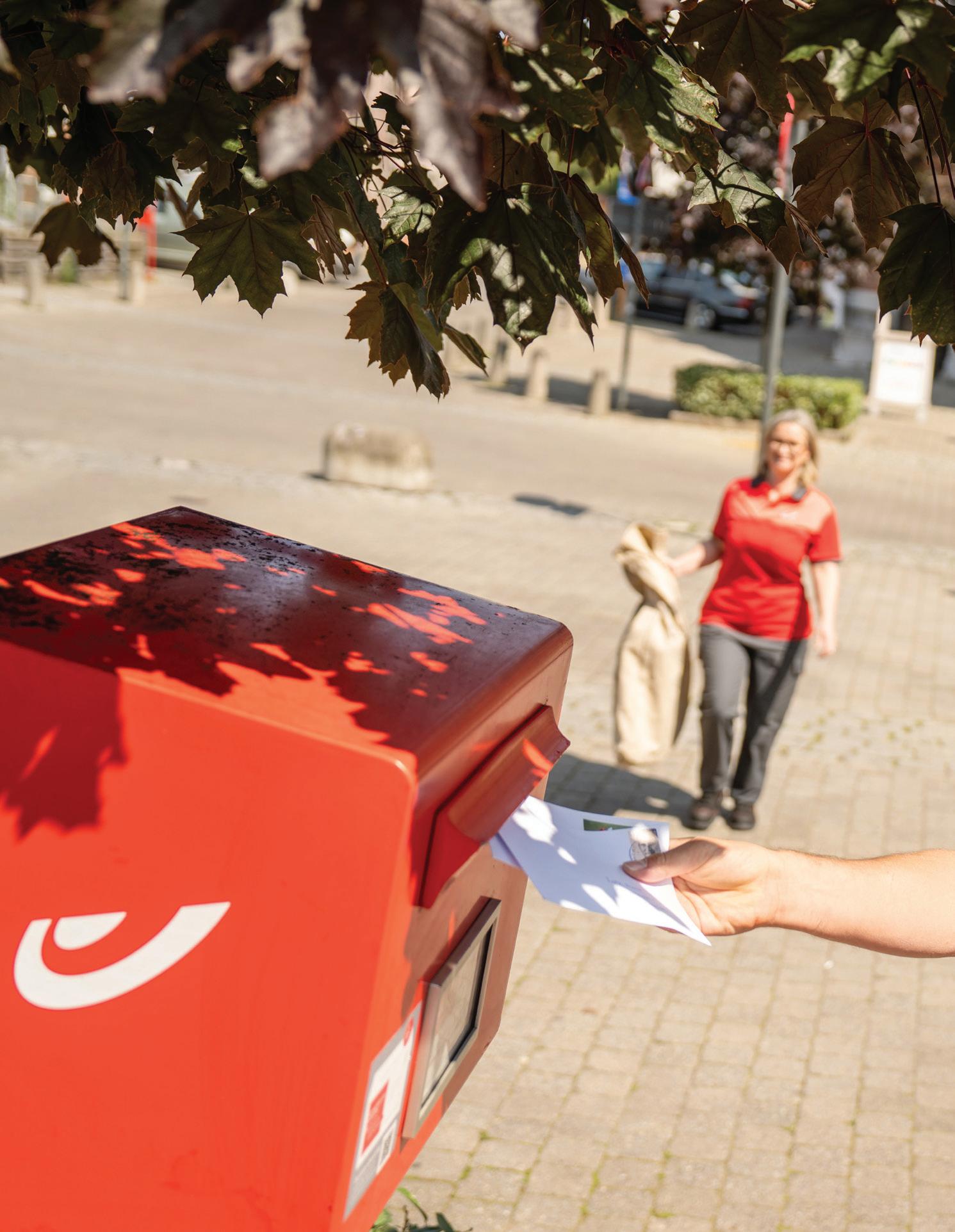

Once the nerve centre of a Habsburg empire, Belgium’s postal service helped shape Europe’s first communication network. But in the digital age of emails, NFTs and dwindling letters, Bpost is fighting to stay relevant. From glorious Neo-Gothic post offices to stamps destined for Mars, this is the story of a proud institution struggling to deliver its future, as Derek Blyth writes
ot many people stop to read the two bronze plaques on the corner of a Brussels building in the Sablon neighbourhood. One is in French, the other in Dutch. Translated, they read, “Up until 1872, this was the site of the Tour et Tassis Mansion near which François de Tassis established the first international postal service in 1516.”
The greenish plaques are worn with age. Yet you can still make out the features of the young Emperor Charles V with his unmistakable pointed chin on the French plaque, while the Dutch plaque is decorated with a portrait of chubby François de Tassis.
The postal service was initially launched by the Habsburg Emperor Maximilian I to deliver letters from Innsbruck, the seat of the emperor, to Brussels, where the Habsburg governor was based. This postal monopoly was granted to the Italian François de Tassis. Born Francesco Tasso, he came from an aristocratic family known as the Tassos or Tassis. The family later added Taxis to their name, which became Thurn und Taxis when they moved to Germany.
The imperial mail was delivered by a relay of horses that were changed every 28 kilometres. The system grew into a network of postal routes that spread from Brussels across much of Habsburg Europe, linking Germany, Spain, the Low Countries, France and Italy. A letter posted in Brussels would arrive in Innsbruck in precisely five and a half days. A letter to Blois in France took 60 hours to reach its destination, while a message to Rome would be delivered after an exhausting 250 hours on the road.
The Habsburg system might seem quaint compared to email or text messages. But the imperial post marked the emergence of a new communications network. Like the internet today, the postal service made communication faster and more reliable. Its arteries stretched over much of the European mainland, ensuring the sprawling empire could be efficiently managed. It also marked the beginning of Brussels’ ambition to be at the heart of Europe.
The city would go on to become a rail hub in the 19th century, a motorway hub in the 20th century, and a political hub in the postwar years. But it began with the mail.
Sadly, Brussels has almost forgotten that it was once the information hub of the 16th century. Most traces of the Tour et Tassis family disappeared after the family moved to Regensburg. The palace overlooking the Sablon church was torn down in the 19th century. It was replaced by the Royal Music Conservatory. Two baroque family chapels inside the Sablon church are the only reminders of the Tour et Taxis connection.
But the city did mark the 500th anniversary of the postal service. In 2016, a small crowd gathered in front of the plaque on the Sablon to mark the event that happened five centuries earlier. The guests included Archduchess Anne Gabrielle of Austria as well as Prince Dimitri della Torre e Tasso, who lives in Brussels. According to his LinkedIn profile, Prince Dimitri co-founded the fashionable Ixelles wine bar Etiquette.
The Tour et Taxis name also survives in the waterfront neighbourhood next to the Brussels canal. It stands on the site of a meadow where, according to some historians, the imperial post horses were put out to graze. The meadow was later turned into a vast industrial site occupied by railway yards, customs warehouses, and a post office.
As you might expect, Belgium has some exceptional post office buildings. Mechelen’s main post office occupies a 12th century building that was once a hostel for pilgrims. It then became the town hall before it was converted into a post office. Outside, an iron sign has the old Dutch word Posterijen, post office. The grandeur continues with an elegant rococo staircase leading into the building. Sadly, the interior is as functional as any other post office.
Many other impressive post office buildings were built at the end of the 19th century when everyone depended on the postal service to deliver letters, postcards and gifts. The main post office in Ghent is one of the most striking. With its
Derek Blyth
Like the internet today, the postal service made communication faster and more reliable.
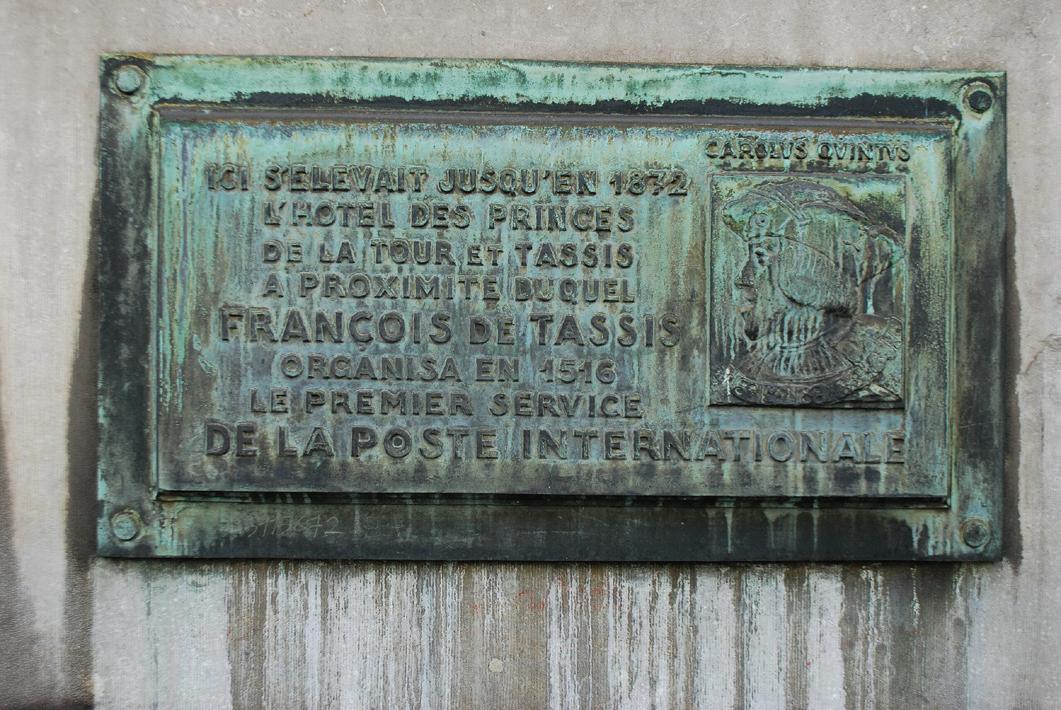
The grandeur continues with an elegant rococo staircase leading into the building.
turrets and Gothic windows, it might almost be mistaken for a mediaeval palace. But look carefully and you notice tiny sculptures of carrier pigeons with letters in their beaks.
There was once a fascinating Post Museum on the Sablon that focused on the story of the postal service. But the museum closed. And then the country’s post offices, one by one, were shuttered.
The internet has made a huge dent in the post office’s revenue. People now send emails rather than letters. They post photos on social media rather than sitting down to write a postcard. And the government sends out invoices by email rather than using the post. As a result, the volume of mail has dropped dramatically over the past two decades.
Almost every historic post office building in Belgium has been sold off to developers. The main post office in Ghent has been converted into a shopping centre with a luxury hotel nestled in the upper floors. The modernist post office Ostend has also gone. Designed in 1953 by Gaston Eysselinck, the post office was an impressive building where tourists once queued up to send postcards or use payphones to call distant relatives. The airy building is now a cultural centre called De Grote Post. All that remains of its original function, apart from the name, is a row of wooden phone boxes in the café now used to frame giant photos of Flemish writers and artists.
The Grand-Poste in Liege is a magnificent Neo-Gothic building on the Meuse waterfront
designed by Edmond Jamar. It closed down in 2002 and stood empty for the next 14 years while various plans were proposed and subsequently rejected. Finally, the building was renovated to create a coworking space with a food hall and rooftop bar.
Other post offices have been left to rot. The modernist post office in Ixelles commune closed down some years ago. There was talk of converting it into a museum, or affordable housing, or maybe an extension to the architecture school next door. But despite its prime location behind Place Flagey, the building remains empty and covered in graffiti.
The future now looks bleak for post offices all over the world. In March, Denmark’s staterun postal service PostNord announced that it would end all letter deliveries at the end of 2025. Beginning in the summer, the company will remove all 1,500 Danish letter boxes. And it will also phase out postage stamps.
The situation in Belgium is not so dire. You can still find a local shop or supermarket with a Bpost counter. And the Belgian postal office continues to deliver letters and issues colourful stamps.
The first Belgian stamps were issued in 1849 with the head of Leopold I and the country named in French. For more than 150 years, the stamps have been printed at a production plant in Mechelen. It’s now one of the last printing facilities of its kind in Europe, with more than one hundred million stamps rolling off the presses
every year. As well as Belgian stamps, the production line produces stamps for Luxembourg, Portugal, Austria, Gibraltar and the Vatican.
The printing works known as Het Zegel (The Stamp) moved into an abandoned candle factory on Mechelen’s Vaartdijk in 1868. The canalside site lay close to Mechelen’s main station, which formed the main hub of the country’s dense rail network. It meant new stamps could be sent rapidly by train to every corner of Belgium.
The printing works finally closed down in 1993. For the next 30 years, the landmark brick building was left to rot. The decayed interior became a popular destination for urban explorers until the building was finally acquired by a project developer to create an office and apartment complex.
The passion for collecting postage stamps looks like it won’t survive. The Rue du Midi in Brussels was once dotted with dealers who sold exotic stamps from distant countries, along with vintage postcards sent a century ago. But hardly any of the dark little shops have survived. The philately clubs that once flourished all over Belgium are struggling to find younger members.
Yet Belgium continues to issue new stamps. These limited editions are not sold in post offices, but they can be ordered online. This year sees the issue of a stamp commemorating 600 years of Leuven University, along with a stamp illustrated with cartoon Smurfs promoting the United Nations sustainable development goals. There’s even a stamp coming out later this year to celebrate the number pi.
Other recent themes include Belgian bandstands, the country’s choreographers and the buildings of Hasselt. Meanwhile, Belgium’s weird surrealism is expressed by a limited-edition stamp illustrating a Tom Frantzen sculpture featuring a woman wearing only riding boots and a hat riding a flying pig.
Determined to shake off its stuffy image, Bpost recently launched a cryptocurrency stamp that combined a physical postage stamp with a collectable NFT that only exists as a digital token. It has also issued stamps that glow in the dark, a stamp dedicated to underwater species that is printed with a varnish that makes it seem that fish are swimming, and a 2024 stamp to celebrate the 150th anniversary of the Universal Postal Union that includes 2,024 words (a world record).
Bpost might also be one step closer to a daily delivery to Mars. It has issued a series of stamps celebrating Belgian contributions to space exploration printed with the tariff region ‘Universe,’ to add to the existing three rates of Belgium, Europe and World.
There’s one topic that Bpost still hasn’t celebrated. “For a brief period, cats delivered mail in Belgium,” according to a recent post on X that went viral. “During the 1870s, the city of Liège ‘hired’ 37 cats to deliver mail in waterproof bags. As expected, the cats weren’t effective mailmen.”
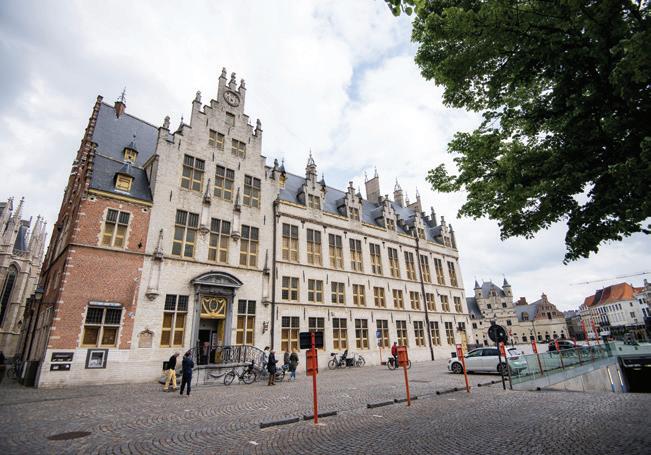
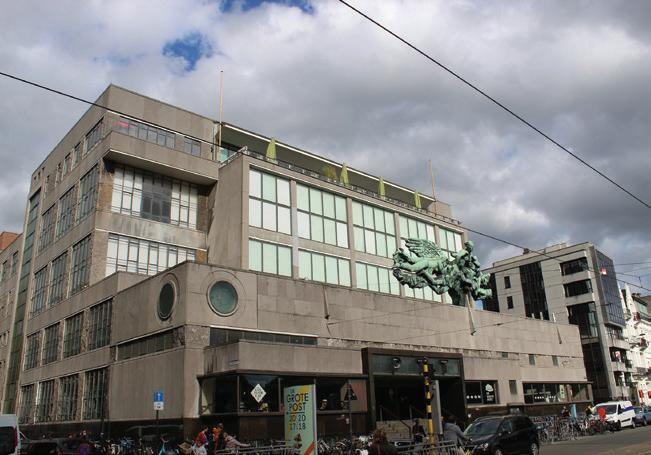
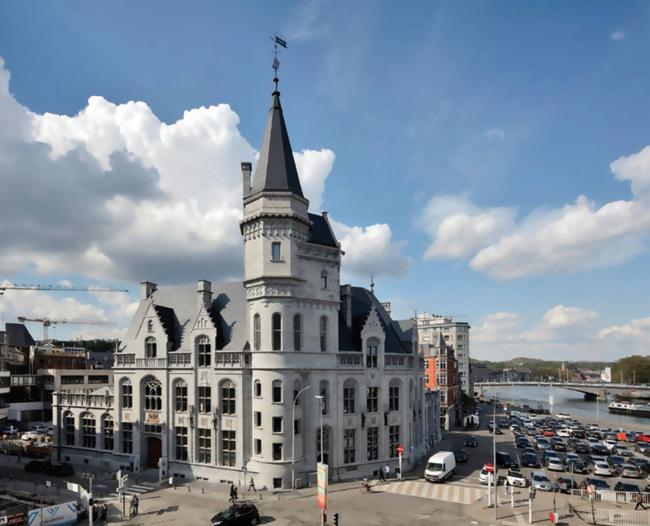
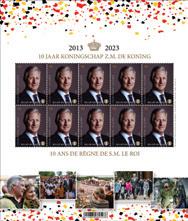
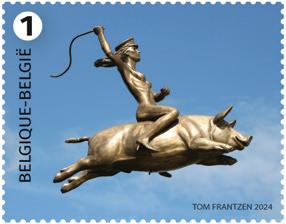

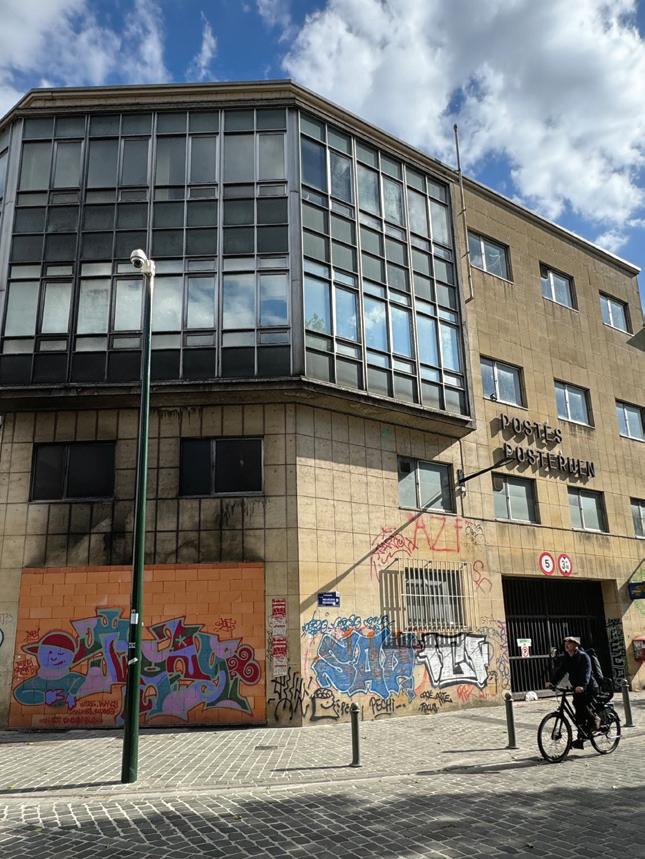
Bpost might also be one step closer to a daily delivery to Mars.
The story relied on a long-forgotten article published in 1876 in the New York Times by the writer William L. Alden. The author claimed the cats were being trained to replace Belgium’s carrier pigeons. It was picked up and widely circulated on internet sites. But the Belgian broadcaster RTBF recently investigated the story and pronounced it an urban myth. The broadcaster went on to explain that cats were sometimes set loose in post offices to catch mice that might chew the mail.
For all its rich history and innovative stamps, the Belgian postal service is struggling to survive. It has seen a massive drop in letters sent, along with stiff competition from competing parcel delivery services. In a bid to remain relevant, Bpost has invested massively in parcel
lockers where customers can drop off and pick up parcels. It has already established 3,000 pickup points with a further 1,000 planned.
The semi-privatised company with a turnover of €4.4 billion is still in deep trouble. Earlier this year, the share price slumped by 60 percent, leading to comments that a Bpost share is now worth less than a postage stamp. The dramatic drop was caused in part by Bpost losing a lucrative contract to deliver newspapers worth €167 million, along with a bloated workforce, and a series of strikes in sorting centres across Brussels and Wallonia. “I was ready for a marathon when I started this job,” declared Bpost CEO Chris Peeters, “But I’m suddenly having to do it with a rucksack filled with ten kilos of rocks.”
The Belgian post office likes to believe it might one day deliver mail to Mars. But maybe it’s more likely that Belgium will follow Denmark and close down its postal service. If so, it would be the end of a rich history that began more than five centuries ago in the heart of Brussels.
2010: La Poste/De Post becomes bpost
2011:
After a gradual lifting of the postal monopoly, the Belgian postal market was fully liberalised: anyone meeting certain conditions can offer postal services in the country
2013: bpost SA is listed on the Brussels Stock Exchange
2016:
New parcel sorting centre in Neder-overHembeek is built
2017:
Acquisition of American company Radial, putting bpost group on track to become an international player in e-commerce logistics.
E-commerce is booming.
In 2016: Number of parcels processed per day was, on average 148,000, but by 2022, the last year bpost has figures, it was 549,000. The end-of-year period is bpost’s busiest, from Black Friday to Christmas. The peak of 813,000 packages processed per day was reached on December 4, 2024.

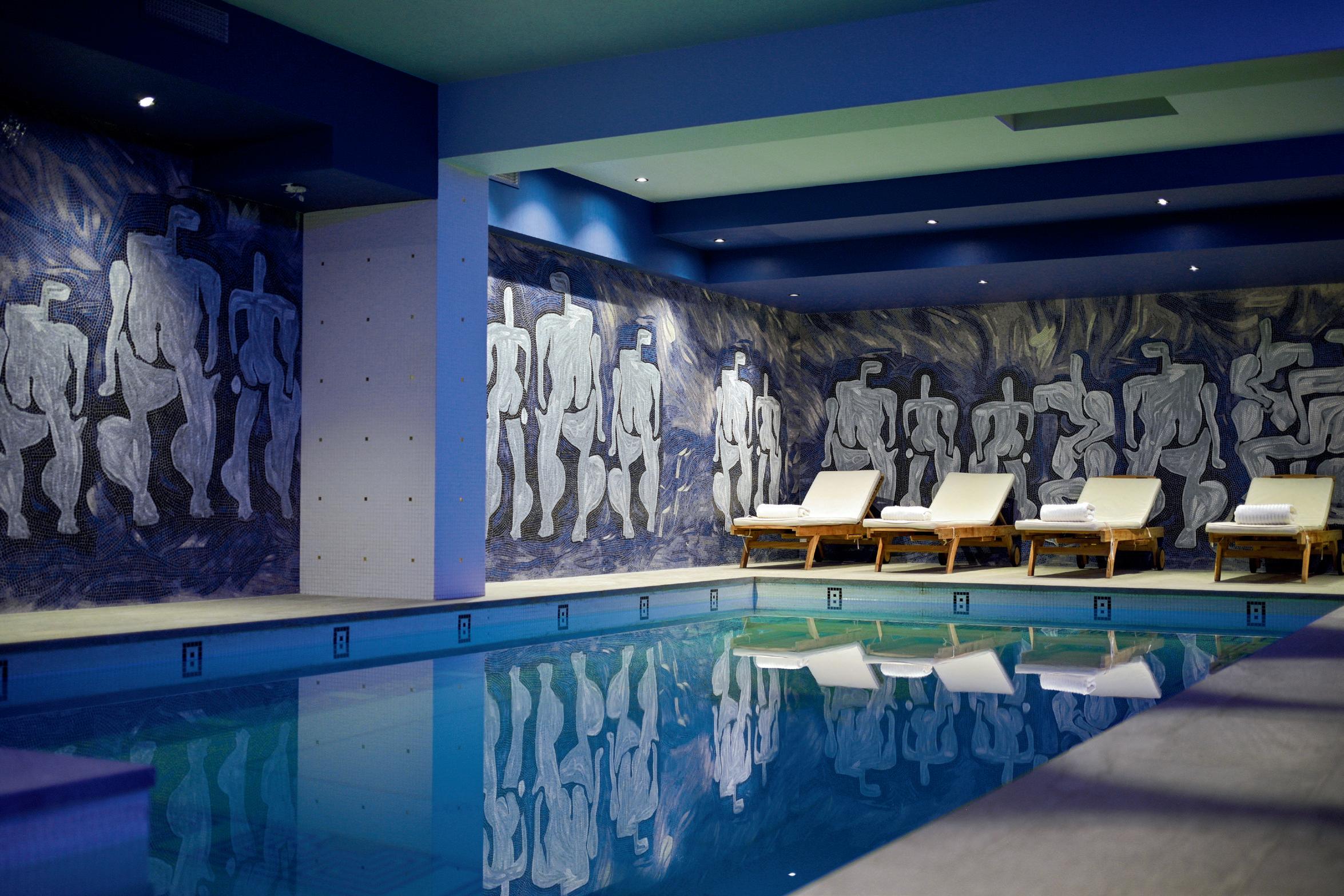

Your city spot to relax


Embassy of the Republic of Azerbaijan to the Kingdom of Belgium and the Grand Duchy of Luxembourg, Mission to the European Union
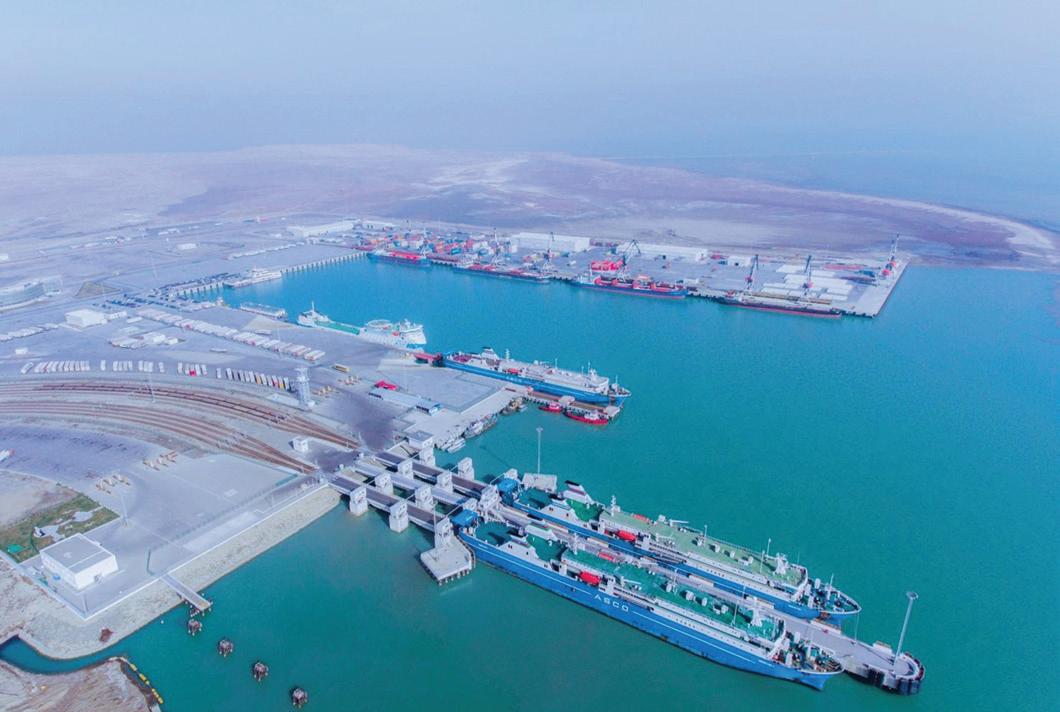
The EU is Azerbaijan’s largest trading partner, accounting for a substantial share of the country’s foreign trade.
Next year, Azerbaijan and the European Union will mark 30 years of formal diplomatic relations, commemorating the signing of the Partnership and Cooperation Agreement (PCA) in 1996.
This milestone highlights a relationship built on mutual interests in energy, trade, and regional stability.
Celebrating its 107th year of independence, Azerbaijan marked the occasion on 28 May with a reception hosted by its Embassy in Brussels. The event brought together dip-
lomatic representatives, EU officials, and key partners, reflecting the country’s enduring ties and strategic cooperation with the European Union.
Since the early years of its independence, Azerbaijan has steadily built a strong and multifaceted partnership with the European Union, reflecting a shared commitment to political dialogue, economic cooperation, and regional engagement.
What initially began as a pragmatic collaboration in essential areas such as energy and trade has gradually evolved into a
broader, more strategic relationship that now includes diverse sectors like security cooperation, connectivity infrastructure, governance reforms, educational exchanges, and cultural initiatives.
Over the decades, this evolving partnership has strengthened mutual understanding and established Azerbaijan as a key political and economic partner for the EU in the South Caucasus region, where it plays a growing role in contributing to both regional stability and Europe’s long-term strategic goals.
Azerbaijan’s unique geographic location at the crossroads of Europe and Asia, combined with its substantial energy reserves, has positioned it as an essential contributor to Europe’s energy diversification efforts. This role has been particularly important in the context of recent shifts in global energy supply dynamics, where ensuring reliable, secure, and diversified sources of energy has become a central concern for European policymakers.
In this context, the Southern Gas Corridor (SGC) stands out as one of the most ambitious and strategically significant energy infrastructure initiatives of the past few decades. This multi-phase project, which connects Azerbaijan’s gas fields in the Caspian Sea to European consumers, has become a cornerstone of the energy relationship between Azerbaijan and the EU.
The corridor, which includes major pipeline systems such as the Trans-Anatolian Pipeline (TANAP) and the Trans-Adriatic Pipeline (TAP), allows Azerbaijani natural gas to reach European markets directly for the first time, bypassing older and less stable supply routes. This not only enhances the EU’s energy security but also underlines Azerbaijan’s importance as a reliable and stable energy exporter. The strategic value of this partnership was further elevated in July 2022, when Azerbaijan and the European Union signed a memorandum of understanding to double gas exports to Europe by 2027. This forward-looking agreement signals a deepening of the energy alliance and reflects a shared interest in long-term cooperation amid global energy uncertainties.
At the same time, Azerbaijan is not limiting its energy policy to fossil fuels. The country has begun broadening its energy portfolio by investing in the development of renewable energy sources such as wind and solar power. These initiatives are not only part of Azerbaijan’s own national strategy for energy diversification and sustainability, but they also align closely with the EU’s climate objectives and its broader strategy for a green transition. By moving in this direction, Azerbaijan is opening up new possibilities for future cooperation with the EU in clean energy technologies and sustainable infrastructure development.
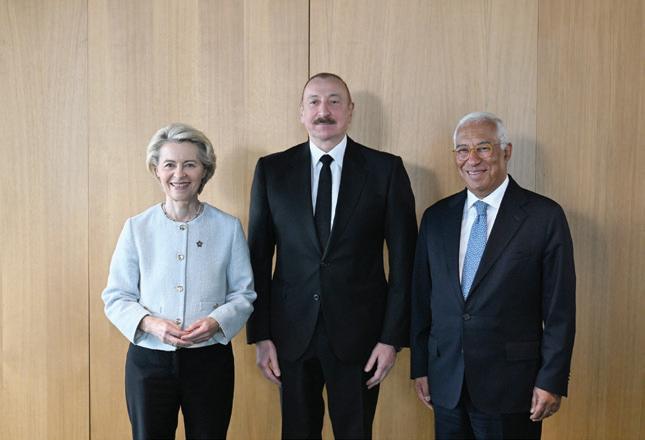
Beyond energy, economic and trade relations between Azerbaijan and the EU have grown increasingly significant, underpinned by mutual investment and a shared interest in economic diversification. Today, the European Union is Azerbaijan’s largest trading partner, accounting for a substantial share of the country’s foreign trade. Over the past few years, this relationship has expanded beyond hydrocarbons to include cooperation in sectors such as logistics, digital infrastructure, agriculture, and technology. European businesses are increasingly active in Azerbaijan, supported by an improving investment environment and gradual reforms aimed at modernizing the economy.
At the institutional level, negotiations are ongoing for a new EU–Azerbaijan Comprehensive Agreement, which is expected to further deepen bilateral ties. Once finalized, this agreement will replace the older Partnership and Cooperation Agreement and provide a modern legal and regulatory framework for bilateral trade, investment, and sectoral collaboration. It is also expected to promote regulatory alignment, improve access to European markets for Azerbaijani companies, and increase confidence among foreign investors. For Azerbaijan, this agreement represents not only a step forward in its economic development but also a means of consolidating a diversified and innovation-driven economy, which is seen by both sides as essential for long-term stability and mutual prosperity.
Transport and logistics represent another key pillar of cooperation between Azerbaijan and the European Union. Azerbaijan’s strategic location along the so-called Middle
Azerbaijan’s geographic location at the crossroads of Europe and Asia enhances its role in global connectivity.
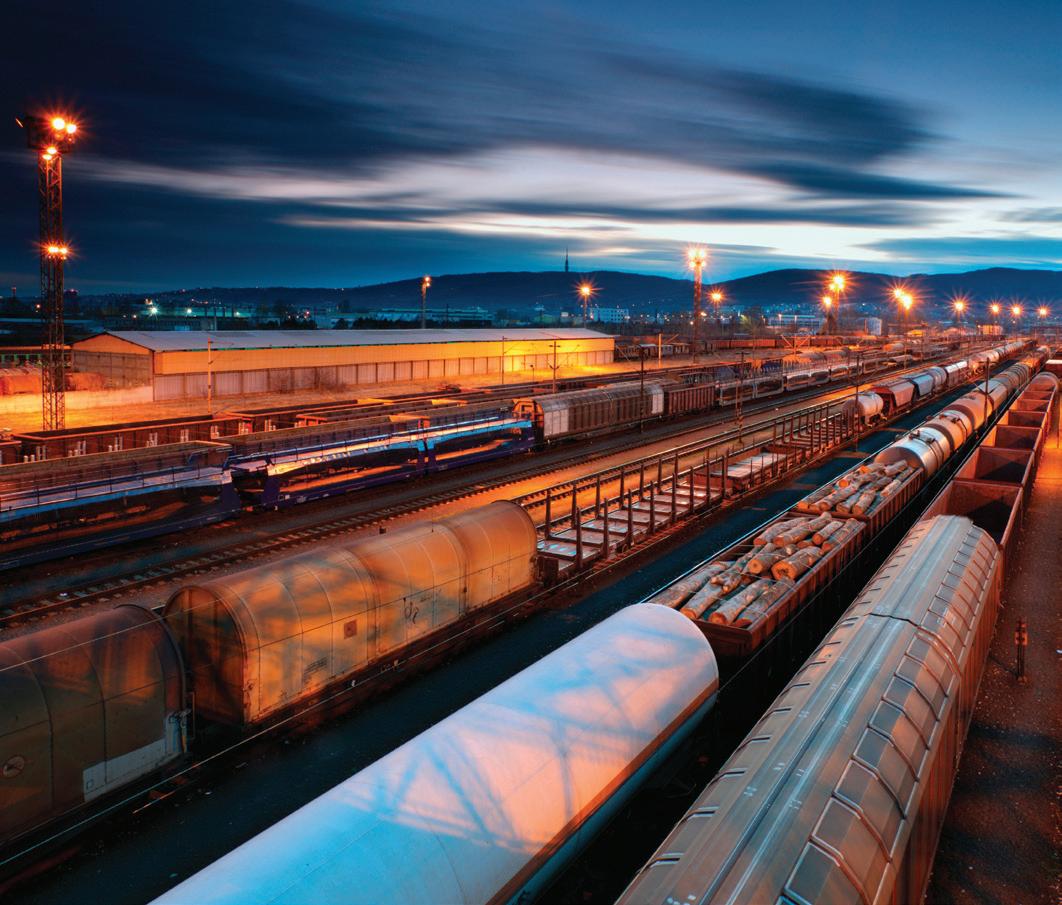
Azerbaijan is opening up new possibilities for future cooperation with the EU in clean energy technologies.
Corridor—a key segment of the trade route that connects Europe with Central Asia and China—has significantly increased its geopolitical and economic importance. As global supply chains adapt to evolving geopolitical circumstances and seek alternatives to traditional routes, Azerbaijan’s reliable infrastructure and connectivity offer valuable opportunities for Europe’s eastward trade expansion.
Notable infrastructure projects, such as the Baku–Tbilisi–Kars railway, have already made a measurable impact by enhancing freight transport efficiency between Europe and Asia. Supported in part through cooperation with EU institutions and partners, this railway provides a faster and more secure overland link that reduces transportation time and supports regional economic integration. In parallel, the Port of Baku, situated on the Caspian Sea, has evolved into a major regional logistics hub, serving as a critical
node for the smooth transit of goods across both land and sea. These improvements are not just national achievements for Azerbaijan but also contribute directly to the EU’s broader objectives of strengthening trade connectivity and infrastructure across the region.
Looking ahead, the prospects for deeper Azerbaijan–EU cooperation are strong. As both partners continue to engage on strategic issues such as energy security, green transition, infrastructure development, and digital innovation, the foundation for long-term collaboration continues to strengthen. Ongoing negotiations for updated legal frameworks, combined with continued European support for Azerbaijan’s economic and institutional modernization, ensure that the partnership
On May 28, 1918, following the collapse of the Russian Empire, Azerbaijani national leaders declared the establishment of the Azerbaijan Democratic Republic (ADR).
The ADR is considered the first parliamentary republic in the Muslim world and one of the first to grant women the right to vote—preceding even many Western nations. It embraced liberal democratic values and took initiatives that were remarkably advanced for the time, especially within the region.
Though the Azerbaijan Democratic Republic lasted only two years (1918–1920), the country made significant progress during this time with the creation of democratic institutions, promotion of universal suffrage, development of education, and active diplomacy, which laid the foundations of Azerbaijan’s modern statehood.
Every year on May 28th, Azerbaijan celebrates Independence Day, commemorating the founding of the Azerbaijan Democratic Republic (ADR) in 1918. This significant date marks the birth of the first secular democratic republic in the Muslim world. It is a moment not only of national pride but also of reflection on the country's journey through turbulent times, progressive achievements, and a forward-looking vision that connects Azerbaijan to the global stage.
In addition to industrial and scientific advancements, Azerbaijan experienced rapid urbanisation and infrastructure development. Cities like Baku, Sumgait, and Ganja became major industrial hubs, with factories producing machinery, chemicals, and consumer goods. The establishment of Sumgait as a major petrochemical center further strengthened Azerbaijan’s position in the Soviet economy.
Culturally, Azerbaijan saw a revival of literature and music in the examples of composers like Uzeyir Hajibeyli, Fikret Amirov, and Gara Garayev, who blended Azerbaijani folk music with Western classical traditions. Azerbaijani cinema also flourished, producing films that became popular across the USSR.
Despite these achievements, the Soviet period also brought political repression, restrictions on national identity, and economic dependency on Moscow. However, the advancements in industry, science, and culture laid the groundwork for Azerbaijan’s development after gaining independence in 1991.
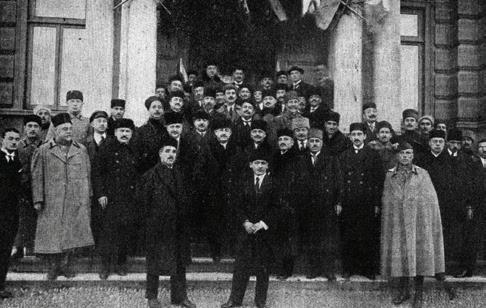
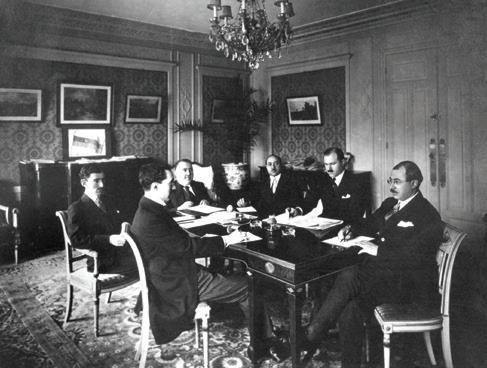
The decline of Soviet influence in the late 1980s ushered in a period of uncertainty and upheaval for Azerbaijan. The crisis had already begun before independence, with one of the most tragic events in Azerbaijan’s history on January 20, 1990—a night that is remembered as “Black January”. In an attempt to crush Azerbaijan’s growing independence movement, the Soviet army launched a brutal military operation in Baku, opening fire on unarmed civilians. At least 147 people were killed and hundreds more injured. The massacre was meant to instill fear, but instead, it deepened the people’s determination for independence.
At the same time, Azerbaijan was completely isolated internationally, lacking strong diplomatic ties or economic partnerships. Foreign investment was non-existent, and even humanitarian aid was scarce. With the global community paying limiting attention, the country had to face its crisis alone.
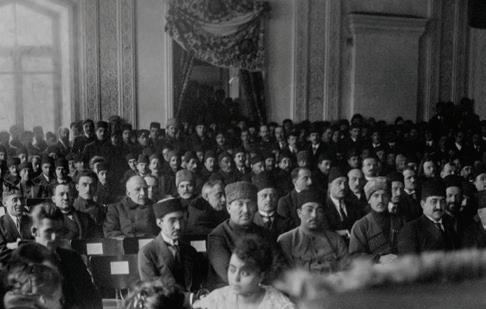
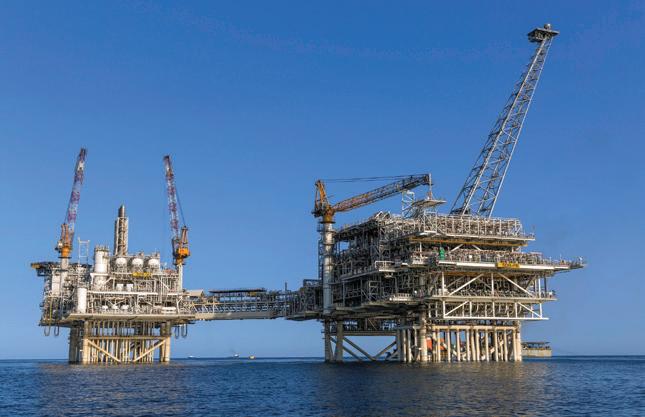
Following Heydar Aliyev’s election as the president of the Republic of Azerbaijan in 1993, Azerbaijan entered a period focused on national development.
In international affairs, Azerbaijan pursued a balanced and strategic foreign policy, strengthening its global partnerships and positioning itself as an important player in the regional and global energy markets. Diplomatic relations were expanded, and the country became an active participant in various international organisations. These efforts contributed to Azerbaijan’s growing reputation as a stable and reliable partner on the world stage.
In more recent years, Azerbaijan began a new phase of development with stability and economic momentum. Large-scale
will remain adaptable and resilient in the face of future global and regional challenges. The shared goals and interests that bind Azerbaijan and the European Union—ranging from energy and trade to connectivity, governance, and culture—provide a comprehensive and durable foundation for cooperation. In an increasingly interconnected and uncertain global landscape, the partnership between Azerbaijan and the EU serves as a valuable example of constructive engagement, balancing strategic priorities with mutual benefit. As Azerbaijan continues its integration into global economic and political systems, its evolving relationship with the European Union will undoubtedly remain a key element in shaping both its domestic development and its international role.
infrastructure projects, economic diversification efforts, and increased engagement in international affairs all lead to the strengthening of the capacity of the state.
From the outset, economic modernisation was a central focus of the government. Building on the foundation laid by earlier energy agreements, Azerbaijan directed revenues from oil and gas exports toward development initiatives.
The completion of key energy infrastructure projects such as the Baku-Tbilisi-Ceyhan (BTC) oil pipeline in 2005 and the Baku-Tbilisi-Erzurum (BTE) gas pipeline in 2006 enhanced the country’s role in regional energy supply. These efforts were later expanded through the Southern Gas Corridor, including the
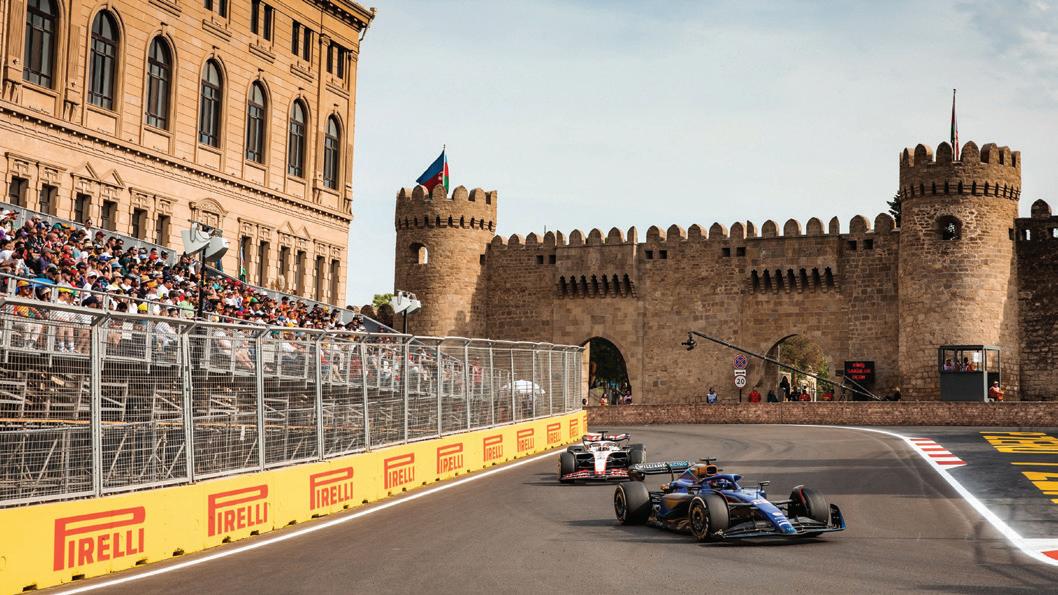

European businesses are increasingly active in Azerbaijan, supported by economic reforms and investment incentives.
TANAP and TAP pipelines, which strengthened Azerbaijan’s energy connections with Europe.
Infrastructure development gained momentum during this period. Investments in transportation and logistics transformed Azerbaijan’s connectivity. Projects like the Baku International Sea Trade Port contributed to Azerbaijan’s growing role as a transit and trade hub in the Caspian region.
Azerbaijan’s increased visibility in the international arena was furthermore reflected in its role as host of major global events and its active participation in multilateral platforms.
The country successfully hosted Eurovision 2012, the inaugural European Games in 2015, the annual Formula 1 Azerbai-
jan Grand Prix, and matches during UEFA Euro 2020. It also welcomed world-class events such as the Islamic Solidarity Games in 2017 and the International Astronautical Congress in 2023.
In 2024 Azerbaijan hosted the COP29 event that marked a new commitment to channel $1.3tn of climate finance to the developing world each year.
In the cultural sphere, Azerbaijan is regularly hosting the World Forum on Intercultural Dialogues. Baku has also served as a venue for high-level international forums, including the Non-Aligned Movement Summit and various UN, OIC and OSCE conferences, underscoring Azerbaijan’s commitment to international cooperation.

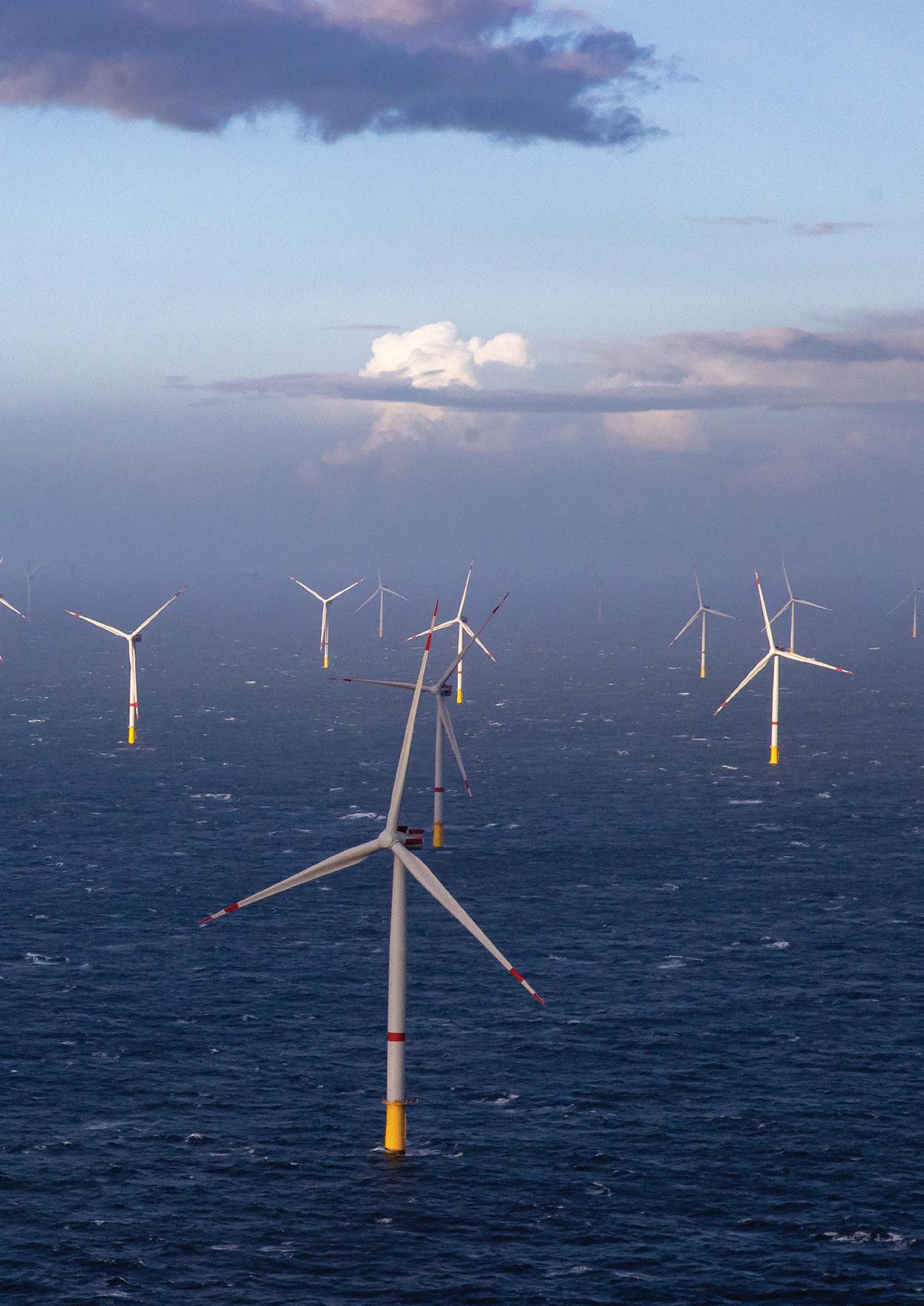
Wind energy now powers nearly one-fifth of Belgium’s generation mix. Yet the road to greener energy is proving far from smooth. A mixture of interregional squabbles, ballooning infrastructure costs, and confounding permitting delays continues to slow the country's progress. Even Belgium’s neighbours are complaining, as Dafydd Ab Iago reports
Earlier this year, Dutch firm Whiffle, specialists in atmospheric modelling, accused Belgium of a novel offence: wind theft. Belgian offshore wind farms, they argued, are disrupting wind patterns and reducing yields for turbines off the Dutch coast. “You’re often stealing some of our wind,” claimed Whiffle’s CEO Remco Verzijlbergh in an interview with Flemish broadcaster VRT. Delft-based Whiffle, which advises the Dutch government, insists its stance is apolitical. But its message stirred a breeze of nationalist indignation.
The phenomenon, known as the "wake effect", is well-documented: turbines alter airflow, reducing wind velocity downstream. And with Belgium’s newest wind farms placed southwest of the Netherlands’ offshore clusters, a clash of turbine trajectories was perhaps inevitable.
Belgium currently has 2.3 gigawatts of power capacity from offshore wind—out of 5.6GW in total wind capacity. Another 3.5GW is planned through the Princess Elisabeth Island project, a vast artificial energy island rising 45km off the coast. Construction began in April, with engineers submerging concrete blocks to form its perimeter.
But dreams of a sleek North Sea energy hub are already snagging on reality. The project's modular offshore grid, MOG2, was originally costed at €2.2 billion. Latest estimates put it between €7 and €8 billion. Energy regulators have issued warnings; politicians are muttering about fiscal recklessness.
Underlying these challenges is Belgium’s unique political structure — federated, fragmented, and frequently fractious. Unlike in the Netherlands or France, there is no single minister or national body coordinating wind energy strategy. Offshore wind remains the federal government’s remit; onshore is the domain of the regions. The result is a patchwork of overlapping policies, inconsistent
incentives, and sluggish execution.
“Of course, it’s a pity we don’t have a national strategy,” says Fawaz Al Bitar, director general of Edora, Belgium’s Walloon and Brussels French-speaking federation for renewable energy. “We need more coordination. But you know how it works in Belgium.”
Despite this, each region has made its own pledges. Flanders, currently with 1,858MW of onshore capacity, aims to reach 2,640MW by 2030. Wallonia, with 1,528MW today, wants to hit 2,500MW. Offshore wind capacity is expected to jump to 5,800MW nationally by the end of the decade.
But the Brussels capital region remains off-limits to large turbines. “You are in the vicinity of the airport with a radar, and so it’s not possible to install a large wind turbine in Brussels — for the moment,” Al Bitar says.
Wallonia is showing signs of ambition. Its 2030 target is expressed not in capacity but production — 6,200GWh of onshore wind power to be produced annually. That could incentivise the deployment of more efficient, high-output turbines. But turning ambition into infrastructure is no small feat. As of January, Wallonia had 589 turbines across 152 projects, totalling 1,528MW of installed capacity. Reaching the 2030 wind production target would require doubling capacity within five years – and only a quarter of project permits are currently approved. “It’s a major challenge. The commitment is a first positive step. Now the Walloon government has to do everything to make it possible,” Al Bitar says.
The region faces hurdles, particularly in permitting, with only 25% of wind project permits approved. “It is really a pity,” Al Bitar says. He blames both local opposition and government inertia. “We still have a sort of nimby approach to wind projects.”
Dafydd Ab Iago
In 2024, Flanders installed just 12 new wind turbines — the lowest number in a decade. To hit its goal, it needs 35 large turbines per year, according to the region's Energy and Climate Plan.
Flanders still needs to decide on the rules, but the tallest 250-meter-high turbines would have to be at least 750 meters away from the nearest home.
Flanders faces similar obstacles—though of a more contradictory nature. The regional government has revised its onshore wind capacity target upwards to 2.8GW by 2030, from its previous goal of 2.6GW.
With approximately 1.8GW installed today, the region must commission 200MW annually for the next five years. There is scope for more ambitious targets, but the wind energy sector is concerned that there is no plan to realise them.
In 2024, Flanders installed just 12 new wind turbines — the lowest number in a decade. To hit its goal, it needs 35 large turbines per year, according to the region's Energy and Climate Plan.
Despite challenges, Belgium has built a world-class offshore wind sector. DEME and Jan De Nul lead in logistics and installation. Parkwind, part of the Colruyt Group, is active across Europe and beyond. ZF Wind makes turbine drivetrains at its Lommel plant.
Recent developments, though, raise concerns about contradictory signals. Energy Minister Melissa Depraetere, from the centre-left peat of the previous overcompensation for renewable producers. Consumers’ energy bills will remain unaffected.
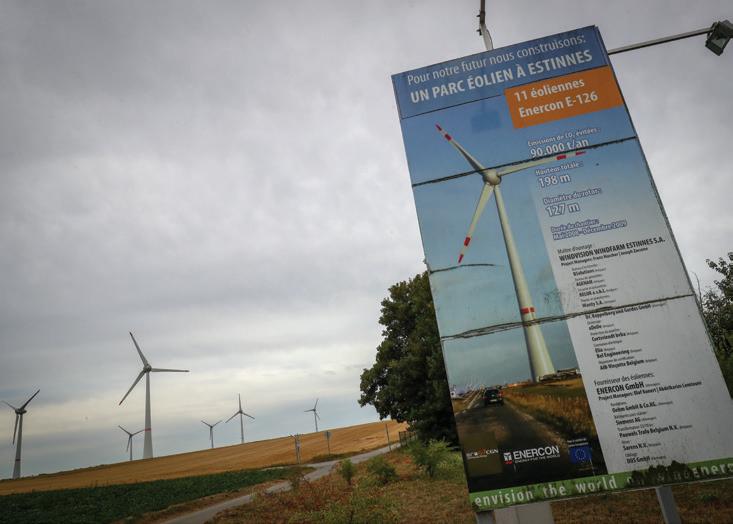

Yet just days later, Environment Minister Jo Brouns, from the centre-right CD&V, proposed stricter distancing rules. Under the proposed rules, turbines would need to be placed at least three times their tip height from residential areas. Taller turbines can generate up to three times more energy than first-generation windmills, but stricter planning rules for turbines over 200 meters would threaten Flanders’ ability to meet its wind energy targets. The rule would also increase the cost of green energy certificates for wind.
Flanders still needs to decide on the rules, but the tallest 250-meter-high turbines would have to be at least 750 meters away from the nearest home. The rules could severely limit viable sites in densely populated Flanders. “It’s a contradiction,” says Maarten Dedeyne of the Flemish Wind Energy Association (VWEA). “A minister announces good news one day. Three days later there’s bad news for the sector. Regulation cannot change every one or two years. That’s very difficult for projects that need several years from scratch to build.”
Depraetere has since tried to reconcile with her government colleague. “Minister Brouns also agrees with the ambition to install more wind turbines. He might have been somewhat shocked himself by the concrete impact of the ‘three times tip height’ rule, which essentially means you’d hardly be able to place any wind turbines anywhere,” Depraetere told the Flemish Parliament. “No decision has been made about that either. It would also mean that Flanders would practically become a red zone for those wind turbines.”
Depraetere underscored the point that large wind turbines require less financial support and generate more energy than smaller models. The Flemish Energy and Climate Agency (VEKA) has calculated that smaller turbines still need about €20.8 per megawatt-hour in support, though savings on energy costs would outweigh these subsidies.
Nuclear or wind?
Meanwhile, nuclear power is creeping back into the mix. In May, Belgium repealed parts of its nuclear phase-out law, reopening the door for new nuclear development.
“It is no longer a matter of pitting energy
sources against each other in a binary, sterile debate, but of using them pragmatically and in complementarity,” Federal Energy Minister Mathieu Bihet, from the right-wing MR, told us. “You need electricity to phase out fossil fuels. You need it for heat pumps, for electric vehicles, for industry. And we don’t have enough of it.”
But renewable advocates like Edora's Al Bitar warn the shift could crowd out wind and solar. “With lots of nuclear remaining on the grid, you’ll have to increase storage capacity or demand-side management capacity. But will there be curtailment of wind and PV?” Al Bitar says.
On costs compared to nuclear, Al Bitar argues that new renewables still come out ahead. “We have to compare new wind capacity with new nuclear. And here renewables are the cheapest,” he says. Al Bitar also noted that Belgians have already paid for the country’s existing nuclear plants. “If you prolong their lifetime, then existing nuclear plants are not comparable to new wind farms,” he says.
Indeed, offshore wind farms now reach capacity factors of 50%, with onshore installations averaging between 30% and 45%. That outpaces solar PV at 20%—though still lags nuclear’s formidable 90%.
Belgium is hardly a failure when it comes to renewables. “No country in the world today has more offshore wind per square kilometre of its sea space than Belgium,” says WindEurope CEO Giles Dickson. Public support is also strong, with over 70% of Belgians backing onshore wind.
One reason is that onshore wind farms pay money via taxes to local town halls. Belgium’s model tenders to finance wind projects minimise financing costs, with developers offering the lowest price winning bids. The country uses a contracts-for-difference (CFD) model for wind auctions, offering guaranteed revenue for at least 15 years, potentially lowering financing costs. “There’s also a non-price criterion — the level of community participation in the project,” Dickson tells us.
Challenges remain even as Belgium actively expands its wind energy sector with the Princess Elisabeth offshore wind island. Plans for a second UK-Belgium interconnector to Princess Elisabeth are “on hold” due to rising HVDC power cable costs. Wind provided 18% of Belgium’s generation mix in 2024, slightly below the European average of 20% but ahead of Belgian solar at 12%. “Wind is by far Belgium’s most important renewable source of electricity,” Dickson says.
Still, persistent permitting delays weigh heavily. New EU rules stipulate that all re-
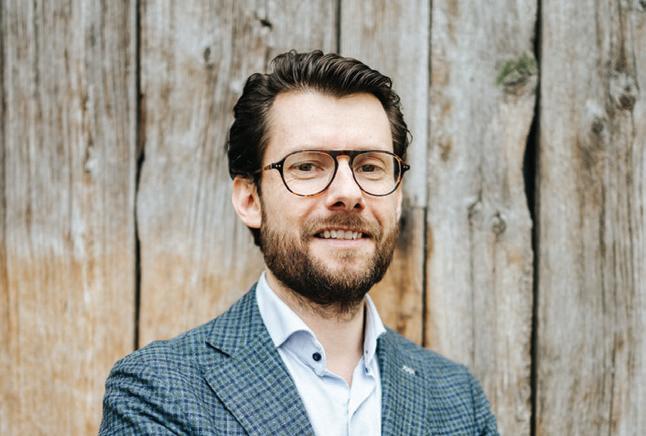
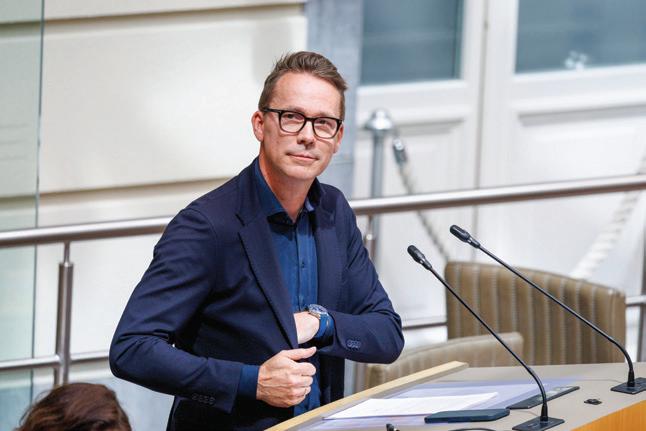
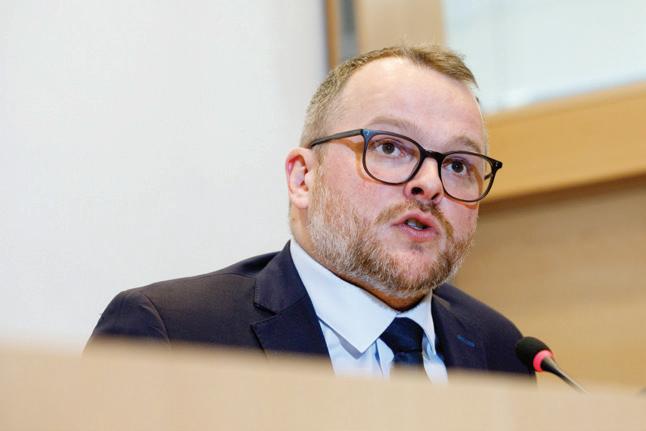
newable projects must be treated as matters of overriding public interest, with permits issued within two years. Yet Belgium has been slow to implement the new framework, and risks infringement proceedings if it fails to
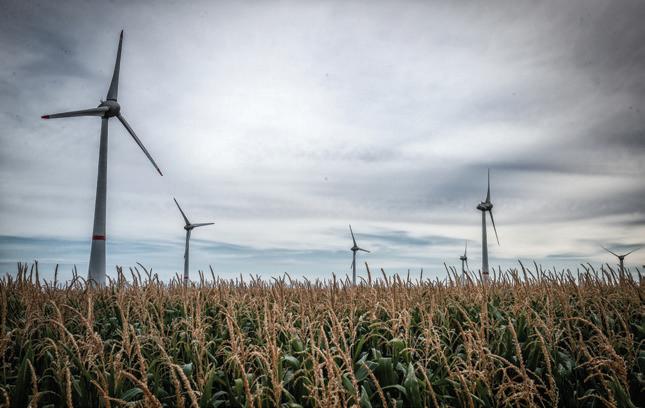
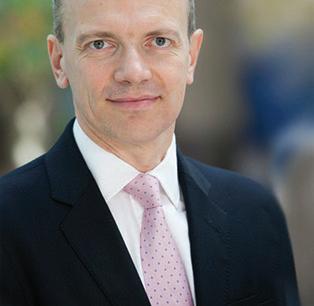
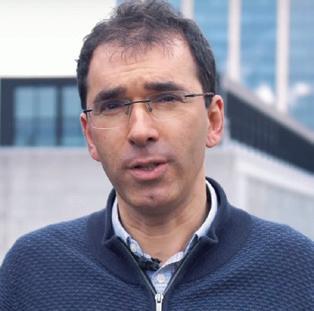
Wind provided 18% of Belgium’s generation mix in 2024, slightly below the European average of 20% but ahead of Belgian solar at 12%.
submit its revised national energy and climate plan to Brussels.
While Germany is actively applying these rules, Belgium — like many other EU countries
Industry groups are pressing Belgium to enact the EU’s Renewable Energy Directive (RED III), which mandates faster permitting and prioritisation of renewables. Flanders has digitised the process. Nationwide implementation lags.
Belgium’s low national renewable energy target of 18.4% by 2030 — is among the least ambitious in the EU and a figure critics say reflects the country’s lack of ambition (wind energy alone now accounts for more).
The ETS carbon trading system, in place since 2005, is expanding. ETS2 will cover transport and home heating too.
Tax rebalancing should be a key reform to help Belgium move toward a climate-neutral economy, shifting energy taxes away from electricity to fossil fuels, says Bright Adiyia, a researcher at Flanders’ VITO Institute. “Compared to neighbouring countries, Belgium has the lowest taxes — including excise duties, VAT and carbon levies — on natural gas
— lags behind. Ultimately, it’s up to the Flemish and Walloon governments to implement the new EU permitting rules for onshore wind in Belgium. So far, Brussels has yet to install wind turbines.
Additionally, Belgium, alongside Poland and Estonia, faces potential proceedings at the European Court of Justice if it doesn’t submit long-delayed national energy climate plans to the EU. The deadline has already passed. Those plans should detail how wind and other renewables will help cut greenhouse gas emissions by 2030. Other priorities include fully digitalising permitting processes as required under EU law and further building out grids both offshore and onshore to support heavy industry electrification, such as in the Antwerp petrochemical cluster. Belgium could also embrace repowering — replacing older, less efficient turbines with modern ones on existing sites — increasing output while potentially reducing the number of turbines. It’s a win-win, delivering much more energy from the same wind farms.
In Denmark, wind makes up over half of all electricity produced. In Germany, the figure is about 30%, much of it in the densely populated north. So Belgium — with 16% wind in its power mix — cannot use population density as an excuse. There’s still plenty of room for new wind farms onshore.
Belgium’s wind and renewable energy sector faces growing pressure as Europe races to slash greenhouse gas emissions by 55% by 2030 and achieve climate neutrality by 2050. The wind may not always blow in Belgium’s favour. But the country has the tools — if it can summon the political will to use them.
and heating oil. As a result, consumer prices for these fuels remain lower than in surrounding nations,” he says.
The issue is politically sensitive. As of January 2025, federal excise duties for households stood at €9.5/MWh for natural gas versus €49.4/MWh for electricity — whether from wind, solar or gas power plants. Adiyia warns that incentivizing early investment in renewables through fairer electricity taxation reduces long-term costs and helps Belgium hit its emission targets faster.
Missing emissions targets could cost Belgium billions. Belgium’s overall targeted emissions cuts in sectors like agriculture, transport and buildings are expected to fall short of the EU-mandated 47% by 2030. The gap could force Belgium to purchase carbon credits at potentially staggering costs, possibly exceeding €2 billion, depending on future carbon prices.

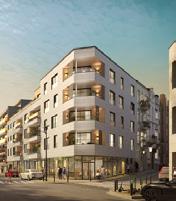
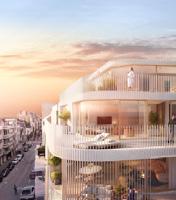
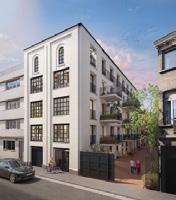
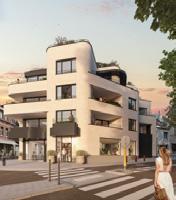

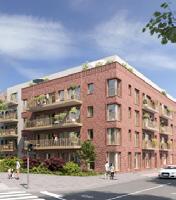

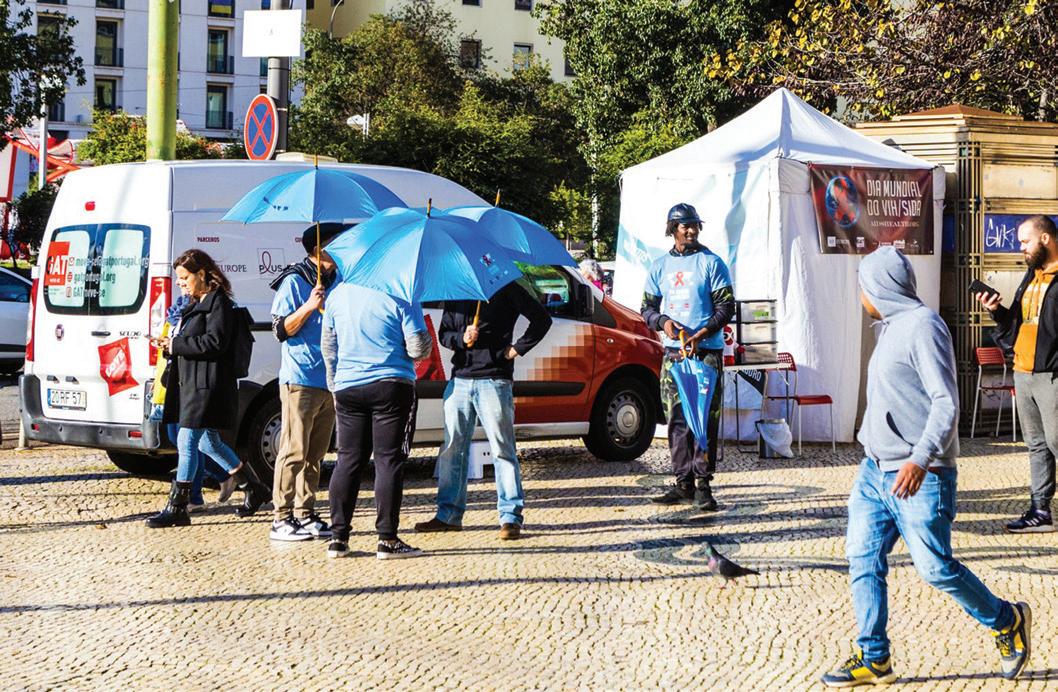
According to a 2022 report from the ECDC, 73% of countries in Europe and Central Asia restrict who can legally perform an HIV test.
According to the European Centre for Disease Prevention and Control (ECDC), 1 in 5 people living with HIV in Europe remain undiagnosed. Across the continent, outdated laws are standing in the way of progress in the fight against HIV. Despite clear evidence that community-based testing by trained, non-medical lay providers improves access and outcomes, many European countries still prohibit this life-saving approach.
These restrictions aren’t just bureaucratic— they are blocking effective tools that could help eliminate AIDS as a public health threat.
Lay provider testing plays a crucial role in reaching people often missed by traditional healthcare systems: people who inject drugs, men who have sex with men, sex workers, and migrants. These key populations may avoid clinics due to stigma, discrimination,
or logistical barriers.
According to a 2022 report from the ECDC, 73% of countries in Europe and Central Asia restrict who can legally perform an HIV test. Even where community-based testing is allowed, it is often limited to medical professionals—undermining accessibility and impact.
This goes directly against the World Health Organization’s 2015 guidelines, which recommend task-sharing to trained, non-medical providers to expand access and increase uptake of HIV services—especially in community settings.
So, what does this look like in practice? It means trained community members providing rapid, confidential HIV tests in real-world environments: at truck stops and transit hubs, in nightclubs and bars, at locations where sex work occurs, in communities where migrants
live and work, or in underserved urban areas with high rates of drug use. These are places where trust matters, and where traditional health services often don’t reach.
Crucially, community-based testing comes with strong peer support. People are more likely to test and follow up when they’re supported by someone who understands their lived experience. This peer-led model helps more people get linked to care—something that can’t always be guaranteed in traditional health systems.
Beyond improving access, lay provider testing enhances the responsiveness, efficiency, and cost-effectiveness of HIV services. It reduces pressure on overburdened clinics and makes care more people-centered. And it leads to better health outcomes: earlier diagnosis means earlier treatment. Late presentation remains a serious issue across Europe, with too many people entering care only after their immune systems are already compromised.
Allowing lay provider testing is a lowcost, high-impact reform and one that aligns with the EU’s broader priorities under the European Health Union and Sustainable Development Goals.
At AIDS Healthcare Foundation (AHF), we witness the impact of legal barriers to lay provider testing every day. In countries like Ukraine, Georgia, Estonia, and Poland—where such testing is still prohibited—our ability to reach people most at risk is significantly constrained. In contrast, countries that have embraced this approach, such as Portugal, demonstrate the tangible benefits. Our partner, GAT (Grupo de Ativistas em Tratamentos), successfully advocated for the legalization of lay testing after many years of persistent effort.
Since 2010, Portugal has permitted lay provider testing—a model first pioneered by GAT and now implemented in partnership with AHF by more than 20 community-based organizations (CBOs). These trained lay providers offer stigma-free, high-impact HIV testing services specifically designed to reach marginalized and underserved populations. Today, lay testing is a cornerstone of Portugal’s national HIV response: CBOs account for approximately 77% of all HIV screening tests conducted in the country and are responsible for identifying around one-third of all new HIV diagnoses. Among those diagnosed, 90% are successfully linked to healthcare services, and 52% were undergoing HIV testing for the first time.
The Portuguese success story should be the norm—not the exception. HIV testing is the gateway to prevention and treatment. Without it, progress stalls. Removing legal barriers to lay provider testing isn’t just smart policy—it’s a human rights imperative.
It’s time for European governments to bring national laws in line with global best practices. Community-led testing works. Let’s empower the people already doing the work—and break down the barriers standing in their way.
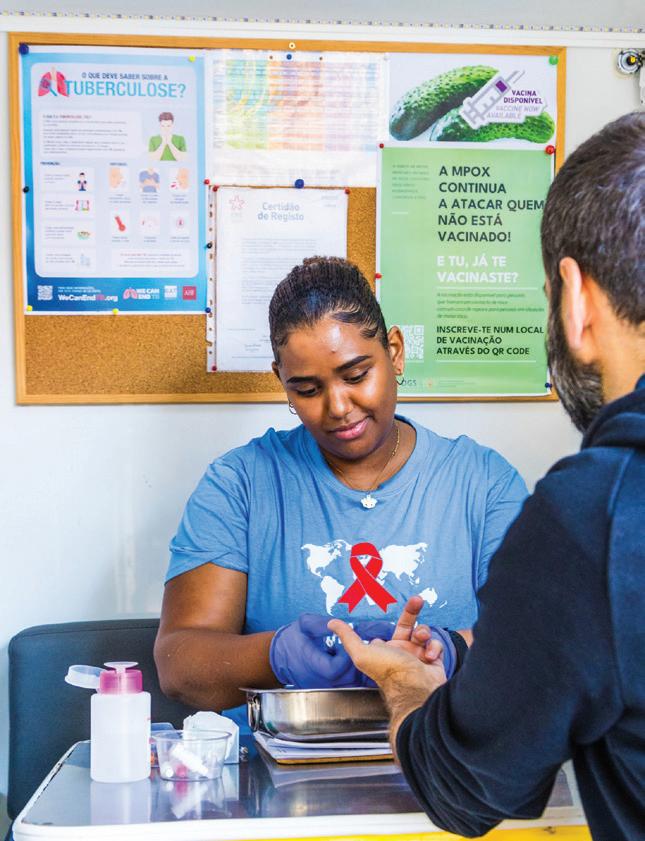
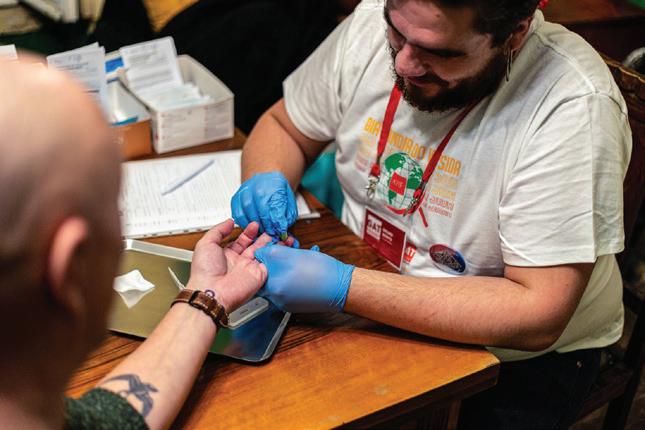
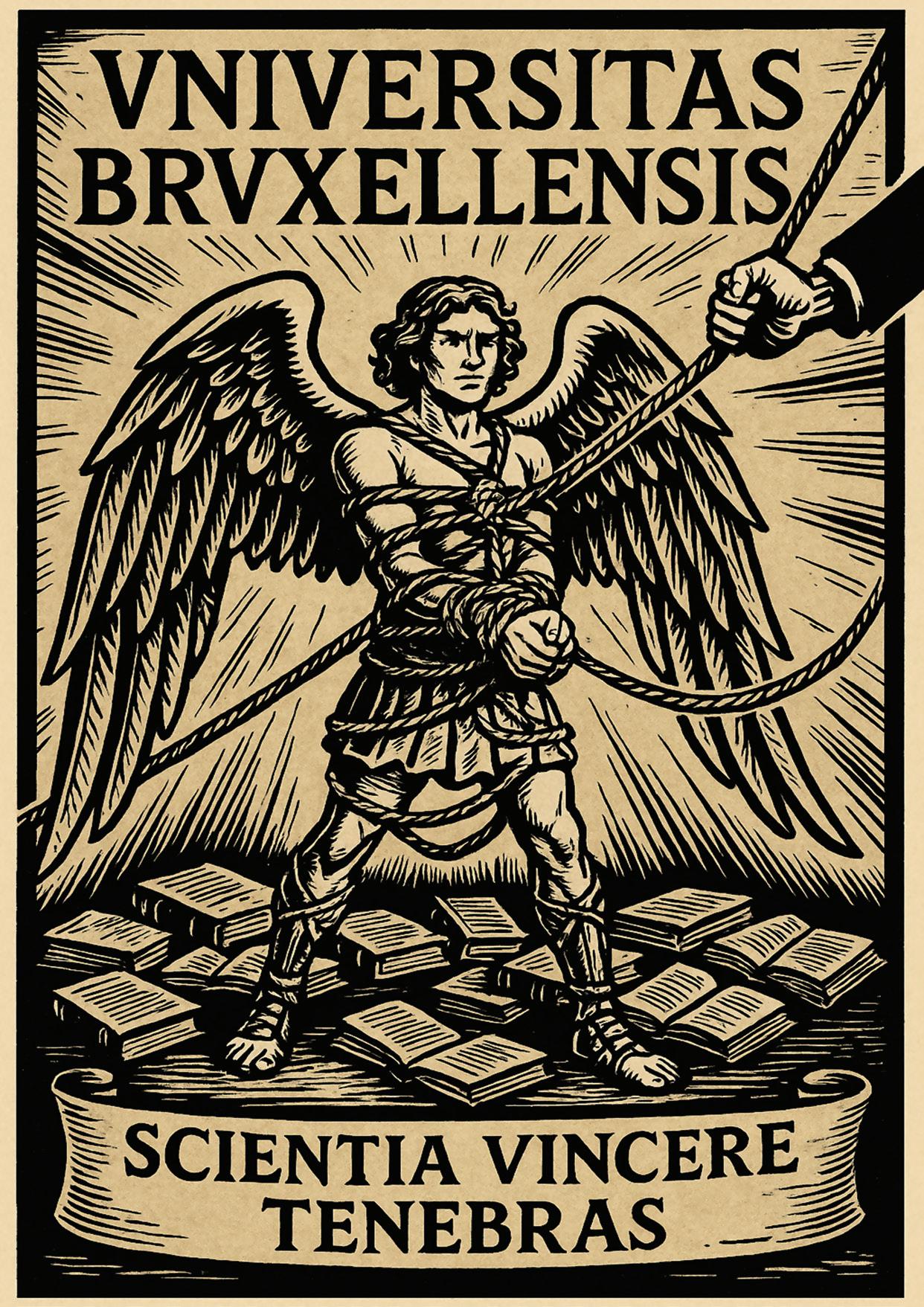
As American universities face mounting political attacks, Philippe Van Parijs reflects on the long, uneasy path to greater academic freedom in Belgium — from clerical control to today’s peer pressure. He warns that censorship can come from bishops, politicians and colleagues — and that vigilance must never be one-sided
American institutions of higher learning have in common the essential freedom to determine what is taught, how, and by whom. Our colleges and universities share a commitment to serve as centres of open inquiry where faculty, students and staff are free to exchange ideas and opinions without fear of censorship or deportation.” So declared hundreds of American university presidents on April 22 in a public response to US President Donald Trump’s ferocious public attacks on Harvard University.
When reading the statement, I confess to experiencing a feeling of pride. Pride because so many universities united to defend academic freedom. Pride because Harvard, where I taught for several years, was taking the lead despite (and no doubt also because of) its being the main focus of attacks: in May, Trump ordered a ban on foreign students at Harvard). Pride also because European universities seem remarkably preserved from such threats. Belgium, in particular, seems to be doing quite well.
Every year, an index of academic freedom is published by the University of Erlangen-Nürnberg. It aggregates several dimensions, such as institutional autonomy, the absence of interference in research and teaching and the freedom to communicate ideas and findings. In the 2025 edition, Belgium is ranked fifth out of 179 countries, preceded only by Czechia, Estonia, Jamaica and Sweden. This flattering place may well be deserved. However, at least judging by the history of my own university, Belgium’s performance in terms of academic freedom cannot have been that brilliant up to quite recently.
Academic freedom is not the same as freedom of expression, and it is legitimately subjected to tighter restrictions. Freedom of expression is the freedom to say and write whatever one
wishes wherever one wishes. It is limited as regards both content and context - though the extent varies from one country to another. Typically, speech should not incite violence, defame particular individuals or advertise poisonous products. Blasphemous, racist, sexist, negationist and hate speech are also often prohibited by law. Moreover, the exercise of freedom of expression must respect the rules of public order. By transgressing such restrictions on the content or context of speech, one exposes oneself to penal sanctions. Whether one is an academic or not makes no difference.
Academic freedom, by contrast, is a privilege claimed by academics in the form of immunity from professional sanctions such as being fired, denied a promotion or reprimanded. It is the academics’ freedom to exercise their profession as they see fit, whether as teachers, researchers or public intellectuals. It covers what they say or write in their classes, their scientific publications and their public interventions — hence the connection with freedom of expression — but also what they do, for example how they evaluate their students or conduct their experiments.
While protected against a broader range of sanctions than freedom of expression, academic freedom is subjected to a stricter and more specific set of limitations that are best enforced by academic authorities, governments, or peer groups, depending on the case. For example, universities assign to their professors the task of teaching specific subjects to specific categories of students at specific times; governments require university experiments on human beings to be conditioned on the latter’s informed consent; and peer groups penalise sloppy research by preventing it from being subsidised or published.
The relevant question, therefore, is not whether academics should enjoy academic freedom, but rather how extensive this freedom should be. And the academics’ answer is: very. Extensive academic freedom is needed
Philippe Van Parijs
Academic freedom is not the same as freedom of expression, and it is legitimately subjected to tighter restrictions.
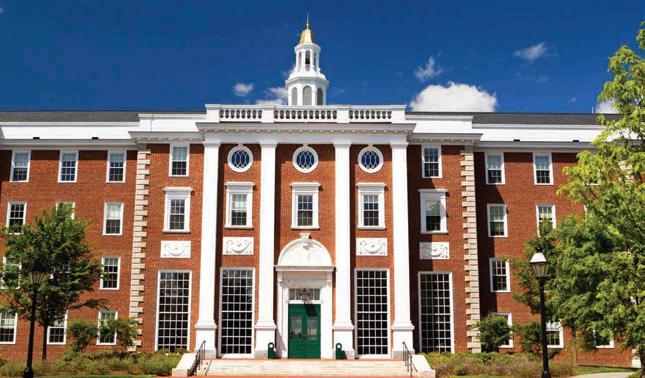
Harvard University, often seen as the most prestigious US higher education establishment, now embroiled in a dispute with the Trump Administration
In Louvain no less than in Brussels, scientia seems to have defeated the tenebras.
for the effective accomplishment of academia’s missions, and restrictions are only legitimate if they contribute to the effective and lasting accomplishment of these missions: the production, transmission and dissemination of knowledge.
A fascinating book just published, Academische vrijheid. Een Leuvense geschiedenis (Academic freedom. A Louvain/Leuven history) documents how long it took for the University of Louvain/Leuven to achieve a protection of academic freedom that can plausibly claim to meet this criterion. The old university, born in 1425, was brutally abolished by the French revolutionary troops in 1797. In 1834, shortly after the creation of the independent Kingdom of Belgium, its catholic bishops decided to found the Université catholique de Belgique. Briefly located in Mechelen, the seat of the archdiocese, it was renamed Université catholique de Louvain the following year, when the bishops took hold of the old university buildings in Leuven (where it operated -in French only until the 1920s, in French and Dutch until the 1970s, and in Dutch only since then, as the French section moved the new site of Louvain-la-Neuve).
Two weeks after the founding of the Université catholique de Belgique, Brussels’ freemasons founded the Université libre de Belgique, renamed Université libre de Bruxelles in 1842. Both universities were taking advantage of the “freedom of education” recognised by Belgium’s 1831 liberal constitution. Unlike the state universities of Ghent and Liège founded by the Dutch king two decades earlier, they did not rely on government resources, but in one case on the money collected one Sunday a year in every Belgian parish and in the other, on the generosity of the country’s liberal bourgeoisie. This financial autonomy helped secure one important dimension of academic freedom: freedom from interference by the government. In militant contrast to the Catholic university,
the Université libre de Bruxelles was determined to go further. It adopted as its motto “Scientia vincere tenebras”, where “tenebras” was meant to refer to religious obscurantism. Its student anthem, still sung today on official occasions, is called “A bas la calotte”, with “calotte” referring to the skullcap that priests wore. And the fundamental principle which its professors are still required to adhere to is “libre examen”, best translated as free inquiry. What the newly created Université catholique de Louvain expected from its professors was quite different. Article 21 of its first statutes bluntly stated: “Academic education must be in harmony with the principles of the Catholic religion. Professors are obliged not only to refrain from teaching anything contrary to religion, but also to use the opportunities offered by the subject of their courses to teach students that religion is the basis of the sciences, and to instil in them a devotion to religion and to the duties it imposes.”
At one time, around one-fifth of Louvain’s professors were Catholic priests. They were not allowed to publish without an “imprimatur”, granted by their bishop. The first set of professors included a certain Gérard Casimir Ubaghs, a philosopher and priest who developed a philosophical theory inspired by the influential liberal-Catholic French priest Félicité Lamennais. The bishops of Liège and Bruges did not like that at all. They complained to the Congregation of the Index prohibitorum librorum in Rome, which forced Ubaghs to change his views. Rector De Ram took Ubaghs’ defence. But the bishops would not budge. They banned priests from their dioceses at the university and suspended the annual collection of money until Ubaghs was sacked in 1866, after the rector’s death.
Priests were more strictly scrutinised, but the academic freedom of other professors was not immune from interference by religious authorities. Just one example. The English biologist St. George Jackson Mivart, author of The Genesis of Species, discussed and criticised by Darwin, obtained a doctorate in medicine at the University of Louvain in 1884. In 1890, he was appointed to teach natural philosophy at the university’s Philosophy Institute, which had been founded the previous year by the future archbishop Désiré Mercier with the support of Pope Leo XIII. Mercier was the driving force behind Neo-Thomism, which saw science and religion as two distinct paths towards the truth, perfectly compatible with one another. He created chairs of cosmology and experimental psychology in his institute, and Mivart was in charge of teaching the theory of evolution. However, the bishops resented his presence at Louvain, and he was forced to resign in 1894, despite Mercier’s opposition.
The grip of the religious authorities on
teaching and research gradually weakened over the following decades. After World War I, the research conducted at the university sought funds from sources beyond the church as it aspired to international recognition. The rectors therefore fought for more autonomy from the bishops, while the bishops sometimes fought for more autonomy from Rome. Thus, Mercier, by then appointed archbishop, made a half-successful trip to Rome around 1925 to try to prevent the Vatican’s Biblical Commission from censoring the writings on evolution theory (once again) by geology professor and priest Henry de Dorlodot.
Georges Lemaître was another Louvain professor and priest. An esteemed friend of Albert Einstein, he had a doctorate in mathematics from Louvain and a doctorate in physics from MIT. In 1931, he published his ground-breaking Big Bang theory that conjectured (later empirically verified) that the universe is expanding. He took great care to emphasise that his conjecture, if correct, neither confirmed nor refuted the thesis that the universe was created by God. The Catholic authorities left him in peace. From then on, there seems to be no trace of religion-based interference with the work of Louvain’s natural scientists.
Philosophy is another matter. According to the first “règlement général” of the university, enacted in the 1830s, philosophy classes had a
very specific role to play. They were compulsory for first-year students in all Faculties and were charged with teaching them “the fundamental truths of religion.”
I started my lecturing career at the Université catholique de Louvain in September 1980 by teaching precisely one of those compulsory philosophy classes, to first-year students in economic, social and political sciences. I had just returned to Belgium with my DPhil in philosophy from Oxford and was asked to replace a young priest who had announced that he was marrying one of his doctoral students (soon to become a member of one of Portugal’s first democratic governments) and had been dismissed on the spot. The disgraced priest had himself been acting as a substitute for our colleague André Léonard, Belgium’s future archbishop, who was busy directing the seminary he had just founded in Louvain-la-Neuve.
After three years, I was abruptly sacked from this teaching assignment without any warning by rector Monseigneur Edouard Massaux. When I asked him for the reason, all he said was, “It is possible that some people don’t like some of the ideas you present in the course.” To the indignant president of the philosophy institute, he was somewhat more specific: “There are too many Marxists in that Faculty.”
I have never been a Marxist, but I did devote one session, in the political philosophy part of the course, to a presentation of the Marxist critique of capitalism. I do not believe that, in 1980, the rector still expected first-year phi-
Surely, professors should be allowed to address controversial moral issues in moral philosophy classes.
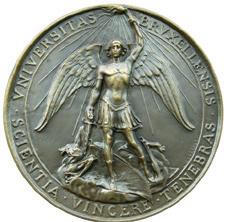
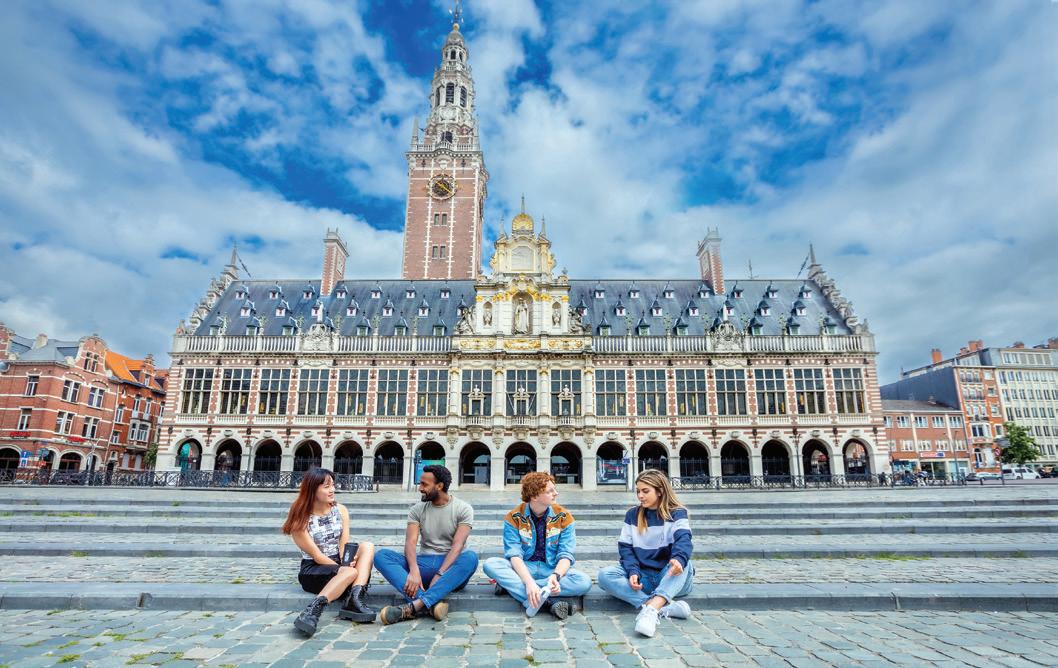
It is no bad thing for a university to have non-conformist, even eccentric, personalities among its teaching staff.
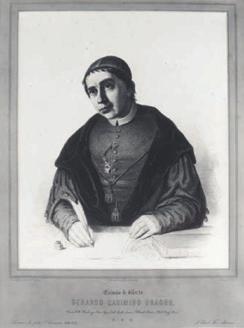
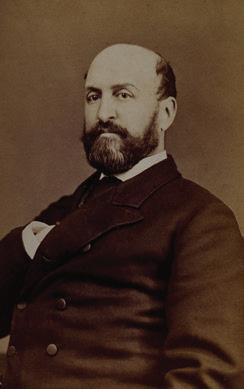
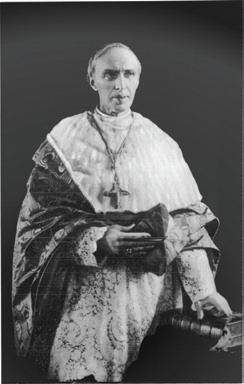
losophy courses to teach, as in 1834, “the fundamental truths of religion”. But he probably expected me to warn my students, if I chose to include something on Marx, that anything coming from someone who wrote that religion was “the opium of the masses” should be looked at with the greatest suspicion. Incidentally, it is quite amazing how Marx can still trigger such anguish over a century after his death, not least among people unlikely to have ever read one line by him. "We are going to choke off the money to schools that aid the Marxist assault on our American heritage and on Western civilization itself,” Donald Trump declared in a speech in Florida in 2023.
I was deeply disappointed by my abrupt sacking, as I was convinced that both the content and style of my course was what my students needed — rather than the off-putting overview of the history of philosophy that my predecessors used to teach. But I had a comfortable tenured research position and the teaching job was given to a friend who needed it more than me. Hence, I did not make a fuss — although I perhaps should have done, as a potential modest contribution to the elimination of the last remnants of blatantly illegitimate religion-inspired infringements of academic freedom.
Massaux was the last priest to serve as the university rector and it is unlikely that there will ever be another one. One of the first acts of his successor, rector Pierre Macq, was to ask me to give that philosophy class again. A few years later he invited me to set up and direct the Hoover Chair of Economic and Social Ethics, whose role, admittedly, involved some “preaching”, but not the preaching of “the fundamental truths of religion”.
The history of the Université catholique de Louvain since 1834 can therefore be fairly described as a somewhat hobbling march towards full academic freedom from interference by religious authorities — a gradual adoption, some would say, of the Université libre de Bruxelles' principle of “libre examen”. In Louvain no less than in Brussels, scientia seems to have defeated the tenebras.
True, the archbishop of Belgium is still the Grand Chancellor of both the Dutch-speaking and French-speaking universities (officially split since 1970), but what this means has shrunk dramatically over the decades. In November 2011, André Léonard, by then appointed archbishop, accepted my invitation to a dialogue with my hundreds of bachelor students. He told them straight away: “Yes, I do chair the ‘pouvoir organisateur’ of your university, but this ‘organising power’ has two characteristics: it has no power and it organises nothing.” The recent replacement of “Katholieke Universiteit Leuven and “Université catholique de Louvain” by “KU Leuven”
and “UCLouvain” as the universities' public names can be interpreted as a discrete consecration of this evolution.
However, an incident that triggered some media attention a few years ago may make one wonder whether this emancipation from the tenebras is overshooting. In March 2017, a parttime lecturer was teaching a moral philosophy class at UCLouvain when his lecture was recorded without his knowledge by a student and posted on YouTube. In his lecture, he presented some arguments against the Belgian legislation that legalised abortion. The university authorities looked into the matter and decided to suspend him and not renew his teaching contract.
I was shocked. Surely, professors should be allowed to address controversial moral issues in moral philosophy classes, to make an empathic presentation of a view that deviates from what is currently considered politically correct, and to make clear that this view is also their own. What can be problematic, however, is a confusion between teaching and proselytising.
On controversial issues, it is important to make students aware of the diversity of positions and the strength of the arguments supporting each of them. This can be done through a balanced presentation by the teachers themselves, but also through assigning students the task of defending contradictory positions as best they can or through inviting guest speakers chosen for their ability to defend intelligently positions that differ from those of the teacher. Even in barely controversial subjects, the aim must not be to pass on knowledge as dogma, but to explain based on which observations and reasonings a consensus has been reached.
To judge whether, in this particular case, a teaching position was misused for proselytising purposes, one would need to know more about how the segment posted on the internet fitted into the rest of the course. However, academic authorities should resist the temptation to use sanctions selectively to punish those whose actual or apparent teaching deviates from their own convictions or from the quasi-consensus that happens to prevail. In the Catholic world, those who argued that abortion should be legalised used to face serious trouble. The university should not try to get forgiveness for its past sins by hypercorrectly chastising those who argue now that the legalisation of abortion has gone too far.
It is no bad thing for a university to have non-conformist, even eccentric, personalities among its teaching staff. There are no
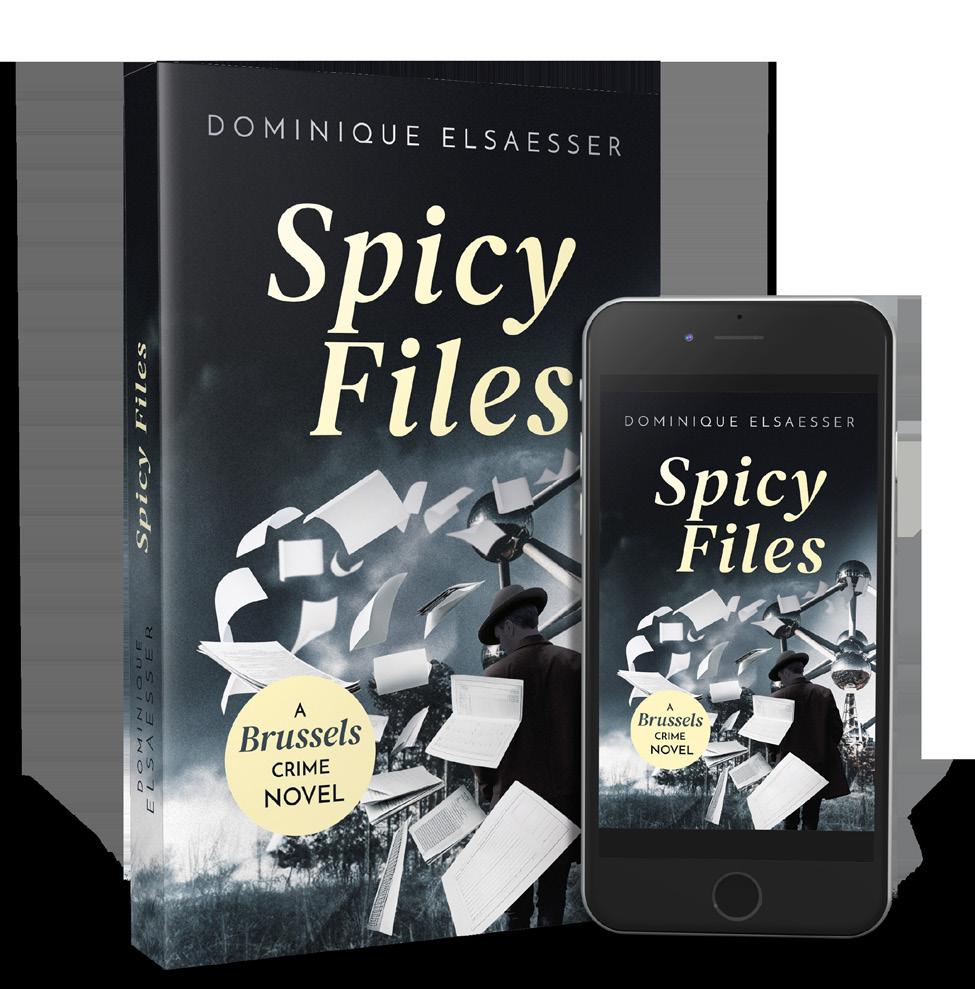
“Anarchically funny and subversive”
“Dominique Elsaesser has a knack for sublime storytelling”
“Required summer reading for all who love and hate this city”
Pre-order your copy now on amazon!!!
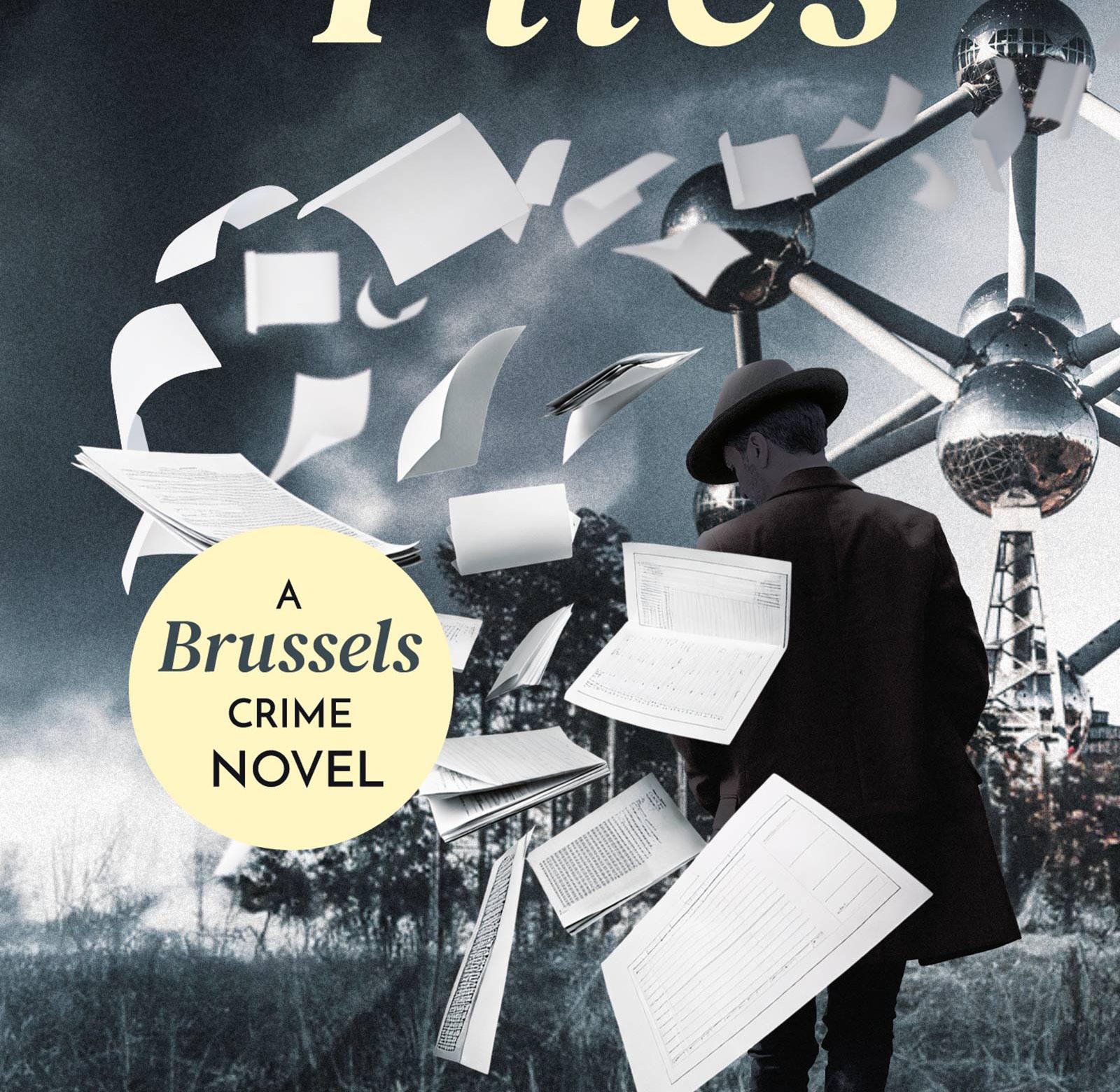
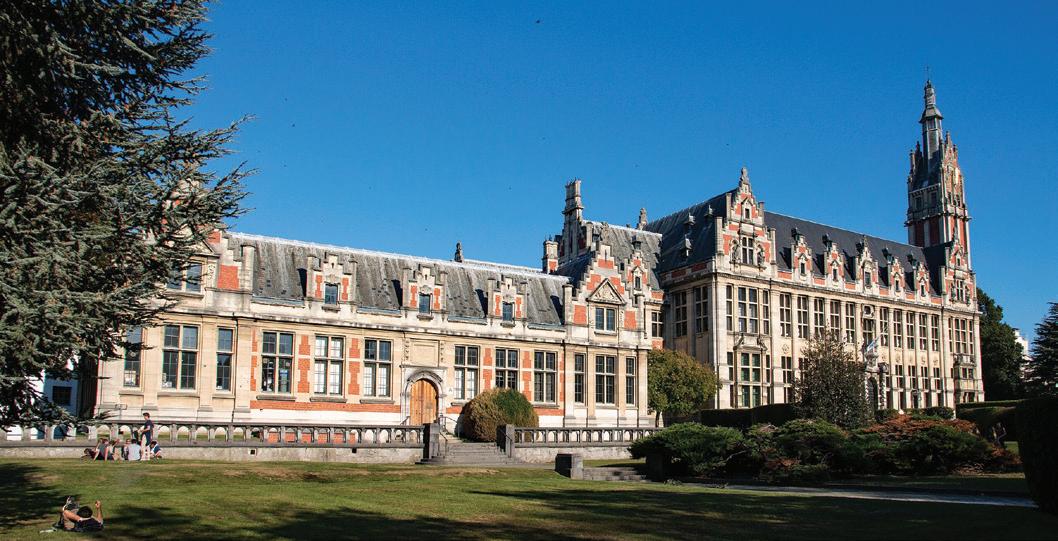
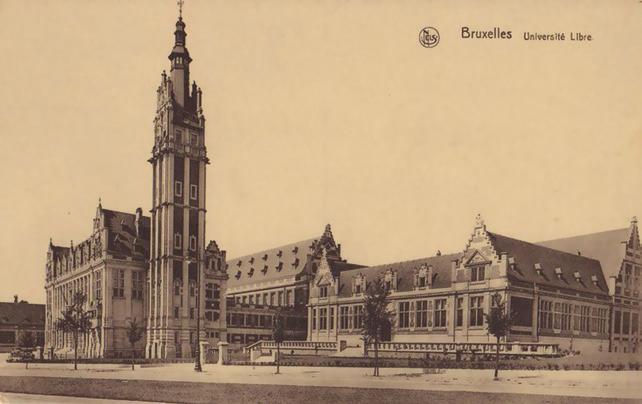
The legitimate privilege of academic freedom can be threatened from within as well as from above.
doubt excesses to be avoided. To keep these in check, however, one must not rely on denunciations of the kind encouraged today by MAGA fans in American universities or on disciplinary procedures that restrict academic freedom from the top. One must rather rely, as far as possible, on an anti-dogmatic yet responsible ethos that is sufficiently shared within the university community and on the informal sanctions by peers that go with it.
Academic freedom, however, might also be undesirably restricted by the peer group. In a book entitled Is links gewoon slimmer? Ideologie aan onze universiteiten (Is the left simply smarter? Ideology in our universities, Leuven, 2023), Andreas De Block, professor of philosophy of science at KU Leuven, reflects on the causes and consequences of the — apparently well established — overrepresentation of (loosely defined) left-wing electoral preferences and points of view among uni-
versity professors.
Combined with selection and self-selection, peer pressure, in such a context, reduces the diversity of the views to which students are exposed, of the questions that researchers investigate and of the positions publicly expressed by academics. This tends to breed, intentionally or not, consciously or not, the so-called cancel culture that affects all universities, whether committed to “libre examen” or not.
This lack of diversity, De Block further argues, is detrimental to the universities’ core missions of producing, transmitting and disseminating knowledge. It is also instrumental in undermining the trust enjoyed by academic “experts” among a broad section of the general public. Consequently, it provides some governments with convenient pretexts to curtail their financial support to universities and attack their academic freedom to an extent not seen for decennia in the “free” world.
A staunch resistance to these attacks is imperative. But it is compatible with an honest permanent reflection on the contours of academics’ indispensable academic-freedom-restricting professional ethos. Do the contours of the peer pressure that enforces this ethos match what is needed for the optimal accomplishment of the universities’ three core missions? Or does this peer pressure sometimes include an undesirable restriction of diversity that badly hinders the pursuit of these missions?
The legitimate privilege of academic freedom can be threatened from within as well as from above. Attacks from above are generally more brutal, more damaging and more visible. But vigilance is in order on all fronts.
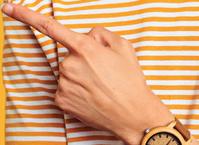
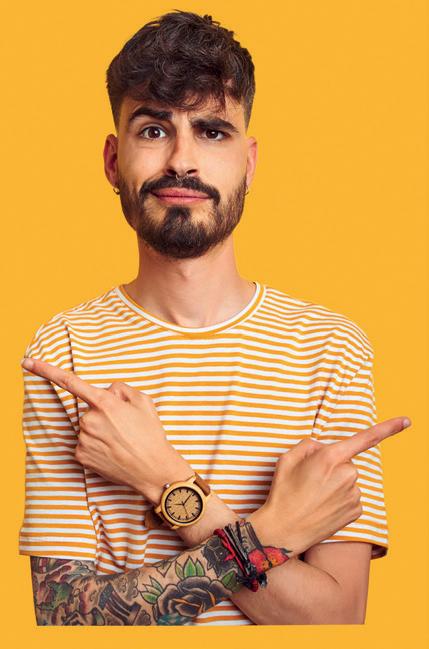


Language courses
Nederlands, français, English, Deutsch, português, italiano, español, русский, Ελληνικά,
Full range of courses and online enrolment for day, evening or Saturday classes on cvosemper.be
Do you live in Brussels and would you like to attend Dutch classes? Enrolment is free for elementary and intermediate levels.
Lessons @home and/or in class in:

Brussel • Elsene • Jette • Laken • Neder-Over-Heembeek • Oudergem • Ukkel

info@cvosemper.be 02 882 50 70
cvosemper.be


At Daiichi Sankyo, we believe in being ‘Stronger Together.’
Cancer remains one of Europe’s most pressing health challenges. According to the European Cancer Information System (ECIS), nearly one in four women and one in three men in Europe are expected to receive a cancer diagnosis before the age of 75. What’s more, cancer rates among adults are on the rise, according to the World Health Organisation. This represents a growing unmet need for new and improved treatment options. Organisations across Europe are stepping up to this challenge.
Daiichi Sankyo, a global pharmaceutical company with roots in Japan, is working to help address this challenge. Known for its agile approach and strong commitment to science-driven innovation, the company has made oncology its primary strategic focus. Though it is also active in other therapeutic areas, such as cardiology, oncology is its defining priority.
Powered by Japanese values, Daiichi Sankyo operates on the principles of long-term thinking, precision, and responsibility. This ethos influences how the company approaches science, patient engagement, and partnerships. The firm’s approach is guided by three core values: Innovation, integrity, and accountability. These principles shape both its internal decision-making and its collaboration with external partners.
Daiichi Sankyo is dedicated to bringing innovative therapies to as many patients as possible, and as quickly as possible. Its approach builds on more than 40 years of experience in oncology and a commitment to advancing scientific knowledge and care delivery. In the past three years alone, more than 33,000 people in Europe have been treated with Daiichi Sankyo’s oncology therapies. By 2030, the company aims to reach nearly 400,000 patients globally.
“Our values place patients at the forefront of decision-making to help shape the future of cancer care,” says Prof. Markus Kosch, Head of Oncology Business Division Europe and Canada at Daiichi Sankyo. “This means we actively involve patient communities throughout the development process. This includes involving patients in the design of clinical studies and shaping how outcomes are measured.”
In Europe, this includes working with over 40 patient advocacy organisations. Through dialogue with focus groups and advocacy organisations, the company listens directly to patient needs and tailors its research to deliver meaningful improvements in quality of life for patients across Europe.
Daiichi Sankyo organises patient advisory boards for study protocols, consultations on endpoints for quality-of-life studies, and co-develops preference studies in areas such as breast and lung cancer.
Since 2010, Daiichi Sankyo has maintained a significant focus on a class of cancer therapies known as Antibody Drug Conjugates (ADCs), a cancer therapy that delivers medicine directly to tumour cells. These treatments are designed to deliver cancer-targeting medicines directly to tumour cells by combining two key elements: an antibody that can find and bind to cancer cells, and a chemotherapy
medicine that is released once inside the cell. This aims to target cancer more precisely, potentially reducing the impact on healthy parts of the body.
Alongside other personalised or targeted therapies like CAR-T cell treatments or cell and gene therapies, this technology is believed to have the potential to transform cancer care.
The company is now improving how ADCs function, so they are more stable in the bloodstream and only release their treatment once they reach the cancer cell. Some of these ADCs are also designed to act on nearby tumour cells, not just the ones they directly target.
By 2030, Daiichi Sankyo aims to have five different ADC therapies approved for use in more than 30 types of cancer. To support this, it is running over 60 clinical trials across Europe and Canada in areas including breast, lung, ovarian, gastric and colorectal cancer.
“At Daiichi Sankyo, we believe in being ‘Stronger Together.’ In practice, this means working with a wide range of partners including healthcare providers, policymakers, and industry peers,” says Kosch.
Strategic alliances with companies such as AstraZeneca and MSD help expand the reach of development programmes and increase participation across the globe. At the same time, the company engages with policymakers to shape a regulatory environment which will favour innovation and support quality of care in healthcare systems.
Daiichi Sankyo works with EU decision makers to advocate for frameworks that support innovations and foster the conditions for more sustainable healthcare delivery. The company is active within the European Cancer Organisation and the European Policy Centre.
Europe has long been an important focus for Daiichi Sankyo. The company operates affiliates in 14 European countries and employs nearly 3,000 people across the continent. Its European headquarters are based in Munich, Germany. A major part of its long-term regional investment is a €1 billion expansion of its production and development site in Pfaffenhofen, Germany, which is set to create 350 new jobs by 2030. This site plays a key role in developing, producing, packaging and distributing oncology medicines for Europe and beyond. It contributes to the stability of the global oncology supply chain and allows the industry to adapt to increasing demand. The Pfaffenhofen site is expected to become an
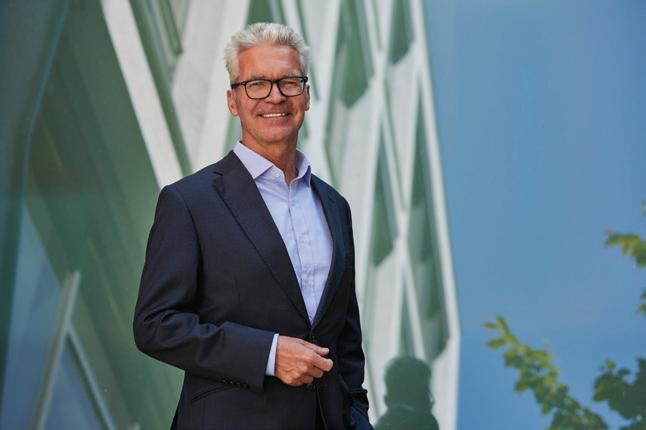
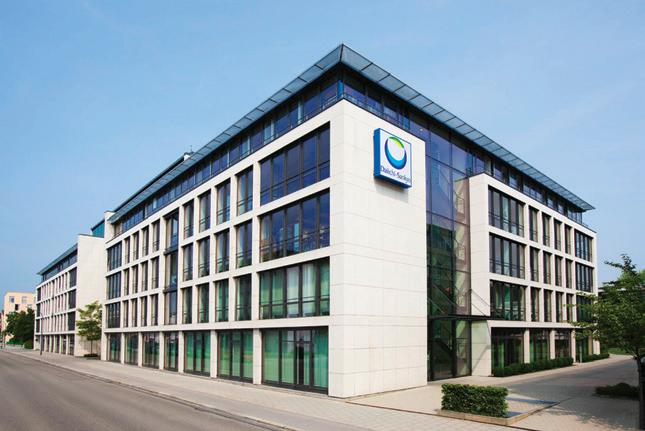
international innovation and distribution centre for cancer therapies, with a particular focus on ADCs.
Powered by 100% green electricity, the site is a leading example of sustainability in the oncology sector, receiving further sustainability upgrades such as the installation of a biomass-based steam generation system.
Daiichi Sankyo is committed to its mission of improving quality of life through innovative medicines.
“Our company’s perspective is summarised in its guiding motto: ‘Passion for Innovation. Compassion for Patients.’ It is a reflection of Daiichi Sankyo’s ongoing work to help shape the future of cancer care through collaboration, focus, and a strong commitment to patient centricity,” says Kosch.
Our company’s perspective is summarised in its guiding motto: ‘Passion for Innovation. Compassion for Patients.’
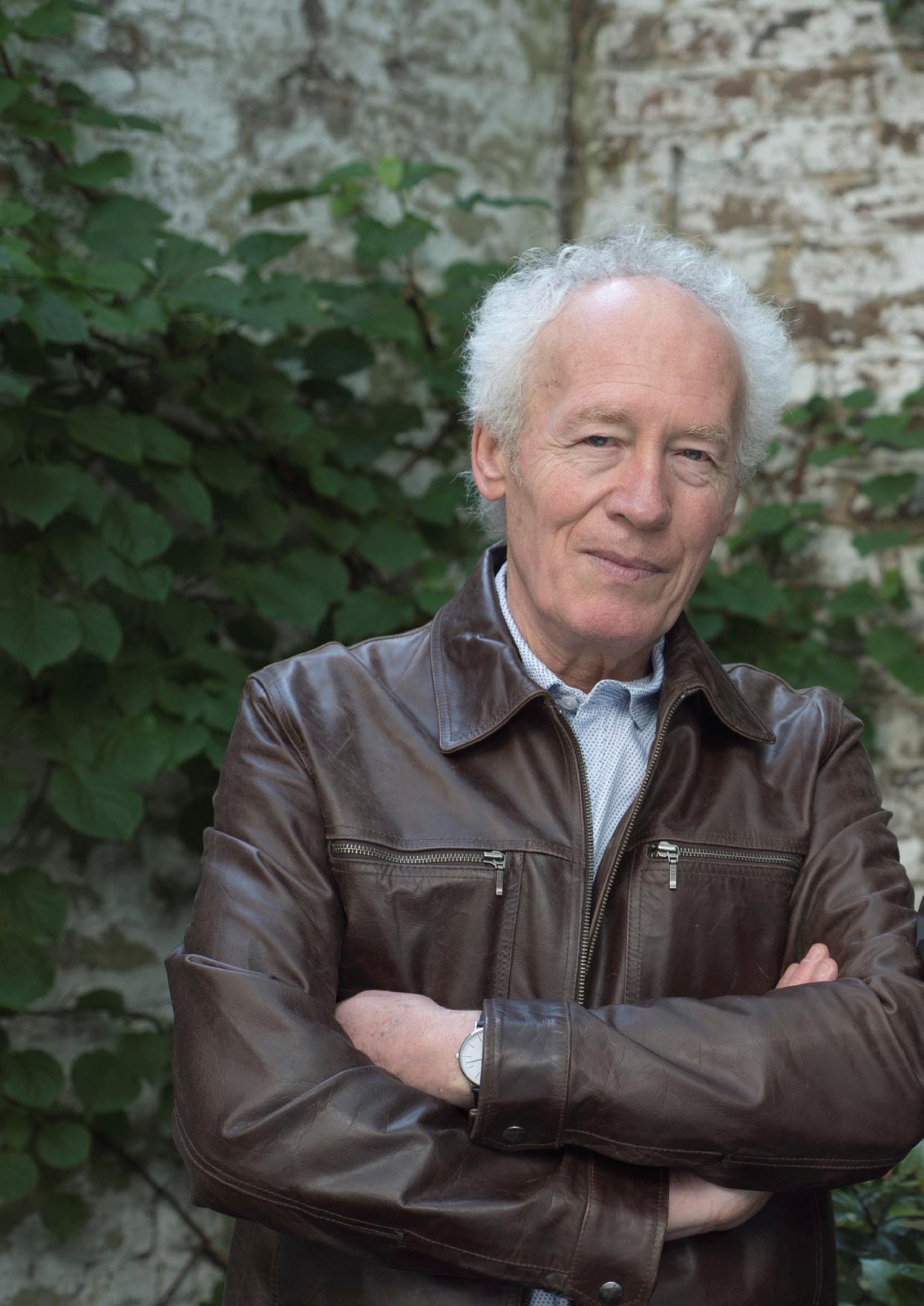
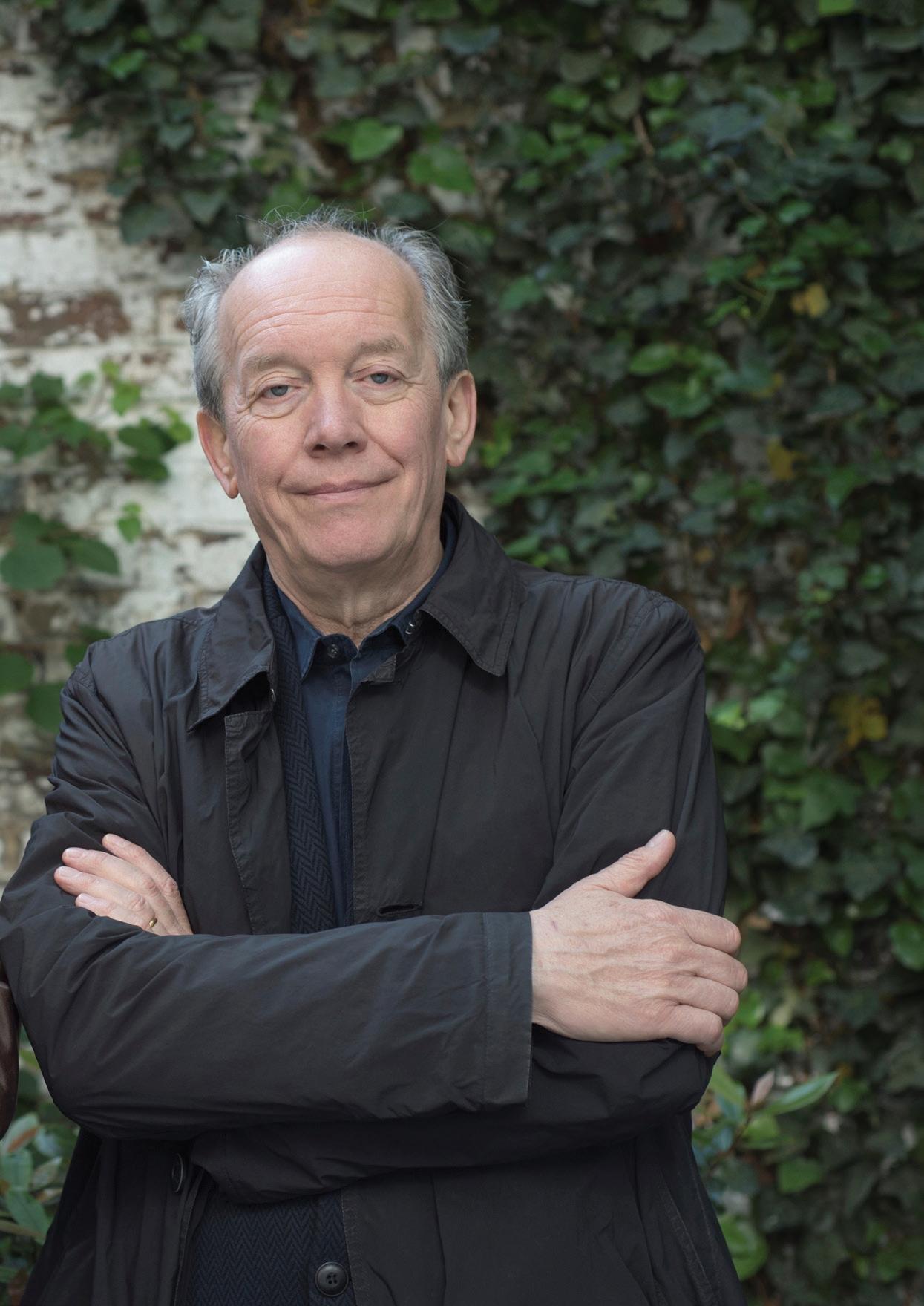
The Dardenne brothers have built a globally acclaimed filmography from the mean streets of Seraing, but their latest Cannes-winning work, Jeunes Mères, ventures just a few kilometres beyond. In a rare in-depth interview, Belgium’s masters of social realism tell Dennis Abbott about family roots, cinematic craft, and the quiet power of silence
Dennis Abbott
I remember one day my father took in a kid from a very poor family. He stayed with us for a few days and washed in the same bathtub. I was four or five years old, and he was seven or eight. That’s how it was.
Woody Allen is synonymous with New York, Federico Fellini loved Rome while Jean-Luc Godard is indelibly linked with Paris. For Jean-Pierre and Luc Dardenne, two-time winners of the Palme d’Or and recipients of yet another gong at the Cannes Film Festival in May, nowhere compares with Seraing, an industrial suburb on the outskirts of Liège.
Nearly all their films have been shot amid its gritty surroundings on the banks of the River Meuse.
However, for our meeting on the eve of the renowned festival on the Côte d'Azur, where their latest work, Jeunes Mères (The Young Mother’s Home), won the prize for Best Screenplay, the brothers have opted to save Seraing for celluloid.
Instead, they’ve invited The Brussels Times Magazine to an upscale hotel, just around the corner from our office. Decked out in Louis XV-style period furnishing and décor, it feels a long way, in every way, from their trademark, bleak but compelling depictions of life in left-behind communities, brilliantly captured on hand-held cameras.
Their uncompromising output has earned them epithets such as the ‘Brothers Grim’ and ‘Masters of Misery’ in the past, but in person, the Dardennes are warm and affable.
As I’m ushered into the small room chosen
for our tête-à-tête, the pair are sat upright, almost perfectly symmetrical at either end of a firm-backed reproduction sofa. Sporting smart, open-necked shirts and neatly pressed slacks, they smile in unison. For a moment, I feel like I’ve just stepped into a Wes Anderson set.
Jean-Pierre, the older of the pair at 74 (no, they’re not twins), stands up and proffers a friendly hand, inviting me to sit opposite. His brother Luc, 71, follows suit.
While the idea is to talk predominantly about Jeunes Mères – of which I’ve already had a sneak preview – the conversation opens up to cover their early days, influences and views on various topics. More about the new film in a moment, but let’s start at the start.
Both were born in the province of Liège, Jean-Pierre in Engis in April 1951 and his younger brother in Awirs in March 1954. They also have two sisters, Marie-Claire and Bernadette.
I ask if their parents, Lucien and Marie-Josée, influenced their career path and the themes of struggle and marginalisation that they frequently address.
“Yes, definitely,” says Luc. “Our family home was very open to everyone, especially poorer neighbours who would come to eat with us. Our father was a member of a Christian social movement, St Vincent de Paul, and he actively helped the poor in the village
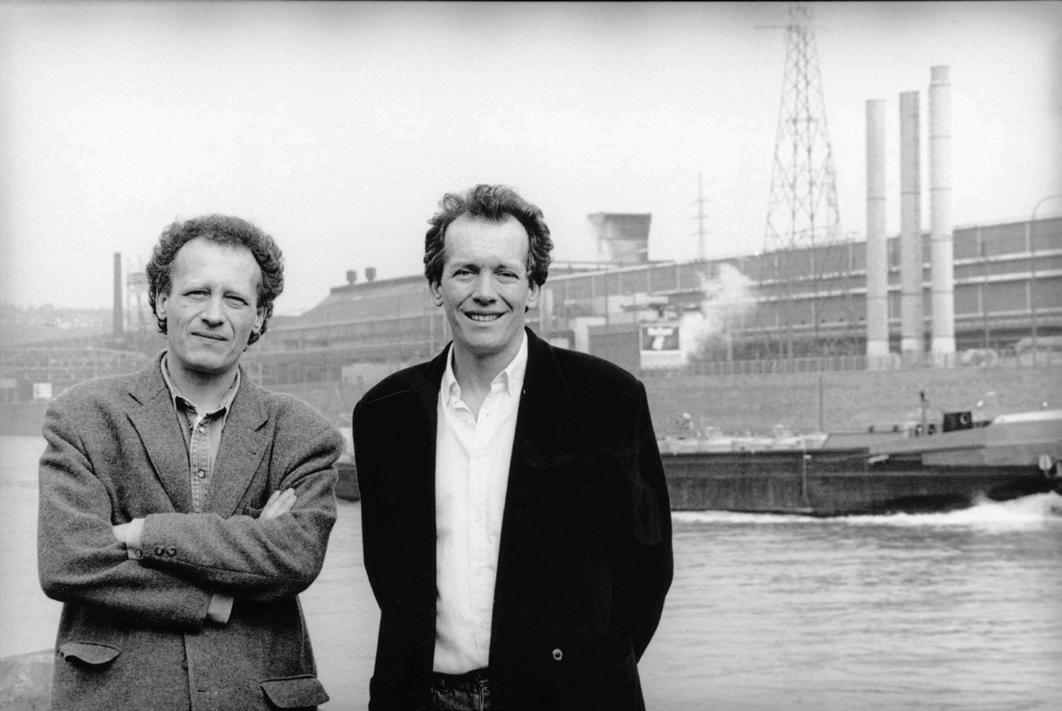
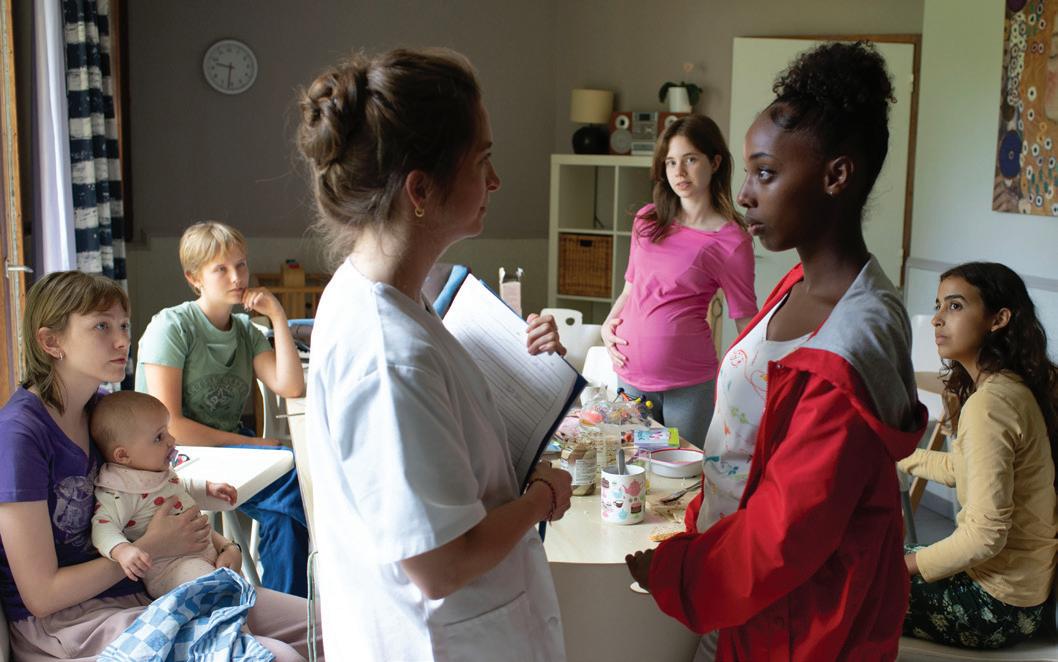
and the industrial suburbs. Our mother was also very, very open.
“It wasn’t a big house. But there was enough food and, if neighbours were hungry, our parents would say, ‘Come on, sit down and eat with us.’ I remember one day my father took in a kid from a very poor family. He stayed with us for a few days and washed in the same bathtub. I was four or five years old, and he was seven or eight. That’s how it was.”
If Lucien Dardenne, who died aged 98 in Engis last November, was responsible for imbuing his children with a sense of social responsibility, their artistic side certainly came from their mother Marie-Josée, who also lived into her nineties and passed away in 2017.
“When she was young, our mum played in the village theatre troupe and she loved to sing and dance,” says Jean-Pierre. “After she became a mother, she took care of us and the troupe no longer existed. She always regretted that. I remember when we were little, she’d sit the four of us down and disappear behind the door. She’d come back in a costume and sing and dance, then disappear again before returning in another disguise.”
After completing secondary school, JeanPierre enrolled at the Institut des Arts de Diffusion (Institute for Broadcasting Arts) in Brussels, where he studied drama under Armand Gatti, a much-travelled playwright, filmmaker and former wartime Resistance fighter.
Luc initially studied philosophy and so-
ciology but joined his brother as an assistant to Gatti, who encouraged them to make their first forays into film, shooting in working-class areas of Wallonia.
They made a series of politically engaged TV documentaries in the 1970s, founding their own production company, Dérives, in 1975. They released their first feature film, Falsch, in 1987. Based on a play about the last survivor of a Jewish family exterminated by the Nazis, it is rarely shown now. However, it marked a career turning point as the Dardennes shifted from fact-based documentaries to making fictional works, albeit always rooted in compassionate social realism.
They attracted significant financial backing for their second feature, Je Pense à Vous, but it failed to have the impact they hoped for. Undeterred, in 1994 they formed a new production company, Les Films du Fleuve.
They were finally discovered by international audiences two years later when their third film, La Promesse, was screened during La Quinzaine (Directors’ Fortnight), the platform for indie films at Cannes. Starring 15-year-old, Brussels-born, Jérémie Renier, who would become a regular collaborator, it attracted glowing reviews worldwide.
By this point, the brothers had established a modus operandi which has served them well ever since.
Jean-Pierre describes their routine: “When we start working, it’s always just the two of us. We develop a character or characters, then a structure with bullet points.

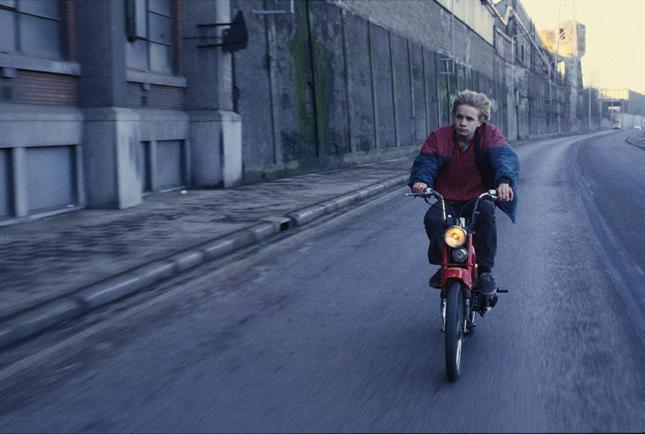
Rather fittingly for the Dardennes, there was no happy ending. “We never heard from him again,” sighs Jean-Pierre.
Jean-Pierre describes their routine: “When we start working, it’s always just the two of us. We develop a character or characters, then a structure with bullet points. Once we have a beginning, the different stages and an end, sometimes there are little scenes that we sketch out between us to create the beginnings of the dialogue. At that point, Luc writes the script.
“As he moves forward with it, he’ll call me regularly (Jean-Pierre still lives near Liège while Luc is based in Brussels) and send over what he’s done. We do everything else together.
“When we start working on the casting, rehearsals, location scouting and so on, we become one person in a certain way. There’s not really a strict division of tasks. We're not site managers,” he smiles.
But while two become one this does not mean they duck their individual responsibilities, says Luc. “When we face an obstacle, we never say to ourselves, ‘I don't care, my brother will take care of it’. Even when it’s the two of us, there are moments when we find ourselves alone.”
In 1999 the Dardennes won their first – and Belgium’s first – Palme d’Or, the top prize at Cannes, with Rosetta, featuring a tour-deforce performance by 17-year-old newcomer Émilie Dequenne, which earned her the Best Actress award.
Tragically, Dequenne died from a rare form of cancer in March this year, aged just 43. Jean-Pierre shakes his head. “She was young, so very young. The medicine was powerless to cure Émilie…”
“She was magnificent,” adds Luc. “A beautiful and good person. And such a good actress. It was always easy to work with her.”
Their nine films since Rosetta have all been screened in competition at Cannes, consistently winning accolades from the jury and plaudits from critics.
The follow-up, Le Fils (The Son), earned Olivier Gourmet the Best Actor award, while the directing duo won their second Palme d’Or with L’Enfant (The Child) in 2005, joining an illustrious group who have done the double including Francis Ford Coppola, Ken Loach, Michael Haneke and Ruben Östlund. No one has yet clinched the top prize three times.
The brothers are often compared with Loach due to the issues they explore. “We don’t do exactly the same thing, but it’s true that we look at the social and economic conditions of individuals who are fighting to escape from their situation,” says Luc.
The pair are avowed Loach fans and vice-versa. They have backed several of the British veteran films including Looking for Eric, starring Manchester United legend Eric Cantona, and The Angel's Share, as well as 2016 Palme d’Or winner, I, Daniel Blake, the story of a middle-aged man denied sickness benefit by a harsh bureaucracy. “We’re co-producers with Sixteen Films, the com-
pany Ken runs with [long-time collaborator]
Rebecca O’Brien,” says Jean-Pierre. “We’ve provided four or five Belgian technicians for his films.”
The commercial success of L’Enfant and its follow-up Le Silence de Lorna – each took more than €5 million at the box office – meant the Dardennes were increasingly able to look to attract higher-profile actors.
Cécile de France had just finished shooting on Clint Eastwood’s supernatural thriller Hereafter with Matt Damon when the brothers cast her as hairdresser Samantha in 2011’s Le Gamin au vélo (The Kid With A Bike). “When the Dardennes or Eastwood call you, you say yes right away,” the Namur-born actress said at the time.
Her co-star Damon was keen to sign up with the brothers, too.
“Cécile told us he wanted to act with us,” recalls Jean-Pierre. “We kept it quiet, but we wrote a script in which he’s an American police officer who comes over to train the Belgian police. There’s a serious incident and he stays to lead the investigation.”
Rather fittingly for the Dardennes, there was no happy ending. “We never heard from him again,” sighs Jean-Pierre.
The brothers instead set their sights on enlisting La Vie En Rose Oscar winner Marion Cotillard in their next movie, 2014’s Deux Jours, Une Nuit (Two Days, One Night).
The French star was, in her own words, “overwhelmed with joy” when the brothers cast her as a working-class mum. And as a long-term fan of the Dardennes, she was thrilled when she learnt that the filming would take place in their customary base. “I wanted to go to Seraing, and I went to Seraing,” she declared.
The Dardennes returned to Cannes in 2016 with La Fille inconnue (The Unknown Girl), a whodunnit with French actress Adèle Haenel in the central role, then again three years later with
Le Jeune Ahmed (The Young Ahmed), which starred debutant Idir Ben Addi as a radicalized teenager and won the Scenography Prize.
Their 2022 film Tori et Lokita, a hard-hitting story of a migrant who finds herself trapped when the state denies her the papers she needs to live and work freely in Belgium, earned yet another award at Cannes. As usual, it was shot around Seraing and Liège.
I ask if the location to which they are so regularly drawn is an artistic choice or down to more prosaic reasons such as a desire to keep within budgets.
“It’s because it’s the area where we spent our childhood and adolescence, where we broke our first taboos,” says Jean-Pierre. “Back then it was a very industrial region with a lot of wealth and a lot of people, and suddenly all that just disappeared. We’d left to study and when we came back, we said to ourselves, ‘Shit, what happened?’ It’s as if these places were saying, ‘Hey, guys, why don't you tell stories in our country, in the area where you spent your teenage years?’
Their 2022 film Tori et Lokita, a hardhitting story of a migrant who finds herself trapped when the state denies her the papers she needs to live and work freely in Belgium, earned yet another award at Cannes.
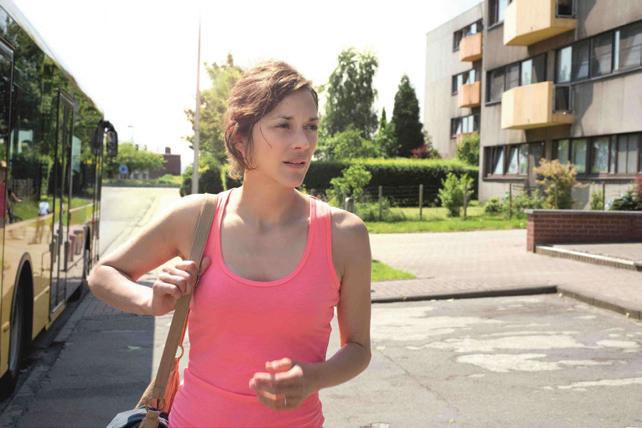
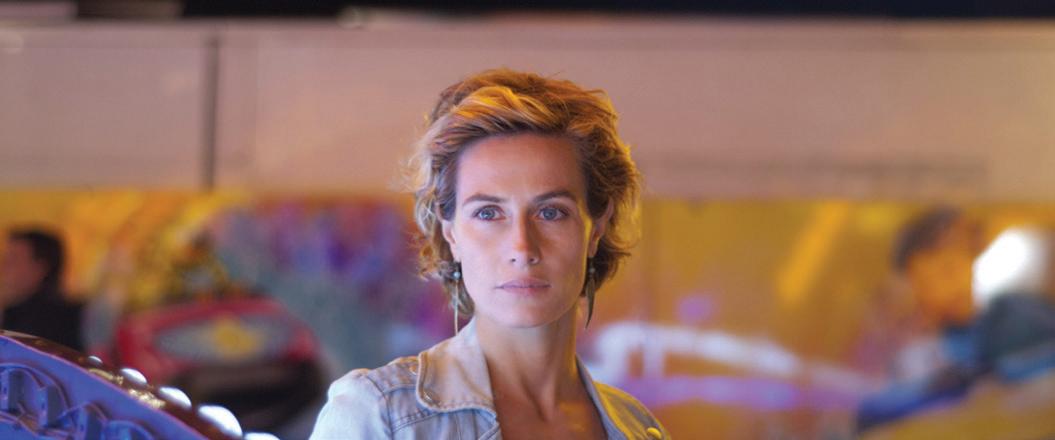
In our region, everyone travels by bus. They’re everywhere, all the time. The buses are our equivalent of New York taxis.
“We don’t only film in places which had a rich past and became impoverished. But, as the region of our childhood and adolescence, that’s a strong link.”
They started making Jeunes Mères in April last year. For once, the film is not set in Seraing, but all of 11km away in Alleur, where the Dardennes were inspired by the work of a real-life maternity shelter which provides support for underage mothers.
It’s clear that, while continuing their signature stripped-down style, they were keen to try elements of a new, more spontaneous approach. Jean-Pierre points out that there is “more opti-
The Dardenne films in a snapshot
Falsch (1987)
The brothers’ first film, featuring Bruno Cremer, Jacqueline Bollen and Millie Dardenne (Luc’s daughter), is the story of a Jewish family murdered by the Nazis. Adapted from a play by René Kalisky, the script was co-written with Jean Gruault, best known for his work with François Truffaut. Ostend Airport was among the filming locations. The film won the Prix SACD from the Société des Auteurs et Compositeurs in Belgium.
Je pense à vous (1992)
The expensively-produced film flopped with audiences but introduced themes that would become hallmarks of the Dardenne brothers’ future work. Fabrice (Robin Renucci) loses his job at a steelworks on the banks of the Meuse. In despair, he abandons his wife Céline (Fabienne Babe) and vanishes. She searches for him and finds Fabrice with another woman. Céline leaves without saying a word and Fabrice is left to ponder if he can live without his family. The film won the Prix du Public at the Namur Film Festival.
La Promesse (1996)
The film that first brought the brothers to international attention. Roger (Olivier Gourmet) exploits illegal immigrants on a building site in Seraing. When one of the workers is fatally injured in a fall, Roger’s son Igor (Jérémie Renier) must decide if he will keep a promise to the dying man. The tower blocks in Droixhe and the N 90 road by Ougrée quay are recognisable local landmarks. Launched at the Cannes Directors’ Fortnight, La Promesse won numerous awards including Best Film and Best Actor (Gourmet) at the Namur Film Festival and the Los Angeles Film Critics Association Award for Best Foreign Film. The score was composed by Jean-Pierre and Luc’s brother-in-law Jean-Marie Billy, who also worked on Falsch.

Rosetta (1999)
Rosetta (Émilie Dequenne) lives in a caravan park with her promiscuous, alcoholic mother (Anne Yernaux) and is desperate for a better life. Unfairly sacked from her bakery job, she is befriended by Riquet (Fabrizio Rongione) who shows her how
mism” in the story which follows five teenage mums and how they attempt to free themselves from “a destiny imposed on them.”
They started their process by spending time in the maternity home where they would eventually shoot, talking with the young single mothers, most of them minors, as well as with the educators and psychologist. They say they were immediately drawn to the communal life: the meals, the baths given to the babies, the discussions about topics related to motherhood, violence and addiction. And while they saw moments of shared life, there was also loneliness, anxiety and inevitable questions about absent fathers.
The brothers received more than 300 CVs before looking at around 150 candidates for the five main roles. I ask how they pinned down their
he is scamming his boss on the waffle stand where he works. Rosetta betrays Riquet and takes his job. Feeling guilty, she quits and switches on the gas at her mother’s caravan, hoping it will kill them both. The film locations include Nandrin and Jemeppe-surMeuse. A tough coming-of-age drama, Rosetta was a box-office hit and earned the Dardennes Belgium’s first Palme d’Or and the Best Actress award for Émilie Dequenne in her debut.
Le Fils (2002)
Olivier Gourmet received the Best Actor award at Cannes for his portrayal of Olivier, a tormented carpenter who takes on an apprentice who has murdered his son. Unsuspecting Francis (Morgan Marinne), just out of jail, doesn’t realise the connection. Olivier stalks him, slowly discovering more about the teenager. Francis looks up to his boss, seeing him as a role model, while Olivier finds himself torn between hatred for his son’s killer and the knowledge that his charge has had a terrible start in life.
L'Enfant (2005)
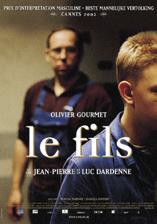
The Dardennes won their second Palme d’Or with this unforgettable social drama. Bruno (Jérémie Renier) and Sonia (Déborah François) are a teenage couple scraping by, living on welfare and the proceeds of petty crime. Bruno sells their newborn baby – but, faced with Sonia’s shock, has second thoughts about what he’s done. L’Enfant was largely shot on the right bank of the Meuse in Seraing. It also won the Best Film, Best Director, Best Screenplay, Best Actor and Best Actress awards at the Gent Film Festival.
Le Silence de Lorna (2008)
Lorna (Arta Dobroshi) is a desperate Albanian immigrant who marries junkie Claudy (Jérémie Renier) to obtain Belgian citizenship, only to find herself warming to him. But the plot of this tense thriller soon takes things in an unexpected and dark direction. Liège’s spectacular rail station is among the locations. The film won Best Screenplay at Cannes and the European Parliament’s Lux Prize.
final choices.
“There are two things we’re looking for,” says Jean-Pierre. “Good actresses …and silence.”
If that sounds like a puzzling contradiction, he explains. “First, we have to think they’re going to be good at depicting the characters,” he says. “We do a little exercise. In this case, we did the first scene of the film in a simplified way. We play a woman getting off the bus, who Jessica [one of the young mums] comes to question. Second, we look for their ability to hold a silence. If there’s a moment before she speaks and before we turn around, we say to ourselves, ‘There’s someone who resists us, who knows how to create silences. She’s a possible.’ You then tell them, ‘Leave a little more silence,’ and we redo the scene and they leave a little more.
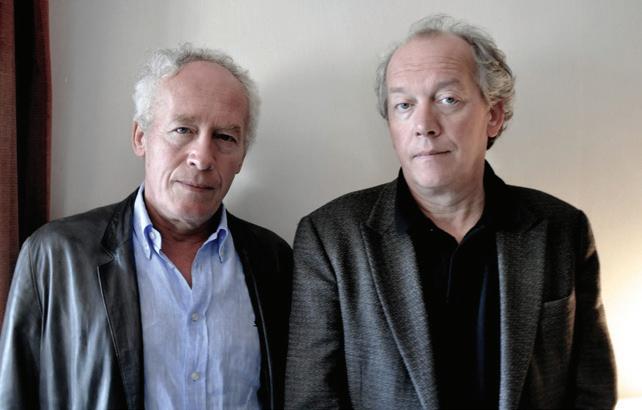
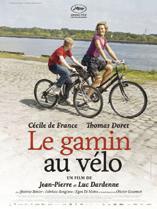
Le Gamin au Vélo (The Kid With A Bike) (2011)
With echoes of François Truffaut’s Les 400 Coups, the film centres on Cyril (Thomas Doret) who is abandoned in a children’s home by his feckless father Guy (Jérémie Renier). When Cyril runs away to search for his dad, hairdresser Samantha (Cécile de France) takes the boy under her wing. She tracks down Cyril’s cherished bike – and Guy too – but the father does not want to know. Cyril rejects Samantha and turns to gang leader Wes (Egon Di Mateo) who makes him beat up a newsstand owner and his son, who seeks vengeance. The film, inevitably shot in Seraing, won the Grand Prix at Cannes and was nominated for a Golden Globe for Best Foreign Language Film.
Deux Jours, Une Nuit (Two Days, One Night) (2014)
Sandra (Marion Cotillard), a working-class mum of two, is returning to her job at a solar panel plant after a bout of depression. The manager asks her low-paid colleagues to choose between keeping her on or receiving a bonus to cover her shifts. Only two vote for her to stay. Husband Manu (Fabrizio Rongione) and friend Juliette (Catherine Salée), who persuades the boss to hold a second ballot, urge Sandra to meet each colleague at the weekend to convince them to change their minds. The filming locations include the Meuse quays and area around Bois de l'Abbaye hospital in Seraing. The film was showered with awards and earned Cotillard an Oscar nomination for Best Actress.
La Fille Inconnue (The Unknown Girl) (2016)
Jenny (Adèle Haenel), a young doctor in Liège, leaves the door unanswered at her clinic when a woman presses the buzzer after work hours. When she discovers that the immigrant woman she ignored is found dead, the doctor feels responsible and is determined to discover the truth about what happened. Screened in the official selection at Cannes, the film received a mixed reception from critics and the public.
Le Jeune Ahmed (2019)
Ahmed (Idir Ben Addi) is a radicalised Belgian teenager. Fired up by imam Youssouf (Othmane Moumen), he calls his mother a
drunk, his sister a slut and refuses to shake hands with his female teacher (Myriem Akheddiou). Ahmed wants to join the jihad but is sent to work on a farm, where he faces the corrupting presence of Louise (Victoria Bluck). Written in the wake of the Brussels attacks of March 2016, the film sensitively addresses radicalisation and Ben Addi delivers a memorable performance.
Tori et Lokita (2022)
Two young refugees find life isn’t what they hoped for in Belgium. While Tori (Pablo Schils), the younger of the pair, is granted the right to stay, Lokita (Mbundu Joely) is not. The smugglers who brought them to Belgium threaten Lokita and the pair end up selling drugs for Betim (Alban Ukaj), an unscrupulous dealer running a pizza takeaway. When they are separated, Tori discovers Betim has locked up his ‘sister’ in a cannabis farm. They escape, only for Lokita to run into Betim’s sidekick Luckas (Tijmen Govaerts) with fatal consequences. The two leads are superb and the Dardennes won a 75th anniversary award at Cannes for this brutal yet tender drama.
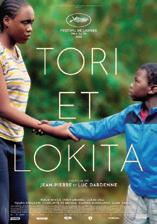
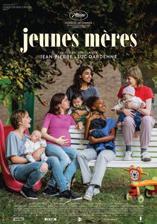
The film focuses on four young mothers and one who is expecting – Jessica (Babette Verbeek), Perla (Lucie Laruelle), Julie (Elsa Houben), Ariane (Janaina Halloy Fokan) and Naïma (Samia Hilmi). Perla’s sister Angèle is portrayed by Joely Mbundu, who appeared in Tori et Lokita. Against the odds, the teenage mums hope for better lives for their children. The Dardennes deliver again with this engrossing tale. As well as receiving the award for Best Screenplay (Prix du scénario) at Cannes, 17 years after they earned the same distinction for Le Silence de Lorna, the film also picked up Le Prix Ecoprod for the most eco-friendly feature. The specialist jury highlighted the Dardennes’ use of natural lighting, low carbon footprint due to its limited locations and re-use of accessories from the filming.

A tough coming-of-age drama, Rosetta was a box-office hit and earned the Dardennes Belgium’s first Palme d’Or and the Best Actress award for Émilie Dequenne in her debut.
That’s what we’re after.”
The Dardennes are known for putting their often young and inexperienced casts through demanding rehearsals before the cameras roll. “Their standards are total, unrivalled and unequalled,” said Marion Cotillard after making Deux Jours, Une Nuit.
Unlike most of their films, Jeunes Mères does not focus on one or two characters. Originally the plan was to do that but after visiting the maternity home, the brothers felt they should broaden the storyline.
“We sensed sadness and tragedy there, but there was also life, tenderness and sweetness,” says Luc. “On the way back in the car, we said to ourselves, ‘Maybe we could do something with the setting and the group’. We started with two or three stories, then we thought we could tell another one – and ended up with five.
“Six might have been too many,” he concedes. “There really isn't an objective reason for going with five, it’s really down to intuition.”
That intuition never seems to fail them.
I’m curious, however, why noisy buses and roads feature so often in their films. Is this a metaphor for the bumpy journeys their characters are on?
Jean-Pierre chuckles before replying. “A few years ago, we were in Seoul in South Korea to present a film in a theatre packed with young people. After a discussion with the audience, one of them raises his hand and, like you, observes that there are a lot of buses in our films. He asks, ‘Is that product placement, do you get paid for filming buses?’
“Of course, the answer is no. It’s simply because, in our region, everyone travels by bus.
They’re everywhere, all the time. The buses are our equivalent of New York taxis. We actually have a new tram service in Liège so maybe we’ll put them on the tram in future, too!”
Before calling it a wrap, I finish by asking the brothers about their competition in Belgium and whose work they most admire.
Both immediately highlight Lukas Dhont, the Gent-born 33-year-old director of Girl and Close, which starred Émilie Dequenne and shared the Grand Prix, the runners-up award at Cannes, with Claire Denis’s Stars At Noon in 2022.
The appreciation is mutual: Jeunes Mères is co-produced by The Reunion, the film company owned by Lukas and his brother Michael. It also received support from the Flanders Audiovisual Fund (Vlaams Audiovisueel Fonds, or VAF for short), among others.
As for Belgian actors, the brothers reel off the names of three of their regular collaborators: Jérémy Régnier, Fabrice Rongione and Olivier Gourmet. Jean-Pierre also highlights Jef Jacobs, a Flemish newcomer who plays Dylan, the father of Julie’s baby in Jeunes Mères, before citing another director, the much talked about Laura Wandel, whose 2021 film Un Monde (known as Playground in English) scooped seven Belgian Magritte awards.
Luc gave Laura feedback on the script for her latest film, L'intérêt d'Adam (Adam’s Sake), which was screened in the Semaine de la Critique (Critics’ Week) at Cannes. Inspired by a story a paediatrician told her during her research at Saint-Pierre Hospital in Brussels, it is about a nurse trying to keep a single mother from losing custody of her child.
If the topic sounds familiar, it’s no wonder
entertainment trade title Variety has named her as the “heir to the Dardennes”.
But she may have to wait a while yet before taking their crown.
With longevity in their genes and no thoughts of retirement, don’t bet against the brothers returning to Cannes for a twelfth visit with their next film. Based on their usual three-year schedule, that would be in 2028.
Could they do something completely differ-
ent next time?
Perhaps a comedy called Crazy Mères set in Seraing?
“We're tempted,” laughs Luc. “For now, we’re resisting that temptation, but we’d seriously like to make a comedy one day.
“We felt a little lighter making Jeunes mères and thanks to the babies, we’ve left room for a lot more surprises to come.”
You heard it here first.
Belgium’s Cannes-do attitude is always on show at the famous festival’s bustling film market.
The Marché du Film, as it’s known, is the world’s largest gathering of movie pros, bringing together more than 15,000 participants from 140 countries.
Eye-catching billboards featuring Belgium’s hottest new films are plastered over the exterior of the Marché building and the Belgian stand inside.
They include Jeunes mères, La Danse des Renards (The Dance of the Foxes), the debut by Valéry Carnoy about a young boxer that won the ‘Coup de cœur’ in La Quinzaine, as well as L'Intérêt d'Adam by Laura Wandel, Kika by Alexe Poukine, Marcel et Monsieur Pagnol by Sylvain Chomet, and Loynes, a short-form Kafkaesque courtroom drama by Dorian Jespers.
Belgium’s booth-cum-café is a hive of activity, with lots of purposeful-looking conversations going on when I pop by.
The stand is run jointly by wbimages, which promotes audiovisual content (that’s films and TV series) made in Wallonia and Brussels, and its Flemish counterpart, Flanders image.
Julien Beauvois, project manager for wbimages, is manning the reception desk. In between welcoming a stream of visitors, he outlines what’s happening around us.
“We’re a meeting place for sales agents, distributors and Belgian producers who are here to talk to producers from elsewhere, aiming to seal international co-productions,” he says.
“In the case of films already at the post-production stage, we’re also targeting festival programmers to ensure they know what’s coming and to get our films shown.”
Jesper Nijsmans, head of promotion for Flanders Image, continues: “Cannes is the new year for the cinema industry. We’re focused
We don’t come here to see movies or be on the red carpet. We’re on the dark side.

on relationship building. We don’t come here to see movies or be on the red carpet. We’re on the dark side,” he jokes.
Judging from the buzz around the booth, the year ahead will be big. “There’s a very good vibe. It certainly helps that several Belgian films are in the official selections,” adds Jesper.
Screen Flanders, which provides financial support of up to €400,000 for films made in the region, announced at the festival that it is investing €2 million in seven new productions. They include two feature films, Le Faux Soir by Belgian director Michaël R. Roskam, whose 2011 debut Bullhead was nominated for an Oscar, and Mary Rose by Irish filmmaker Colm Bairéad, as well as Ploey 2 – The Legend of the Winds, a full-length animation by Sweden’s Gunnar Karlsson.
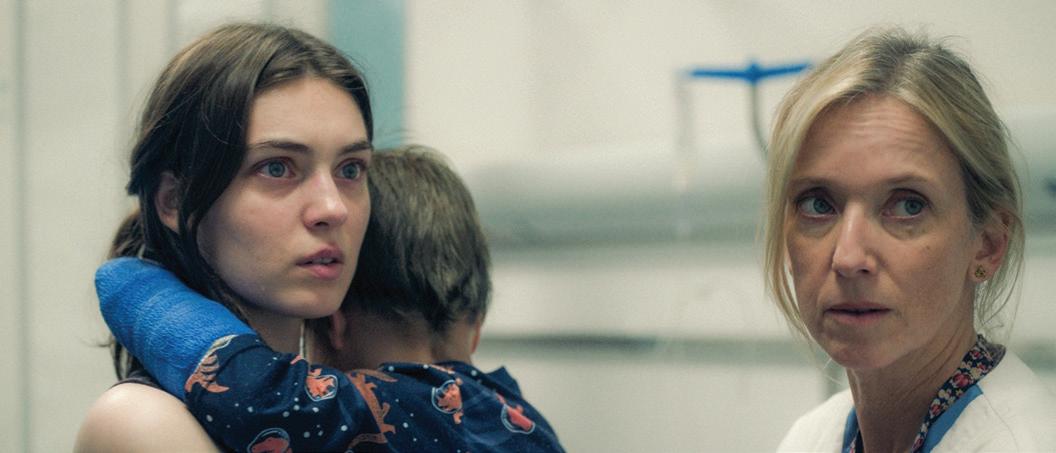

At ISF, our focus on well-being is integrated into every aspect of school life, creating a nurturing environment where our whole school community can flourish.
ISF is a small international school with two campuses: ISF Tervuren and ISF Waterloo. It is a warm, friendly and nurturing school which lives up to its motto "Rich in Diversity, United by Values" with over 50 nationalities where everyone is made to feel valued and welcomed.
ISF is accredited by the Council of International Schools (CIS), the Council of British International Schools (COBIS) and British Schools Overseas (BSO), well-regarded educational communities committed to high standards and ensuring high-quality international education.
At ISF, we are deeply committed to the well-being of our entire school community, including students, staff and parents, fostering a supportive and engaging environment for everyone involved. Both ISF Tervuren and ISF Waterloo adopt a holistic approach to education, focusing not only on academic excellence but also on the emotional and social well-being of our students. This comprehensive focus on well-being extends to every member of our school community, fostering a nurturing and positive environment where everyone can thrive.
Our curriculum is inclusive, catering to the diverse needs of all students. We offer specialised support for students with learning difficulties and for those whose first language is not English. This ensures that every student receives the individual attention they need to succeed, fostering a sense of belonging and
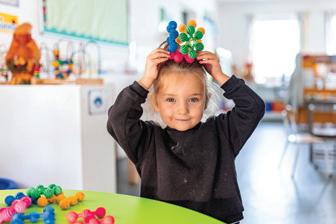

self-confidence. We prioritise the well-being of our students, creating an environment where they can thrive academically, socially, and emotionally. Our comprehensive approach to student well-being includes a variety of programs and services designed to support and enhance their overall school experience.
Our Personal, Social, Health, and Economic (PSHE) program is a cornerstone of our well-being initiative. Conducted weekly, these interactive lessons cover a broad range of topics, such as healthy eating, relationships, safety, mindfulness, and environmental respect. This program is essential in helping students develop important life skills, as well as essential attitudes and values to support them in their personal growth. Our full-time social counsellor plays a vital role in supporting students' emotional and social needs. He provides one-on-one counselling, teaches a range of our PSHE lessons, and assists with transitions and career guidance for secondary students.
A specialised well-being app builds our student's emotional intelligence, allowing them to reflect weekly on all aspects of their well-being and encourages them to give gratitude to others. This personalised support ensures that each student receives the care and guidance they need to succeed both inside and outside the classroom.
As part of our Critical Curriculum, we emphasise real-world learning experiences and global citizenship, preparing students to navi-
gate and contribute to an interconnected world. Projects, field trips, and community involvement initiatives help students understand their role in the global community and develop a sense of purpose and responsibility.
We firmly believe in the importance of student voice, which is why we have an active Student Council on both Campuses. Elected representatives from each school section meet regularly to discuss ideas and plan activities that enhance the school community. This encourages students to take ownership of their school environment and nurtures a sense of responsibility and leadership.
We also offer a wide range of extracurricular activities, from sports and arts to clubs and community service. These activities provide students with opportunities to explore their interests, develop new skills, and build meaningful connections with their peers. Participation in extracurricular activities enhances students' social and emotional well-being, fostering a sense of community and belonging
Our curriculum includes mindfulness practices and mental health education, helping students manage stress and develop emotional regulation skills. By integrating healthy practices into daily routines, we create a calm and focused learning environment where students can thrive academically and emotionally.
At the heart of our curriculum is a supportive school culture that prioritises student well-being. Our teachers, staff and parents are dedicated to creating a nurturing environment where every student feels valued and supported.
The well-being of our staff is paramount. We offer various professional development opportunities and create a supportive work environment. Regular staff meetings and inset days are designed not only for professional growth but also to foster a sense of camaraderie and teamwork among our educators and administrative staff. We ensure that our staff members have access to the resources and support they need to maintain a healthy work-life balance including regular well-being workshops.
We also recognise the crucial role parents play in their children's educational journey. Our open-door policy encourages parents to be actively involved in school life. We maintain excellent communication with parents
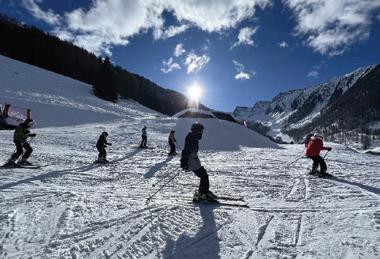
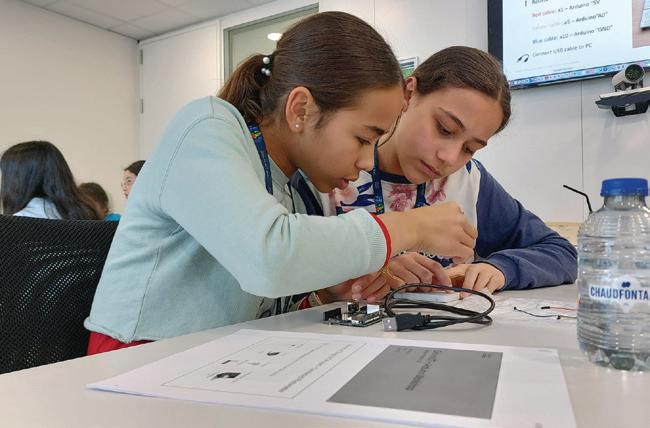
through regular updates, meetings, and school events. Our parent's group, the Friends of ISF, helps build a strong sense of community among families.
Social events, such as picnics, cultural celebrations, and family fun days, bring together parents, students, and staff, fostering a welcoming and inclusive atmosphere. This sense of belonging is crucial for the well-being and happiness of both students and their families. This partnership is essential in creating a cohesive support system for students, ensuring their academic and personal success
It also provides a platform for parents to contribute their skills and expertise, whether in organising events, supporting classroom activities, or serving on committees. This engagement fosters a stronger connection to the school and a deeper understanding of the educational process. We also offer our parents the opportunity to attend Mindfulness and Well-being workshops that are designed to support, educate, and practically implement the tools of holistic wellness in everyday life.
At ISF, our focus on well-being is integrated into every aspect of school life, creating a nurturing environment where our whole school community can flourish.
To book a tour, please contact our Tervuren Campus at office@isftervuren.org or our Waterloo Campus at office@isfwaterloo.org
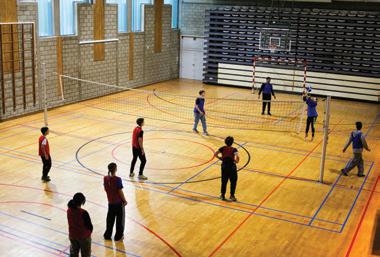
At ISF, we are deeply committed to the well-being of our entire school community, including students, staff and parents, fostering a supportive and engaging environment for everyone involved.
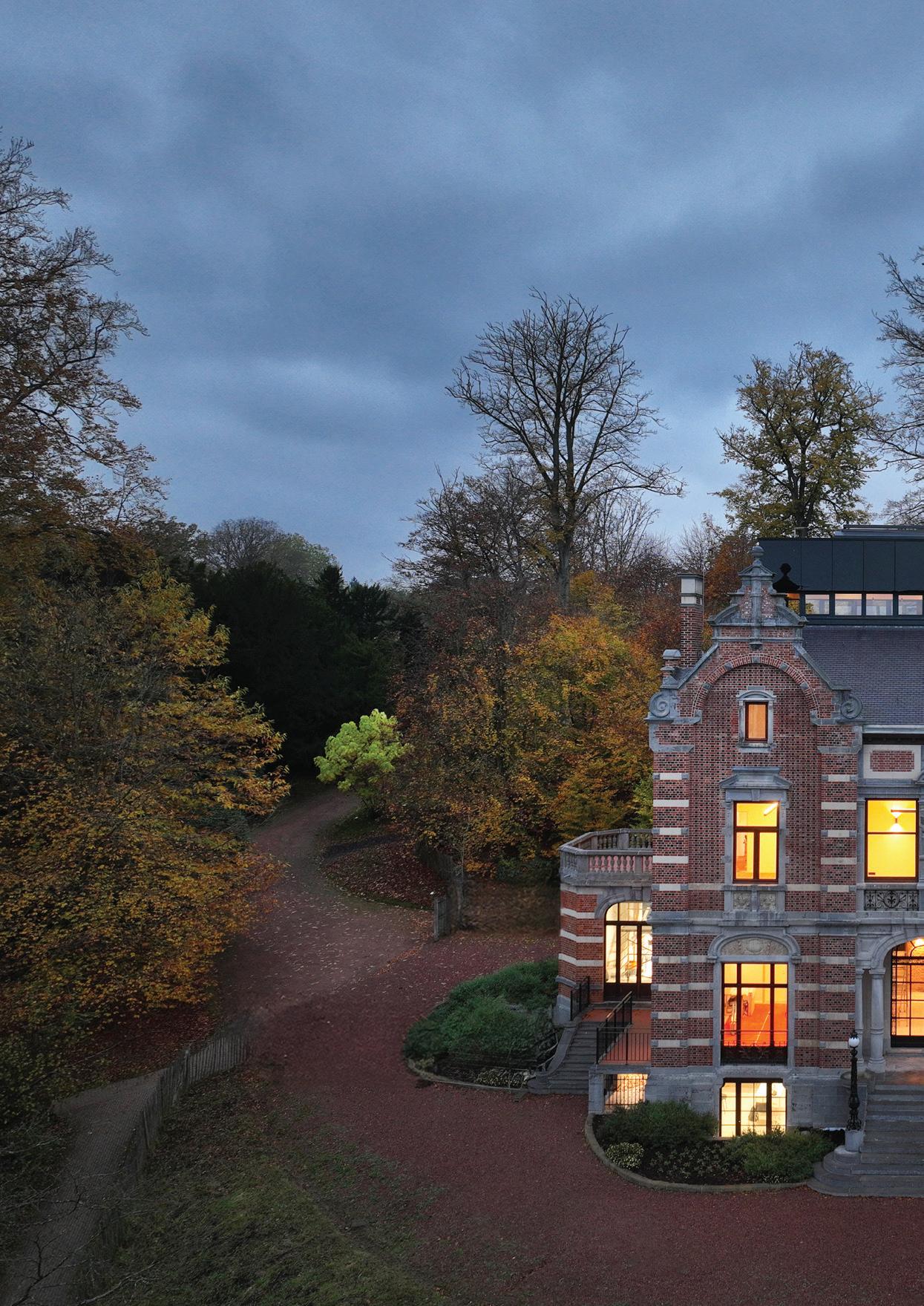
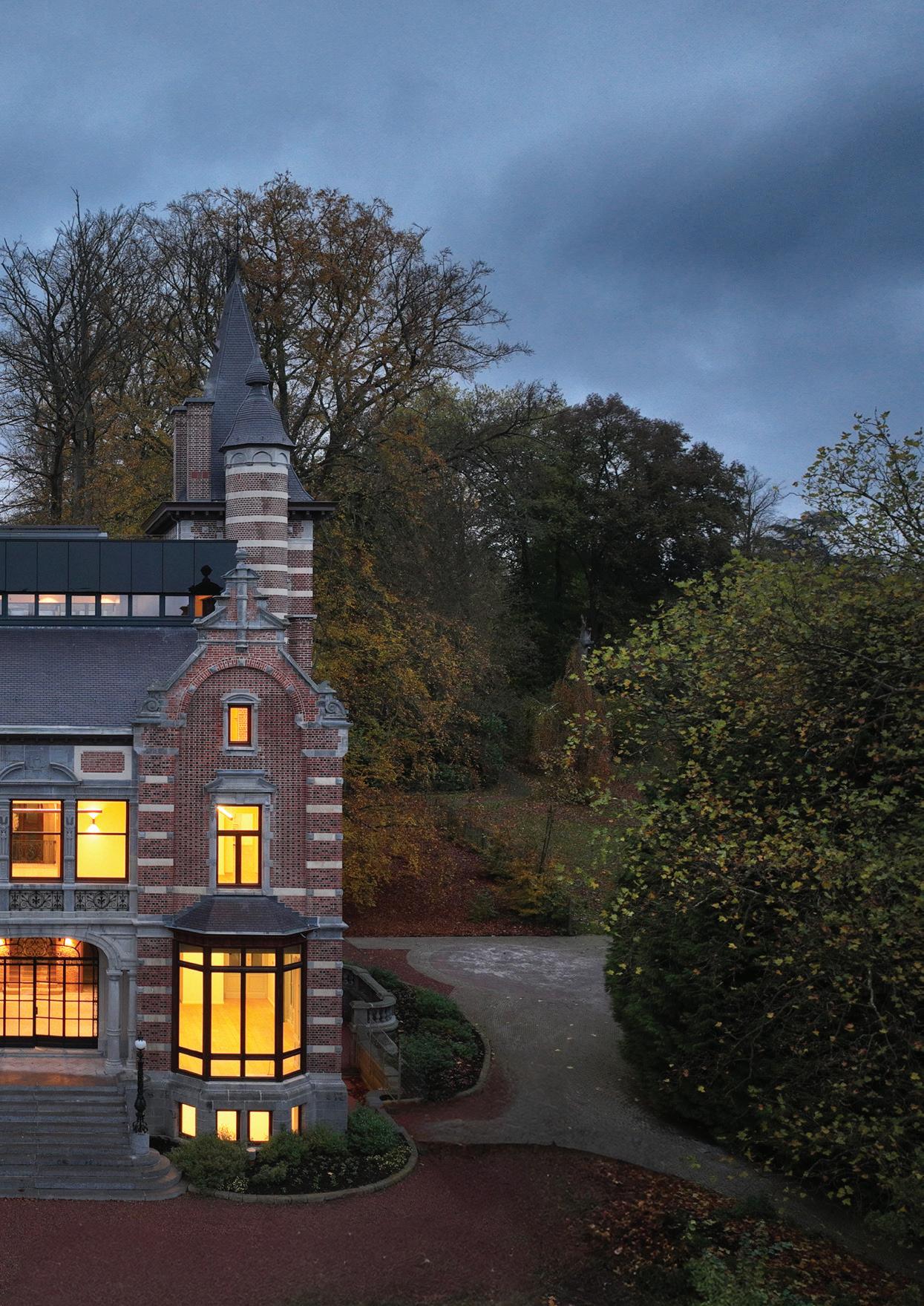
Once a charred husk haunted by bats and rumours, the Château Tournay-Solvay has been spectacularly reborn as a cutting-edge physics research centre. In this tale of ghosts, grandeur and green ingenuity, the architect behind the transformation, Francis Metzger, tells David Labi how heritage can be recycled—breathing 21st century life into an ancient heart
It’s about bringing back the essence of the building and reinterpreting it for the present, creating a link between what it was and what it is becoming.
The castle had burned twice, and all that remained were ruins,” recalls Francis Metzger, a self-proclaimed “greedy architect” responsible for a smorgasbord of spectacular projects in Brussels. And indeed, the shell of the Château Tournay-Solvay – in Brussels’ otherwise paradisiacal Tournay-Solvay Park – used to cut quite a creepy figure. Some said it was haunted. Others pointed out an uncanny resemblance to the Bates’ house in the movie Psycho.
But last year all phantoms were banished, as the château was inaugurated in a resplendent new guise – as an international physics research centre. This transformation was realised by Metzger’s practice, ma2 (Metzger et Associés Architecture). In their sleek SaintGilles offices on Rue de la Glacière, the architect explains how he transformed the château.
Three studies are required when approaching such a project, Metzger says. First is the “historical study.” What was the building’s past – its original purpose – and how has that evolved over time? “Even the château itself was a ruin that we had to reinvent,” he reflects.
Second comes the “archaeology of the built environment.” This is about investigating “the soul of the walls, allowing them to testify to their original identity.”
And finally, a “pathological study”: “Just as a doctor would scan your body, we do the same with a building,” says Metzger. “We make a diagnosis, determine what’s wrong, and propose a solution.”
When it comes to history, the team went deep. The surrounding estate was bought in 1878 by Alfred Solvay, a leading chemist who developed a patented process for producing soda ash. The grounds were lovingly redesigned with a rose garden, lake, walking paths – all the trimmings. But the centrepiece was the castle –


designed in the Flemish neo-Renaissance style, with an eclectic, whimsical flair. Plans were published in a magazine of the time describing a spacious country house, with a grand staircase, vestibule, and rooms including a dining room, salon and smoking room. It even incorporated early central heating.
Since then, the château has had its ups and downs. In 1905 a tower and turret were added, dividing opinion. When the last owner Thérèse Tournay, Alfred’s daughter, passed away in 1972, the estate passed to her heirs, eventually leading to its sale. Abandoned, it faced development proposals – including as offices for the Union Chimique Belge – all rejected by the local community. The Belgian government bought up the estate in 1981, and the grounds were opened to the public. Parc Tournay-Solvay was later given special eco-
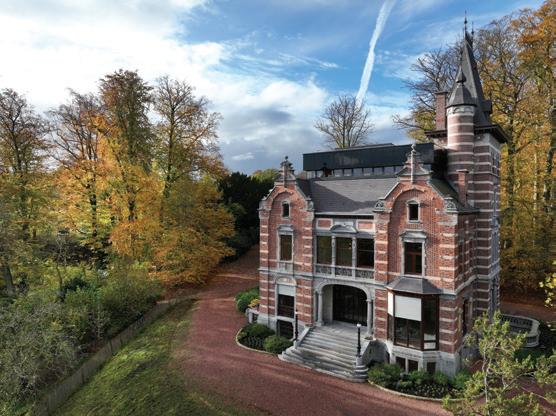
logical status and high protection as part of Brussels’ green belt.
But the château did not flourish as its surroundings. The early 1980s saw it devastated by fire. The Brussels Capital Region took ownership in 1989 but restoration efforts didn’t kick in until 2013 when a call for tenders was won by Metzger’s firm. The challenge? To preserve the château’s historical integrity, while recasting it for the needs of today.
“The city of today is built from elements that have already existed. The environment is already there for the most part. Vacant land is nearly non-existent,” Metzger muses. “Cities are built through addition and subtraction over centuries. The key is to understand this evolution and work with it, not against it.”
As well as practising architect, Metzger was also a full-time professor until last year and remains highly involved in the architectural firmament. He is president of the francophone and German-speaking part of the Belgian Architects’ Order, and a member of the Royal Commission for Monuments and Sites. He talks warmly about how these “sources” all come together. When working with associates, you don’t have to explain the “why” – but with students you do, he says. Hence his developed reflections that nourish the château’s story.
“Today, the life of architects is about recycling the city,” he continues, referring to a 1999 book he co-wrote with Luc Deleuze, La Ville Recyclée. “It’s about rethinking and reusing, not destroying.”
He continues: “Cities should be built from what already exists, respecting their historical memory while simultaneously pushing them forward into the future.” He points out that more than 60% of waste in Brussels comes from construction. “We don’t demolish buildings anymore,” he says, “we recycle and reinvent them. It’s an ecological responsibility.”
Modernist architects, by contrast, were intent on destroying the old, to create something completely new. “They hated Florence,” says Metzger. Le Corbusier bulldozed swathes of Paris to build his towers. “If the modernist had to build 1000 homes, they would all look identical,” he says. “Same orientation, same view for each.”
Things have changed. “Now we consider we can build 1,000 different homes, each pleasant to live in, and fit them into the old city with a sort of urban continuity,” he says. For the modernists, the emphasis was on the “programme”, whereas Metzger defines himself differently. “I am an architect of context,” he says. “I always consider the relationship between a place, a programme, and a specific moment in time.”
Yet this is not at the expense of modernity.
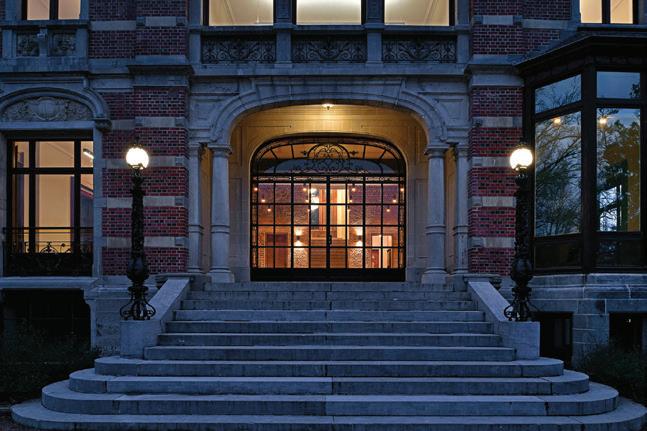
Metzger insists upon a “resolutely contemporary approach.” To illustrate he refers to another project, the Corinthia Grand Hotel Astoria Brussels. Though a listed building, he estimates the new work amounts to 80%, with 20% representing the traditional elements. “The 19th century had needs that have changed,” he says. “Far removed from those of the 1910 clientele. And today’s clientele in 2025 has other demands, which is why we completely reinvented the hotel.” Yet something ineffable remains: “When you enter, however, you have the strange feeling that everything has always been this way.”
Metzger’s work thus represents an effort to bring out an identity that lives in the site like the ghosts once suspected to frequent the château’s ruins. “The tragedy of the architect is that architecture, unlike music or literature, is never preserved in its original form,” he says. “You can listen to Bach in its original version, you can read the works of Victor Hugo or Maupassant as written. But architecture is different. It’s constantly transforming, and the identity of a building can be lost over time.”
The answer is to understand the architect’s original intentions, while pushing for contextual evolution. “All our work is a dialogue with an architect who is no longer here,” he reflects. “It’s about bringing back the essence of the building and reinterpreting it for the present, creating a link between what it was and what it is becoming.”
To that end, their work on the Château Tournay-Solvay saw the architects as investigators in the past – archaeologists of memory working to unearth the building’s true identity.
Sizeable challenges were faced, as attested by Pierre-Yves Villette, who ran the project for the firm. It took double the time expected, four years instead of two – because of the terrible state of the château. “The building had
We are architects of a city that has a rich, complex history. But we are also architects of a city that will evolve and thrive in the future.
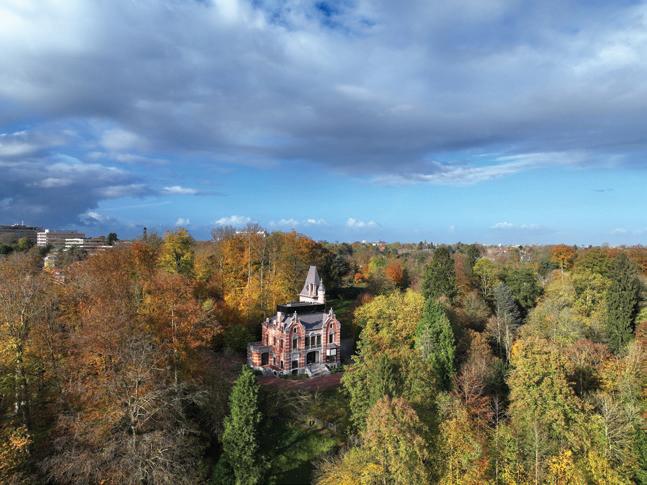
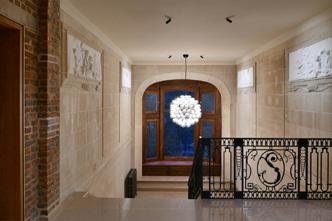
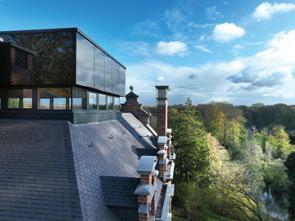
You can’t approach heritage with nostalgia. We have to consider how we can make the old city serve the needs of the future.
been for so long without a roof or flooring. Bats had roosted inside,” explains Villette. But perhaps the hardest was negotiating the high level of environmental protection afforded to the park. “We weren’t even allowed to bring trucks on-site,” he says. Installing the crane was a mission in itself. But he stresses that their construction partners did a fantastic job. “Go see the building,” he says, “and you’ll notice every detail is realised to a very high standard.”
The Château Tournay-Solvay is now an international centre for physics research. The initiative was originally spearheaded by Belgian Nobel Prize-winning physicist Francois Englert, who helped discover the Higgs boson, or “God particle.” But to turn this old, ruined castle into a practical site for a modern research facility, one element was essential –the roof.
Since the building was listed when the roof had already been destroyed by fire, the architects had wiggle room to reinvent a large section of the complex. “If we had been restricted to simply restoring as it was,” says Metzger, “it would have been impossible to transform this historic building into a state-of-the-art facility for modern physics.”
But the roof redesign meant they could create an essential and usable space for conferences, projections and physics seminars. This contemporary functionality speaks to the modernity Metzger believes should coexist with the past: “We’re creating a space that’s very much alive today, tied to modern physics and research, but built on the history of the site.” Such a reinterpretation goes far beyond the concept of restoration. “We’re not just preserving ruins; we’re reinvigorating them with a new purpose," says Metzger.
Metzger’s canvas spreads across the Belgian capital. What does he think of his hometown? “Brussels is the most beautiful city in the world,” he says without a hint of irony. Working on heritage here requires “a balance of respecting the past while shaping a future that lives and grows.” He expands: “We are architects of a city that has a rich, complex history. But we are also architects of a city that will evolve and thrive in the future.”
And Metzger should know – he’s worked on iconic sites across the Belgian capital. At the Palace of Justice, his team was charged with ensuring the behemoth’s safety and accessibility. “We worked to unlock the project, secure the Palais, and ensure justice could continue to operate there. We also made the courtrooms secure,” he says. “We implemented the famous courtrooms that allowed the criminal court to stay in the building, where prisoners are on one side, magistrates on another, and the public is on the third.” They also reformed the entranceways to enable airport-style security checks.
As well as the aforementioned Astoria Hotel, his firm has also worked on Brussels Central Station; Laeken Church; and the stunning 1934-built Villa Empain, a treasure of Brussels’ Art Deco heritage; to name a few. Meanwhile, they’ve won the continent’s prestigious prize for heritage restoration – Europa Nostra – four times.
“You can’t approach heritage with nostalgia. We have to consider how we can make the old city serve the needs of the future,” Metzger says. And what is the future for Brussels? “I believe in Brussels as a city that can evolve, but evolve thoughtfully,” he replies. “It’s not about erasing what’s there. It’s about integrating the old with the new and ensuring we don’t lose what makes this city unique.”
The Château Tournay-Solvay embodies this concept, as a cutting-edge physics institute built within a historical shell. Its essence has been identified and re-expressed, and a new life inaugurated, showing how city and architecture can evolve in harmony. “Our job,” says Metzger, “is to ensure that both histories — the past and the future — can exist side by side.”
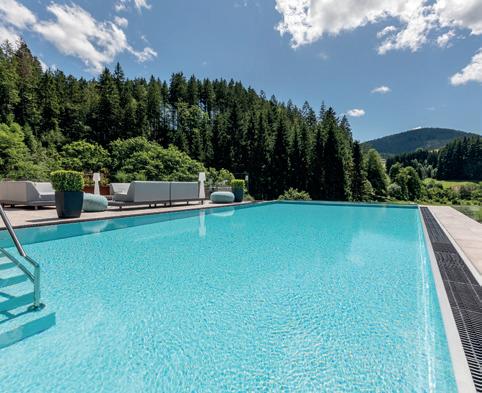

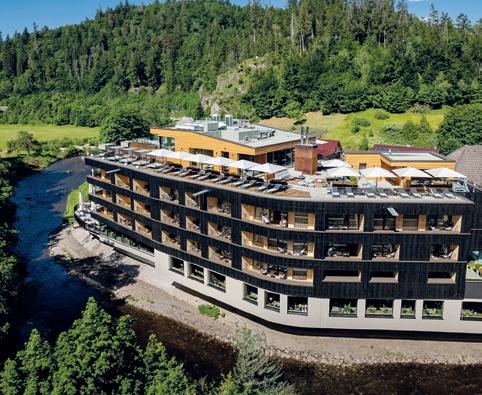
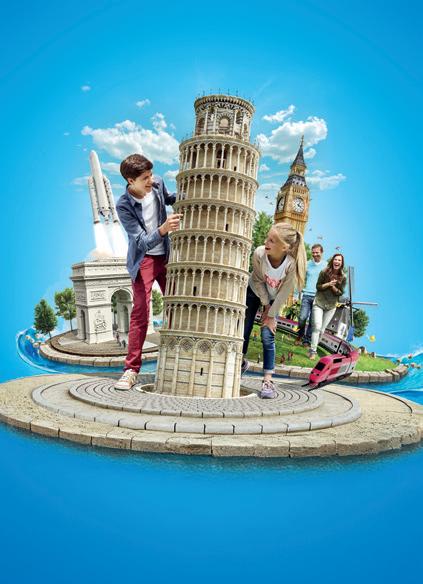
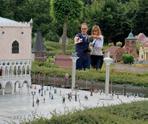

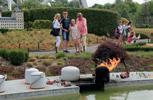
Your personal hideaway for unforgettable Black Forest experience!
• Culinary delights
• Wellness highlights
• Guest card for more than 80 original attractions
Sackmann Genusshotel Pearls by Romantik Tel.: +49 (0)7447-2890 Murgtalstr. 602 72270 Baiersbronn-Schwarzenberg
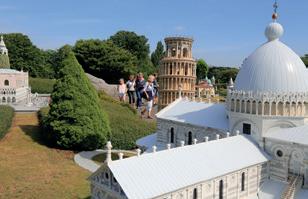
Be amazed ! Mini-Europe is a park featuring all the wonders of Europe, in miniature. Bonsai trees, flowery groves and dwarf trees embellish the 350 monuments which have been reproduced at scale 1/25. Thousands of lifelike figurines and animations! Set off the eruption of the Vesuvius and admire the takeoff of the Ariane rocket. The two hour walk, which is both entertaining and educational, will let you (re)discover the member states of the European Union and the UK, their historical, architectural and cultural wealth. Fun!
A trip full of surprises. Take the controls of the many opportunities for interactive live action that stud the route.
Fascinating!
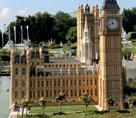
Have fun learning! Behind the captivating universe of the miniature monuments, the dramatisation and live action, relive our surprising common history
with its values and Greek, Roman, Viking heritages. You will find commentary at every stage of the journey in the free catalogue that is teeming with information and anecdotes that will delight children, those with a sense of curiosity and those passionate about history.
Did you know?
Unrivalled quality of artistry. The Cathedral of Santiago de Compostela alone involved 24,000 hours of work. At 13 meters, the Eiffel Tower is taller than a 3-storey building.
Indoor space.
Located at the end of the park, the ‘Spirit of Europe’ welcomes you into a large covered space where live action models, games and quizzes will give you the chance to test, enrich or perfect your knowledge of the member states of the European Union.

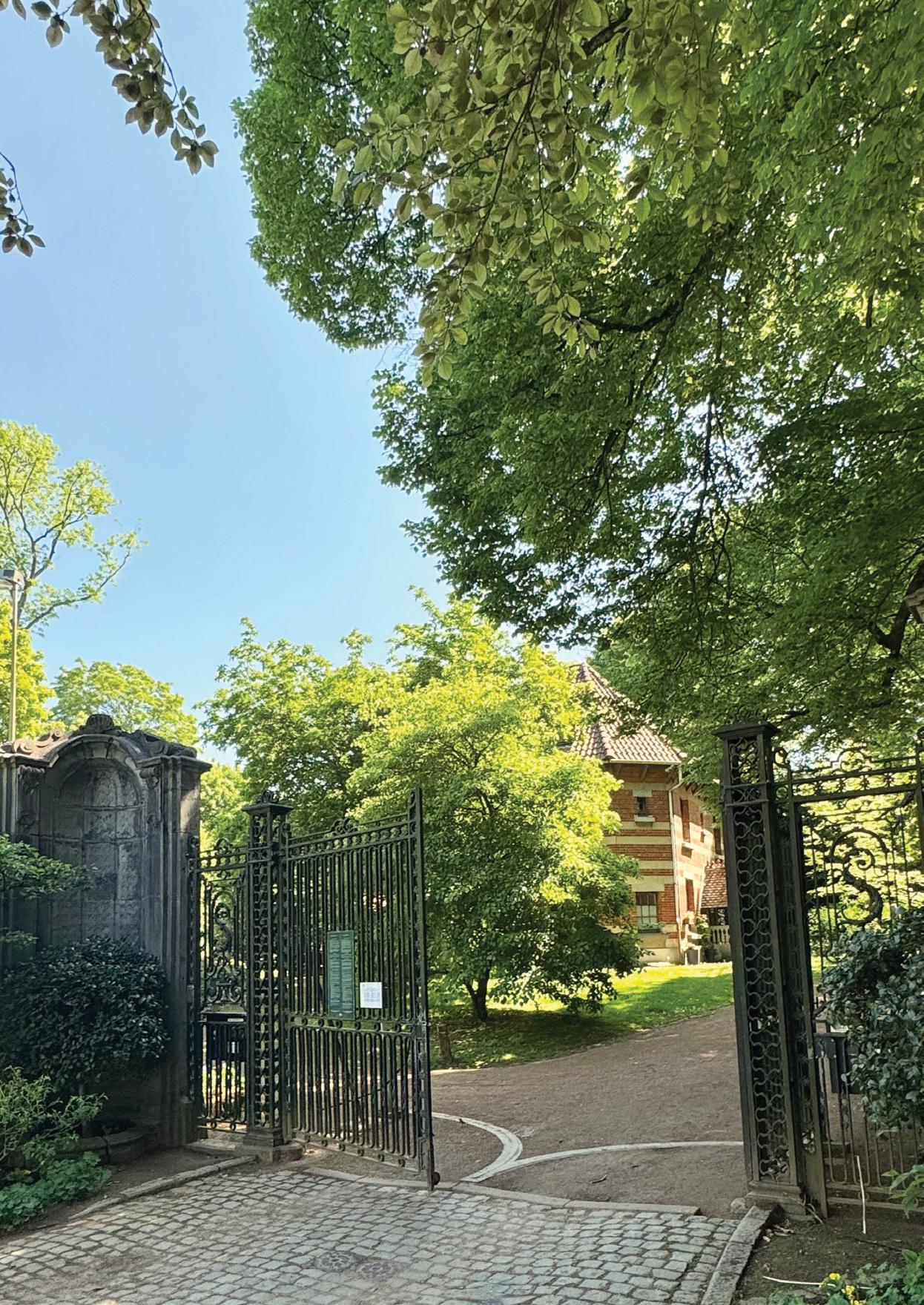
Tournay-Solvay is contemplative rather than spectacular, secretive rather than boastful. As David Labi writes, it is a place where nature is not forced to behave, where decay is part of the design, and where history seeps from stone and soil alike
On the southern edge of Brussels lies a realm of quiet enchantment. Nestled between the clatter of commuter trains and the rustle of broad-leaved canopies, Tournay-Solvay Park is an elegant anomaly – a historic estate turned urban refuge, caught halfway between decay and rebirth, culture and wilderness.
Marked by grandeur, decline, and reinvention, Tournay-Solvay Park sits on the southern fringe of Brussels. Part of the city’s Green Belt, or Promenade Vert, it is orbited by Boitsfort train station, the residence of the Japanese ambassador, and the International School. Its jewel is the recently renovated Château Tournay-Solvay (see previous story). From scattered ruins of former inhabitants to ponds and orchards, it provides a less polished alternative to the city’s more manicured green spaces. And its juxtapositions are a fitting microcosm for the patchwork city of Brussels.
Despite its generous acreage and noble pedigree, it remains one of the city's leastknown green spaces. Overshadowed by more central and better-groomed parks, it offers something altogether more compelling: a layered landscape of memory and moss, of rare trees and secret caves, of ruins and rebirth. In a city that often feels like a mosaic of contradictions, this park may be its most eloquent microcosm.
The story begins in 1877 when industrialist Alfred Solvay – of the Belgian chemical dynasty – purchased a swathe of forested land and set about creating a retreat in the style of an English country estate. The centrepiece, Château Tournay-Solvay, rose the following year in Flemish neo-Renaissance splendour: gabled, turreted, and resolutely dignified.
Solvay’s daughter, Thérèse, inherited the property and expanded its cultivated grounds after her marriage to Émile Tournay. The union bestowed the double-barrelled name the park bears today. In 1911, renowned landscape architect Jules Buyssens was enlisted to lay out the gardens, and he returned in 1924 to design the rose garden –
a gem of botanical formality within a park that would come to celebrate the unkempt. But beauty fades. After Thérèse’s death in 1972, the estate slipped into decline. The chateau was abandoned, its windows broken, its rooms looted. In 1982, it was ravaged by fire – suspected arson – leaving behind a blackened husk that loomed like a ghost over its withering grounds. By 1985, the ruins formed a spooky centrepiece for a newly opened public park. In the same year, the rose garden and orchard were restored. The park’s path to preservation was neither quick nor straightforward but its status as a protected heritage site was formalised in 1993.
But its renaissance has been anything but sterile. Rather than sanitising its history, Tournay-Solvay has embraced it. It is now a place where trees grow crookedly, ruins are left to rot gracefully, and wildness is not a flaw but a feature.
Covering seven hectares, Tournay-Solvay Park is a patchwork of meticulously planned gardens sitting alongside wilder, more organic spaces. The vegetable garden, perched at the park’s highest point, retains something of Buyssens’ original design that challenges the rest of the park's more naturalistic vibe.
But this polished beginning soon gives way to wilder territory. A descent leads visitors to the large central pond, fringed by wetlands that form part of the EU’s Natura 2000 biodiversity network described as the “backbone of European nature policy”. This ecological status protects a rich diversity of species: amphibians, waterfowl, aquatic plants, and the insects and birds that depend on them.
Remarkable trees include a Bysance hazel also known as Turkish hazel – unique for growing as a tree rather than a shrub –as well as a purple beech, broad-leaved lime trees, a Japanese dogwood, and even a Lebanese cedar. The vegetable garden has medicinal, condiment or perennial plants and fruit
David Labi
It is now a place where trees grow crookedly, ruins are left to rot gracefully, and wildness is not a flaw but a feature.
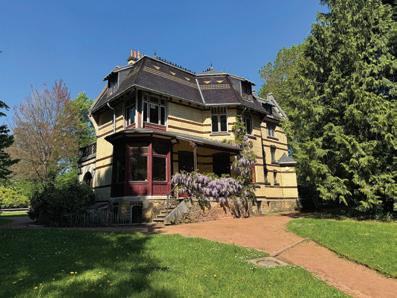
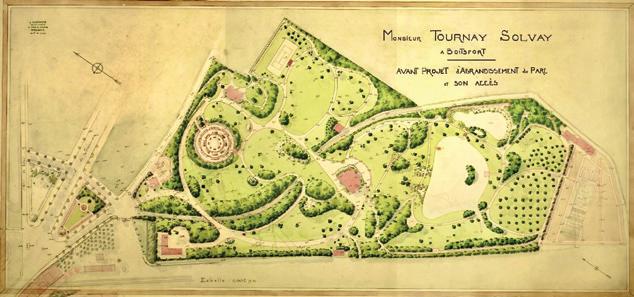
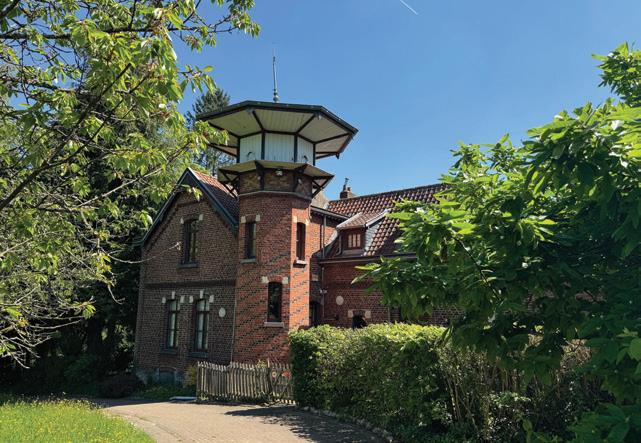
The orchard has a charming forgotten feeling, with apple and cherry trees nodding to an agricultural past.
trees. These stately inhabitants contribute to the sense of being in another time and place.
Near the pond, various marsh plants include telekia from southeastern Europe, among some 120 herbaceous species. Huge rhubarb-like leaves around the banks of the pond are butterbur. And around, these you might spot red-legged frogs, tufted ducks, herons, amid other local personalities. The ponds teem with fish including perch, pike, and bream.
It’s a park for all seasons. In spring, the orchard explodes in blossoms; in summer, frogs leap among lilies and dragonflies patrol the air. Autumn sets the trees ablaze with reds and golds, while in winter the park retreats into a skeletal quiet, interrupted only by the flash of a bird or the crunch of frost underfoot.
The park also features a mix of pathways — some manicured and gravelled, others narrow and overgrown. The orchard has a charming forgotten feeling, with apple and cherry trees nodding to an agricultural past. The old greenhouse, too, stands as a relic, its iron framework suggesting utility overtaken by nature.
One of the park’s strangest features is the separate sunken path that runs straight through – or beneath – it. This isn’t the dis-
ruption it might seem. Far from spoiling the atmosphere, the path lends the park a strange pulse: the elegant iron footbridges and stone tunnels that top it are overgrown with ivy and moss.
Other buildings than the château are exquisite examples of period architecture. To the right of the main entrance stands the castle’s former stables, built in 1920, restored in 1992, and now housing the Centre Regional de l’Initation à l’Ecologie, a local assocation that promotes responsible attitude towards the environment, notably through activities with schools. There is also the Villa Blanche, designed in the early 20th century to house visiting friends of the Tournay-Solvays, and now occupied by the European Foundation for Sculpture.
In the old gardener’s house, lives Sitki Akcelik with his family, an employee of Brussels Environment as concierge and guardian of the park. Since the park opens and closes at night, he sometimes needs to let trapped wanderers out.
He lives in the grand old house with bats in the attic, which he can’t access, since they are part of the park’s protected wildlife. But the sounds are just part of the nocturnal audio landscape he inhabits. Akcelik laments the loss of trees to climate change – too much rain followed by strong winds turns soil to clay and trees become “like glass” – liable to topple over.
The gardeners don’t curate the park for its visual aspects, preserving its wild status as a protected terrain. But they do plant trees with maximum respect for the topography of the site. Meanwhile, dead trees are mostly left as a haven for biodiversity – providing nesting material for the park’s smaller inhabitants.
Tournay-Solvay Park can be enjoyed through a walking loop. Enter via the main entrance near the station and the Chaussée de La Hulpe, and head up a tree-lined path, catching glimpses of the park’s mix of cultivated
and wild spaces. Perch at the first wooden bench to take in a panoramic view of the park’s rolling landscape.
From there you arrive quickly at the Château Tournay-Solvay, the park’s historic heart. Interpretative panels are dotted around to explain a little context. Look up top and you’ll see how the modern physics research centre has been built into the roof of the castle. And don’t miss the ornamental details on the château’s surviving brickwork.
As you follow downhill, you’ll hit the large central pond. At the wooden observation deck, muse on the wetlands and assortment of aquatic wildlife. The spot is particularly striking with the coloured leaves of autumn but has something to offer the spirit in each season.
Trace the narrow path upward towards the old orchard, and you might come across blossoming fruit trees in spring or ripe hanging fruits in late summer or early autumn. The remnants of the greenhouse in wrought iron and brickwork, somewhat poetically overgrown, are here as a reminder of the estate’s agricultural past.
Continue along the wooded path to the right to enter a more secluded forest area, with a wild, untouched feel and a sense of how Brussels might have been when carpeted with woodland. Old bridges and stone walls blend into the forest with the sounds of birds and rustling leaves, giving the sense of a secret refuge.
The path opens into a wide-open meadow. Drink it all in – ideally at golden hour – before heading back. The tree-lined promenade will take you back to the entrance on Chaussée de la Hulpe where a final turn back will reveal the château framed by its surrounding vegetation.
Away from the main paths and concealed by bracken and brambles between the pond and the wall, lies a lesser-known feature of Tournay-Solvay: a bat shelter in a repur-
posed icehouse. Amongst the bats welcomed are the whiskered bat, the common serotine, Bechstein's bat, Brandt's bat, Nathusius’s pipistrelle and the common noctule. An information board nearby says the icehouse, which looks like a sentry box built into a rising bank, keeps the temperature at a constant low, even in summer.
Bats spend the winter in hibernation, it notes, with three factors determining whether a space is a good wintering place: high relative humidity, constant temperature and quiet. “If they are disturbed while hibernating, they must draw on their precious fat reserves, which can be fatal,” it says. “Thanks to their cave-like climate, ice houses are perfectly suited for hibernation.
Locals whisper childhood stories about the “bat cave,” and conservationists have taken care to keep the site undisturbed. In spring, ferns spill across its entrance, giving it the look of a portal into older times. Though shallow, the cave’s cool air and dripping ceiling evoke an otherworldliness – a miniature underworld tucked inside an urban park.
Amid the trees and paths are several sculptures, each telling its own quiet story. The most prominent is a replica of the Olmec Head no. 8 – a mysterious monolith with African features, modelled by artist Ignacio Pérez Solorzano on a 3,000-year-old pre-Columbian original discovered at the Mexican archaeological site of San Lorenzo – a surprising emissary from a history far further back than the Solvay heritage.
There is also the sculpture of a young girl who died at age 22, Kelda Spangenberg, commissioned by her bereaved parents, and resembling both a woodland fairy and benevolent ghost. An example of the quiet magic found in the corners of this strange, beautiful park.
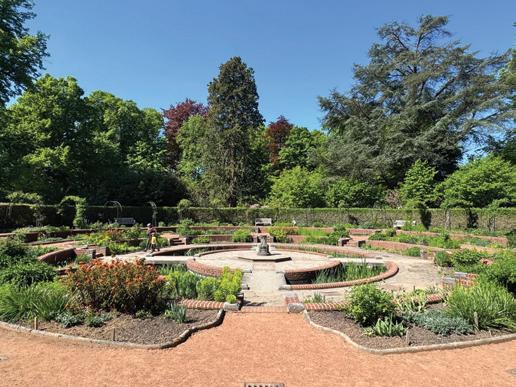
Away from the main paths and concealed by bracken and brambles between the pond and the wall, lies a lesserknown feature of Tournay-Solvay: a bat shelter in a repurposed icehouse.
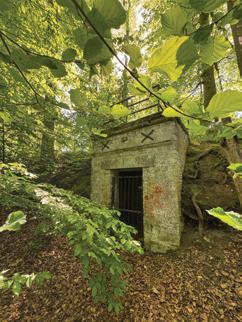

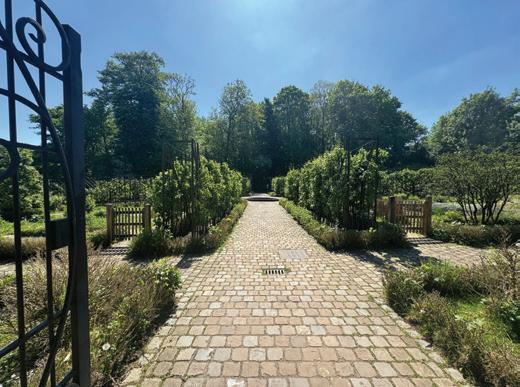

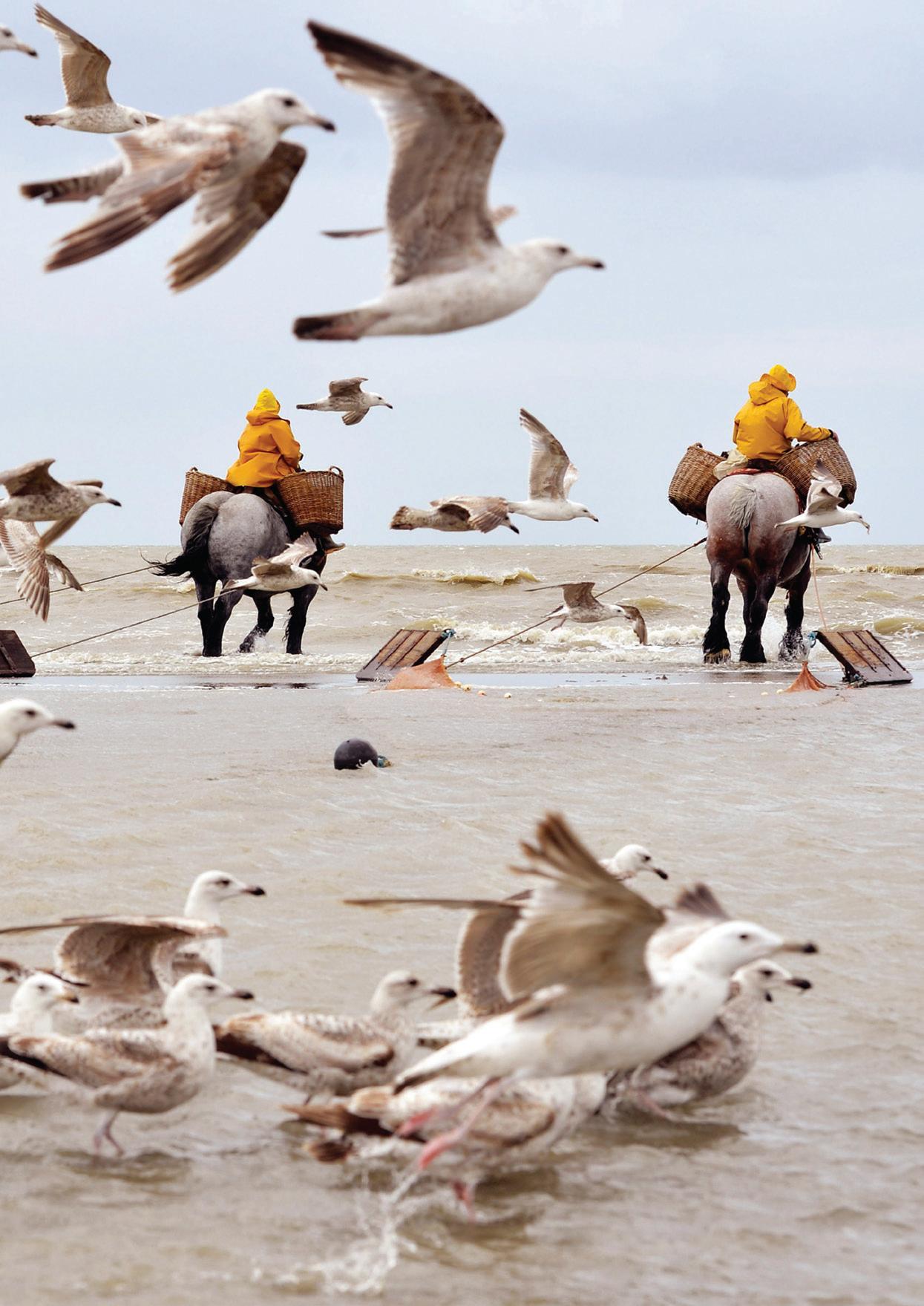
The 500-year-old tradition of horseback shrimp fishing along the North Sea coast has all but vanished – except in the Flemish village of Oostduinkerke. Here, a closeknit community keeps the UNESCO-recognised practice alive. Angela Dansby follows a shrimp fisher on her catch of the day Angela Dansby
What a man can do, a woman can do also.
In a rural meadow a few kilometres from the West Flanders coast, Nele Bekaert fetches one of several Brabant draft horses that her family owns. Weighing about a ton, the mature and powerful horse is ideal for pulling a dragnet to catch tiny, grey shrimp in the North Sea. Bekaert outfits it with blankets and an old-fashioned wooden saddle, to which a cart carrying her fishing gear is hitched. She rides the horse from dirt to paved roads amidst cars and onlookers to the seaside of Oostduinkerke.
At low tide, the horse trudges through wet sand for hundreds of metres to reach the sea’s edge. Bekaert walks alongside it, donning thigh-high, waterproof boots. Upon arrival, she puts on bright yellow waterproof overalls, a slicker and a fishing hat. She replaces the cart behind the horse with ropes and a large dragnet. Two baskets are placed at the animal’s sides, and a bag of straw is thrown on top of the saddle. Bekaert mounts the massive horse, wedging herself between the baskets.
She leads the horse into the sea until the water reaches its thighs, and they slowly move parallel to the coastline. A pair of metal-wooden plates flank the net, dragging on the sea floor to keep it open. A metal chain attached to the front of the net trawls over the sand, creating shockwaves that cause
shrimp to jump into the net, while water pressure pushes the catch to the back.
After about 30 minutes, Bekaert and her equine co-worker return to shore. As onlookers gather round, she empties the net, rinses and sorts the catch, keeping shrimp and edible fish like sole while leaving small fish and crabs for the seagulls. Using metal sieves, she filters out undersized shrimp, retaining only those fully grown and large enough to eat.
For this tourist demonstration, Bekaert would normally boil the shrimp on the beach, but today, she takes the catch home. It is only about one kilo – just enough for her family. She returns the horse and cart to the meadow and hurries home by car to cook as the shrimp are best boiled alive for maximum freshness.
The 42-year-old mother-of-three greets her family and brings water to a boil with a proprietary amount of salt in a stove-like cauldron outside of their garage. She and her shrimp fisher husband, Chris Vermote, remove any remaining unwanted creatures from the catch before throwing the shrimp into the hot water. About 10 minutes later, the grey shrimp turn pink and white. Bekaert removes them with a large, slotted spoon and begins the arduous task of peeling to get seafood less than a centimetre
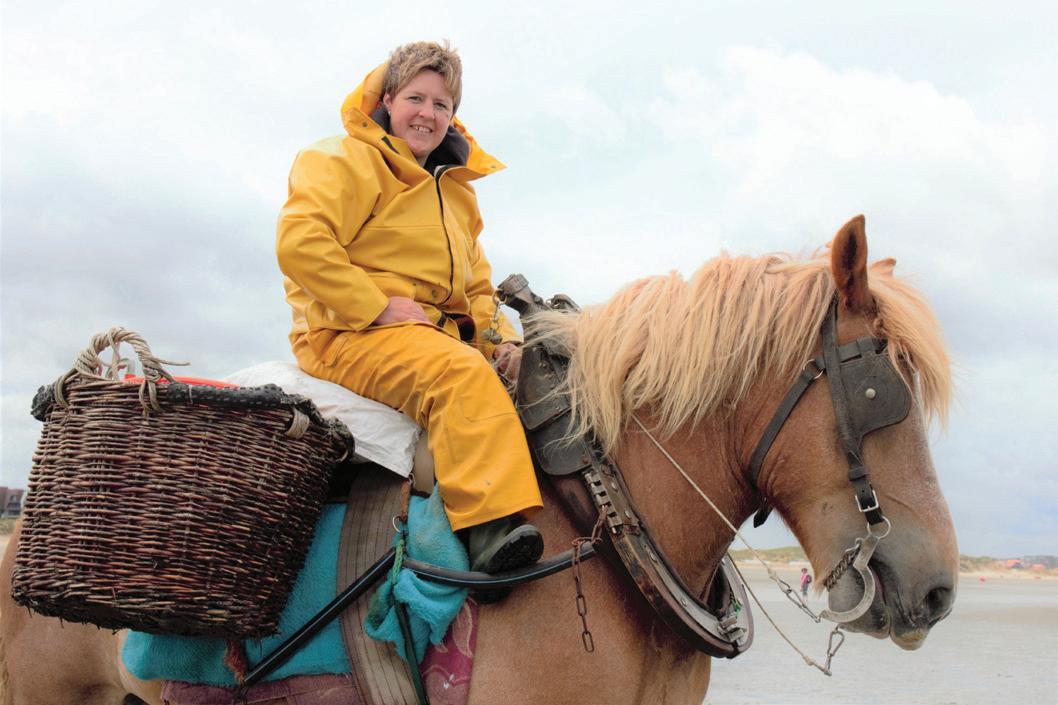
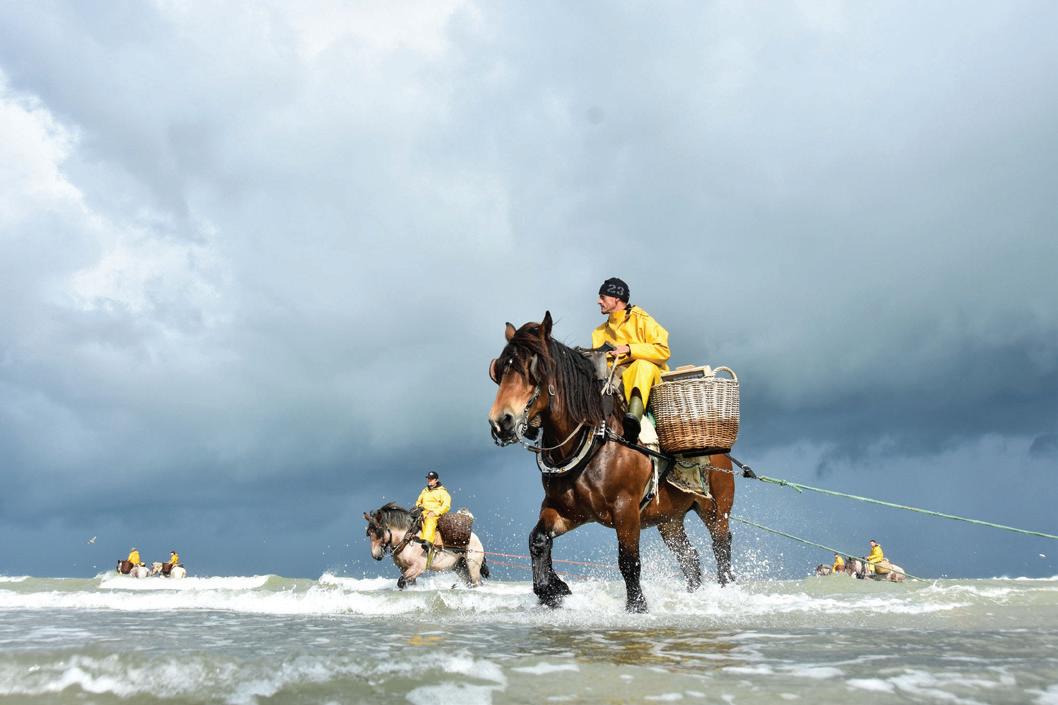
long. A taste test reveals the big flavour of these little shrimp and their unparalleled freshness.
Bekaert and Vermote are part of an elite team of 14 active horseback shrimp fishers, formerly known as d’Oostduinkerkse Paardenvissers (East Dunkirk Horse Fishers). Each year in Oostduinkerke, they give 36 public demonstrations and participate in a Shrimp Festival, events subsidised by the village’s municipality of Koksijde to keep the craft alive.
From the 16th century until just after World War II, shrimp fishing on horseback was done in several North Sea territories (Flanders, France, England and the Netherlands), but eventually, it almost died out as economies improved and coastal farmer-fishers disappeared. In Belgium, for example, coastal dunes had small farms where horses were used to trawl for shrimp as an extra source of food and income. But as the coastline developed, farms were driven out and the horses moved inland.
Nowadays, the old-fashioned method has been entirely replaced by commercial beam trawling except in Oostduinkerke. That is thanks to former Koksijde Mayor Honoré Loones, who saved horseback shrimp fishing from extinction in 1950 by making it a tourist attraction with the first Shrimp Festival. The
craft has been supported by the municipality ever since, including the provision of land for horses.
In 1967, the Koninklijke Orde van de Paardenvisser (Royal Order of the Horse Fishers) was founded and took over festival organisation. Its mission is to promote and sustain shrimp fishing on horseback, support local tourism and gastronomy, represent the community at public events and carry out international promotions. It was granted the royal title in 2017.
As part of the Order, the East Dunkirk Horse Fishers play a vital role in promoting their craft. Members travel for demonstrations at events across Europe. Each September, they present the season’s first catch to the Belgian King Philippe at the Palace of Laeken as a symbolic gesture of the nation’s reverence for the activity. “The tradition is very important,” Bekaert notes. “I’m happy to help preserve and share it.”
Pivotal to her doing so was horseback shrimp fishing being added to UNESCO’s List of Intangible Cultural Heritage of Humanity in 2013. It called for a safeguarding plan and opened the door for women to participate.
Navigo Visserij (Fisheries) Museum in Oostduinkerke, funded by the municipality, has also been an anchor in preserving shrimp fishing on horseback. Founded in 1974, it provides related exhibits, educational programmes and for the last dozen years, the theoretical test
Shrimp fishing on horseback not only requires excellent equestrianism and significant trust with a horse, but also knowledge of the coastline, tides, sandbanks, currents, wave patterns and even cooking shrimp.
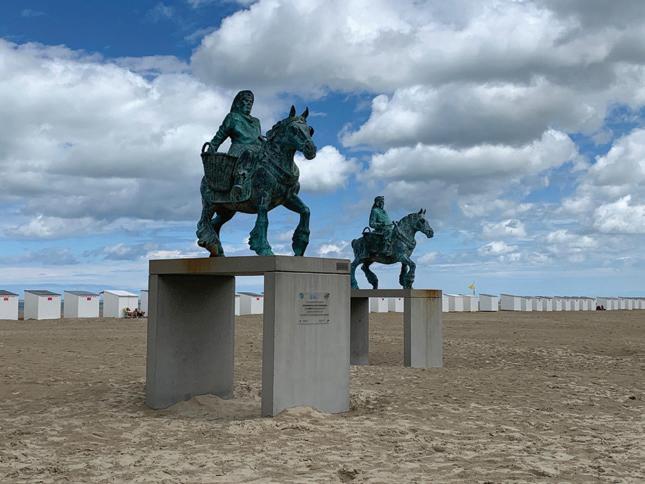
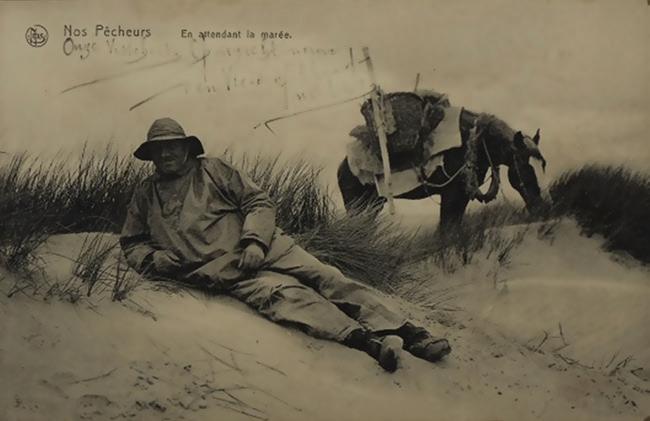
The tiny, grey shrimp are big in Belgian cuisine; about half of all caught in the North Sea are consumed in this country.
for new candidates. It was closed for renovation for three years, reopening last year with a new building, exhibition room, entrance and sperm whale skeleton. The museum currently has a temporary photo exhibition with portraits of “Pèèrdevisschers” (West Flemish dialect for “horseback fishers”) by photographer Stephan Vanfleteren until January 4, 2026.
While local women once commonly caught shrimp by hand-pushing mini trawlers, they were discouraged from doing so on horseback, as this was considered a task for men only. That notion persisted until 2015, when Bekaert became accredited to join the East Dunkirk Horse Fishers by completing a two-year training course with one of its members (her husband) and passing theoretical and practical exams. The hands-on test is assessed by a jury of horseback fishers, including the mayor of Koksijde. This training programme was inspired by
UNESCO as part of a master plan to preserve shrimp fishing on horseback. Because activities on its Intangible Cultural Heritage list must be equal opportunity, UNESCO also paved the way for women to break into the historical “men’s club”. Bekaert was the first.
“What a man can do, a woman can do also,” she explains. “And with UNESCO recognition, they could not say no to me.”
Bekaert and her husband and trainer, Vermote, initially faced resistance, but they persevered, and she proved her skill on horseback. “He supported me the whole way,” she notes. “He said, ‘You can do it, just do it.’” Not only did she become a member of the East Dunkirk Horse Fishers, but she was honoured by the Royal Order of the Horse Fishers in 2020 with her photo on an annual champagne label promoting their craft.
Now, she and Vermote are teaching one of their 14-year-old twin daughters to become the first shrimp fishing family on horseback (official training can only start at 18). Bekaert is hopeful that her daughter, plus two men currently getting accredited, can replace three elderly shrimp fishers who passed away in recent years.
The generational passing of this tradition is crucial to its survival. Each household involved specialises in a necessary skill such as net weaving, assessing tides and currents, or caring for horses. A dozen households representing 12 fishermen and two fisherwomen are interdependent.
Shrimp fishing on horseback not only requires excellent equestrianism and significant trust with a horse, but also knowledge of the coastline, tides, sandbanks, currents, wave patterns and even cooking shrimp, notes Ruth Pirlet, Navigo’s scientific coordinator. “It does take a lot of skill, and there are a lot of different ones involved.”
Economically, however, shrimp fishing on horseback is not sustainable in itself. “It's a hobby that costs a lot of money and takes a lot of time,” says Pirlet. “Most of these horseback fishers have a regular job and do this on top.”
The municipality only subsidises their public events and horse land, not ordinary shrimp fishing days, equipment, horses or animal care. Nonetheless, the women’s presence has brought new energy to the community, broadening interest in the practice, with Bekaert’s achievement drawing more publicity to the practice.
She also inspired fellow shrimp fisherwoman Katrien Terryn, who joined the team in 2020. “It's important to keep educating people about this tradition,” Terryn says. “It's a big part of the cultural history of this town. It’s a very beautiful tradition that cannot be forgotten.”
While less efficient than beam trawling, horseback shrimp fishing is more sustainable with the use of lightweight equipment in shallow
water. Its small-scale approach minimises bycatch and coastal impact. In contrast, beam trawlers use heavier equipment that can damage the seabed and disrupt marine ecosystems.
When shrimp are most prevalent – September to November and March to May – the average catch is 7kg, and they sell for about €10 per kg (in the summer, it’s too hot for most shrimp to come to shore). This is based on about three hours of fishing – 90 minutes before low tide and 90 minutes afterwards – with shore stops every 30 minutes to empty the net and put sorted catch into baskets for a total of nine hours per outing. The shrimp fishers typically eat, freeze or sell their catch to locals on call lists.
The tiny, grey shrimp are big in Belgian cuisine; about half of all caught in the North Sea are consumed in this country. They are used in classic dishes such as croquette de crevettes (deep-fried, battered rolls with molten shrimp filling, often including ground peels for extra flavour) and tomate-crevettes (a large tomato filled with mayonnaise-coated shrimp). The shrimp are also simply served atop buttered brown bread with coffee, beer or white wine. Restaurants proudly feature Oostduinkerke shrimp on their menus, and the local catch is highly sought after for its freshness and quality.
Oostduinkerke’s identity and pride are largely tied to its horseback shrimp fishers. “The people who live here are very proud of them,” notes Navigo’s Pirlet. “It's a tradition that's very much the life here.” Statues of the fishers stand in the village square and their images adorn local art, street names, venues, and even the label of Peerdevissher, a locally brewed beer. Their tradition is celebrated in stories, songs and family lore passed down through generations.
The shrimp fishers go out to sea throughout the year, except in winter. Their public demonstrations are on Oostduinkerke Beach from April to October, most frequently from the last weekend in June, when the Shrimp Festival occurs, through August (Navigomuseum.be has exact dates and times as well as contacts to book a private session with a shrimp fisher.)
The two-day Shrimp Festival is the highlight of the local calendar, drawing around 10,000 international visitors each year. It features a lively parade with decorated floats, shrimp fishing demos and competition (whoever wins rides first in the parade), Belgian Shrimp Peeling Championship, blessing of the sea, folklore market, shrimp tastings and a musical tribute by Mariette Crevette, the “mother” of shrimp fishers.
On Fridays in July and August, Navigo has Fisheries Folklore Evenings, staying open late with free admission from 6pm. Music and seafood are in its courtyard until 10pm, including fishing craft demos like basket weaving and shrimp peeling.
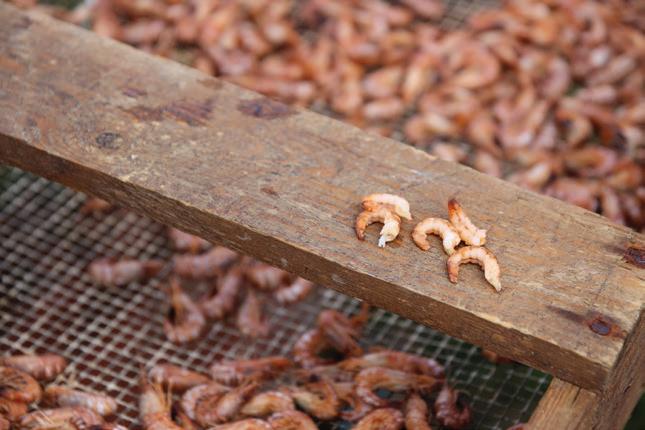
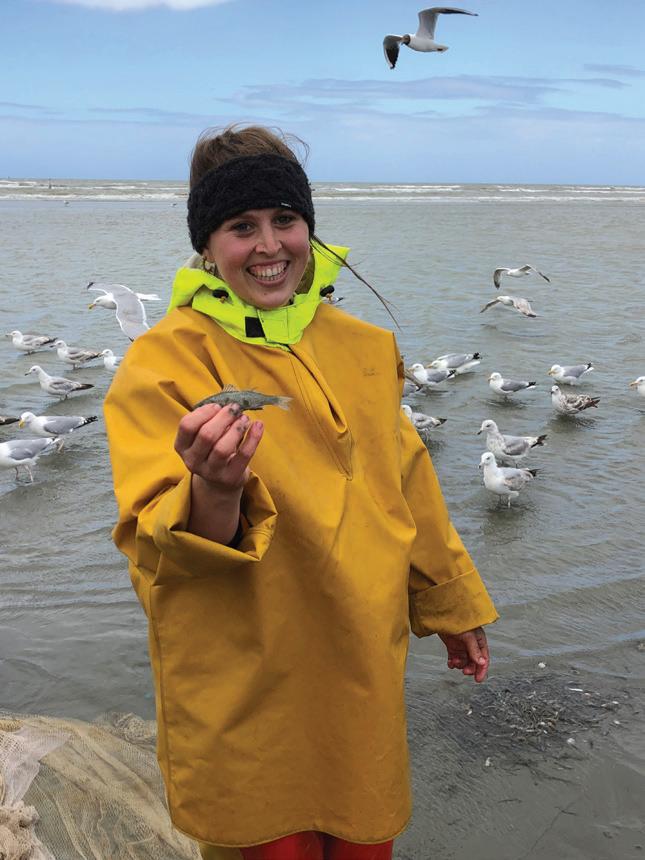
Such events help promote and preserve the art of shrimp fishing on horseback. Besides contributing to Belgian cuisine, shrimp fishing on horseback feeds the soul. “It’s fantastic to see, do and feel,” Bekaert says. “It’s all nature and oneness. Just a horse, a human and the sea.”
It's a hobby that costs a lot of money and takes a lot of time.

Despite spanning just 65 kilometres, the Belgian coastline is one of the most densely urbanised and idiosyncratic in Europe. It connects windswept dunes and post-industrial relics with beachfront promenades and high-rise apartment blocks, offering a peculiar mix of nostalgia, nature, and concrete.
Long promoted as the summer escape for Belgium’s inland population, this narrow strip now grapples with overcrowding, ecological degradation, and rising sea levels. construction.
Photographer Jorge Gutierrez Lucena walked the entire coast from the French to the Dutch border, weaving through its dunes, piers, hotels, woodlands, monuments, amusement parks and forgotten campsites.
Clockwise from top: The Acqua Scivolo monument in Ster der Zee Square, Koksijde, is now an unlikely landmark of 1970s tourism optimism; a nap under the sun near Nieuwpoort: a spring day in Ostend; built in the 1950s, Zeepark catered to postwar leisure dreams; between Bredene and De Haan, near Belgium's only official nudist beach: the Kusttram, the world’s longest coastal tram line, links the entirety of Belgium’s seaboard; a dead shark eyes customers queuing in the Ostend fish market; a flock of sheep grazing next to a train parked at De Panne station

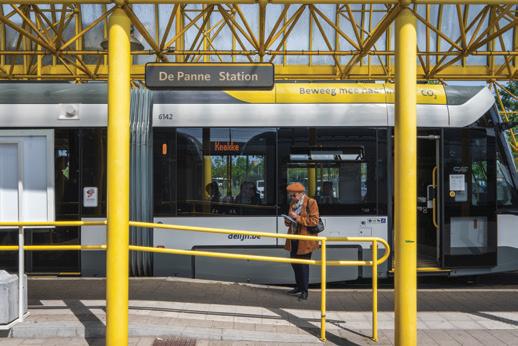
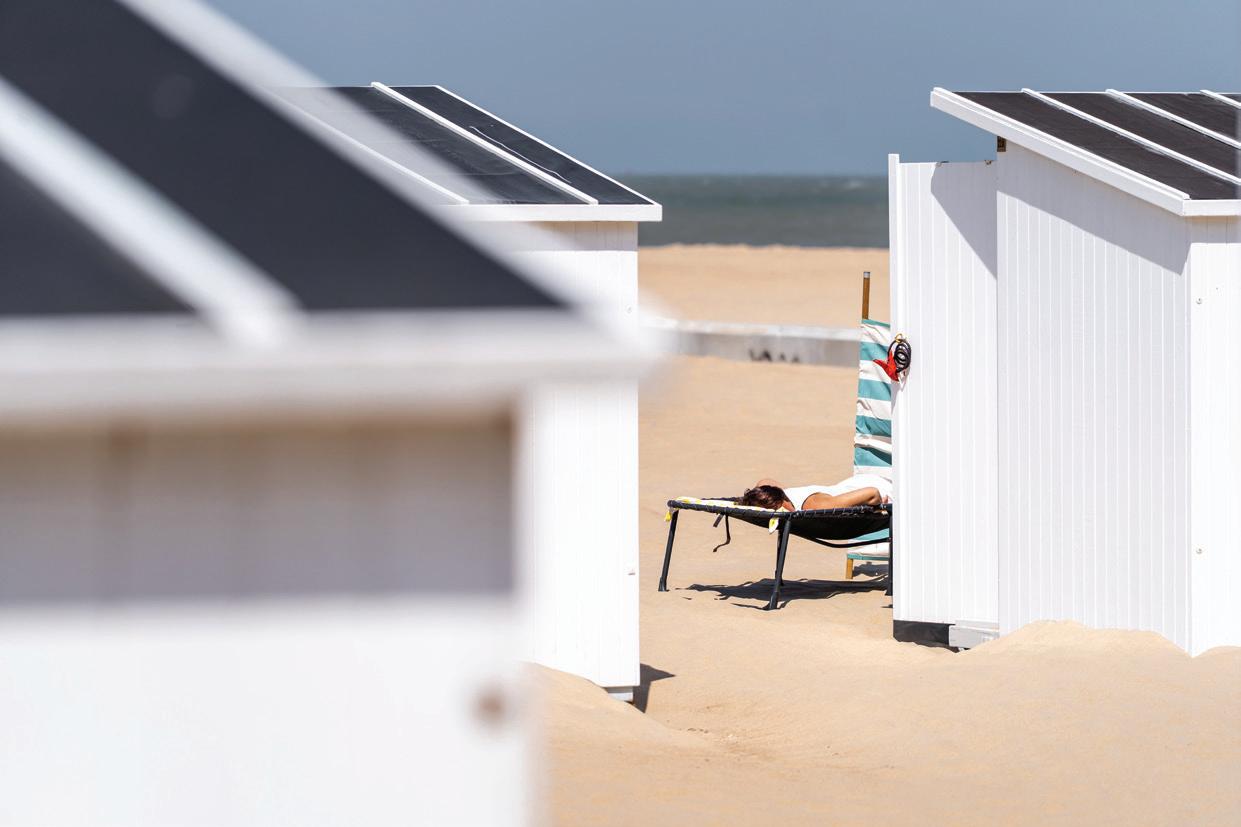
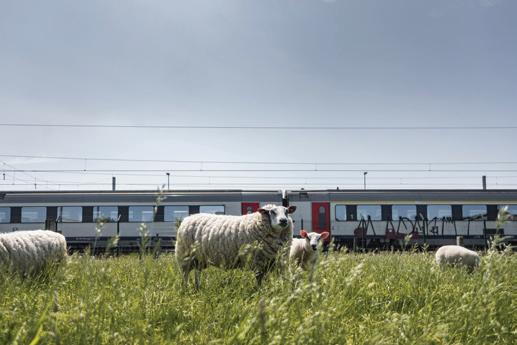
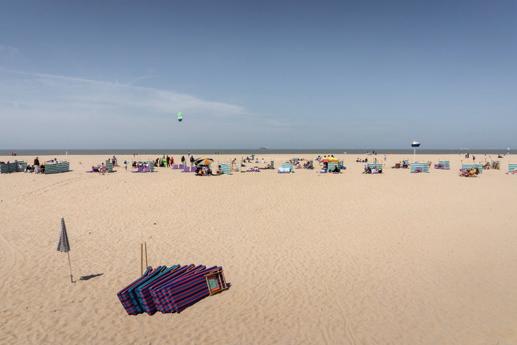
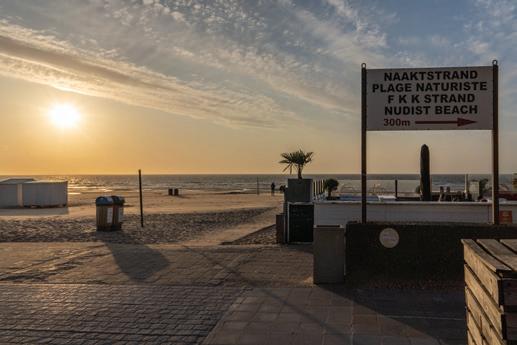
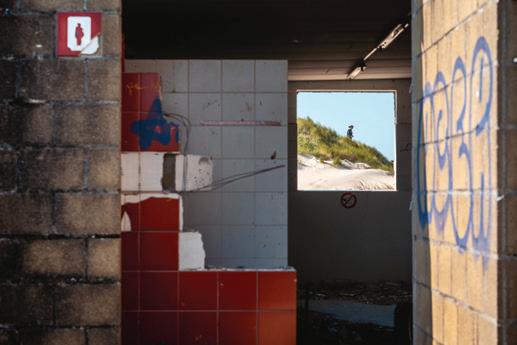
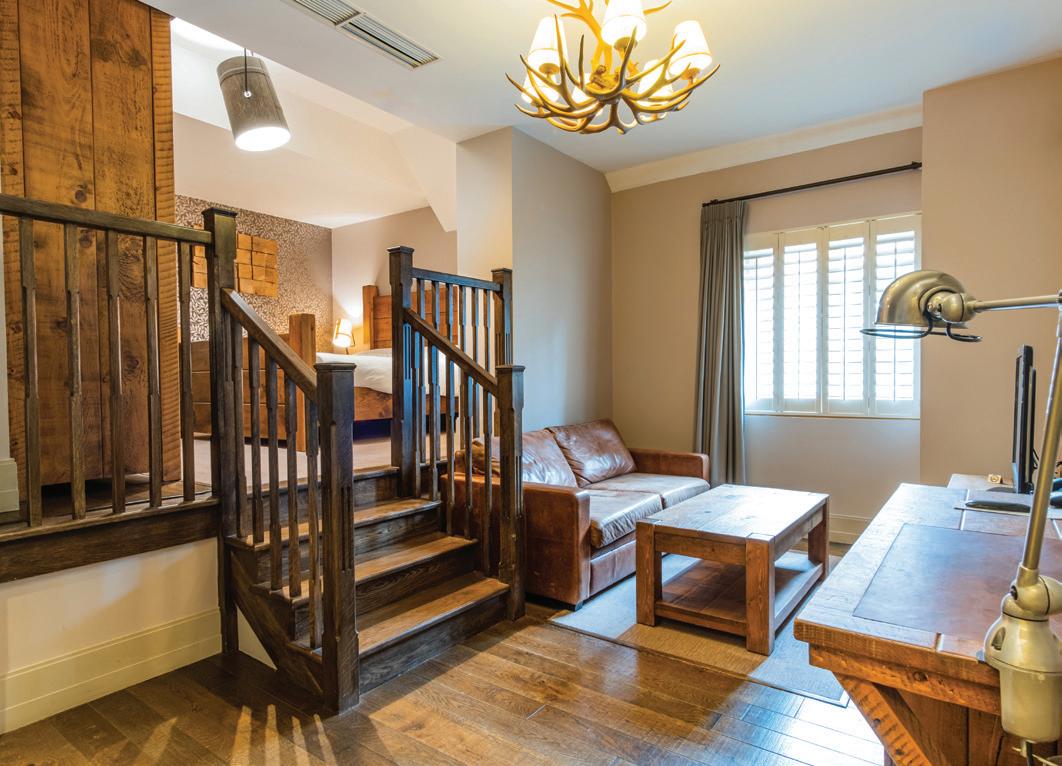
Accessible, refined and truly rejuvenating, Aspria Royal La Rasante offers a real art of living.
What if luxury, serenity and well-being were just around the corner in Brussels? Tucked away in a haven of greenery in Woluwe-Saint-Lambert, just minutes from the buzz of the city, Aspria Royal La Rasante invites you to enjoy an exceptional hotel experience – a stay where sport, spa and comfort come together in an elegant, tranquil setting.
This century-old private club, steeped in history and a passion for sport, offers 19 boutique rooms – including 3 spacious suites –within a beautifully renovated farmhouse.
But what truly sets Aspria Royal La Rasante apart is everything that comes with your overnight stay. As a guest, you enjoy full access to the club’s facilities: two swimming pools, a fitness area of over 1,000 m², two group class studios and one immersive cycling studio, seven tennis courts, and a sumptuous spa both indoors and out.
The spa offers a deeply restorative experience with a peaceful relaxation room, sensory shower, jacuzzi, hammam and a panoram-
ic sauna where you can enjoy traditional sauna ceremonies while overlooking the serene Japanese garden.
There’s also an ice room for hot-cold therapy, and a terrace featuring an outdoor sauna and a cosy seating area with an open fire.
Looking for a wellness weekend, a summer staycation, or a stylish place for visiting friends and family? This is the perfect answer. Accessible, refined and truly rejuvenating, Aspria Royal La Rasante offers a real art of living.
Enjoy a 10% discount with the code “BrusselsTimes” which is valid for all bookings made until 30/09/2025.
ASPRIA ROYAL LA RASANTE
Rue Sombre 56, 1200 Woluwe-Saint-Lambert T. 02 609 19 10
www.aspria.com

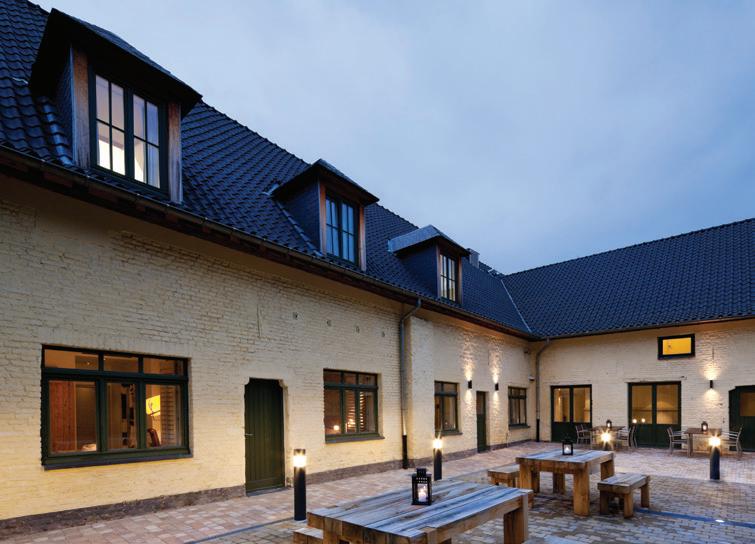
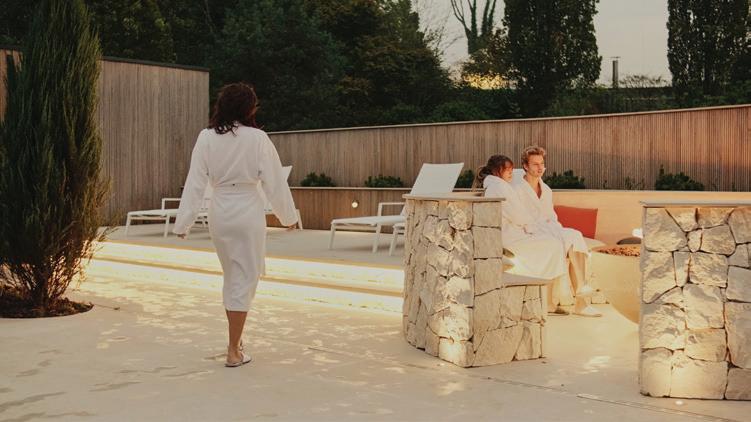
Tucked away in a haven of greenery in Woluwe-SaintLambert, just minutes from the buzz of the city, Aspria Royal La Rasante invites you to enjoy an exceptional hotel experience.
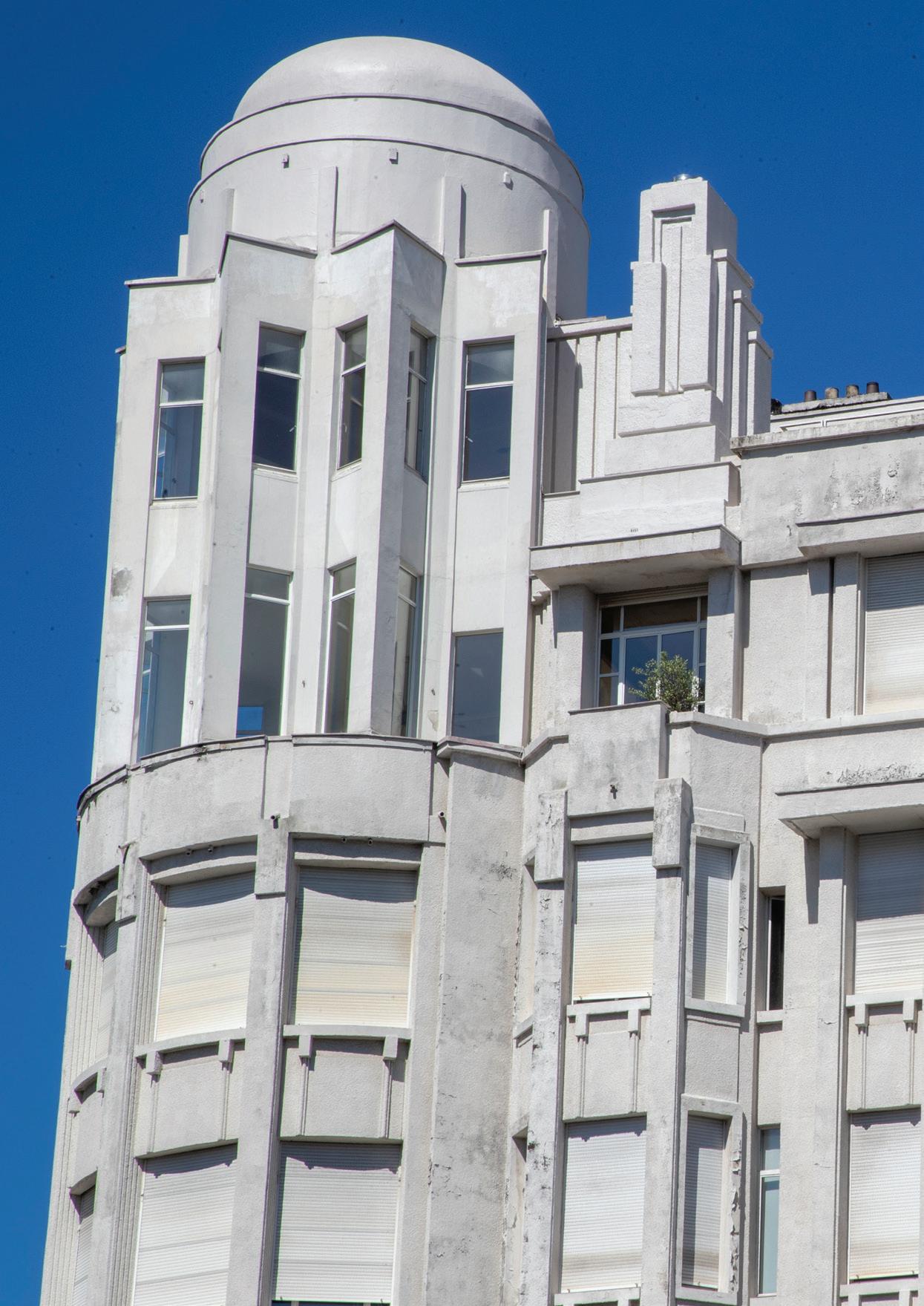
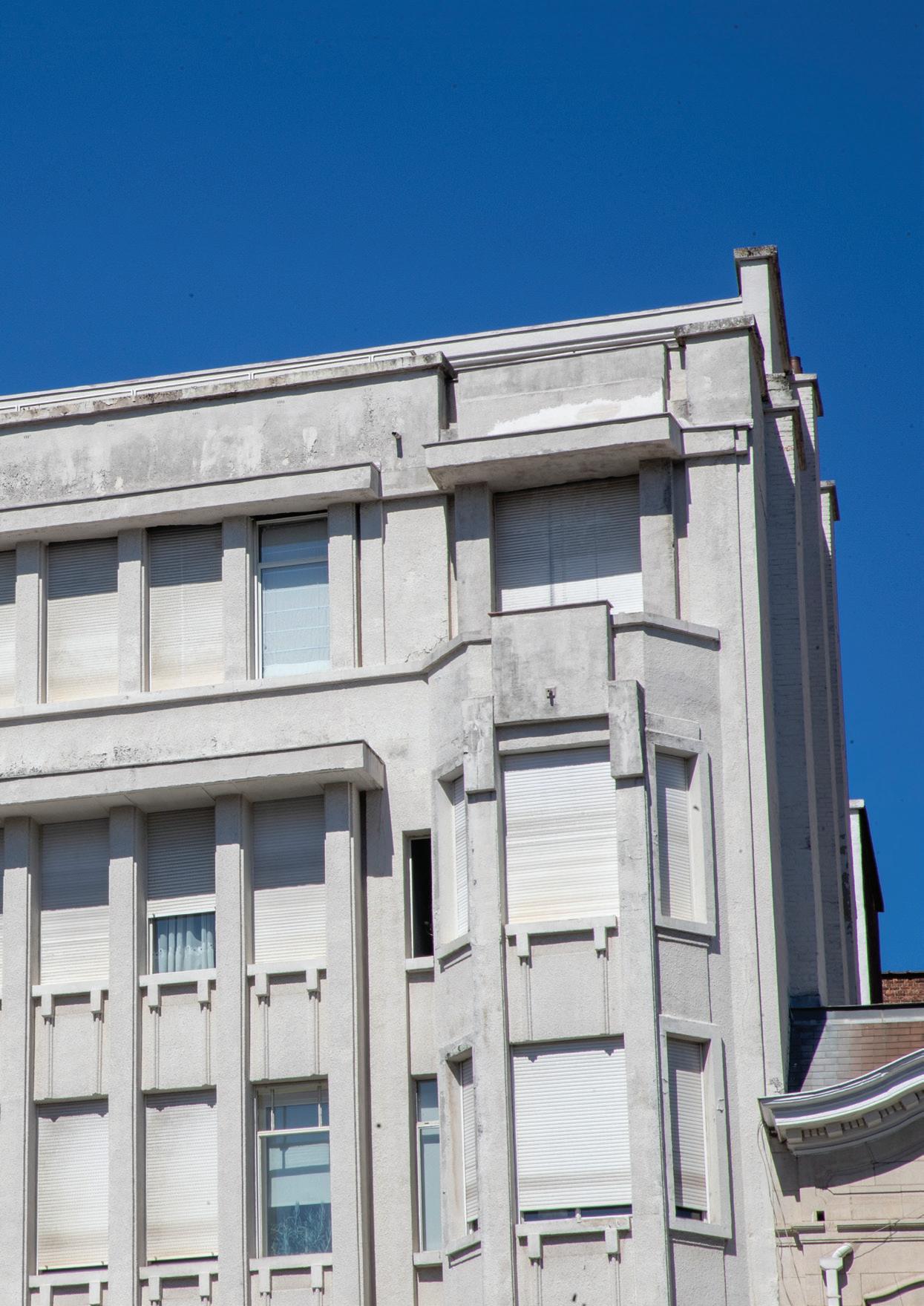
As we celebrate a century of Art Deco, the spotlight turns to Antoine Courtens, a once-rising star now regaining lustre. A pupil of Horta and a scion of artistic nobility, Courtens fused classical elegance with modern flair. His Palais de la Folle Chanson and Hôtel Haerens remain cornerstones of Belgium’s 1920s design revolution, marrying ornament, innovation and ambition in concrete and iron, as Frédéric Moreau writes
Frédéric Moreau
Balancing restraint with extrovert touches, he made his name with two of Brussels’ finest buildings in the style that are among the star draws of Art Deco year 2025.
Personal connections are key in architecture, both in terms of stylistic influence and career opportunities. Belgium’s most celebrated architect, Victor Horta, had been the pupil of Alphonse Balat, principal architect to King Leopold II and a master of the art of construction in decorative iron that would make Horta’s name in the 1890s. Profoundly rethinking his art in the wake of the First World War amid a squeeze on labour and materials, the great Art Nouveau stylist instructed a new generation of architects on the merits of simplification.
As traditionalists and modernists fought over whether buildings should be decorated, a compromise was found in Art Deco, exchanging the costly profusion of details for
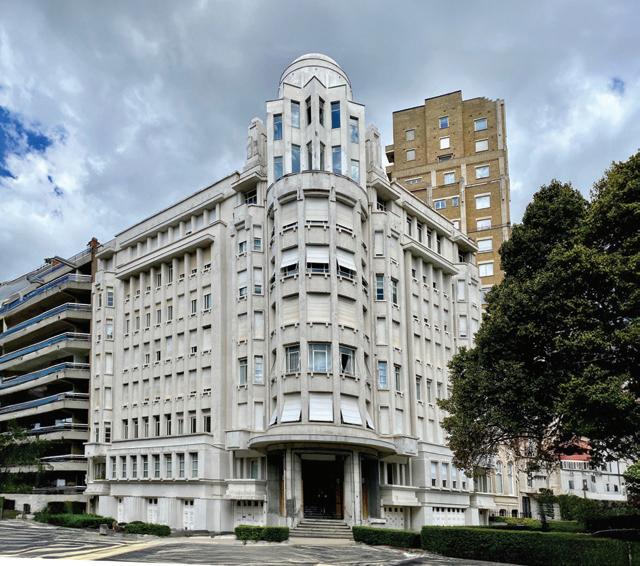

their targeted application, bringing a touch of luxury. Among the careers launched by Horta was that of Antoine Courtens, a brilliant student who built a long career on the short-lived Art Deco wave. Balancing restraint with extrovert touches, he made his name with two of Brussels’ finest buildings in the style that are among the star draws of Art Deco year 2025. Courtens sprang literally from Belgian artistic aristocracy. His globally recognised landscape painter father, a personal friend of royalty, was made a baron in 1922. That year, Antoine signed his first building, a studio for his brother Hermann, also a painter, collaborating for its decoration with another brother Alfred, a sculptor.
From 1920-24, Courtens completed his training under Horta in Antwerp during a drought of private commissions and as Belgium’s urbanist elders pondered the reconstruction of the war-devasted country amid a shortage of materials. He and Alfred would tap one source of commissions for young artists, teaming up to design monuments for Belgium’s war dead and war heroes. In 1924, he won the prestigious Prix Godecharle for young architects (Horta had won the same prize exactly 40 years earlier). The following year, 1925, these laurels and his professional and personal connections would help him lay the foundations of his decade-long run as one of Brussels’ key Art Deco architects.
Courtens was born in 1899, the year Horta completed the much-regretted Maison du Peuple in Brussels, a riotous assemblage of glass, iron, brick and stone that aimed to bury tradition through the creation of a costly new Belgian style (it was torn down in 1965). The very different Horta that took Antoine on as a student in 1920 had definitively turned the page on the Art Nouveau style that made his name.
Like many Belgian architects, Horta quit Belgium during the war. Most went to England or the Netherlands, allowing them to examine garden cities and the output of the Amsterdam school up close. Horta went to the US, where he fell under the spell of skyscrapers. He and his Swedish wife delivered lectures across the country on the splendours of Belgian art under threat from the enemy as propaganda to nudge America into entering the conflict.
Returning to Belgium in 1919, Horta delivered lectures on American architecture as propaganda to nudge Belgium into adopting a simplified approach to building as it tackled postwar reconstruction. He had been entranced by the sublimation of clas-
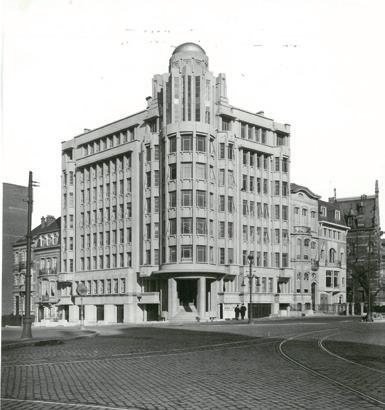
sical detail in US architecture into “cubic masses”, where “skyscraper-man” achieved grandeur through the scale permitted by economical, standardised materials such as reinforced concrete. He sold his house on Rue Américaine, a showcase for the opposite of these things: painstaking bespoke luxury creations (it is now the Horta Museum). He altered his design for the upcoming Centre for Fine Arts (now Bozar) melting its details down from classical sculpture to geometric blocks. As he took his place as professor of architecture in Antwerp, Horta applied this new austere style to the interior of his new home, converted from a 19th-century townhouse on Ave Louise.
In October 1924, the newly-qualified Antoine Courtens travelled to Paris to assist in the creation of the Belgian pavilion for the Exposition Internationale des Arts Décoratifs et Industriels Modernes the following year. Abbreviated decades later to just Art Deco, the show's centenary inspired the Brussels Capital Region’s celebration of the style for 2025. The project was led by Horta, effectively crowning him as Belgium’s official leading architect. As well as his former pupil, Horta employed his sculptor friend Pierre Braecke to place a classically inspired frieze around the front of the building. An odd note in a show where historical references were notionally prohibited.
The rear of the building however was inspired by the post-America Horta, in search of simplicity punctuated by detail. Pergolas, a bas relief of angular nudes set within unadorned concentric cement frames and a fountain, its basin incised with stylized wave patterns, all against a flat concrete facade, make up a compendium of the Art Deco vocabulary that would trickle across Brussels over the following decade. The sawn-off phantom windowsill parapets on the roofline hinting at an aborted additional
storey were motifs that Courtens would retain for later projects.
Courtens emerged from beneath the wing of Horta in 1925 and sought outlets for his talents, stretching beyond building design to furniture, jewellery, painting and, especially, ironwork and interior design. In June of that year, he married and took internships at Mercier in Paris and the following year in Lyon, under pioneer modernist architect and planner Tony Garnier, perhaps a key influence alongside Horta (for his side-hustle as a watercolourist, Courtens used the name Tony Juin).
Back in Brussels, Courtens’ first notable project came in 1926, a collaboration with Léon Govaerts, a close neighbour of his father and prestigious Art Nouveau veteran of Horta’s generation seeking a modern relevance. The two men converted the ground floor of an ancient house on Rue du Marché Aux Poulets into the spectacular Tanganyika café. Its broad plate windows were topped by an explosive riot of Art Deco stained glass, likely the work of Govaerts (sadly destroyed in 1964 but the rather tamer 1930 Taverne de l’Esperance by the same architect conveys some of its impact). Below the windows, and
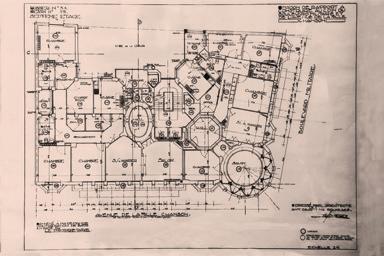
Courtens emerged from beneath the wing of Horta in 1925 and sought outlets for his talents, stretching beyond building design to furniture, jewellery, painting and, especially, ironwork and interior design.
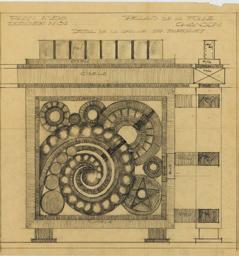
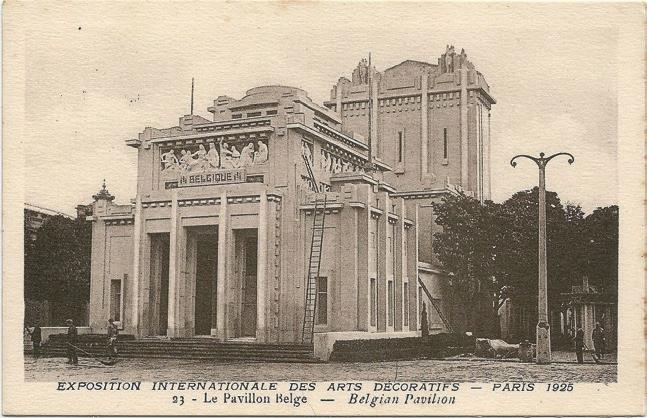
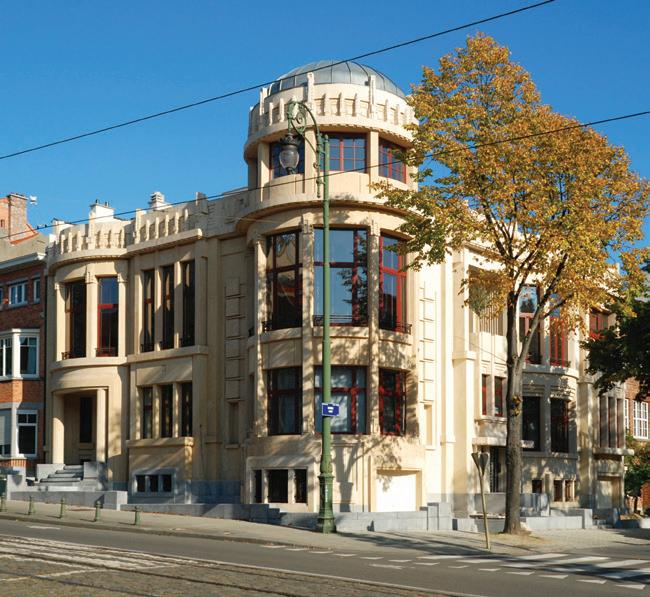
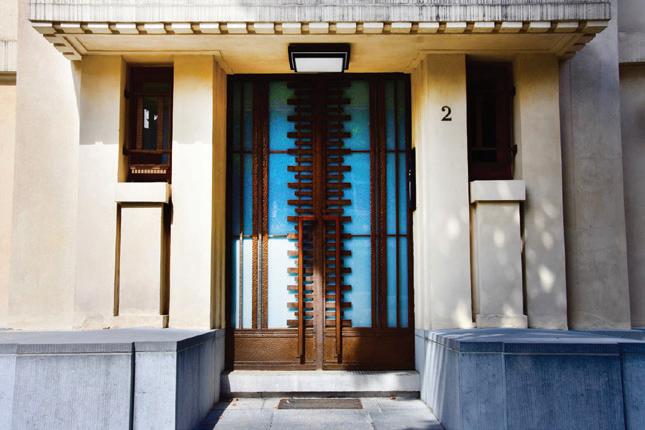
The extrovert, streamlined rotunda seizes the attention of passers-by, placing the Palais de la Folle Chanson in the pantheon of Brussels Art Deco.
far more restrained, a band of geometrical shapes parade across an iron grille in what is likely to be Courtens’ first contribution to the reinvention of that art.
Around the corner at 10 Rue de Tabora the following year and flying solo this time, Courtens created a lavish geometric Art Deco shopfront and interior for a furrier. While this too has vanished, he also transformed the facade which survives, in discreet discord with its formerly-identical neighbours in the row of classically-minded baroque houses hugging the church of Saint-Nicolas. Probably the first facade created by Courtens after his training by the new Horta it introduced pared-back classical detail, replacing the string course of its neighbours with a
plain pilaster without capitals and inset as if within a picture frame. The brackets of the windowsill parapets are simplified to the point of becoming squared-off mallets, the “cubic masses” of which Horta had spoken. Whether it was family connections or word-of-mouth admiration of his elegant modern work on businesses likely to be frequented by the wealthy and fashionable, in 1928, things took off for Courtens. That year, he won the orders for the two buildings that made his career and which are among the principal stars of Brussels Art Deco year 2025: the Palais de la Folle Chanson apartment building and a mansion, the Hôtel Haerens. The two buildings were innovative in both their form and decoration. Each has a concrete structure and each draws heavily from Horta, specifically the Fine Arts building and the much-overlooked and more radical rear view of the Paris pavilion.
That same year, Courtens became the artistic director of a decorative ironworks foundry, giving him a vested interest in loading his designs with metalwork. This he did with skill and perhaps more originality than with his architecture where it is often arguably the stand-out feature, inside and out. A “decorator-born”, according to the art historian Anne-Marie Pirlot, he was also a salesman-born and proposed a complete inside furnishing package to clients (as had his master Horta, back in a day when this was known under the grander euphemism of Gesamtkunstwerk or total work of art).
Like Horta’s Fine Arts building in central Brussels, the Palais de la Folle Chanson in Ixelles sits on a corner site where two wings at right angles converge on a rotunda. Unlike the constraints faced by Horta, notably a steep slope and a height limit preserving the view downtown from the King’s Palace, Courtens was gifted a large, flat greenfield plot far from royalty. It allowed him to line up garage doors at the base of each facade to serve the modern transport needs of each resident. This freed up the rotunda to permit a circular entrance bay, laden with rich ironwork, marble, wood and mirrors, preserving the traditional sense of occasion expected by visitors to a bourgeois address (but with the cost of such baubles shared). The corner cylinder occupying the entire height of the building allowed six circular sitting rooms to be stacked on top of each other. Rotundas had long been a feature of grander Brussels buildings, a solution to the challenge of turning a corner with architectural elegance. Here, with a touch of Art Deco swagger, it was crowned by a dome
supported by a drum surrounded by double-height triangular oriels which pick out the star shape of the traffic junction below.
The innovation of the building lay in the requirements of the client, who, in the course of the project became six clients as the absentee owner was able to pool costs thanks to the recent law permitting co-ownership of apartments. As well as creating 14 large apartments, Courtens placed a communal reading room and fumoir within the drum and, on top of each wing, large roof terraces. Here, residents accustomed to grand single-family homes could experiment with concepts new to bourgeois life for the 1920s: shared space, panoramic views and sun-worship.
The extrovert, streamlined rotunda seizes the attention of passers-by, placing the Palais de la Folle Chanson in the pantheon of Brussels Art Deco. The two side wings meanwhile are plain structures, with unadorned concrete pillars rising uninterrupted through the discreet horizontals of the windowsills, like the fretboard of a vast wide guitar (and inspired by the Paris pavilion).
The contrast marks Courtens’ adept grasp of Art Deco’s place, midway in the journey of architecture from florid Art Nouveau to austere modernism. From a profusion of detail to a concentration of detail.
Courtens’ other major project in 1928 was the Hôtel Haerens in Ave Brugmann, Uccle. Once again, inspiration appeared to draw on his master’s post-WW1 output. As at the Bozar (and the Palais de la Folle Chanson) two concrete wings placed at a right angle converge on a rotunda. As at the apartment building designed the same year, the tower resembles the summit of a buried skyscraper.
The major innovation here is that what appears to be a mansion is in all likelihood the most lavish maisonette in Brussels. Like the Folle Chanson, it reflects its time, built for a wealthy, modern-minded couple. Not so wealthy that they did not want income from a tenant in the lower unit, and modern-minded enough to aspire to life in a flat.
The interior of the upper apartment is of a concentrated magnificence. Ironwork balustrades echoing the exterior railings feature incised circles crammed into geometric frames, evoking machine cogs. The sloping corner site allowed access to the upper apartment via a short stairway from a magnificent marble-lined entrance hall and ramps to parking spaces for both flats in the basement. The decoration and technical design of the ensemble appear to appeal to the mind of an engineer and indeed the client was a transport engineer for the Empain group and employer of yet another Cour-

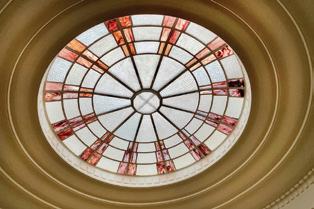
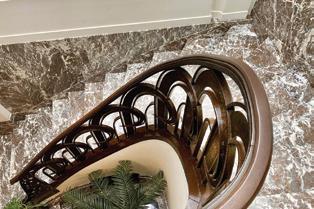
tens brother, Willy.
After designing the Haerens house, Courtens would be increasingly drawn into the universe of the Empain group, overshadowing his output of more modest Art Deco houses in the wealthy eastern suburbs of Brussels. He designed a depot for its light rail network based in Ostend and transformed three townhouses in Brussels for the HQ of its Electorail business, fronting them with the business-like fretboard facade first developed for the quieter side wings of the Palais de la Folle Chanson and reserving his exuberant ironwork for the interior.
In 1936, Courtens became a contract artist for Louis Empain, moving like his master Horta before him to North America. This time Canada, where he created a vast leisure complex at l’Esterel, building modernist residences and log cabins for this odd corner of 1930s Belgium abroad (its last traces were demolished in 2022). He returned to a changed Belgium in 1938 where Art Deco was morphing into a sober modernism. The age of the joyful rotunda had passed and that of the mournful fretboard of functionalism was on its way.
“It goes without saying that Antoine Courtens is not an architect of garden cities and affordable houses. He works only for those wealthy enough to allow the use of durable and pre -
The major innovation here is that what appears to be a mansion is in all likelihood the most lavish maisonette in Brussels.
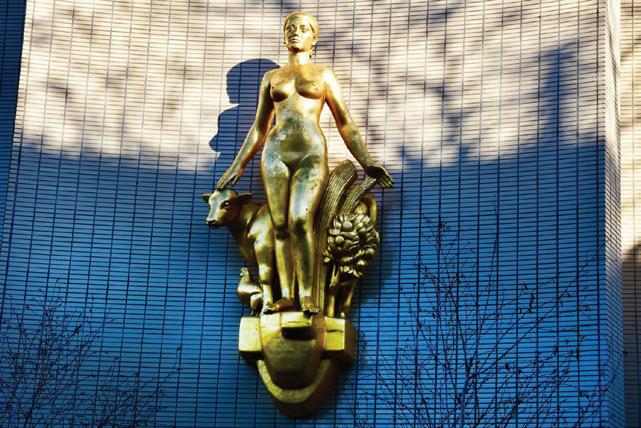
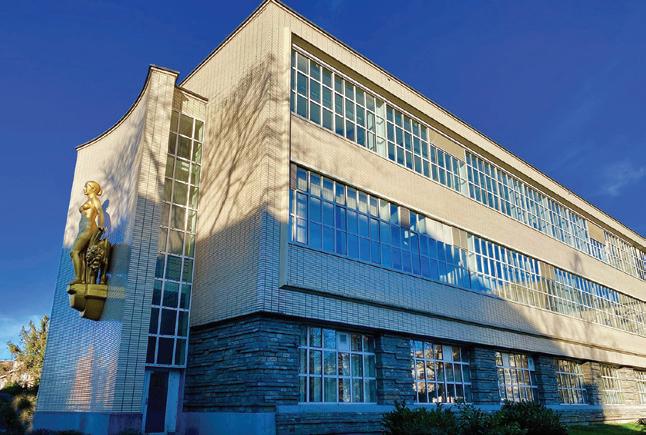
With its curves and its tower adding some character, CERIA is arguably a harmonious ensemble, but like most of Courtens’ later works, it melts into the increasingly functionalist.
cious materials.”
The lines, from a 1929 profile of the architect by Maurice Rassenfosse, a dealer in expensive knick-knacks turned arts journalist, read like an epitaph of the then 30-year-old. But Courtens continued in the profession until 1968, the year before his death, creating houses, apartment blocks, offices and, in collaboration with the Polak family of architects, the vast CERIA research complex in Anderlecht (he even built garden cities for Louis Empain around Europe).
Victor Horta had been converted to the potential of simplification and standardisation by his stay in the US during World War I. After the hungry occupation years of World War II, fact-finding missions to America by Belgium’s administrators convinced them of the need for food security through intense industrialization of production and marketing of taste. A competition was set up to design a 10-hectare com -
plex on a former patrician estate at the edge of Anderlecht where future leaders of the food and hospitality industries would learn the principles of the vertical integration of consumption.
Antoine Courtens won the commission (alongside Michel Polak and his sons Jean and André) to build schools to teach the application of traditional skills such as butchery, baking and confectionary to mass-market output alongside research facilities and labs honing the industrial standardization of these techniques. Bringing the mastery of site he had learned from Horta and developed on a grander scale in Canada, Courtens combined the institutional wings with sports and leisure facilities for the students around an existing lake.
In the 1920s, he had ridden the ragged coat-tails of the dwindling rentier class, making his name by serving their desires for luxury and functionality through the exquisite detailing and everyday useability of the Palais de La Folle Chanson and the Hôtel Haerens. CERIA’s mission meanwhile was to manufacture desire for products on a mass scale and the architect’s role was to deliver the functionality. His individuality as a designer was eclipsed by the engineering demands. Light and space to circulate were delivered in the form of concrete blocks with long bands of windows. With its curves and its tower adding some character, CERIA is arguably a harmonious ensemble but like most of Courtens’ later works, it melts into the increasingly functionalist, capable but rather frowsty postwar output of the profession. To the tastes of the 2020s, it pales against his stand-out creations during the brief flowering of Art Deco. Tastes change however. By 1948, when Courtens secured the CERIA commission, the page had been turned on Art Deco. Le Soir referred to the veteran of that forgotten style as the son of the famous painter Franz. A captive of his connections to the last.
Functionalism in Brussels will have to wait upon further recycling of tastes for now. It is the durable and precious Palais de la Folle Chanson upon which Courtens’ reputation rests and which adorns the cover of a 2002 book about him by Maurice Culot and Anne-Marie Pirlot entitled Antoine Courtens. Créateur Art Déco. Along with the Hôtel Haerens, it is a protected monument and as the face of Brussels Art Deco both buildings have been restored with the aid of public money. A townhouse on the east edge of Brussels of the same period which shares their design DNA is not protected but has been restored over decades by its private owner. As Brussels celebrates a century of Art Deco, the rising star of 1925 is seeing his star rise again.

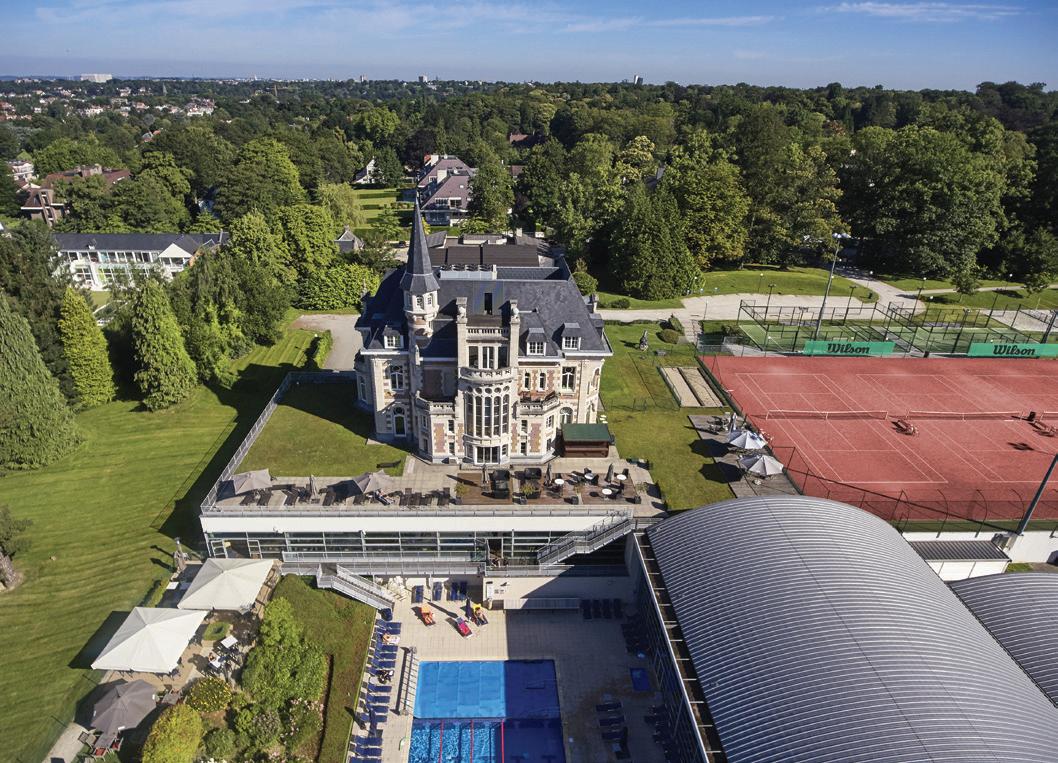
As Brussels’ leading destination for wellness and professional networking, David Lloyd is where the city’s business and lifestyle elite come together to train, recharge, or simply reconnect.
At David Lloyd Clubs Uccle and Sterrebeek, wellness isn’t just about fitness, it’s about balance, recovery, and community. From elite athletes to busy professionals, the clubs offer the space, support, and setting to help you thrive, not just for a race, but for life.
As Brussels’ leading destination for wellness and professional networking, David Lloyd is where the city’s business and lifestyle elite come together to train, recharge, or simply reconnect.
At Uccle, recent renovations have elevated the member experience. Nestled in the For-
est de Soignes, the club offers an inspiring natural backdrop for outdoor yoga to unwind after a busy week, forest runs, or a peaceful swim in the heated outdoor pool. A dedicated Kids Club makes it easy for parents to enjoy their own time; whether it’s a training session or a quiet moment on the terrace.
Sterrebeek also shines with its rooftop tennis courts, the first in Belgium as well as a spa garden, hydrotherapy pool, and sundrenched outdoor areas designed for true relaxation.
Both clubs blend high-end fitness and wellness with social connection, offering everything from aquabike and Battlebox sessions to padel and tennis for all levels, in a premium, family-friendly environment.
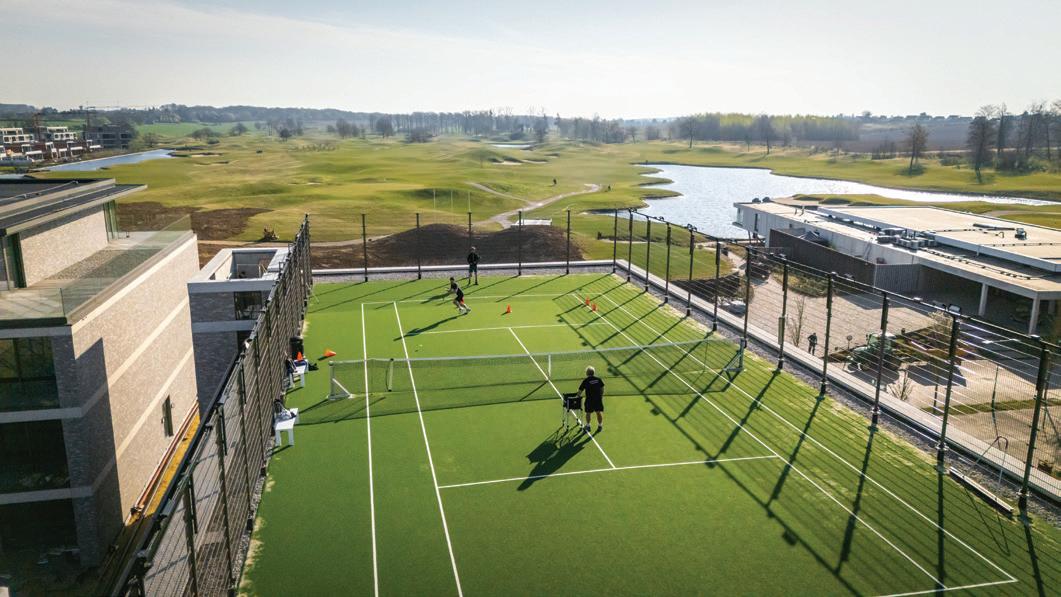
Denis Van Weynbergh, the first Belgian to complete the legendary Vendée Globe, is now focused on recovery, both physical and mental. A member of David Lloyd Uccle, he continues to train in a supportive environment that helps him regain strength and balance after the intense solo race.
"After such an extreme challenge, you're completely drained," Denis explains. "David Lloyd Uccle offers the ideal setting to rebuild gradually, strengthening my legs, easing back into a routine, and restoring my energy."
For Denis, sport remains a way of life, even in recovery.

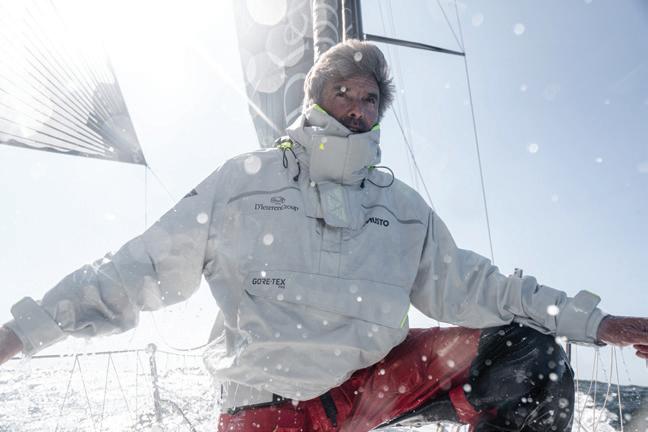
Both clubs blend high-end fitness and wellness with social connection, offering everything from aquabike and Battlebox sessions to padel and tennis for all levels, in a premium, family-friendly environment.
Curious? Come try it out
The doors are open.
Join one of the special open events for nonmembers happening regularly and discover what makes David Lloyd Clubs so unique!
www.davidlloyd.be
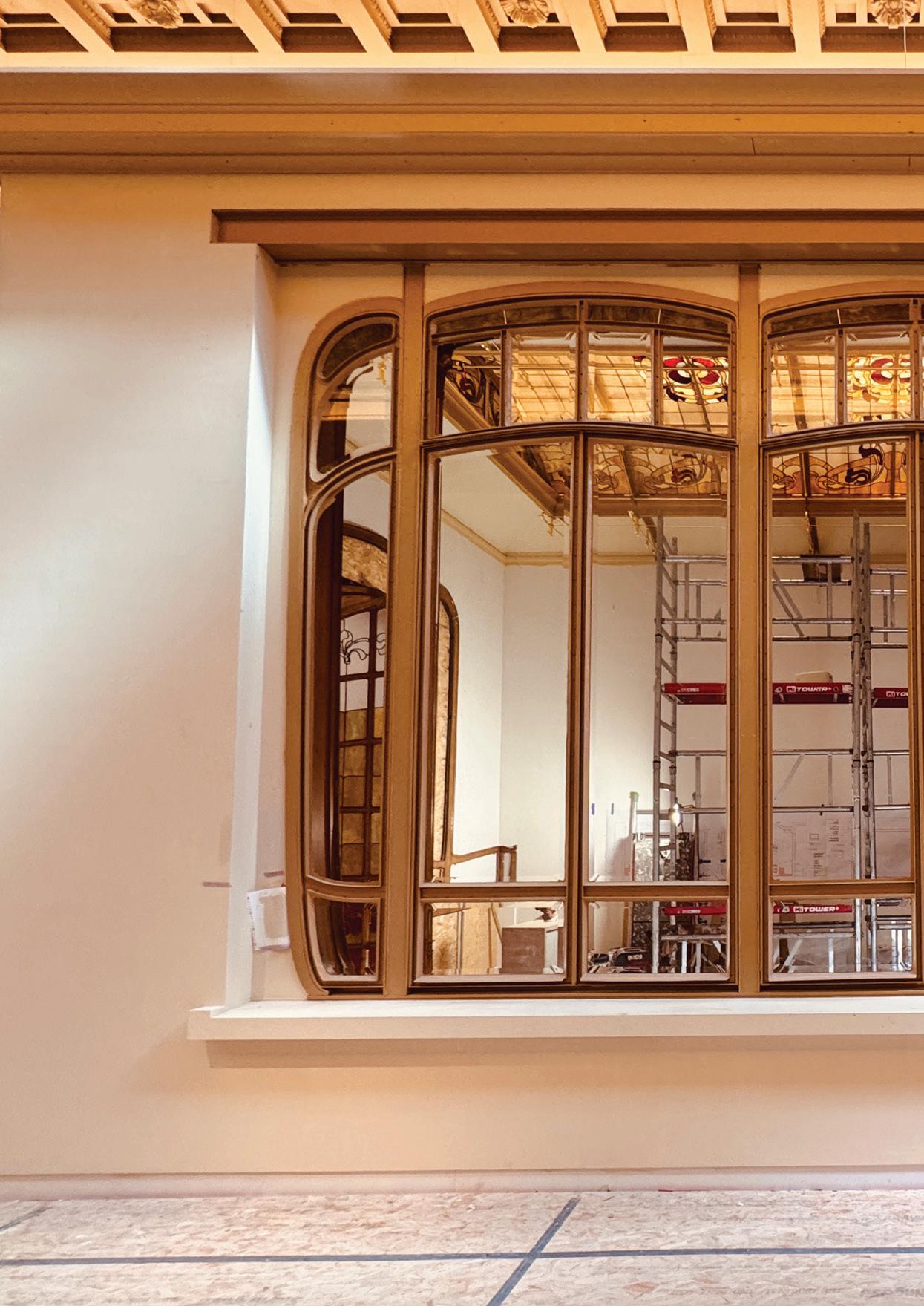
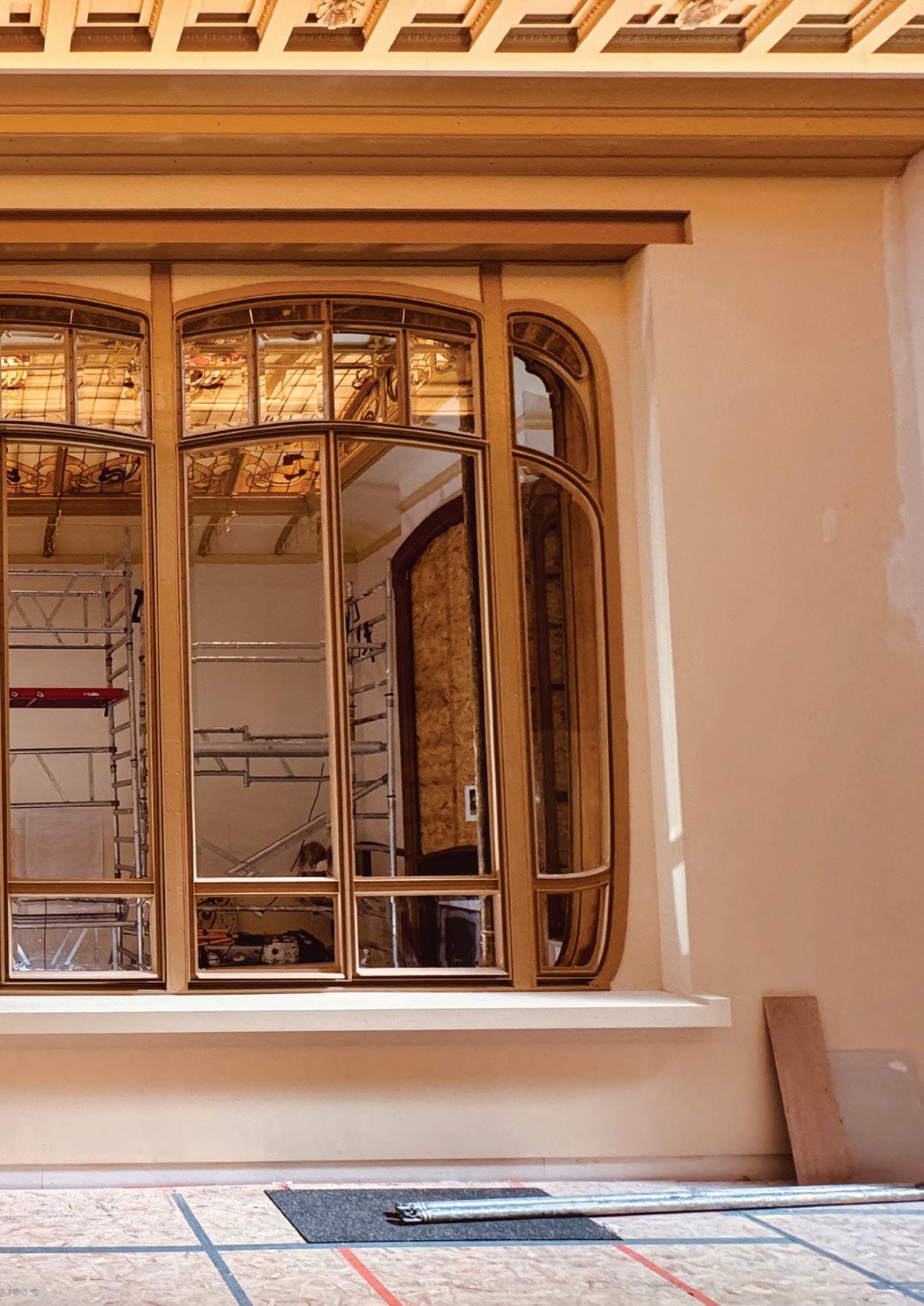
Two lavish new galleries in the Cinquantenaire Park unveil Belgium’s design story as never before — from the birth of Art Nouveau to the glamour of Art Deco and the gilded oddities of the 19th century. With 700 rarely seen objects and a showstopping Horta reconstruction, the Art & History Museum reclaims its decorative legacy. David Labi sneaks inside
David Labi
They reflect a growing recognition of Belgium’s central role in European design.
In Cinquantenaire Park, in a corner of the hulking Art & History Museum, activity and anticipation buzz. Two new rooms are set to represent the biggest revamp in the museum in over two decades. What began as a new collection of Art Nouveau has, over years of preparation, been expanded to include Art Deco, plus a room featuring Belgian decorative arts and lifestyle pieces from Belgian independence through the 19th century.
Curator Werner Adriaenssens, in charge of Art Nouveau and Art Deco, and Sophie Balace, one of the team responsible for the 19th century room, are readying the galleries to show us around.
As we walk, people put up panels, staff cross over to ask questions about construction invoices, and drills sounding from inside the painstaking reconstruction of Victor Horta’s formerly lost Winter Garden.
The team are full steam ahead to prepare the rooms for a visit of the King and Queen on June 10, and the opening to the general public on June 13. “We’ll get there,” says Adriaenssens as we stride through.
The two newly renovated galleries have their sights set on bringing fresh life to the story of Belgium’s decorative arts. The galleries present some 700 pieces – many previously kept in storage – housed across around 1,200 square metres of redesigned space. They reflect a growing recognition of Belgium’s central role in European design, especially in the evolution of Art Nouveau. But they go further, tracing the social, political, and technological developments that shaped the everyday life and aesthetic ideals of Belgian society from 1830 to 1958.
The first gallery is dedicated to Belgium’s most celebrated design export: Art Nouveau, along with its successor, Art Deco. Curator Werner Adriaenssens takes us through an eclectic
collection comprising giant posters from international fairs, stunning candelabra, room furnishings, folding screens, tables, a mass of chairs, paintings, tapestries, and more.
The space captures a vibrant era of creative renewal that sowed the seeds for modern design. The Art Nouveau movement took off in Brussels in the 1890s, with Victor Horta's 1893 Hôtel Tassel on Rue Paul-Emile Janson often cited as its architectural starting point.
Adriaenssens stresses that Belgian Art Nouveau wasn’t merely derivative: “It really is something that is born in Belgium and was internationally influential.”
He’s also emphatic that Art Nouveau is not all about Horta – a variety of styles and approaches abounded within the movement. To that, end the gallery showcases early proponents such as Paul Hankar. A contemporary of Horta, he opened his own studio house on Rue Defacqz in 1893, just a stone’s throw from Horta’s Hôtel Tassel at almost exactly the same time.
Trained in sculpture and architectural design, Hankar was known for blending structural clarity with artistic flair. He worked closely with craftsmen like goldsmith and sculptor Philippe Wolfers and painters such as Emile Van Nooten, while also pioneering the use of materials like sgraffito – a decorative wall technique where a coloured surface is coated with white mortar, then scraped to reveal the underlying colour in vibrant and intricate patterns. Hankar also designed interiors and trained assistants who would go on to become the second generation of Art Nouveau artists.
Henry Van de Velde, who would go on to work in Germany and found institutions like Brussels’ La Cambre art school, is represented through striking pieces of furniture and graphics. In 1895 van de Velde designed his iconic residence Bloemenwerf, in Uccle. For him, lines needed to be abstract, devoid of any reference to nature, and decoration had to be functional,
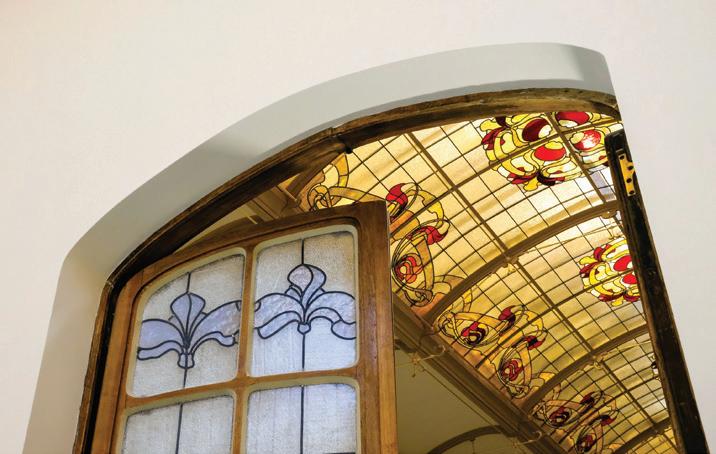
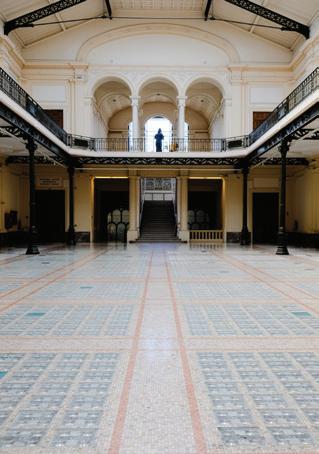
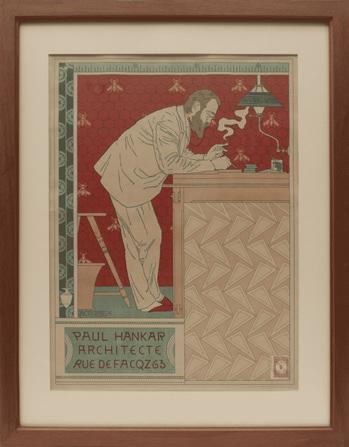
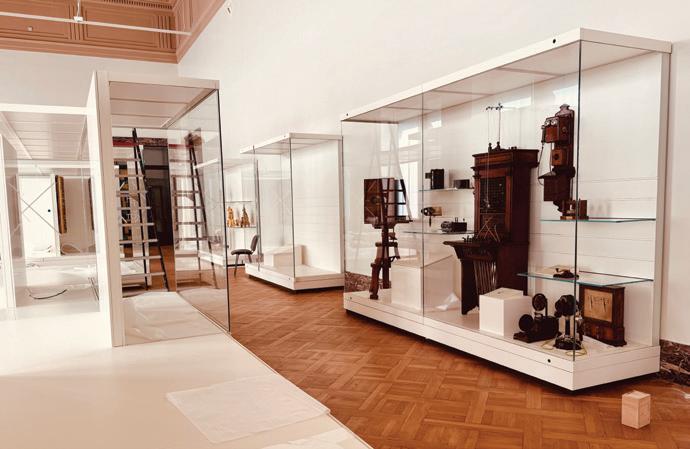
deliberately placed, and never merely for ornamentation. His work reveals a commitment to the idea that beauty and utility could – and should – coexist. That belief would underpin much of 20th century design theory.
Victor Horta, meanwhile, is represented through a sensational reconstruction of the Winter Garden from one of his private houses. The Ghent-born architect trained in Paris and in the studio of Leopold II’s architect before setting up on his own and becoming synonymous with Art Nouveau.
Horta’s interiors combine architecture, furniture, and decoration into unified aesthetic statements that emphasise fluid lines, light, and organic form. Salvaged from demolition, the Winter Garden is an immersive environment allowing visitors to experience the idea of the Gesamtkunstwerk, or total work of art, a central ideal in Art Nouveau.
The Winter Garden was built in 1900 for engineer Jean Cousin. It stood behind a townhouse on Chaussée de Charleroi in Saint-Gilles but was torn down in 1969 through the socalled Brusselisation (Bruxellization in some spellings), the modernist reconstruction of the city, which also put paid to Horta’s Maison du Peuple and Hôtel Aubecq.
Horta’s apprentice managed to save much of the Winter Garden. “It was 2000 that it came to this museum,” says Adriaenssens. “Before that, it was stocked all over the place, things were broken and stolen. We really wanted to rebuild it.”
The reconstruction took six years, with plasterers refashioning original elements, and myriad other details installed or replicated. Hundreds of thousands of pieces had to be fit together like a 3D jigsaw puzzle, with guidance from Horta-specialist architect Barbara Van Der Wee. The resultant nine-by-four metre space has a seven-metre-high glass ceiling
and a bay window framed by columns of gilded bronze. With plenty of gold leaf, the costs required sponsorship from the King Baudouin Foundation, Baillet-Latour Fund, and TotalEnergies Foundation.
Other objects on display include glass by Val Saint-Lambert, jewellery by Philippe Wolfers, and textiles by Constant Montald. Not merely decorative luxuries, these are expressions of a broader cultural ethos – a desire to break from historical imitation and embrace a modern aesthetic rooted in nature, geometry, and symbolism.
A collection of chairs sits beyond the Winter Garden, a mass of seating devices that together represent the hands of the best designers of the time. “Why do we present it like that?” asks Adriaenssens. “It’s like knives and forks and spoons: you eat with them. Chairs: you sit on them. They have to be stable, so you see the styles of the architects.” Among chairs from a hotel in Paris, from the exhibition of 1902, and more, the similarity of the function permits a
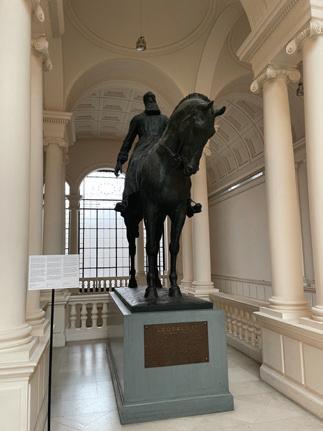
He’s also emphatic that Art Nouveau is not all about Horta – a variety of styles and approaches abounded within the movement.
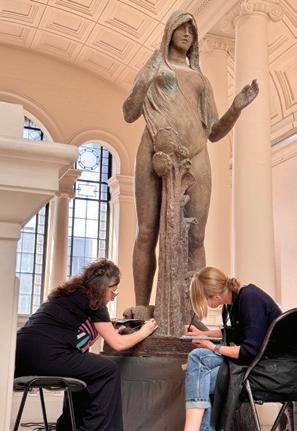

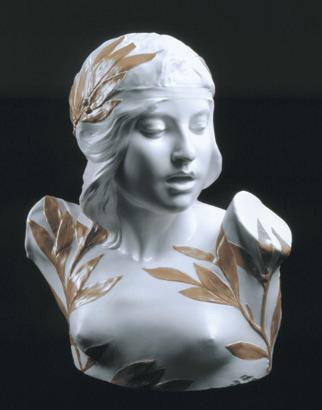
The reconstruction took six years, with plasterers refashioning original elements, and myriad other details installed or replicated. Hundreds of thousands of pieces had to be fit together like a 3D jigsaw puzzle.
pure appreciation of each piece’s individuality.
The gallery documents the movement’s evolution. By the 1910s and 20s, the expressive curves of Art Nouveau gave way to the streamlined elegance of Art Deco. Belgian designers like Antoine Courtens (see article on previous pages) took part in the landmark 1925 Exposition des Arts Décoratifs in Paris (which eventually gave its name to Art Deco), signalling a shift toward more geometric, globally influenced design. African, Islamic, and East Asian motifs entered the Belgian decorative vocabulary, while firms like Val Saint Lambert began to see the commercial importance of getting involved.
Adriaenssens points to the interwar period as one of extraordinary variety: “What you see is a society negotiating modernity – the desire for beauty, functionality, and identity in a changing world.”
One stunning object in this section is a monumental black diamond-shaped plinth, originally designed as a prize in a luxury tombola around 1925. Its rediscovery in a garden, and subsequent acquisition by the museum in 2015, highlights the institution’s ongoing commitment to recovering forgotten treasures.
Encompassing the period from Belgian independence in 1830 to the early years of the 20th century, the other gallery, on Decorative Arts of the 19th Century, explores a time of upheaval and experimentation. Years in the making, thanks to the pandemic interrupting building work, and the long deliberation over which articles to include, the displays in this spell tell a story.
Curator Sophie Balace describes the 500 square-metre gallery as a response to the question: “How do you create a coherent narrative in a century so full of different styles, objects, and influences?” The answer lies in the careful curation of themes, rather than chronology
alone. The gallery is divided into sections that explore style, innovation, craftsmanship, and daily life.
Early in the century, neoclassicism remained dominant, reflecting Enlightenment ideals and a fascination with antiquity. As Balace points out, in the 1830s many craftsmen working hailed still from the previous century. But the old corporations were dying out and new influences were arriving on the scene. For example, she shows the work of a goldsmith who was the son of a farmer – previously unheard of as goldsmiths would have been born into the trade.
“Styles were exploding,” says Balace. Gilded elements proliferate making for a sea of gold, and ornaments adorn every table leg – not to mention the boiler in one of the first bathrooms with heated running water. Gradually, Romanticism, Historicism, and eclectic styles emerged, often blending elements from Gothic, Renaissance, and other historical vocabularies.
Balace is particularly proud of a large clock, imitating the Boulle style of Louis XVII, but much exaggerated. The Louis XVII equivalent would have been smaller, made with exquisite and expensive materials, but the 19th century artisans allowed themselves to go bigger and bolder. She recounts that the family who donated the clock were even convinced it was an 18th century clock and were shocked to discover it was from a hundred years later.
Stylistic diversity was paralleled by transformations in how objects were made: traditional artisanal techniques existed alongside new industrial processes. Balace points out how much of our industry today has its roots in this time and geography. As well as intricately woven Brussels lace, machine-made lace appears at the end of the collection, showing the emergence of fast fashion. From exquisite examples of Brussels porcelain, we progress to printed ceramics. As Balace explains, “Tableware alone tells a story about how we lived, how we gathered, and what we considered beautiful.”
Meanwhile, mass production’s beginnings are revealed through certain pieces. Two papier mâché chairs from England were pressed from moulds, making their fabrication less time and cost-intensive. Along with items like printed ceramics, these point to the Industrial Revolution’s impact on everyday life. This was also a time when electricity, photography and gas lighting were reshaping the domestic sphere.
Belgium’s rapid industrialisation made it one of Europe’s manufacturing powerhouses, and its access to colonial raw materials shaped both what was produced and how. New tensions arose between handcraft and industry, which would become central to later design debates. The long furniture catwalk of the room concludes with the first glimmerings of art nouveau, as a reaction to the gilded gaudiness of previous styles.
Some standout pieces in the Art Nouveau & Art Deco Gallery
1. The Cousin Winter Garden (Victor Horta, 1900)
A showstopper, this reconstructed architectural gem once graced the home of engineer Jean Cousin in Saint-Gilles (now an anonymous apartment block and a Brico City). With gilded steel columns, stained glass windows, mosaic floors, and a marble fireplace, it embodies Horta’s vision of a Gesamtkunstwerk – a total work of art. The only surviving reconstruction of a Horta building.
2. L’Art Décoratif (Pieter Braecke, 1925)
Created for the Belgian pavilion at the 1925 Paris Exposition by Pierre Braecke, this monumental sculpture of a semi-naked woman once crowned the entrance. With its bold sunflowers symbolising the post-war rebirth of decorative arts, it was awarded the expo’s Grand Prix, its highest distinction – and now makes its public return after its rediscovery in the museum workshop. It is now on the firstfloor landing of the gallery, replacing the previous figure in that space, a replica of the Leopold II on horseback statue that is outside the Royal Palace.
3. Pair of Candelabras (Henry van de Velde, 1898–99)
Designed in silvered bronze, these elegant and functional objects reflect Van de Velde’s commitment to uniting utility and aesthetic purity. They exemplify the streamlined yet expressive ethos of Belgian Art Nouveau.
4. Sphinx Mystérieux (Charles Van der Stappen, 1897)
This enigmatic sculpture in ivory, silver, and onyx captures the Symbolist undercurrents of late 19th century design. Purchased by the museum the same year it was made, it’s a striking fusion of mystery and luxury.
5. Daphné (Isidore de Rudder, ca. 1895)
A collaboration with the Vermeren-Coché ceramic workshop, this part-glazed ceramic figure references classical mythology through a distinctly modern lens. With flowing lines and a subtle finish, it bridges fine and decorative art.
In a way, the museum is itself a product of the period that the new galleries explore. Housed in Cinquantenaire Park, it occupies one of Brussels’ most iconic 19th century cultural buildings. The structure was conceived as part of Leopold II’s bombastic vision to commemorate Belgium’s 50th anniversary of independence in 1880. The grand exhibition halls were meant not only to celebrate national achievement but also to project Belgium’s modern identity on an international stage.
The museum building as we know it today was largely developed between 1880 and the 1920s, part of a wider movement to establish encyclopaedic museums that would catalogue the material cultures of the world. Its purpose was both educational and ideological: to present human civilisation through objects, with a special focus on Belgium’s place within that narrative. This reflected the 19 th-century belief in progress, categorisation, and the museum as a tool of public enlightenment. The renewed focus on Belgian decorative arts signals a deliberate shift inward – toward examining the nation’s own legacy of design and everyday life. The institution’s original mission has come full circle.
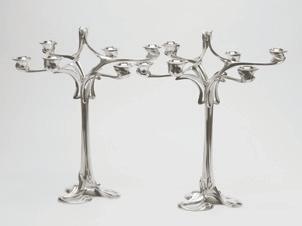
How do you create a coherent narrative in a century so full of different styles, objects, and influences?
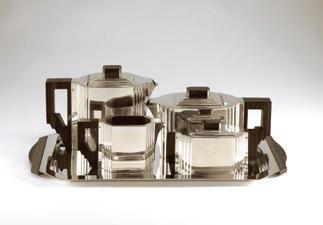
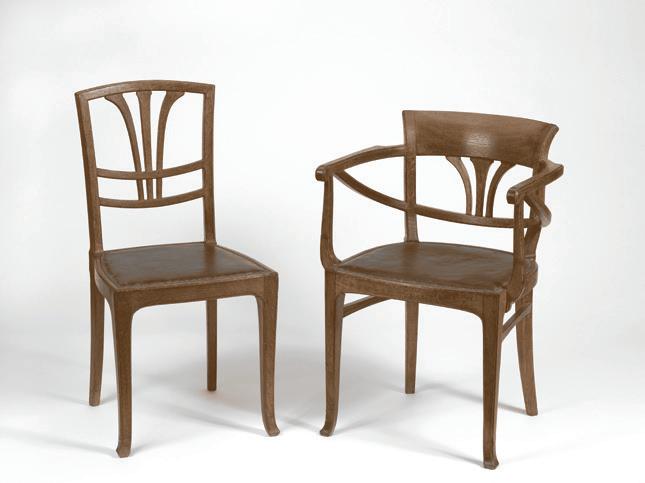
The Museum of the Royal Library of Belgium (KBR) in Brussels has reopened with a striking new focus on the Franco-Flemish polyphonists — masters of Renaissance vocal music whose influence once echoed across Europe. Simon Taylor finds out how the museum brings their world to life, blending manuscripts, history, and sound to celebrate Belgium’s rich and often overlooked musical Golden Age
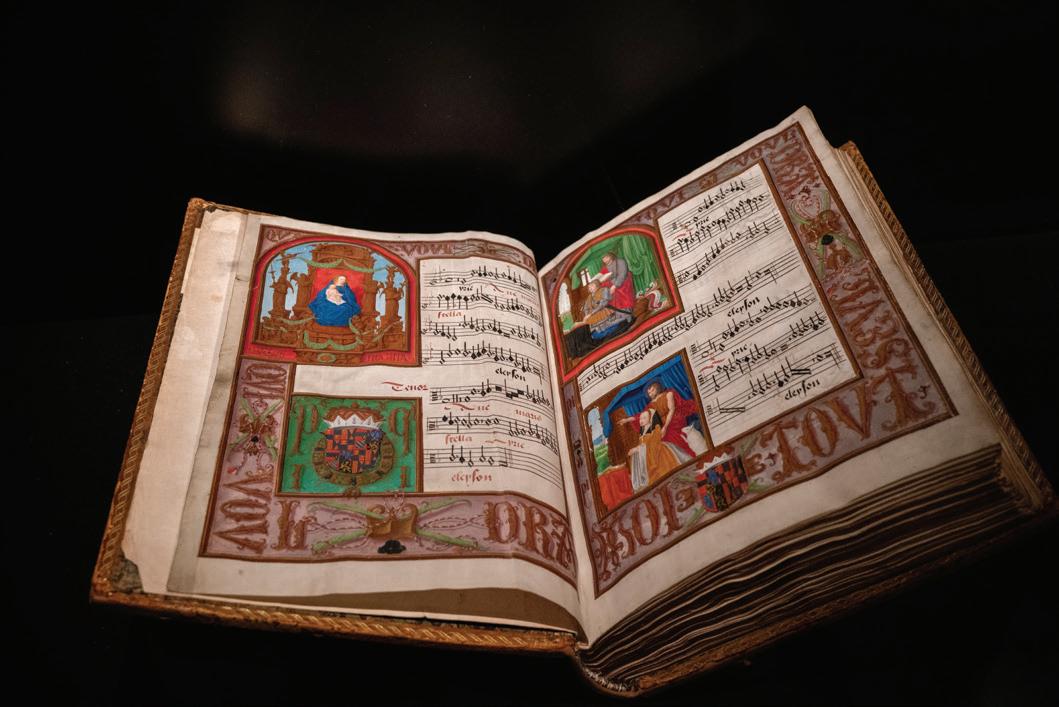
At the heart of the new exhibition lies the FrancoFlemish school of polyphonists: singers, composers, and choirmasters whose intricate vocal works transformed sacred music across Europe in the 15th and 16th centuries.
Many Brussels residents know that their city has medieval roots, but far fewer are aware of the richness of the cultural life that once flourished here. We now have a chance to learn more about what is known as the Golden Age after the Museum of the Royal Library of Belgium (KBR), which boasts a remarkable manuscripts collection from the Dukes of Burgundy, re-opened its doors after 15 months of renovation. The museum — housed within the modernist Royal Library on the Mont des Arts — also casts a spotlight on one of Belgium’s most enduring cultural legacies: its extraordinary contribution to European music, and, in particular, to the rise of Renaissance polyphony.
At the heart of the new exhibition lies the Franco-Flemish school of polyphonists: singers, composers, and choirmasters whose intricate vocal works transformed sacred music across Europe in the 15th and 16th centuries. These were
artists of great ambition and technical mastery, working under the generous patronage of the Dukes of Burgundy.
To modern ears, it may seem curious to elevate polyphonic music — simply, music with multiple independent vocal lines — as a revolutionary artistic development. But in the 1500s, the prevailing soundscape of church music was austere: Gregorian chant, sung in unison by a solo male voice. At the time, the Church and pious nobles preferred that form of singing because they believed that listeners would focus on the religious words and not be distracted from divine contemplation by harmonies or other embellishments.
The emergence of polyphony was not just a musical evolution, but a cultural shift, requiring greater artistic skill, larger ensembles, and, not least, patrons willing to support both.
The Dukes of Burgundy were just such patrons. Their wealth and territorial reach — from Picardy in northern France to parts of the mod-
Simon Taylor
ern Netherlands and Burgundy itself — enabled them to nurture a cultural ecosystem in which music, art, and literature could flourish.
Philip the Bold (Philippe le Hardi), who ruled until 1404, was an avid book collector and laid the foundations for what would become the ducal library. He would eventually hand down the library to his heirs, including his grandson Philip the Good (Philippe Le Bon), who lived from 1396 to 1467. Over 300 of these manuscripts are in the Royal Library today.
Polyphony found perhaps its greatest champion in Margaret of Austria, daughter of Mary of Burgundy and Philip the Good. Born in Brussels, in the Coudenburg Palace, Margaret transformed her residence in Mechelen into a musical court of European stature. She directly employed composers such as Pierre de la Rue and took an active interest in preserving and expanding the family's rich trove of books and artworks.
What later became Belgium was part of what was known as the Southern Netherlands, part of the Low Countries. The region later became part of the Spanish Netherlands when it came under the rule of the Spanish branch of the Habsburgs from 1556 to 1714.
The area is known for its contribution to the visual arts, especially the Flemish Primitives and artists such as Jan van Eyck, who painted the Ghent Altarpiece which adorns the altarpiece in the city’s St Bavo’s cathedral, and Hans Memling, who lived in Bruges. The Chapel of Nassau, which is part of the museum in the Royal Library, contains two of the earliest copies of van Eyck’s Altarpiece.
One of the new exhibits in the museum gives visitors the chance to listen to a piece of polyphonic music written for Margaret. An array of sliders allows visitors to control the level of different male and female voices by fading them up and down. Doing this gives visitors a sense of how polyphonic music was composed and performed.
The display traces five generations of Franco-Flemish polyphonists. Though many began
their careers in the Low Countries, their reputations quickly spread to churches and courts in Italy and Germany. Manuscript copying helped disseminate their work throughout Europe, establishing the Franco-Flemish style as the dominant musical idiom of its time.
The journey begins with Guillaume Du Fay, who lived and worked at Cambrai Cathedral as well as in Bologna. Rome and Florence. The next generation is represented by Johannes Ockeghem, who was a vicar and singer at Antwerp’s Onze-Lieve-Vrouwe (Our Lady) cathedral. The third includes Jacob Obrecht, who died in Ferrara, Italy, after spending most of his career in Bruges and other parts of the Low Countries. From the fourth generation, Adriaan Willaert from west Flanders worked as a chapel master in Venice at St Mark’s Basilica. For the fifth, Orlandus Lassus started his career in Antwerp before moving to Munich in southern Germany where he worked in the court chapel of Duke Albrecht V.
The exhibits also showcase the work of Josquin des Prez, known as the “prince of polyphony” because manuscripts of his work were spread all over Europe. The first edition of his masses was the first printed music book dedicated to a single composer.
The renewed KBR exhibition brings all this vividly to life. With its focus on the Franco-Flemish polyphonists, it not only celebrates an essential chapter in Belgium’s cultural history but reaffirms the country’s historic place at the heart of Europe’s musical imagination. The museum’s holdings, including 80 exquisitely illuminated manuscripts from the 15th and 16th centuries, now resonate with sound as well as sight—allowing visitors to hear, quite literally, the voices of the past.
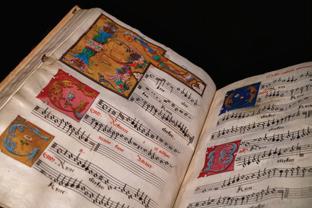
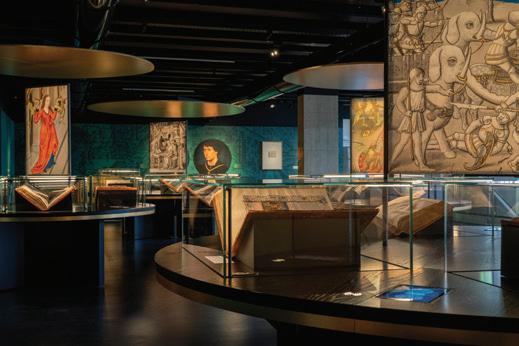
With its focus on the Franco-Flemish polyphonists, it not only celebrates an essential chapter in Belgium’s cultural history but reaffirms the country’s historic place at the heart of Europe’s musical imagination.
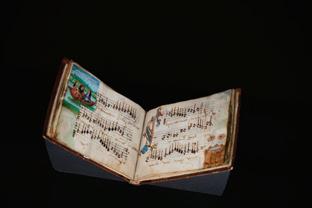


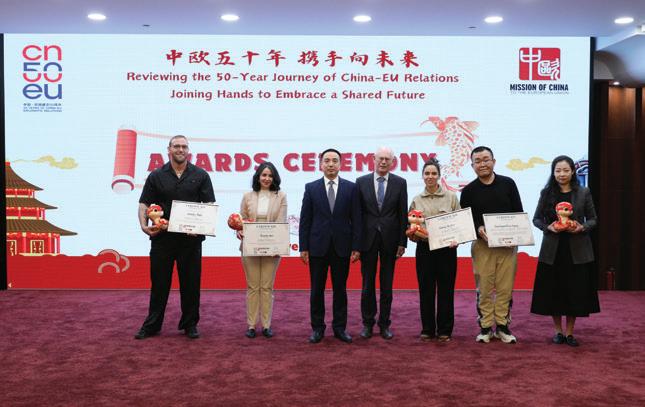
Over the past 50 years, China-EU relations have withstood the test of international vicissitudes and continued to make steady progress.
Your Excellency Mr. Herman Van Rompuy, Ladies and Gentlemen, Friends,
Good afternoon! Welcome to the awards ceremony of the “Reviewing the 50-Year Journey of China-EU Relations, Joining Hands to Embrace a Shared Future” creative contest. First of all, on behalf of the Chinese Mission to the EU, I would like to express my heartfelt gratitude to all the participants and judges from both Chinese and European sides for their contributions to the successful hosting of the contest. I also extend my sincere thanks to His Excellency Mr. Van Rompuy, former President of the European Council, and all the friends who have long cared for and supported China-EU relations.
Now is the season when spring fills the earth and all things are full of vitality. In just a few days, on May 6th, we will celebrate the 50th anniversary of the establishment of diplomatic relations between China and the EU. At this important juncture where the two sides take stock of the past and look into the future, we hold this creative contest, hoping that every one of you can join the celebration of the 50th anniversary of China-EU diplomatic relations through your hard work and inspiration-filled
works, to deepen mutual understanding between the peoples and promote the sound and steady growth of China-EU relations.
Ladies and Gentlemen, Friends,
Fifty years ago, the older generations of Chinese and European leaders, with their extraordinary political courage, broke through the Cold War barriers and made the decision to establish diplomatic relations. Over the past 50 years, China-EU relations have withstood the test of international vicissitudes and continued to make steady progress. They have not only achieved mutual success but also lighted up the whole world. China-Europe cooperation has played an important role in improving the well-being of people on both sides.
China and the EU are important trading partners with deeply intertwined economies. European car brands such as Mercedes-Benz, BMW, and Volvo are well-known in China, and French wine, Belgian chocolate, and Spanish ham are increasingly finding their way onto the tables of Chinese people. For European people, “Made in China” is an indispensable part of life, and Chinese cuisine is favored by many Europeans. China- Europe cooperation has played an important role in promoting global sustainable development. China and the EU have shared concepts and complementary comparative strengths in green and low-carbon development, and seen fruitful cooperation in this regard. The Chinese new energy vehicles running on European roads are a vivid example of the mutually beneficial cooperation.
China and the EU have actively promoted the effective implementation of the Paris Agreement, worked together to improve the global climate governance system, and jointly promoted green, low-carbon, and sustainable development for the benefit of all mankind. China- Europe cooperation has played an important role in maintaining world peace and stability. Both China and the EU are staunch advocates of multilateralism, and they have jointly promoted the resolution of international and regional hotspot issues and maintained close communication and coordination on ma-
jor issues concerning the future of humanity. In this world full of changes and turbulence, China stands ready to join hands with Europe to inject certainty into the world with the stability of China-EU relations.
Ladies and Gentlemen, Friends,
The key to sound state-to-state relations lies in close bonds between peoples. Looking back on the development of China-EU relations, we see friendship between the peoples enhanced through cultural exchanges. The works of European literary giants such as Hugo, Goethe, and Shakespeare are widely circulated in China. Meanwhile, China's Four Great Classical Novels are very popular among European readers, and the science fiction masterpiece “The Three-Body Problem” has swept through European book fairs. It is even more gratifying that the younger generation of China and Europe generally have friendly sentiments towards each other. In China, a great many of children know the stories of Manneken Pis, Tintin, and the Smurfs.
European landmarks such as the Eiffel Tower and the Rome Colosseum are the must-visit places for many Chinese children’s first overseas trips, and European universities are among the top choices for many Chinese college students. At the same time, China’s splendid history and culture have also deeply attracted the younger generation of Europe. Not long ago, we celebrated the Chinese New Year with European friends at the Brussels Bright Festival. Traditional Chinese cultural activities such as tea art performances and lantern riddles were very popular among young people, and I was also very pleased to see that the giant pandas are treated like stars in the Pairi Daiza Zoo in Belgium. What also amaze me is that
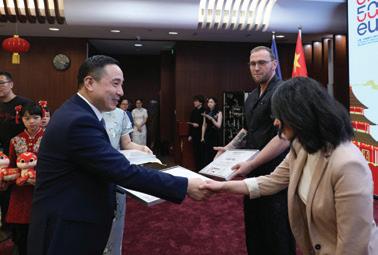
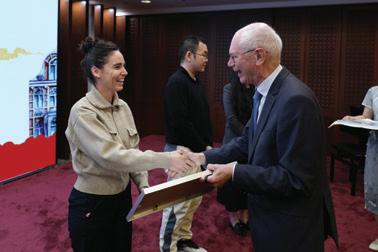
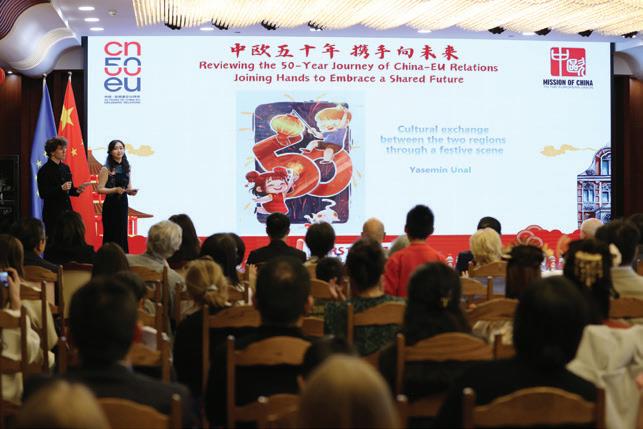
an increasing number of young Europeans are very keen to learn the Chinese language. At present, people-to-people exchanges between China and Europe are advancing with unprecedented breadth and depth. Last year, during his trip to Europe, President Xi Jinping proposed the initiative of “increasing the number of French students studying in China to over 10,000 and doubling the scale of European youth exchanges within the next three years.” This initiative is being steadily implemented. With the successive introduction of China's unilateral visa-free policy for 24 EU member states and the facilitation of payment, accommodation, transportation, and other inbound tourism services, traveling to China has become increasingly convenient, you can go on a spontaneous trip any time you want. I hope that European friends from all walks of life will take advantage of China’s policy dividends, travel more in China, observe China with your own eyes and experiences, and understand China with independent thinking. I’m sure you will see a real China, a China that is warm and friendly, open and inclusive, diverse and full of vitality.
Ladies and Gentlemen, Friends,
There are winners and losers in competitions, but there is no distinction in the contributions to China-Europe friendship. On the journey of carrying forward friendship, every effort is immensely precious, and every act of kindness shines brightly. This creative contest is just a beginning. On our shared journey, there will be many more wonderful experiences. I look forward that all of you will take the celebration of the 50th anniversary as a new starting point, continue to be supporters, participants, and contributors to China-Europe friendship, and make your contributions to a better future for China-EU relations.
Thank you all.
In this world full of changes and turbulence, China stands ready to join hands with Europe to inject certainty into the world.
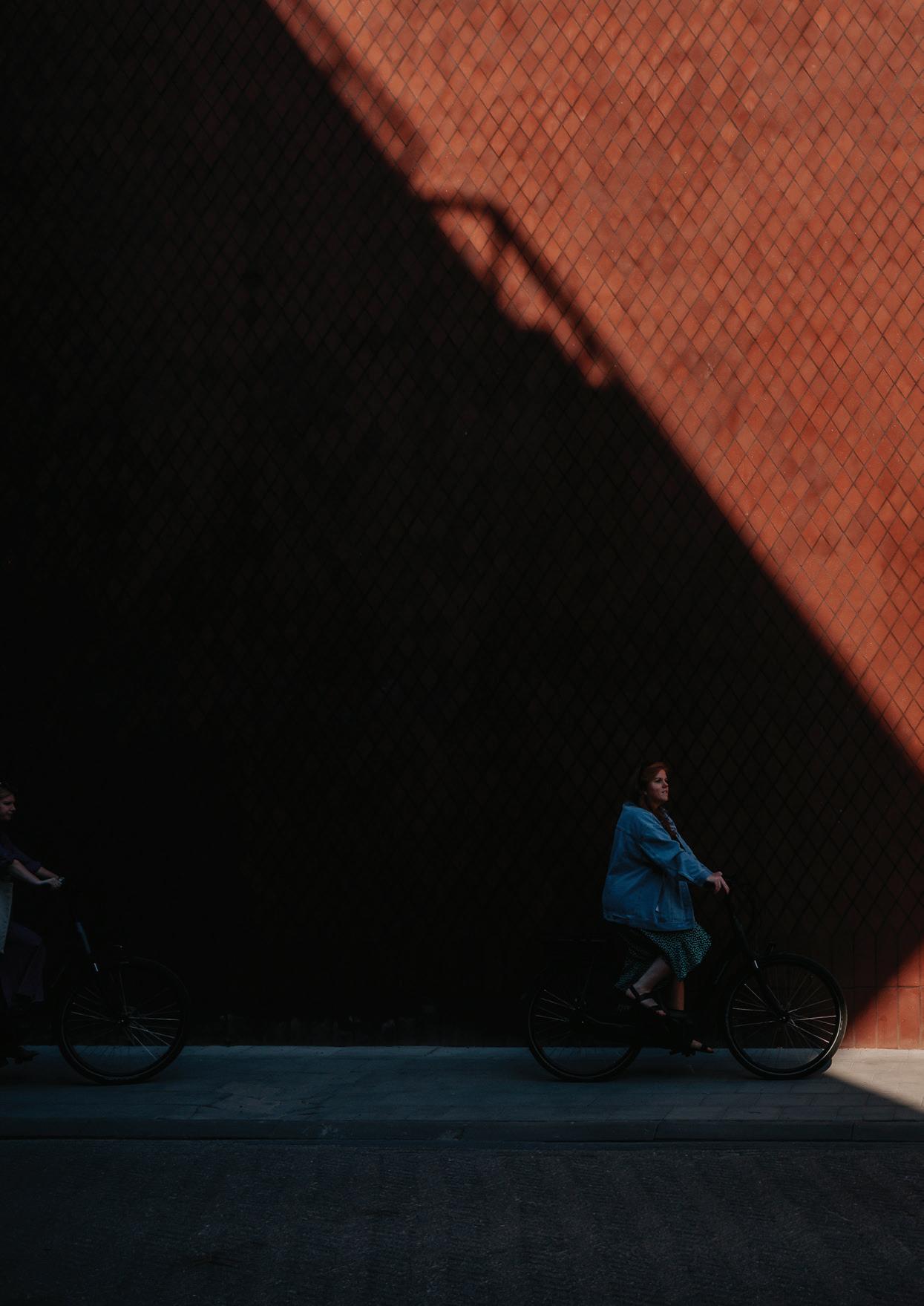
A vibrant city on the Albert Canal, Hasselt serves up gastronomy, fashion, street art and unique boutiques. It also has surprising green spaces, including the largest Japanese garden in Europe. Angela Dansby reports on a weekend in what locals claim is the “capital of taste”
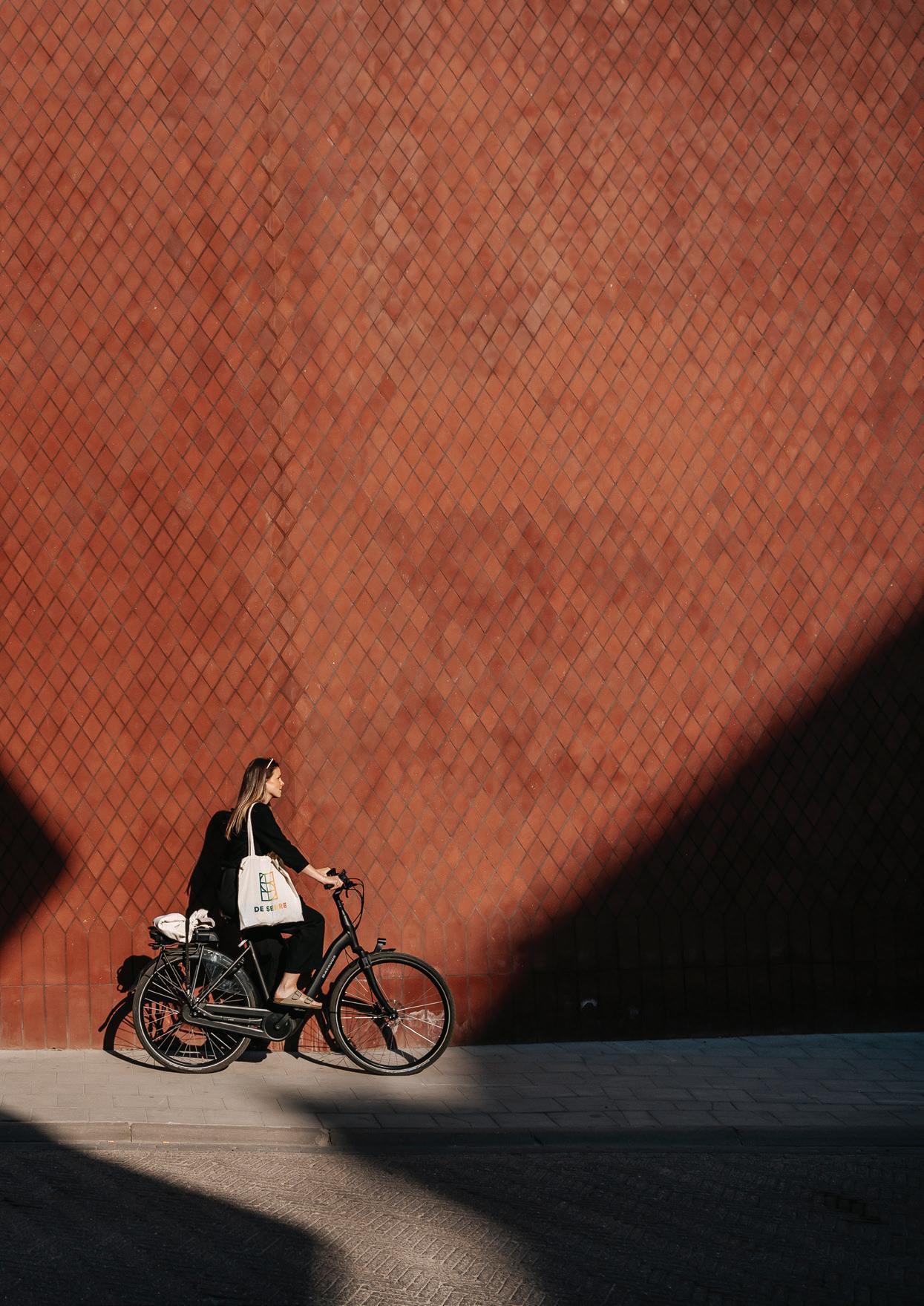
Angela Dansby
A bronze statue of a man holds an ossakop (“head of an ox”)-sized barrel (268 litres) on his shoulder and a glass in his hand, sitting atop a cow surrounded by pigs.
Hasselt is where ancient history and modern flair intertwine. It is one of Belgium’s oldest cities, dating back to the 7th century, and among its most fashionable, with a rich textile history and thriving scene featuring Belgian designers.
Located in northeastern Flanders, just 3km from the Dutch border, Hasselt also charms visitors with walkable streets and flourishing culinary, art and cultural sectors. Green oases abound, while unique annual events animate the city’s calendar.
The city emblem is a hazelnut with an “H” in the middle of it, standing for Hasselt, hasaluth meaning hazel and the Helbeek tributary which lies underneath (piped since the 1950s to stop water from coming into the streets). The hazelnut shape cherishes the city’s ancient past when hazel plants grew in the area until the 8th century. A footpath of bronze emblems marks a Historische Stadswandeling (Historic City Walk).
Visit Hasselt makes exploration easy with this and other routes of about 5km each, includ-
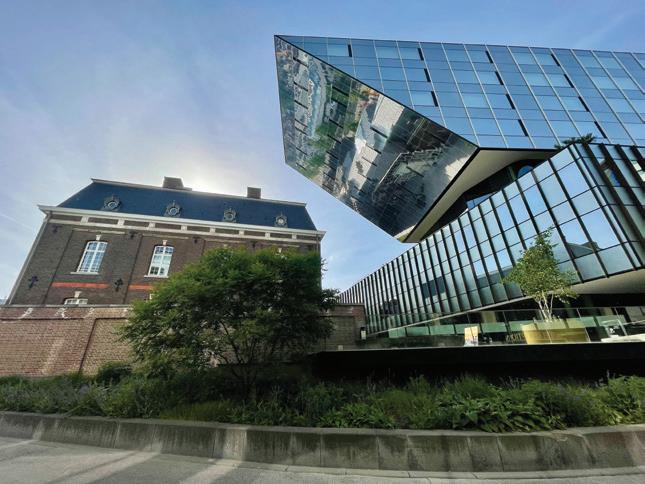

ing Smaakmaker Spraakmaker (Tastemaker Speechmaker) with city highlights, Kunst (Art) Route and Muziek (Music) Tour. An accompanying Smaakmaker Spraakmaker guide is available for €3 in multiple languages.
A convenient ring road encircles Hasselt, where a big wall once stood to protect the city until Belgian independence in 1830. Hasselt was heavily bombed during World War II when the Germans occupied its train station, so much of that neighbourhood was rebuilt. While on a smaller scale, Hasselt strives to be as fashionable as Antwerp with traditions and creativity that invite exploration at every turn.
Frequent, direct trains go from Brussels to Hasselt in about an hour. Driving is the same amount of time and good value parking (€10 per day) is available underneath Blauwe (Blue) Boulevard.
Since the Middle Ages, Hasselt has been cut from fashionable cloth as it was internationally known for textiles and weavers. In the early 16th century, its textile industry employed about onefifth of its population. Competition led to the industry’s decline decades later, and by the late 19th century, Hasselt reinvented itself as a trade and shopping hub, with new boutiques specialising in fabrics, accessories and custom tailoring.
The Modemuseum Hasselt, the first (1988) fashion museum in the Benelux, has an extensive collection of Western clothing and accessories from 1750 to today. Its current temporary exhibition, running until February 22, 2026, the exhibition “Rococo Reboot!” displays fashions from 1750 to 1830 alongside modern interpretations, including designs by Belgian fashion icons Dries Van Noten and Raf Simons. The museum is housed in a Mosan-style building from 1664, retrofitted with a modern, vertical entrance and glass roof.
Hasselt is fashion-forward elsewhere with many unique boutiques, several of which feature Belgian designers, particularly on Kapelstraat, Aldestraat, Dokter Willemsstraat, Dorpsstraat and Maastrichterstraat (the latter street also has antique shop signs with ornate frames complete with a dangling figurine). Unlike most of Belgium, Hasselt has shopping Sundays the first of each month and throughout December.
Huis (House) Reekmans has been making hats since 1904, the oldest business in Hasselt, and its former shop has a window display about hat-making. Galerie Multiple features exhibitions of jewellery designers, some of whom studied the craft at the Hasselt PXL-MAD School of Arts.
Jenever is a juniper berry-flavoured spirit originating in the Low Countries with roots in Hasselt. Made in Belgium for over 500 years, it is a
precursor to gin, which was created about two centuries later in England (British fighting in the Low Countries during the Napoleonic wars liked jenever so much that they created their own version of it back home). As an EU and UK Protected Geographical Indication (PGI), the name jenever can only be used on products made by traditional methods.
While jenever and gin are both distilled with juniper berries, they differ in raw liquids. Jenever is made from at least 1.5% malt wine – a distillate of malted grains such as barley, rye and corn – and gin from grain alcohol.
During the Industrial Revolution, Hasselt jenever accounted for 15% of Belgian alcohol production. It had 75 jenever-related businesses and sourced juniper berries that grew in the region. Jenever was initially valued for medicinal properties before becoming a social drink. People drank so much of it that after World War I, strict laws were passed to limit its production and consumption. These laws remained in force until 1984 (stimulating smuggling with the Netherlands and illegal distillation), after which jenever revived.
Today, only one traditional jenever distillery, Fryns, remains in Hasselt but there are a handful of newer artisanal producers. All must use local malt wine to call their products Hasselt Jenever. Fryns and Smeets (though now distilled in Ghent) are the largest producers.
The Jenevermuseum in an old jenever factory covers the evolution of the spirit from its invention in 1552. A tasting room in former ox stables has a wide range of jenevers and related elixirs, including several made by the museum, such as mandarin-flavoured Goudwater elixir with gold flakes. One tasting is included with a museum ticket.
The lively Jeneverfeesten festival each third weekend of October celebrates the city’s jenever heritage with music, dance, street theatre, a waiter's race. It also features jenever flowing from the Borrelman (Drinkman) fountain, where a bronze statue of a man holds an ossakop (“head of an ox”)-sized barrel (268 litres) on his shoulder and a glass in his hand, sitting atop a cow surrounded by pigs. Cattle used to be fed spent grain from jenever distillation and the ossakop was the traditional jenever barrel size (hence, Hasselt people are called Ossakopen). A bronze Borrelvrouw (Drinkwoman) statue in front of Visit Hasselt represents the traditional hospitality of a Hasselt woman welcoming visitors with jenever shots.
The self-styled “capital of taste” is full of culinary surprises from its food and drink specialities to 36 Gault-Millau and three Michelin-starred restaurants. Italian restaurants dominate due to immigrants arriving in the 1960s to work in the area’s mines. Hasselt even calls itself the “vegan capital of Belgium” as five of its eateries won
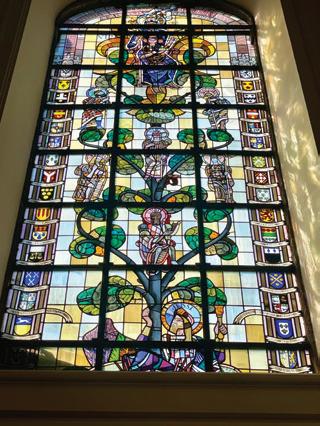
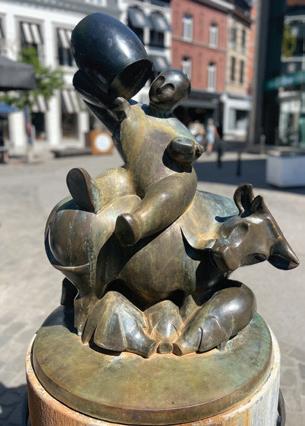
prizes at the Belgian Vegan Awards.
The city’s own speculaas is similar to Belgian speculoos but thicker, soft inside and with more cinnamon as well as crushed hazelnuts and almonds (it also used to be made with sugar leftover from jenever distillation). Only Hasselt bakers DePaifve, Cools and Bakkersdochter are certified to make it. Bakkersdochter also offers speculaas-making workshops. The sculpture Het Speculaasmannetje (The Speculaas Man) pays homage to this made-in-Hasselt specialty.
The Limburgse vlaai (Limburg pie), a small tart with a filling from local fruits like apricot or cherry, has EU-protected designation (PGI). Hasselt coffee is a strong drink made of coffee extract and Hasselt jenever. The city also has paté made with hazelnuts and jenever.
Boon Chocolatier creates fashionable chocolates, and makes the Hasselt Praline with a hazelnut-speculaas-juniper berry filling and Vlaai Pralines, chocolate wedges with pie fillings formed in a circle. Boon Academy offers chocolate-making workshops for groups.
Local beers are made at the microbrewery Hop Hemel, Herkenrode Abbey and the artisanal Jessenhofke Brewery, which offers a guided tour and tasting.
The newish Blauwe (Blue) Boulevard along the basin of the Albert Canal, as well as the Zuivelmarkt, Grote Markt, Fruitmarkt and Kolonel Dusartplein are all trendy areas to have a drink or bite, especially when terraces are open. Hidden gems are Kadettensteegje, a courtyard accessed by three alleys, and Walputsteeg corridor, which has two restaurants (Kouzina and Orangerie). The former, called The Alleys, leads to a pop-up bar that changes seasonally. For example, springtime features The Blossom Alley and winter The Christmas Alley.
Hasselt also celebrates gastronomy in several annual festivals featuring world foods (Amuse), local restaurants (Culinaire Ring and Hasselt à la Carte) and food trucks.
The Hasselt Taste Package, sold at Visit Has-
The selfstyled “capital of taste” is full of culinary surprises from its food and drink specialities to 36 GaultMillau and three Michelin-starred restaurants.
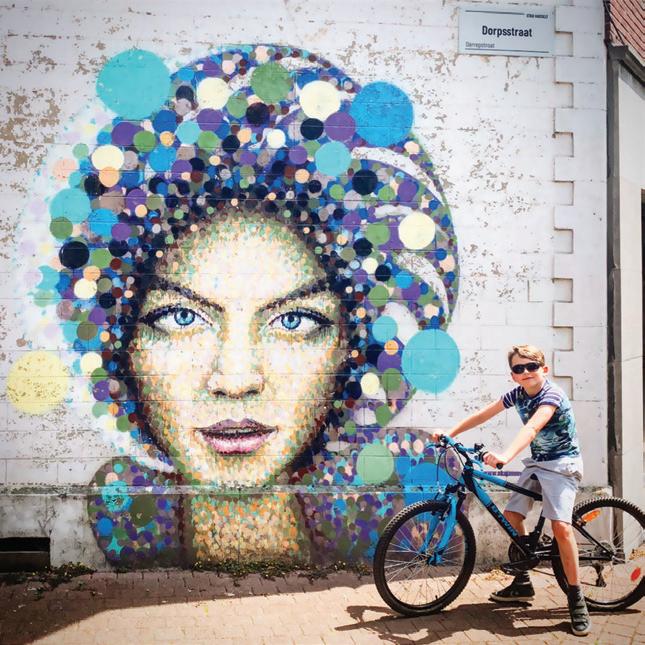
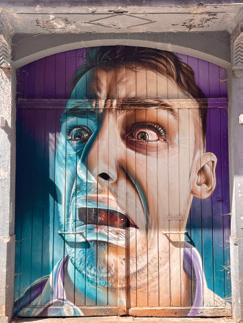
Hasselt even calls itself the “vegan capital of Belgium” as five of its eateries won prizes at the Belgian Vegan Awards.
selt for €10, contains Hasselt pralines, speculaas, juniper berries, apple juice and a cycling route. It must be pre-ordered at least two workdays in advance.
The Z33 House for Contemporary Art, Design and Architecture, on the former beguinage site of Hasselt, is currently running The Wet Wing, an exhibition of floor-to-ceiling silk paintings, hand-carved sculptures and ceramic jars with an oceanic theme. The tiny Paardsdemer Chapel, dating to 1530, was relocated within Hasselt to the front of Z33.
Het Kunstuur (The Art Hour) in the Brutalist-style former city hall presents Belgian paintings from 1850 to 1950 with storytelling, including narration by Flemish celebrities. The next edition will be as of September 20.
‘t Scheep, Hasselt’s new city hall with a striking mirrored overhang, was built in 2018 as one of the most energy-efficient buildings in Flanders. It sits behind former gendarmerie barracks to which it contrasts with geometric layers of glass and mirrors. Inside is a notable charcoal drawing by contemporary Belgian artist Rinus Van de Velde.
Hasselt has about 200 street art murals by global artists who add annually to its collection. The city was the first in Belgium to make space for street artists in the 1990s. Visit Hasselt maps and Street Art Cities’ website and app
reveal where they are. Great examples are on Dorpsstraat and Schrijnwekersstraat streets, the city’s skatepark and on “legal walls” near the University of Hasselt (UHasselt). Don’t miss the giant owl on an old malt tower on Vaartstraat by the artist known as Roa; the temporary street art wall in front of Visit Hasselt, which changes four times a year; and the largest mural of all in Capuchin Square facing the tourism office.
Sculptures are also abundant in public spaces, such as Hendrik & Katrien sitting on a bench in the Grote Markt; Het Mona Lisa Tafereel at PXL University College, a modern, comical twist on the famous painting; Zen giant theatrical mask across from Kolonel Dusartplein; Sculptuur 't spikklaasvreuke of a thin woman eating speculaas facing the Walputsteeg; city charterer (1232) Arnold IV Graaf Van Loon on a horse in the Fruitmarkt; and Dr. Louis Willems, a pioneer of bacteriology and immunology, near the Jenevermuseum. Other public artworks are by Belgian artists like Panamarenko and Piet Stockmans. Molenpoortplein has a long, artistic fountain that’s activated May-October.
CCHA features photography and videography in at least nine exhibitions a year and Villa Verbeelding displays books and illustrations.
Decorative ceramic tiles on the facades of several houses “dressed up” Hasselt during the industry’s heyday from 1880 to 1950 (Portuguese ceramicists went there to learn how to winterise tiles). Jenever manufacturers inspired the industry by having ceramic plates made with their logo to give to clients. The art installation Het Waterpad in the Grote Markt is composed of 350 ceramic tiles in the ground.
Kunstmarkt Montmartre, a small art market featuring local works, is on Capucienenplein every Saturday afternoon from mid-July through August. Art market Boulev'Art two Sunday afternoons in September is similar. From April to October, an antique and curio market is on Kolonel Dusartplein every Saturday morning. Hasselt also has several art galleries.
Moreover, Hasselt boasts that it is a music city with one of Belgium’s largest annual music festivals (Pukkelpop), several concert venues, pop and rock school PXL Music and Spotify playlists curated by locals. De Serre and Café Café are well-known music venues. A nightclub, Versuz, just closed its doors for transformation into a cultural centre. Gigaswing and Just for the Record shops offer new and second-hand vinyl records, respectively. The latter also doubles as a café and rotating art exhibition space. Visit Hasselt’s MuziekTour walk, set to music, takes visitors to most of these places. Limburgers, known for “singing” when speaking due to lilting intonation, complement the music scene.
Het Stadsmus (The City Museum) covers the history of Hasselt and contains rare relics, including the world’s oldest known monstrance
(receptacle for the wafer representing the body of Christ) from 1286, golden crowns, a silver linen baby Jesus dress linked to a miracle, a 5,000-year-old large stone and an early 14th century illuminated manuscript. The museum also has contemporary works by regional artists and a hidden garden.
The Virga Jesse Basilica contains the 14th century Gothic statue of Maria Virga Jesse, which locals carry through city streets during the Virga Jesse Festival every seven years (next in 2031), a tradition upheld since 1682! The basilica is the third built in the same place, most recently after a misplaced bomb hit it in 1944. The striking church interior has a black and white checkered floor, ornate wooden pulpits, magnificent tomb sculptures and stained-glass windows depicting a tree as the outgrowth of Jesse.
The Neo-Gothic St Quentin Cathedral, with roots in the 8th century, is Hasselt’s largest church. Its Carillon tower chimes every hour and offers visitors a climb of 168 steps to panoramic views as well as information about bells and clocks. The cathedral contains two large monstrances – one containing a 13th-century, bacteria-stained wafer (once thought to be the “blood of Christ”) and another behind it with a modern wafer – as well as a statue of St Brigitte, relics of St Ursula, and a 16th cenutry brass bible stand shaped like an eagle with a bat (the devil) on top for placing the holy book.
The old Begijnhof (beguinage) includes a tower under construction to replace one accidentally bombed by Allied forces in World War II, church (now Z33), gatehouse, garden and 13 dwellings. As of September 2026, visitors can climb the tower for panoramic views.
The Minderbroederskerk (Order of Friars Minor) contains the tomb of Het Heilig Paterke (The Holy Father) Valentinus Paquay, who was famous for prophecy.
The Grote Markt is a former corn market that includes Het Sweert, a Mosan-style timber building with Xs on it dating to the 14th century. An old copper rose tops the Nespresso building across from it. Nearby on Kapelstraat is another Mosan-style building with an alley that leads to 16th century windows and renovated shutters.
UHasselt’s law school incorporates an Old Prison, where students study in renovated prison cells, and the Refugiehuis, a former soldier refuge where the Rectorate of UHasselt now sits.
The Paardenjaarmarkt (Hasselt Horse Fair) has been an annual tradition since 1242, making it one of the oldest events of its kind in Belgium. In March, the Prinsenhof area in Kuringen, a district of Hasselt, is transformed into a medieval festival that includes historical reenactments.
The Hasselt area is a walking and cycling paradise. Notably, it has the largest Japanese Garden in Europe thanks to a sister
city in Itami, Japan. This garden has a waterfall, large gong, ponds, koi fish, little bridges and abundant cherry trees. Every spring there is a Hanami Cherry Blossom Festival and each October a Kikumatsuri Chrysanthemum Festival.
The Abbey of Herkenrode in a former textile plant has centuries-old buildings, some from the 12th century, restored and repurposed amidst a green paradise of 100 hectares. Cistercian nuns who once lived there transformed Herkenrode into one of the wealthiest abbeys of its time – as explained in the Experience Centre in the former stables and coach house. Behind is the large Herb and Inspiration Garden. Herkenrode has four mapped nature routes (1km to 9.2km) and bicycles for rent. Bus 51 at the Hasselt train station goes to the road leading to the abbey, about a 15-minute walk away.
In the works at Herkenrode is the art installation Clausura, a spatial memory of a 1740 abbey church outlined in thin steel rods. Scheduled for completion by the end of 2026, for the 200th anniversary of the original church’s destruction, it’s the big brother of Reading Between the Lines, a see-through church made of stacked steel plates by the same designer, Gijs Van Vaerenbergh.
Herkenrode is the gateway to De Wijers nature reserve, nicknamed Land of 1001 Ponds. Nearby Domein Kiewiet Nature Reserve of 130 hectares has five different types of gardens as well as boardwalk trails from 1.5km to 12km. Other great green spaces are the renovated Kapermolenpark, peaceful Mombeek Valley, Tommelen nature reserve with 110 pools and Nietelbroeken bluegrass meadows with boardwalks.
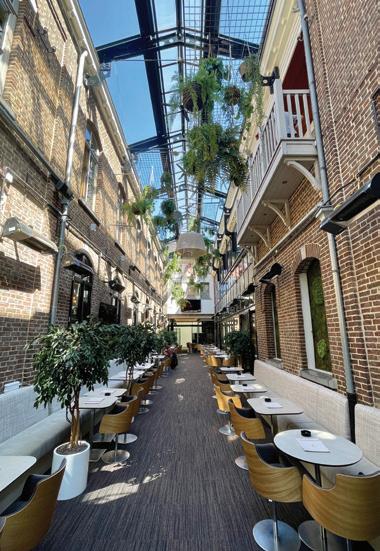
Decorative ceramic tiles on the facades of several houses “dressed up” Hasselt during the industry’s heyday from 1880 to 1950 (Portuguese ceramicists went there to learn how to winterise tiles).
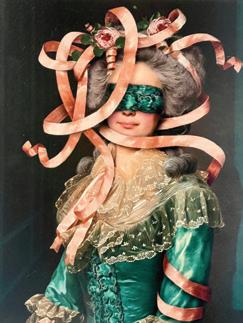
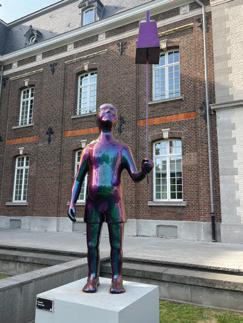
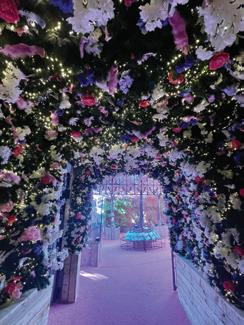
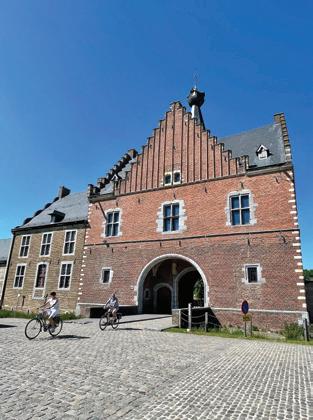

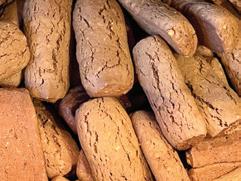
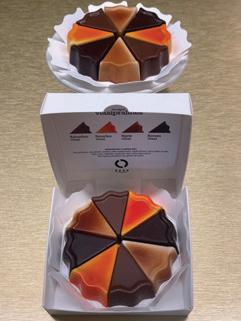
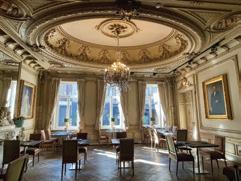
Cycling through Water is nearby a 200m bike path through a pond, where the water is at eye level on both sides. Cycling through the Trees in Bosland lets cyclists peddle among trees up to 10 metres high. E-bikes are available from City-rent.be, Visit Hasselt, Biking Fietsshop and Corda Campus. Community guards keep an eye out for bicycles for free at Capucienenplein and Groenplein (which also has a bike tire pump) every day but Sunday. Vespa Vibes has a wide selection of scooters for a stylish day out and Rederijli Limburgia offers a variety of cruises on the Demer River that.
The HasPas is a good value booklet including tickets to the Jenevermuseum, Modemuseum, Het Stadsmus, Z33, Villa Verbeelding, Japanese Garden and Herkenrode Abbey plus more, available for €18 from Visit Hasselt and other tourist sites. Visithasselt.be offers a downloadable city map.
Hasselt à la Carte: Food week with special restaurant menus, food stands and workshops
Hasselt Fashion & Design: Annual fashion festival with about 100 models walking through streets, October 23-26
Jeneverfeesten: Two-day celebration of jenever each third weekend of October, October 18-19
Kunsten Nacht: Art night including rare access to the garden of the Governor’s mansion, each second Thursday in May
Live in Hasselt: A free music festival with known Belgian artists in the city centre the last Saturday in May
Meiavindviering: End of winter festival including the burning of the Langerman king of winter, a procession with giant puppets and fanfare, April 30
Pukkelpop: Four-day, August music festival in Kiewit park featuring Belgian and international artists plus 180,000 music fans, August 14-17
Bocca Nera: Bright, modern, Italian hotspot with a sharing concept and extensive menu, including wood-fired pizzas
Het CordAAT: Upscale, attractive restaurant run by culinary students at the adjacent Corda school outside the city centre
La Fontanella: Cozy Italian restaurant featuring fresh pastas and Italian classics like veal parmigiana
Lento: Upscale vegetarian restaurant offering several gastronomic courses
Ogst: Michelin star gastronomic restaurant offering multi-course lunch, dinner and à la carte menus
Bardot: Wine bar featuring Spanish wines and Cava plus daily fresh pasta
Bon’Air: Atop the Radisson Blu hotel rooftop, an open-air bar specialising in cocktails
Lac Bleu: Swanky bar with a huge terrace on the canal
Koks & Tales: Award-winning, Art Deco-esque cocktail bar with homemade creations
Smaaksalon Brasserie: Offers Belgian breakfast and lunch in a stunning interior with ornate ceilings
B&B Hotel Hasselt: Three-star option near the train station with spacious, modern rooms in a 17th century building
BareFoodGiulia: Boutique hotel with seven artsy rooms in a renovated mansion in the city centre
HasHotel: Four-star, modern business hotel next to the town hall
Het Menneke: A centrally located, modern bed and breakfast with five rooms each displaying a mural that represents Hasselt
Maison Stout: Beautiful, peaceful bed and breakfast on the outskirts of Hasselt with an enclosed garden
Boon: Chocolatier known for creative moulds and the Hasselt praline
DePaifve: Bakery specialised in speculaas, including biscuits laced with marzipan
Kuycksmeers: Design studio of an architect-jewellery designer duo selling zero-waste handbags and coffee tables
La Bottega: In the former Smeets jenever distillery, a 2,000-square-metre retailer of designer shoes, clothing, accessories and home décor items with a focus on Belgian talent. Its Bistro Bottega offers breakfast, lunch and cocktails for shopping breaks.
La Bottega Outlet: Offers deep discounts on certain La Bottega items
100.000 Hemden: Stylish men’s and women’s shop since 1882

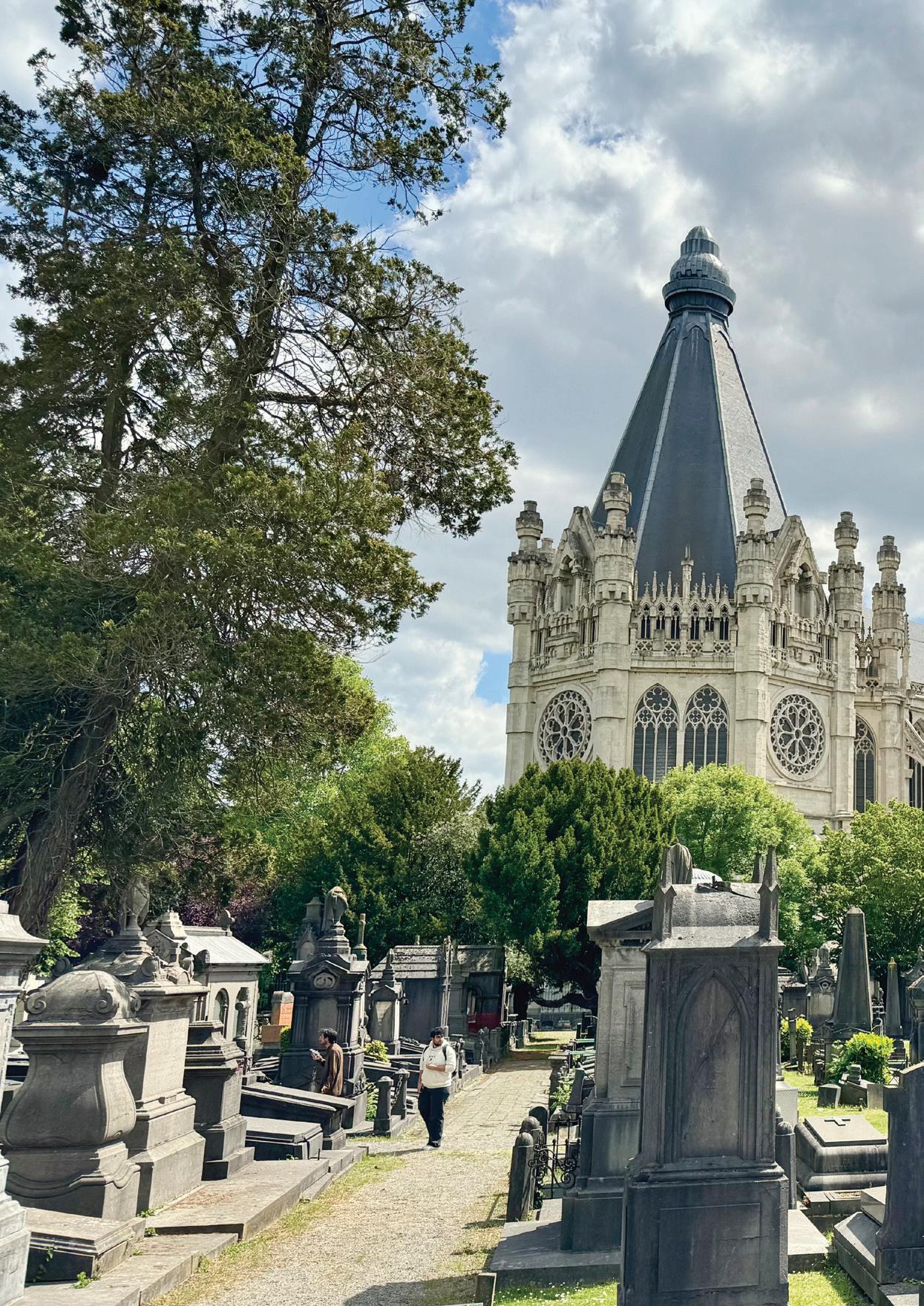

Laeken Cemetery tells a tale far richer than mere mourning. It where opera divas lie beside surgeons, the summer sun casts hearts in stone, and a forgotten funerary workshop preserves the artistry of death. Hugh Dow strolls among the tombs, catacombs and quiet marvels of the necropolis
This new church being still unfinished on his death, he was buried with his wife in the old church in the middle of the cemetery. This caused a bit of a kerfuffle because he was a protestant and a freemason and therefore inimical to the Catholic clergy.
Having seen off the Brussels trams in travel features for this magazine, I was invited by the powers-that-be, over an agreeable lunch, to turn my attention to the many Brussels cemeteries.
The history of cemeteries took a different turn in Belgium than, say, Britain or Ireland where the established churches can officiate and bury. Here, that lethal arch-organiser Napoleon decreed that while the matter of spiritual departure may safely be left to the clergy, physical disposal was to be the domain of the commune. Which is why most of Brussels’ graveyards do not have a church nearby.
Most but not all. Laeken Cemetery has the distinction of not only being Brussels’ oldest but having a huge church attached to it. The story of how this came to be is curious.
No one knows when Laeken Cemetery got going. Certainly, there was some kind of primitive Gothic church on the site in the 13th century. And one can safely assume people were buried around it. Throughout the late Middle Ages and into the modern period there slowly came a realisation that graveyards were insanitary so close to churches. This was exacerbated by population growth. The fashion became to separate them and build a high wall around the graves.
In 1831, right after the nation’s founding, the new royal family chose as its residence the nearby Château de Schoonberg which had previously housed the Austrian overlords. King Leopold I decided to build a massive church, and a jury chose architect Joseph Poelaert, the man behind the gargantuan Palace of Justice. It would be constructed outside the cemetery as a suitable resting place for the regally departed, particularly his wife Louise d’Orléans.
This new church being still unfinished on his death, he was buried with his wife in the old church in the middle of the cemetery. This caused a bit of a kerfuffle because he was a protestant and a freemason and therefore inimical to the Catholic clergy. A bizarre compromise was reached whereby his remains entered the church by a specially constructed entrance which was sealed up afterwards! Most of the old church was torn down in 1894, but its choir remains in the cemetery, serving as a chapel for various uses such as catechism.

The Church of Our Lady of Laeken, which includes the royal crypt, now stands proud and magnificent beside the walled cemetery. Together they represent the collective histories of mediaeval churches, the gradual secularisation of cemeteries, and the grandiloquence of a new royal family.
One of the unintended consequences of Napoleon’s more legalistic approach was that families had the right to have burial vaults in perpetuity. This, of course, led the well-off to hire sculptors and architects to build them mausoleums of sometimes startling magnificence. Which in turn leads to another phenomenon which is that cemeteries can be, and are, seen as cultural assets.
As a simple illustration of this, I have in my hand a pamphlet. It is designed for children, walks them around Laeken cemetery and asks questions about sculptures like “Can you find the gargoyles above the door?” or “Why is the lady crying?” or “What do you think happened to this man?” (a statue of a dying First World War soldier). Introduction to grief is, or so it seems to me, as important as to joy. Although youth might, perhaps, prefer an app.
My first stop on entering the cemetery was at the Carré d’Honneur commemorating the fallen of two world wars. It is quite impossible not to be moved by this beautifully curated and flowered space. I ran my hands gently over some of the gravestones, noting teenagers and young men fallen far too soon
My next stop was the underground burial area, catacombs, or ossuary, if you will. The entry was discreet and took a bit of finding. It is vast as the cemetery ran out of space in the 1870s. It is well lit thanks to the vault lights (grids with glass) which I had noticed at ground level telling me I was getting warm.
The intense sunshine pouring in dissipated the gloom. I wandered around, noted a family with a heartbreaking succession of buried babies – one born, christened and buried in the same day. I suddenly realised I didn’t know my way out. By dint of walking around
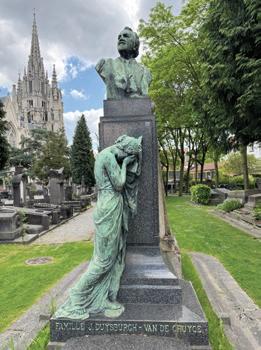
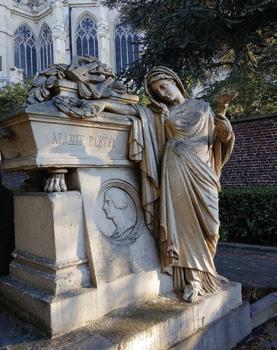
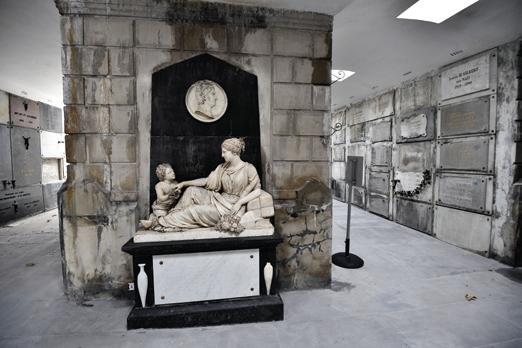
the edges like a timorous mouse, I eventually found the exit. It is not spooky, but nighttime might be a different matter. I noticed with relief upon exiting that there were no gates and the area was therefore unlockable!
Then to the gravestones and monuments of some of the better known - ahem - inhabitants. Some are famous in Belgium and some are, let it be said, international superstars.
Take for example La Malibran, aka Maria Felicia Garcia (1808 - 1836), one of the best-known opera divas of the 19th century. She sang in Italy, New York, Manchester and is closely associated with Rossini who had this say about her:
“Ah! That wonderful creature! With her disconcerting musical genius, she surpassed all who sought to emulate her, and with her superior mind, her breadth of knowledge and unimaginable fieriness of temperament she outshone all other women I have known.”
Born of a talented musical family in Paris, her early lessons from her father were “passionate and quarrelsome clashes between two powerful egos”; which augured well! She married the Belgian Francois Eugene Malibran in 1826 against her will. Her father received, it is said, a 100,000 franc dowry. Malibran, hapless
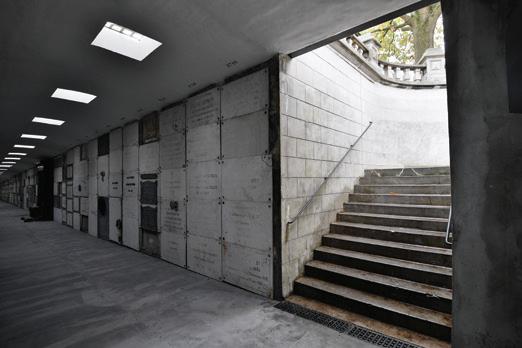
soul, promptly went bankrupt, relied upon his wife for support, and then died falling off a horse in England. His father, presumably not bankrupt, had him buried in Laeken and commissioned a magnificent mausoleum. Maria seemed to have something of a soft spot for Belgians as she then fell for, lived with (in what is now the Ixelles town hall), and bore a child by Belgian violinist Charles Auguste de Bériot. Ironically she also fell from a horse, also in England while riding with a certain Lord William Lennox who wrote “several feeble novels”. She refused all medical assistance, continued to perform, and died after a week of agony and was buried with her husband.
There are about 25 versions of Rodin’s The Thinker in places as disparate as Melbourne, Buenos Aires, Washington, and of course, Paris. Jef Dillon, who despite his demotic-sounding name, was a wealthy Brussels art dealer in the 1920s, bought one of the approved copies supervised by Rodin himself and persuaded the authorities to put the statue optimally, right in front of what was then the main entrance to the cemetery. Dillon is buried under it (Rodin’s own grave features a much later copy). This was surely to the satisfaction of both parties.
Alphonse Hubert François Balat (1818-1895): Main architect for Kings Leopold I and II, and designer of the Royal Greenhouse Émile Bockstael (1838-1920): Mayor of Laeken from 1877 until his death in 1920.
Nicolas-Jean Rouppe (1768-1838): First Mayor of Brussels, from 1830 to 1838, of independent Belgium.
Joseph Poelaert (1817-1879): Architect of the Palace of Justice, Congress Column, the churches of Notre-Dame de Laeken and Sainte-Catherine, and the Monnaie/Munt theatre
Maria Felicia Garcia, known as La Malibran (1808-1836): Greatest opera singer of her day.
Fernand Khnopff (1858-1921): Painter, engraver, and draftsman and pioneer of Belgian symbolism.
I suddenly realised I didn’t know my way out. By dint of walking around the edges like a timorous mouse, I eventually found the exit. It is not spooky, but nighttime might be a different matter.
Adolphe Delhaize (1840-1899): Founder of the Delhaize stores.
Léonce Evrard (1847-1919) and his wife Louise Flignot (18501916): Their joint temple tomb captures a heart of light in the summer solstice.
Camille Jenatzy (1868-1913): Motoring trailblazer, whose Jamais Contente car was the first to exceed 100km/h. Buried with his father, Constant
Marie Playel (1811–1875) celebrated concert pianist.
Louis Joseph Seutin (1793-1862): Doctor, surgeon and professor who developed the use of starched bandages.
Léon Suys (1823-1887): Author of the plans to cover and divert the Senne/Zenne river in Brussels, and designer of central boulevards, as well as the Stock Exchange building.
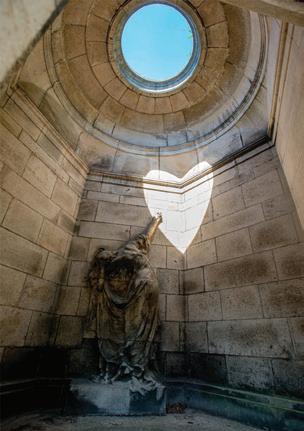
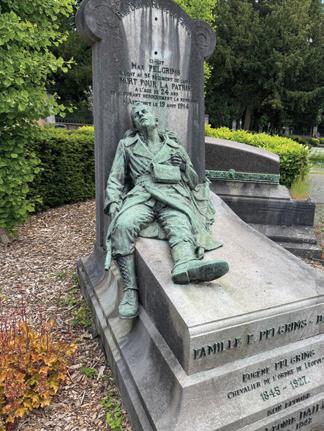

As a counterpoint to architects and musicians also within these walls lies surgeon Louis Seutin, who invented the use of starched bandages.

La Malibran is not the only Paris-born musician of some distinction to be buried here. Born of a Flemish language teacher and a proprietress of a lingerie shop in the Ninth Arrondissement Marie Playel (1811–1875) was one of the most admired pianists of her day. Berlioz was desperately in love with her, but she broke off their engagement to marry the heir to a French piano manufacturing business. She became head of the piano department of the Brussels Conservatory and ended her days teaching piano from a private house in Rue Royale. She was not entirely forgotten however as her former colleagues in the conservatory paid for a rather handsome funeral monument for her.
Near The Thinker is a little mausoleum where Léonce Evrard and his wife Louise Flignot were laid to rest. She preceded him and he, another architect, designed a hexagonal temple to her beloved memory. He cleverly built it such that at the summer solstice for a few hours the sun shines through an aperture and casts light upon a corner where two walls and the roof meet. Such are the contiguous planes that the reflection forms a perfect heart shape. Each year a small crowd gathers to observe and snap this romantic phenomenon.
As a counterpoint to architects and musicians also within these walls lies surgeon Louis Seutin, who invented the use of starched bandages. Seutin travelled through Russia demonstrating his plaster cast technique (Leopold I had served in the Imperial Army of Tsar Alexander I), and it was adopted by both the Russian army and navy by 1837. In 1848 he was the first to use chloroform as an anaesthetic. His treatment of open fractures was revolutionary. By improving hygiene, he also significantly reduced the number of women who died in childbirth.
Seitin appears to have been ahead of his time as Pasteur’s, Lister’s, and Wendell Holmes’ discoveries were met with doughty and pig-headed resistance by doctors in the mid-1800s. Seutin also appears to have been a visionary with chloroform narcosis, a procedure likewise met with stubborn immobility by a profession which should have known better.
If, after much tramping about through museums, mausoleums, catacombs and ecclesiastical neo-Gothic piles, you seek succour and refreshment, let me recommend the nearby Brasserie Royal. It is the Belgium I love: an unpretentious purveyor of food and drink, the welcome sincere and discrete, the food slightly better than the price would indicate, the house wine potable. But best of all, oh serendipity, is the authentically original Art Deco furniture. The bar chairs and tables look as though no one has got to them in the last 80 years. Couple this with faded portraits of long ago royalty hanging alongside a large screen showing DaBaby vids and you just know you’re in good hands.
A good lunch rounds off a good morning’s exploration.
The former workshop of Ernest Salu is a quiet, oddly mesmerising shrine to a long-forgotten craft. Now a museum of funerary art, it flirts with the morbid, yet holds a strange, compelling beauty, as Hugh Dow discovers
On a warm early June Monday morning I turn up at the Museum of Funerary Arts just outside Laeken Cemetery to meet Tom Verhofstadt, the enthusiastic curator of this tuckedaway museum. Right beside the entrance to the cemetery in the church square, bell-less (I rapped on the window), and with its own tiny courtyard, a treasure trove awaited.
This delightful Aladdin’s cave was the workshop of grandfather, father and son Ernest Salu first, second and third. He, the grandfather, opened up shop in a wooden cabin in 1874. He graduated to a purpose-built atelier and home in 1881 because business was most definitely good. The bourgeois of Brussels sought, and bought, dignified, stone final resting places.
The eponymous grandfather and his offspring were no mere artisans but qualified artists and sharp-eyed entrepreneurs. At its apogee, there were 40 men working in the premises, not to mention a fleet of donkeys. The delivery distance was small to vanishing, but a cubic metre of Belgian bluestone will weigh 2.5 tonnes. There would have been much pulling by the donkeys, and serial replacement of rolling logs underneath by the men as the product was delivered.
It was Napoleon, or one of his henchmen, who conceived of the “concession à perpétuité”. This created a taste for elegant stone family vaults to last, if not for ever, then a considerable time. In an increasingly lay society, fine families could also lay claim to their place in the sun.
I had always assumed that sculptors bought blocks of stone (Salu grand-père had excellent contacts in Carrera, no less) and started chipping away at it. Not necessarily. The sculptor created his model in plaster and then artisans scale up the master’s work in stone. I was surprised to see a photo of a nude woman posing in the atelier, then a further photo of her encased in a sort of toga. Thus, the sculptor, working with plaster, can get exactly the flow of material on flesh that he desires. Not possible in stone.
By the entrance are what is believed to be the original models for the funeral plaques for protestant Leopold I and his Catholic wife Louise d’Orléans who were both buried in the old church. They were later moved to the royal crypt in the much larger new church as
befits their status. Also at the entrance are the plaster models of the four friezes which ennoble the Place des Martyrs in central Brussels, commemorating the 400 or so men who died in Belgium’s brief war of independence.
Upstairs, and fenced off, is a workroom left exactly as it was on the last day in 1983. Discarded tools and half-constructed models, a few bits of paper, a pencil, dust.
Verhofstadt locks up and walks me to the nearest metro station. I reflect that with its cartoon, Horta, two chocolate and two beer museums inter alia, Brussels seems to have got the less obvious parts of life – and death – well and truly covered. And we agree, as we take a cunning shortcut via a discreet railway station, that without our passions, his and mine, life would be a sad business indeed.
Upstairs, and fenced off, is a workroom left exactly as it was on the last day in 1983. Discarded tools and halfconstructed models, a few bits of paper, a pencil, dust.
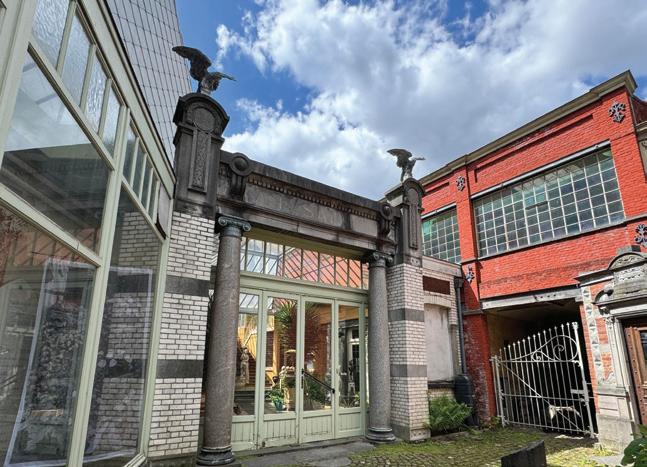


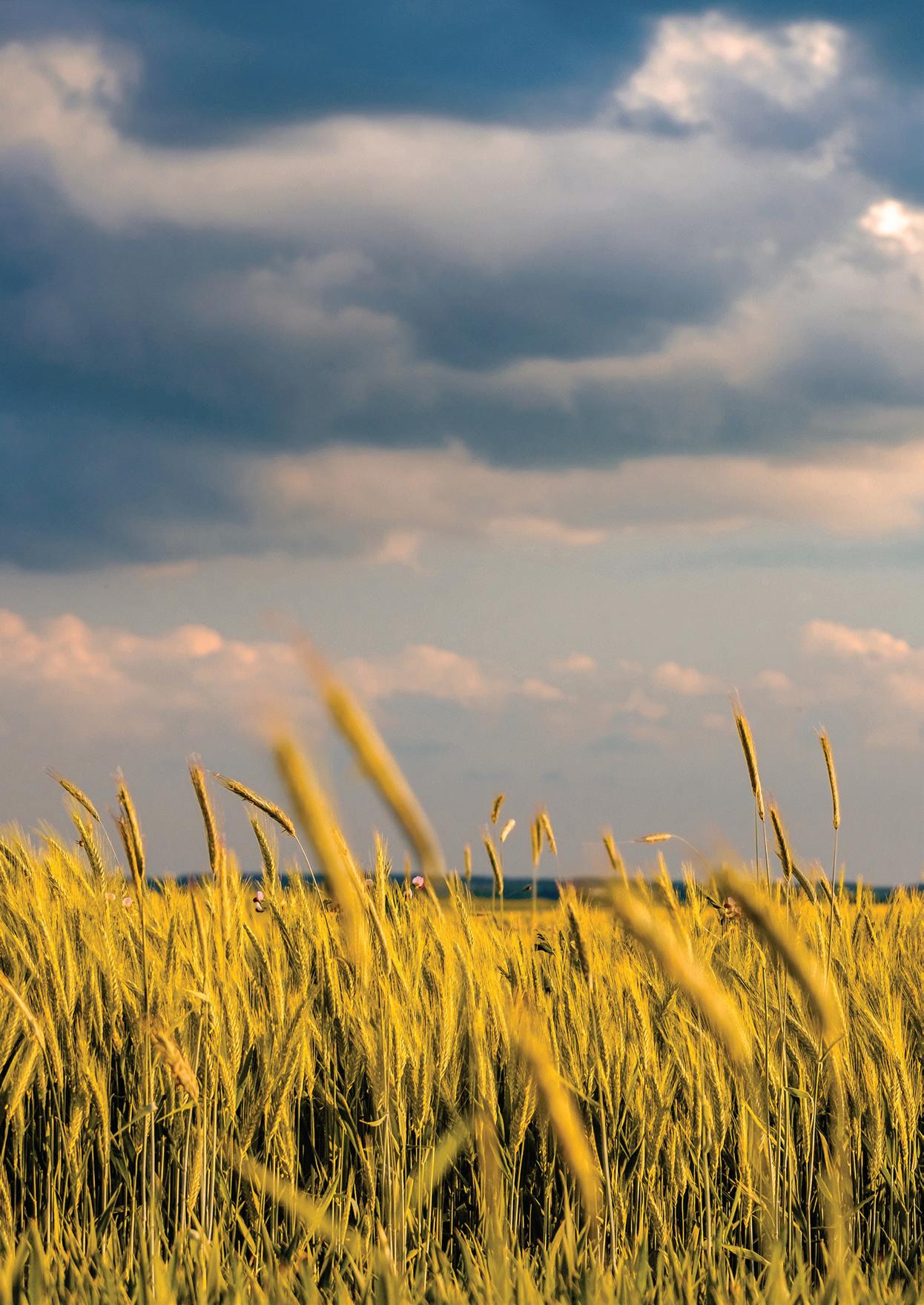

Sustainability is changing how Belgian beer is made, marketed and enjoyed. Breandán Kearney examines how Belgian brewers are rethinking their environmental impact without losing their roots
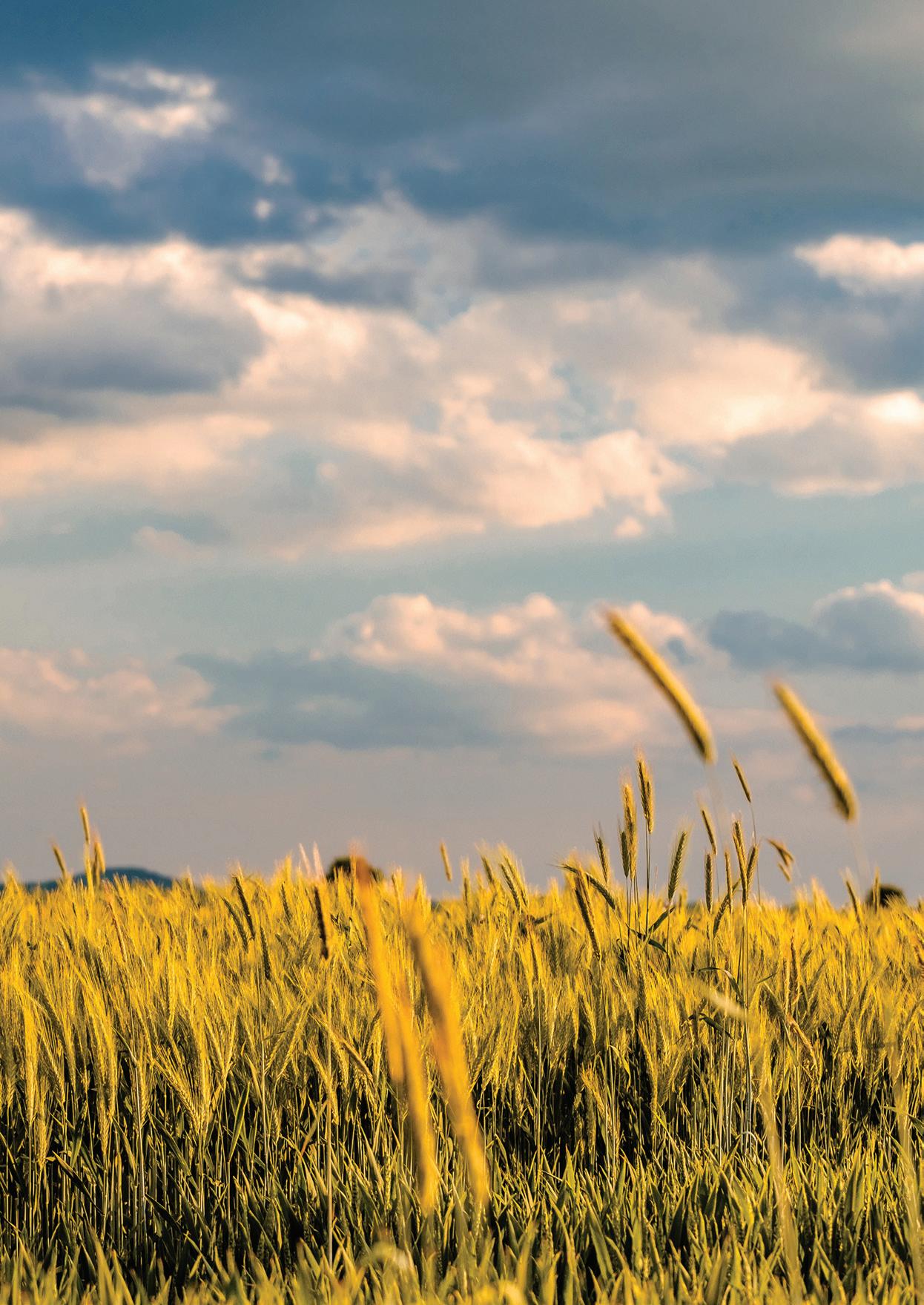
Breandán Kearney
Brewing beer is a resourceintensive act. It consumes vast amounts of water, burns through energy and produces waste in every batch.
In 2018, a group of Belgian brewers signed a voluntary agreement with the Flemish government, committing themselves to work together to use water more sustainably. The 16 breweries that eventually took part in the Flemish Green Deal for Breweries – which officially ended in 2023 – included large regional operations such as Haacht, Van Steenberge and Cornelissen, family dynasties like Duvel Moortgat, Huyghe and Van Honsebrouck and globally-known brands such as AB Inbev, Alken Maes, Rodenbach and the Trappists of Westmalle.
A 2024 report on the Flemish Green Deal for Breweries gave the full results: the participating breweries had collectively saved 2.29 million cubic metres of water, the equivalent of 915 Olympic-sized swimming pools. They had also cut their use of deep groundwater by 1.19 million cubic metres, helping preserve aquifers under stress from over-extraction.
The changes the brewers made to achieve these gains weren’t flashy, but they were smart. Breweries invested in clean-in-place (CIP) system optimisation, rainwater harvesting and reverse osmosis filtration. Some reused water for cleaning or cooling, while others tackled inefficiencies in bottling lines and fermentation. A few even went further, automating water source switching or using recovered process water wherever
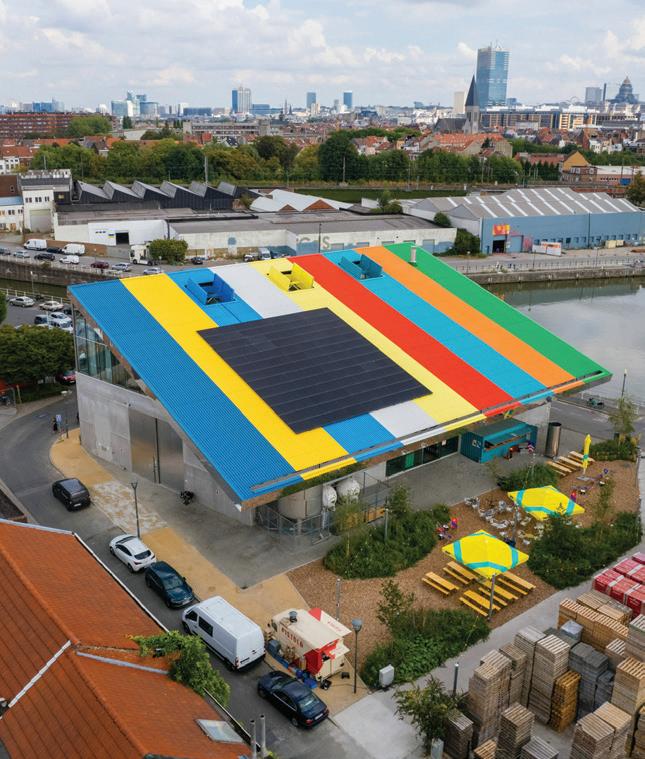
hygiene allowed.
Perhaps most importantly, the Flemish Green Deal for Breweries also built a culture of learning and transparency when it came to sustainability. The breweries shared data and swapped strategies in regular roundtables. They worked closely with government agencies, including the Flemish Environment Agency, the Environment Department and the Flemish Water Knowledge Centre. The agreement was co-signed by the Belgian Brewers and the food industry federation Fevia Vlaanderen. The project showed that sustainability didn’t have to be just a marketing add-on. It could save energy, cut long-term costs, enhance relationships and help create “cleaner” Belgian beer.
Brewing beer is a resource-intensive act. It consumes vast amounts of water, burns through energy and produces waste in every batch. In an age defined by climate instability, resource scarcity and shifting consumer values, even Belgium’s most iconic breweries can no longer afford to ignore the environmental cost of their craft. The question is no longer if Belgian beer must become more sustainable, but how. And whether the industry can do so without compromising the authenticity and character that makes it special.
While approaches to sustainable practice vary by brewery size, philosophy and geography, several core strategies to reduce environmental impact have emerged across the beer industry in Belgium in recent years.
Water conservation, as shown in the Flemish Green Deal for Breweries, is a key one. Water is one of the main ingredients of beer, but also one of its most wasted. Some breweries now recycle water between cleaning and brewing processes, while others are investing in advanced treatment systems to reduce discharge and re-use wastewater.
The Omer Vander Ghinste brewery in Bellegem, as well as being one of the participants in the Flemish Green Deal for Breweries, has further leaned into water conservation by setting up a partnership with water technology experts Veolia Water Technologies, undertaking a major expansion of its wastewater treatment plant.
With advanced membrane filtration and anaerobic digestion systems, Vander Ghinste’s brewery systems recover 70% of their water for reuse in cleaning, cooling and bottle washing. Simultaneously, the brewery captures high-quality biogas from its wastewater and uses it to heat operations on-site, creating a closed-loop energy cycle.
Together, these innovations save the equivalent of the annual water consumption of 3000 Belgian residents and prevent the emission of 548 tonnes of CO₂ each year. In a 2024 press release, Veolia called the Vander Ghinste brewery a "bio-factory". Vander Ghinste says that it’s just “future proofing.”
Energy efficiency practices are another component of Belgian beer’s path to sustainability. Solar panels have become a common sight on brewery roofs. Others use biogas produced from fermentation by-products to help power their operations. Heat recovery systems, which capture and reuse energy from the brewing process, are also gaining popularity. These measures not only reduce emissions but also cut long-term costs.
AB InBev, the largest brewer in the world, has made significant investments in renewable energy. At their Stella Artois Brewery in Leuven, they’ve installed 2,117 solar panels covering 3,800m² and producing 576,000 kWh annually – enough to power approximately 150 households. At their Jupiler Brewery in Jupille, they added 2,111 solar panels in 2021, supplementing the existing 6,000 panels to enhance renewable energy production. And at their Hoegaarden Brewery, they installed 2,100 solar panels in 2019, contributing to the company's goal of 100% renewable electricity by the end of this year.
Independent breweries are also investing in energy efficiency. Brouwerij Huyghe has installed solar panels (recently, an investment of €700,000), as well as a combined heat and power (CHP) system that uses biogas from anaerobic water purification. These changes have resulted in the brewery being on target to produce approximately 90% of its required energy by itself and in a green manner. In addition, they’ve also invested €600,000 in new sustainable cooling units and €250,000 in compressed air units to further reduce energy consumption.
When Brasserie de la Senne built a new production facility on the Tour & Taxi site in Brussels, it covered the entire roof of its building with photovoltaic panels – 1,219 Canadian Solar panels (371,695 peak watts) and six SMA inverters on a PVC roof. Because of this, a large part of the electricity required to power their operations is now renewable.
There has also been a concerted attempt to embrace the circular economy. Spent grain – the leftover malt from brewing – is increasingly repurposed as animal feed, compost or even baking ingredients. Some breweries partner with local farmers to ensure these by-products never go to waste. From hop growers in Poperinge to organic grain farms in Wallonia, sourcing locally has environmental benefits. And a growing number of brewers are turning to organic ingredients, both to reduce chemical use and to market their beers to eco-conscious consumers.
Brasserie Brunehaut, located in Rongy-Brunehaut in Wallonia’s Hainaut province became the European Union's first B Corp-certified brewery
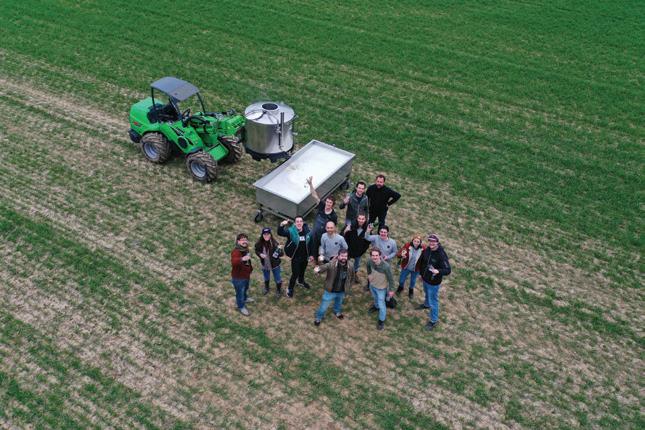
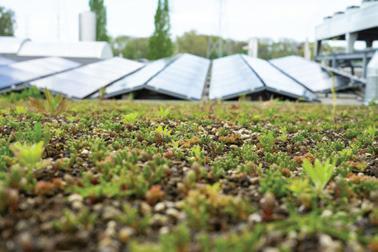
when it finished a two-year certification process in February 2021. All Brunehaut beers are organic, they source ingredients as locally as possible, and they pay their farmers at accepted fair-trade levels. Brunehaut’s partners and suppliers –Sturm, Houblonde, La Miche, etc – are companies that share their circular economy principles. Brunehaut claims to be the first brewer in the world to distribute recyclable export kegs (and their 350 rooftop solar panels produce 75% of their required brewing electricity).
In 2016, De Halve Maan constructed a complex underground beer pipeline between its brewery in the historic centre of Bruges to a more sustainable bottling plant at the edge of the city. It was the world’s first underground beer pipeline and stretches to a total length of 3.3km. Not only has the pipeline resulted in greener bottling, but it has slashed Halve Maan’s CO₂ emissions by reducing the amount of heavy traffic to and from the brewery in the city centre. “Since its launch, we’ve been able to reduce our ecological footprint drastically,” says owner Xavier Vanneste. Brussels Beer Project embraces this circular economy by reusing 2.3 tonnes of unsold bread to brew its Babylone beer, cutting food waste and the need for malted barley. Additionally, the spent grains from brewing are repurposed to make bread, creating a closed-loop system that minimises waste and promotes sustainability. It’s not the only circular economy beer they produce. Yeti Bang is made using apples from Brussels’ gardens while Low CO₂ Pale Ale is produced with un-
The question is no longer if Belgian beer must become more sustainable, but how.

It’s a fun, hard and imperfect journey,” concludes BBP’s report. “The only one that makes sense.”
malted barley and wheat, with hops re-used from Delta IPA dry-hopping.
In their 2024 Impact Report, Brussels Beer Project set out their sustainability activities, which showed 25% of their malt comes from Pure Local, a project led by a Belgian regenerative agriculture programme. They have completely shifted to reusable stainless steel kegs from oneway plastic kegs as they become a plastic-free company. Some 91% of their bottles are reusable. They’ve even switched some of their fleet to electric or hybrid cars. “It’s a fun, hard and imperfect journey,” concludes BBP’s report. “The only one that makes sense.”
There are, of course, certain styles of beer where there seems to be an in-built ethos of sustainability. Producers of lambic beers, for example – the most “natural” of Belgium’s beer styles – have been open to working with local farmers, using organic ingredients and embracing the circular economy for years.
The 3 Fonteinen lambic brewery has spent years rebuilding a local grain economy in the Pajottenland region in which they’re located. Frustrated by the post-war disappearance of traditional Brabant cereals, the brewery teamed up with farmers and agro-ecologists to grow heirloom wheat and barley on nearly 100 acres of regional farmland. Together, they formed the Cereal Collective; a long-term, fair-trade network that not only ensures brewers get high-quality grain, but also that farmers earn a viable income. More than 25 barley and 50 wheat varieties are now being revived – carefully matched to soil, climate and brewing needs – all with sustainability, biodiversity and local tradition in mind.
Since 1999, the Cantillon brewery has exclusively used certified organic ingredients in its brewing process. It refuses to use artificial refrigeration, relying instead on natural cooling processes that minimise energy consumption. And at Oud Beersel, cherries don’t just end up in their fruit beer. In 2022, it partnered with Belgian Beer Jams to turn orchard harvests and brewing byproducts into locally crafted, sustainable, cherry-apple and rhubarb jams.
Glass bottles remain a mainstay of Belgian beer, but packaging has come under scrutiny by those fighting for increased sustainability. Breweries are investing in lighter bottles, recyclable materials and return systems. Some are experimenting with reusable kegs and sustainable labelling to reduce overall waste.
A key piece of legislation currently making waves across Europe is the Packaging and Packaging Waste Regulation (PPWR), a sweeping EU measure which came into force last year, aimed at cutting packaging waste, boosting recyclability and accelerating reuse systems.
For brewers, the stakes are high. Beer is one of the few alcoholic beverages already sold widely in reusable formats, particularly in Belgium, where returnable glass bottles and kegs are the norm. Compared to the heavier glass bottles used for wine and spirits, beer’s packaging often has a lower carbon footprint, especially when integrated into circular deposit systems.
Unsurprisingly, brewers are keen to position themselves as the greener alcohol producers, touting their closed-loop logistics and lightweight packaging. But the regulation could affect multi-pack formats and impose stricter labelling and tracking requirements, adding complexity for smaller beer producers.
There are already several breweries investing heavily in more sustainable packaging initiatives. In collaboration with Carrefour Belgium and DW Reusables, the De Hoorn brewery (located in Steenhuffel and a part of the Royal Swinkels group of breweries) introduced a returnable, shelf-ready mini-crate for its Cornet brand. The aim was to reduce single-use packaging waste by implementing a deposit system that encourages consumers to return the crates for reuse. The crates are made from 100% post-consumer recycled plastic, aligning with circular economy principles.
Martens Brewery, located in Bocholt, partnered with manufacturer KHS Group to implement the Nature MultiPack system for its Karlskrone beer. This new packaging replaces traditional shrink wrap with small adhesive dots, eliminating the need for plastic film. The PET bottles used are made entirely from recycled materials, significantly reducing plastic waste and energy consumption during production.
While momentum is building, the path to sustainability in Belgian brewing is far from straightforward. Breweries face a range of challenges – some practical, some philosophical – as they attempt to modernise operations without compromising the soul of what they do.
Perhaps the biggest is cold, hard cash. Many of the most impactful sustainability upgrades – like water purification systems, heat recovery installations, or solar energy infrastructure – require
significant capital investment. For small, independent brewers, these expenses can be prohibitive, requiring long-term financial planning in a market of increasingly tight margins – and there are very few government subsidies to incentivise these investments.
Another major challenge is infrastructure and scale. Older breweries, especially those operating in historic buildings or dense urban settings, may lack the space or flexibility to install modern sustainability systems. For producers such as Brouwerij Roman, with one of the oldest brewery buildings in Belgium, or De Dolle Brouwers, with an archaic property that requires ladders to traverse, it’s more challenging to make the changes required to become greener. Scaling sustainability is often easier for new-build or expanding operations than for those working within the constraints of heritage infrastructure.
There’s also just the inherent tension built in when balancing tradition with sustainable innovations. Belgium’s brewing reputation is built on centuries of tradition – spontaneous fermentation, open cooling, slow maturation. Some of these practices are inherently less energy efficient. Modernising them risks altering the flavour profile or traditional processes of beers such as lambic, oud bruin, witbier, or abbey-style ales. Passionate brewers are understandably cautious about adopting changes that could affect the flavour or character of the thing their father and grandfather passed down to them.
Ingredient volatility also makes it difficult. Climate change is a part of this challenge. Shifts in temperature and rainfall are already affecting barley and hop harvests, both in Belgium and abroad. Organic and local sourcing – while more sustainable – can also be less predictable and more expensive than large-scale industrial supply chains.
And then there’s consumer awareness and price sensitivity. While eco-consciousness is rising, not all consumers are willing to pay more for sustainably brewed beer. Convincing drinkers that a greener beer is worth a premium can be tough in competitive markets, especially when imported beers are often cheaper.
Despite these barriers, Belgian brewers are increasingly recognising that inaction isn’t an option. The path to a more sustainable beer culture in Belgium is still taking shape, but signs of a greener future are already emerging.
Forward-thinking breweries are beginning to adopt circular economy principles. That means designing systems where every output – spent grain, wastewater, CO₂ – becomes a potential input elsewhere. From closed-loop water systems to collaborations with local bakeries and farmers, the goal is to ensure nothing is wasted.
We can expect to see further investment in technologies that reduce energy and water use, such as carbon recapture, AI-driven brewing systems for efficiency and eco-friendly refrigeration. New equipment is allowing brewers to experiment with lower-temperature fermentation and shorter boil times without compromising flavour.
Global disruptions and environmental concerns are nudging more brewers to source closer to home. This supports biodiversity, reduces transport emissions and bolsters local farming communities.
Partnerships between breweries, tech providers, researchers and policymakers are becoming more common. Initiatives like the Flemish Green Deal for Breweries create shared goals and incentives, helping breweries of all sizes move forward together.
Perhaps the most powerful force for change lies with drinkers themselves. As more consumers demand transparency, ethical sourcing and reduced environmental impact, sustainability will become not merely a point of difference, but an expectation. Education, labelling and storytelling will play a big role in closing the gap between brewery efforts and consumer understanding.
If Belgian brewers choose to see these developments as an opportunity rather than a threat to their tradition, sustainability might just be a major part of ensuring that tradition endures.

Passionate brewers are understandably cautious about adopting changes that could affect the flavour or character of the thing their father and grandfather passed down to them.
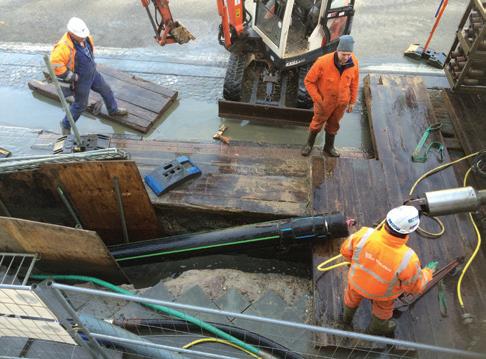
Belgium’s obsession with fries goes far beyond the fryer. From UNESCO recognition to surreal museum exhibits and age-old disputes with France, this crisp, golden staple has become a national icon. Hughes Belin visits the new Frietmuseum in Brussels that peels back the layers of a culture where the humble chip is anything but humble
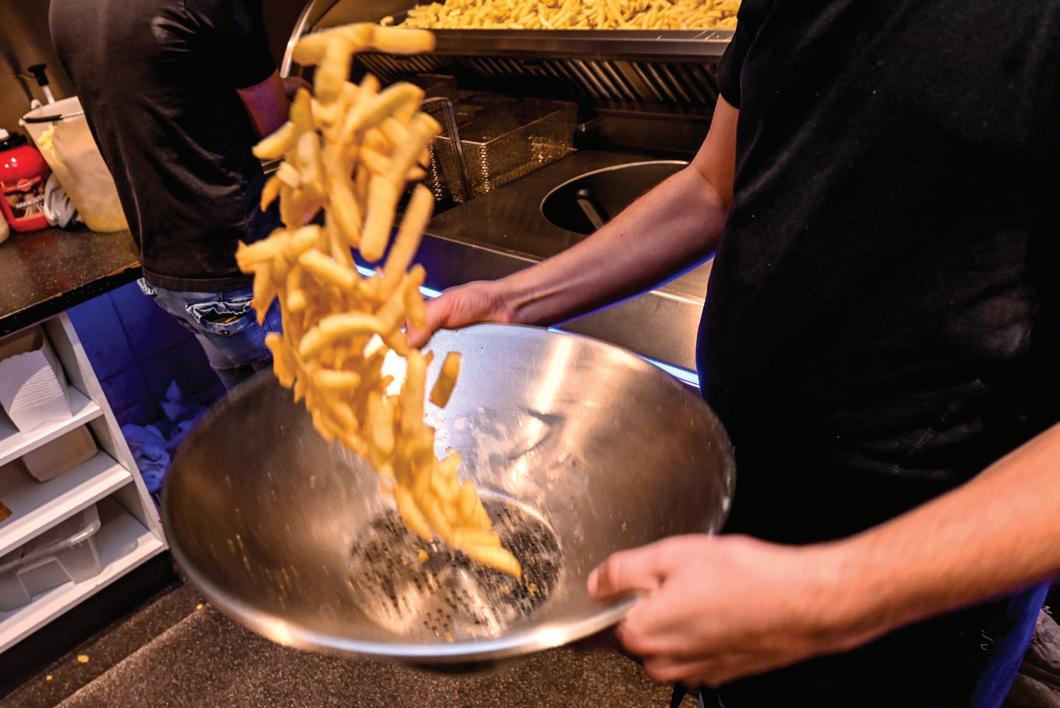
With 1,645 objects on display, the Frietmuseum revels in its crisp and quirky subject matter.
As a child, I was well aware that Belgium’s love affair with chips – or fries, if you are American – eclipsed even its famed passion for chocolate and beer. That impression proved true when I moved here from France. “French” fries – an appellation we’ll revisit – are etched deep into the Belgian psyche, not merely as food but as a form of street-corner communion. The average Belgian family consumes 16kg of fries a year.
The country’s ubiquitous fritkots (or frietkots or friteries or fritures or frituurs) –local chip shops – are cultural institutions
in their own right. Democratic and egalitarian, they attract patrons from all walks of life. The interlude between order and pick-up, as fries hiss in beef fat at 170°C, becomes a moment of connection: between customers and the frymaster behind the counter.
It chronicled the final days of one of these small, street kiosks before its demolition, in Jette, a working-class Brussels commune where people still speak Brusseleir, a colourful fusion of French and Flemish. “The chip shop in Belgium is a reminder of the informal life you can only find out in
Far East or Africa,” Poutte said.
In recognition of its cultural importance, ‘Fritkot Culture’ was declared Intangible Cultural Heritage by UNESCO World Heritage in all three Belgian communities – Flemish, Walloon and German-speaking –between 2014 and 2017.
Enthusiasts began documenting the phenomenon as early as 1998 with a webzine, frites.be. It was followed by an exhibition in Forest featuring Belgian painter Gilles Houben, who specialised in picturing fritkots, and the creation of the Micro Musée de la Frite, which still hosts over 900 fry-related curios.
In 2008, food entrepreneur Eddy Van Belle – who had founded Brussels' Choco-Story and Bruges’ Lumina Domestica (Bruges’ lamp museum) – added another culinary shrine to his portfolio: the Frietmuseum in Bruges. Dreamt up over a plate of steakfrites, it opened in the city’s oldest building, dating from 1399, and now attracts around 90,000 visitors annually.
After spending a decade and a half spawning Choco-Story museums across the world, Van Belle returned to his potato passion this year, opening a second fries museum, the Frietmuseum, in Brussels, just off Rue de l’Étuve and within sniffing distance of Manneken Pis. It opened its doors in May after two years of work.
With 1,645 objects on display, the Frietmuseum revels in its crisp and quirky subject matter. It is not short of traditions, local folklore and anecdotes showing how much French fries are tightly related to the essence of Belgian culture. It celebrates the ‘mirror image’ of Belgian essence through the paraphernalia surrounding fries. Interactive exhibits include a jukebox of frythemed songs in both Flemish and French.
A collection of serving cones and miniature forks illustrates the Belgian obsession with the perfect bite (purists say you should only eat fries with the fingers).
Some exhibits border on the surreal. One video captures a musical ensemble playing instruments fashioned from fry-making equipment. In another anecdote, a local radio station launched a cone of fries into the stratosphere – retrieved intact 30km from Brussels after a two-hour journey after rising 37km in altitude. A special sauce, ‘16-20’, was created by Brussels Ketjep to commemorate the event. It remains on sale to this day.
There are comic strips, artworks, and artefacts galore, all paying tribute to Belgium’s golden sticks. Through humour, surrealism, conviviality, and a touch of irreverence, the museum distils the Belgian soul.
National pride often finds its footing in unexpected places. Belgium and France have long sparred over cultural ownership – Jacques Brel and Johnny Hallyday among the most disputed figures – and fries are no exception.
The Americans haven’t helped, coining the term “French fries.” A video in the museum explains how US soldiers stationed in French-speaking Belgium during World War I confused the country for France.
But University of Liège food historian Pierre Leclercq traces the term to “French fried potatoes,” documented as early as 1857, and shortened by 1903. American Lexicographer Stuart Berg Flexner suggests the term ‘fries’ gained traction in the US from the 1920s to the ’60s.
So, who invented the fry? The Bruges Frietmuseum recounts a tale from the Meuse valley, where 17th century fishermen, sty-
So, who invented the fry? The Bruges Frietmuseum recounts a tale from the Meuse valley, where 17th century fishermen, stymied by frozen rivers, sliced and fried potatoes as a substitute for fish.
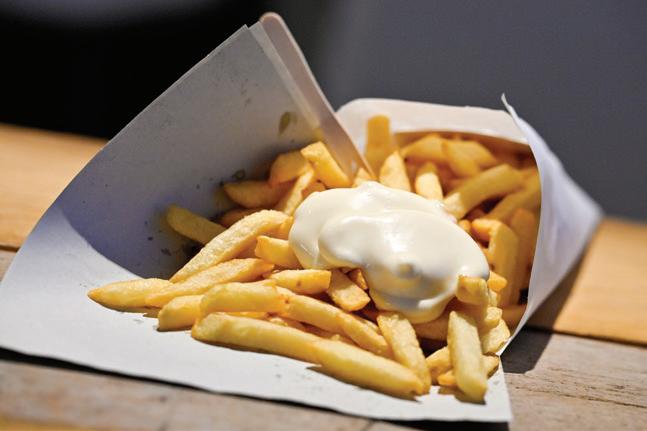
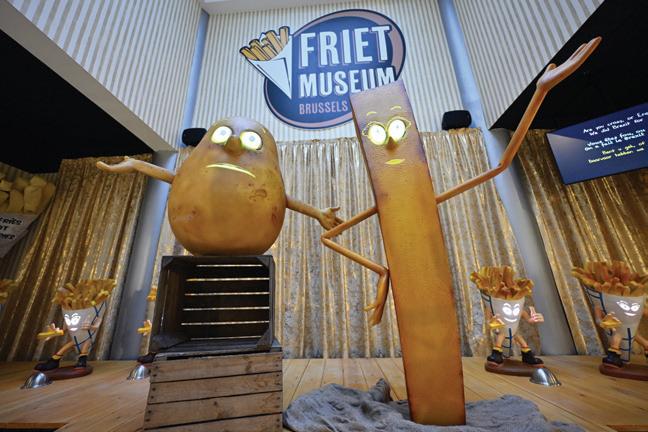
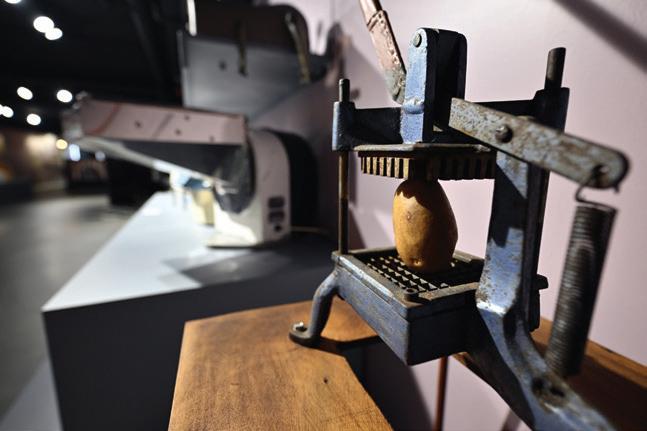

mied by frozen rivers, sliced and fried potatoes as a substitute for fish. This legend remains hotly contested: it is traced to a manuscript dating from 1781, discovered by Belgian historian Jo Gérard, but it later turned out that this but it later refers to fine slices of potatoes fried in fat, which were eaten in many parts of Europe.
According to Leclercq, the first fries likely emerged in early 19th century Paris, popularised by doughnut vendors on the Pont Neuf. The point is driven home the museum, where a side-by-side display at the museum compares an 1851 French cookbook, La cuisinière de la campagne et de la ville, that says, “You cut your raw potatoes into slices…” with the 1861 text, L’économie culinaire by Belgian chef Edouard Cauderlier, prescribing in its recipe on fat-fried potatoes to “cut potatoes into slices or sticks.”
Yet even Leclercq concedes this is not definitive. The characteristic stick form of fries seems to have appeared in Paris by 1840 at the latest. They were imported into Belgium by a Bavarian immigrant, Frederik Krieger, who learnt how to cook them in Montmartre in 1842. He settled in Belgium two years later, selling ‘Paris-like’ fried potatoes and making a fortune. Belgians then adopted the fries and incorporated them into their gastronomic culture, associating them with mussels, mayonnaise and generalising double cooking. Belgians “confuse culture and origin, which leads to an anachronism, a common mistake in the history of food,” Leclercq concludes.
Despite the debate, the museum leaves no doubt about the centrality of fries to Belgian life. Alongside classics like vol-au-vent and carbonade flamande/stoofvlees, the Frietmuseum pays tribute to the infamously indulgent mitraillette – a baguette stuffed with meat (merguez, steak or even lamb flakes) onions, sauce, and, of course, fries. A giant sculpture of it captures the chaotic glory of this carbohydrate torpedo: Belgians have a reputed steel-plated stomach to put fries into a bread sandwich!
Educational elements abound. The museum explains potato cultivation, showcases species like the much-lauded Bintje, and displays fry-related tools to cut, peel, cook, sample and measure. It also shows all the variants of standard fries (10 to 13mm thick sticks), from crisps to matchsticks, as well as displays on sauces, mustard and salt. There are audio guides in 11 languages and trilingual labels throughout.
And yes, the €14 adult admission price includes a cone of perfectly fried potatoes. Visitors can savour it beside a replica of a Brussels fountain – one final wink to a nation that wears its absurdities, and its fries, with pride.
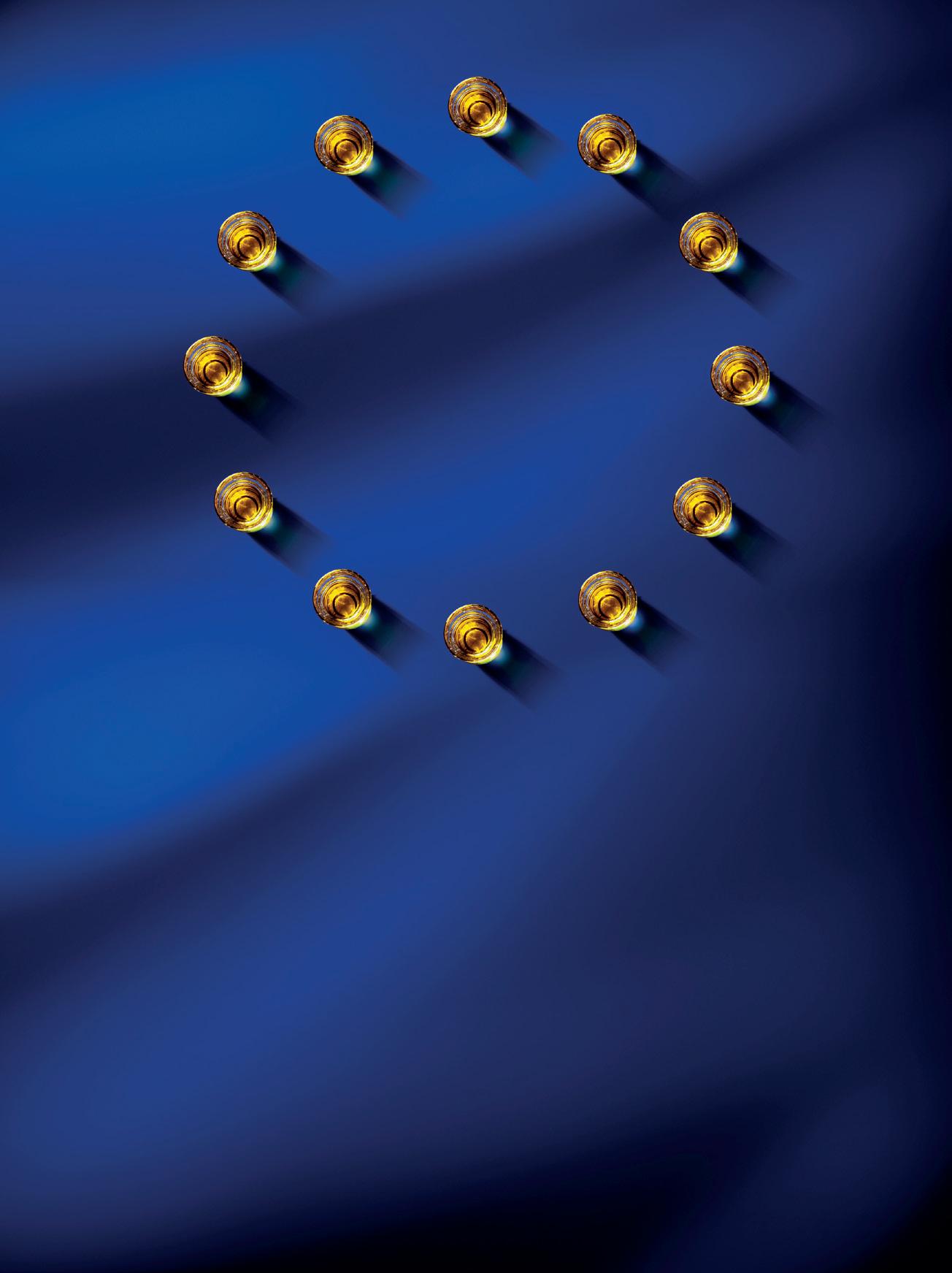
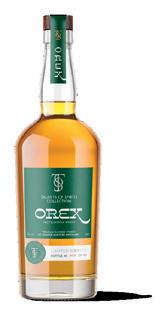

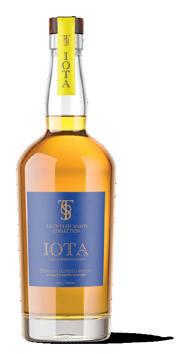

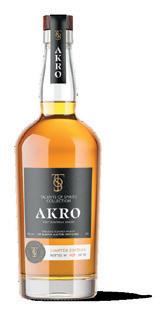

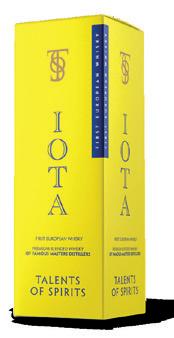
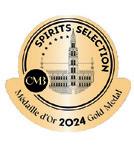
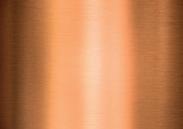

What are the most delicious foods, refreshing drinks, coolest cafés and intriguing restaurants in Brussels now? Here are some that recently caught the eye of our food and drink expert Hughes Belin

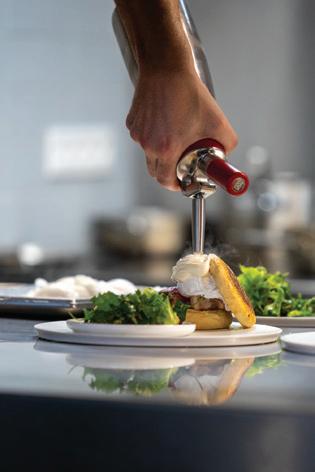
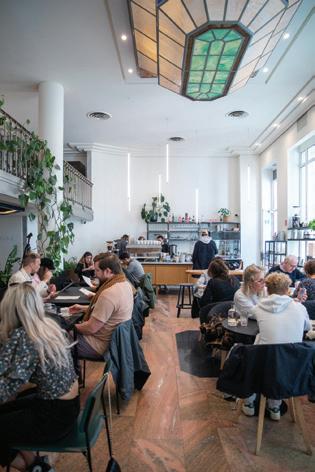
Frank is something of a gastronomic UFO. It doesn’t quite fit the mould of a traditional restaurant, yet it offers more than your average café. Yes, you can order brunch any day of the week, and yes, the bar – with its gleaming La Marzocco KB90 espresso machine – plays a central role. But what truly sets Frank apart is the culinary ambition behind its dishes: not defined by elaborate flourishes, but by quality ingredients, technical precision, and a generous dose of creativity – both sweet and savoury.
Frank champions local sourcing at its core, working directly with nearby farmers and artisans to maintain a short, sustainable supply chain. Everything is made from scratch – including the bread. This ethos is the work of chef Mathias Smet and head barista/maître d’
Marianne Renders. Mathias, a self-taught chef, pivoted from photography and architecture before learning his craft at the inventive vegetarian restaurant Hummus & Hortense. Marianne honed her coffee skills in Australia at Seven Seeds before the duo launched a branch of OR Coffee on Place Jourdan in 2015 – cutting their teeth on the mechanics of café life.
The sweet menu is addictive, with offerings that shine alongside coffee classics brewed from beans roasted by Brussels-based MOK and seasonal guest roasters. Take the yoghurt and granola, for example: it comes layered with hazelnut spread, citrus, fourseed granola, and a red fruit coulis. It may sound counter-intuitive, but the dish sings – especially when paired with a pour-over filter coffee whose bright acidity and vegetal notes bring the flavours into sharp relief. Frank’s pastries, too, are destined to become benchmarks. Try the ‘Billionaire’ – a decadent union of shortbread, caramel, and dark chocolate.
Yet it’s in the savoury offerings that the kitchen’s talent truly reveals itself. Frank is, above all, a brunch destination. The standout choice is the ‘Brunch Combo for Two’ (€32 pp): a generous spread that includes a sweet or savoury pastry, a yogurt and granola bowl (also available in a vegan version), fluffy pancakes with fruit coulis, and a side salad with house pickles. Each guest receives two poached eggs atop English muffins with a true hollandaise sauce – silky, butter-based, never mayonnaise. These come with your choice of topping: pork loin and bacon (‘Benedict’), roasted vegetables and labneh (‘Francine’), or smoked salmon on seaweed sour cream (‘La Monnaie’). Add a local organic apple juice and a speciality coffee of your choice, and you have a brunch that could well replace dinner. Those opting for à la carte selections will find a tight, seasonal menu of three inventive savoury dishes, where vegetables often play the starring role. For drinks beyond coffee, Frank offers homemade shrubs, Brussels craft beers, unfiltered cava, and even a standout Belgian white from Vin de Liège.
Frank isn’t just a café. It’s a culinary experience with the polish and imagination of a modern restaurant, rooted in craft, community, and a certain quiet brilliance.
Frank Rue des Princes 14, 1000 Brussels; and Chaussée de Charleroi 17, 1060 Saint-Gilles
Think the non-alcoholic beverage market is saturated? Think again. There’s still ample room for innovation – especially in Belgium, where new creators are flourishing with bold ideas and refined palates. The latest contender on the premium shelf is SCOB, a non-aromatised, fermented tea drink that promises to challenge expectations and delight the discerning.
Like many culinary start-ups, SCOB was born in a kitchen. Long-time friends Céline Cogniaux and Guillaume Berlemont were unimpressed by the uninspired selection of alcohol-free options in Brussels bars. Passionate about flavour and frustrated by compromise, they left their jobs to create a sophisticated alternative. One year of intensive product development and six months of business groundwork later, SCOB launched with a trio of zero-alcohol beverages that aim to appeal as much to wine lovers as to teetotalers.
Their starting point: tea – ancient, aromatic, and endlessly versatile. Working alongside Olivier Nuttens of L’Heure Bleue, a specialist tea shop on the edge of the European Quarter, the pair explored a multitude of infusions and fermentation methods. Their final recipes are united by three elements: a base of non-aromatised tea, fermentation using a SCOBY (Symbiotic Culture Of Bacteria and Yeast), and a dash of CO₂ for sparkle. Crucially, unlike kombucha, SCOB drinks contain no residual probiotics or alcohol, thanks to the absence of secondary fermentation in the bottle.
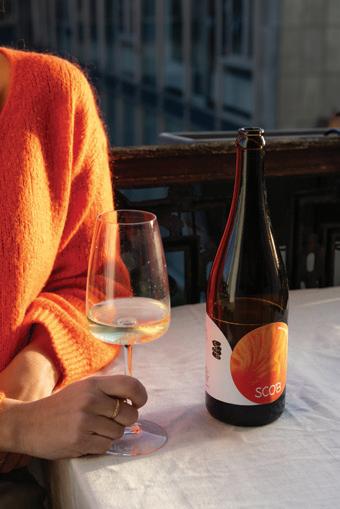
The result is a line of drinks as nuanced as wine, with flavour profiles designed for pairing.
Bloom is made from Chinese white tea fermented on a kombucha SCOBY fed with cane sugar. The result is soft, floral, and rounded, with notes of yellow fruit – ideal with cold starters or fruit-based desserts.
Blade uses a green ‘twig’ tea (leaf and stem), fermented with beet sugar. Bright and aromatic, it evokes sauvignon blanc, with raw elderflower notes that make it a perfect match for fish, goat cheese, or Asian dishes.
Butter, the boldest of the trio, is crafted from Jin Xuan ‘milky oolong’ fermented on a jun SCOBY fed with acacia honey. Its rich, brioche-like texture and peachy depth make it a natural companion for cheese boards or sauced dishes.
All three are remarkably low in sugar – just 1.1, 1.7, and 0.7 grams per 100ml respectively – making them ideal for thoughtful food pairings without the cloying sweetness common to many soft drinks.
Packaged in elegant 37.5cl (€7) and 75cl (€13) glass bottles, SCOB is already stocked in a carefully curated list of delicatessens, wine merchants, and cheesemongers across Brussels: Rob, Hop!, Titulus, Cave Coop, Jane, Bulbe, L’Épicier, Le Plateau du Berger, La Fruitière, and L’Estive. You’ll also find it on the menus of select gastronomic restaurants, including Le Chalet de la Forêt.
For now, production is modest, run out of Fermenthings, a food start-up incubator at Be-Here in Laeken. But if early signs are anything to go by, SCOB may soon need to scale up. Its creators – and their exceptional drinks – certainly deserve the spotlight.

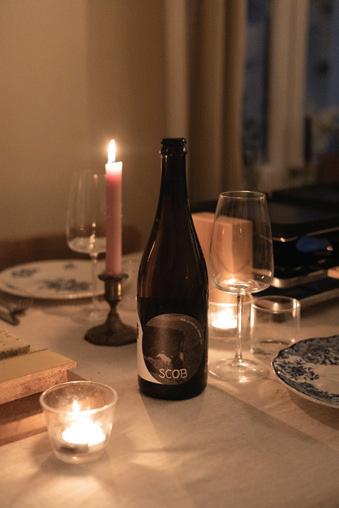
Created by three siblings – Mickael, Stephen, and Ping Wang – Kafei is Brussels’ first Asian-inspired coffee shop, serving up traditional brunch fare with an inventive East Asian twist. At the heart of their concept lies the now-iconic fluffy pancake: a thick, cloud-like round that’s as airy as a mousse yet rich and satisfying.
We first encountered Kafei’s signature dish at StrEat Fest, the city’s street food celebration held each May at Tour & Taxis,
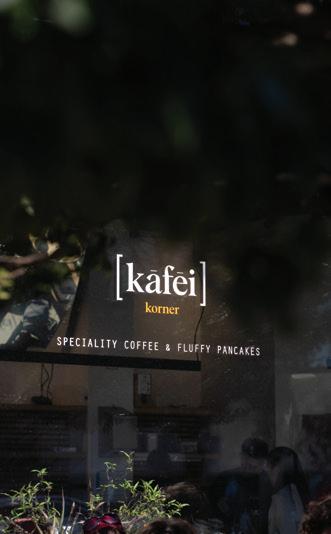
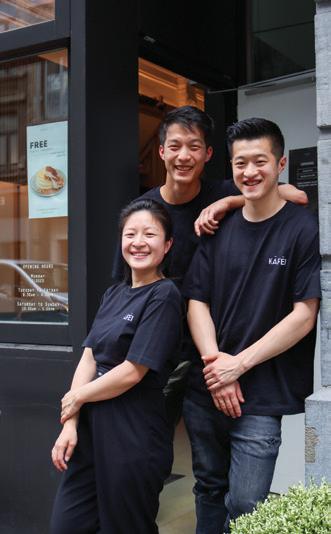

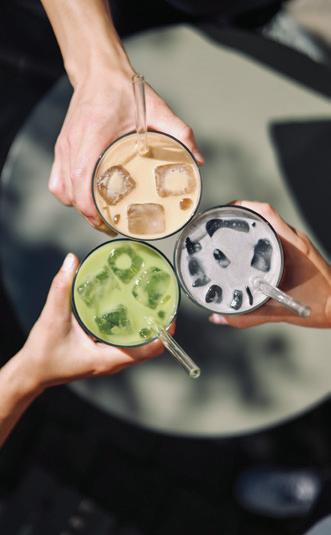
where the team drew crowds with two sensational creations. The first was a Tiramisu Fluffy Pancake, topped with coffee-flavoured mascarpone, speculoos, and cocoa powder – a double twist on the Italian classic, with unmistakable Belgian accents. The second: an Ube Fluffy Pancake, served with ube coconut cream and purple crumble, inspired by the vibrant Filipino yam.
At their three Brussels locations, the pancakes come in several variations, including one with fresh mango and a toasted rice-infused coconut cream – a subtle homage to the Thai dessert of sticky rice and mango. Other versions include matcha and strawberry, or hojicha (Japanese roasted tea) paired with a cocoa cream. The combination of pillowy pancake and indulgent cream is, quite simply, genius.
The Wang siblings grew up in the restaurant world, learning the trade from their parents, who ran eateries in Tournai, Nivelles, and Tubize. Nine years ago, they brought their passion to Brussels, opening Cup28 on Rue du Bailli, which still thrives today. Their roles are clearly defined: Ping dreams it, Stephen develops it and Mickael delivers it – a dream team with family synergy.
The first Kafei opened in 2018 on Chaussée de Vleurgat, complete with a quiet terrace just off Ave Louise. The concept was already fully formed: coffee from Brussels’ Wide Awake roasters, a curated tea selection including matcha, and reimagined brunch classics like eggs Benedict with miso-infused hollandaise. Poached eggs are served with a variety of toppings – marinated chicken, crispy pork belly, smoked salmon, mushrooms, or sesame-yuzu guacamole – all ideally paired with a pancake and a hot drink.
In 2022, the team expanded to Rue Dansaert, in the heart of Brussels’ fashion district. This outlet is compact and minimalist, with Japanese-inspired décor. That same year saw the opening of a third location in Sablon, dedicated exclusively to sweet offerings, with an expanded menu of artisanal coffee and tea options aimed at connoisseurs.
Most recently, the family launched Kage, a refined tearoom just a few doors from Kafei Dansaert. There, guests can explore rare matchas and tea-based cocktails served three evenings a week by Boupinh, the brother-in-law. It’s a family affair, driven by culinary curiosity and a refusal to stand still.
Kafei
147, Chaussée de Vleurgat, 1050 Ixelles 57, Rue Antoine Dansaert, 1000 Brussels 2, Rue Joseph Stevens, 1000 Brussels
Raw food enthusiasts know that when food is cooked above 47.7°C, the natural enzymes that aid digestion and cell regeneration are lost. Keeping food raw, then, can offer the body a helping hand – especially the pancreas – by preserving those precious enzymes. But how do you square that with indulgence? With desserts and chocolate bars?
Enter Nats Rawline, a brand that proves health-conscious confections can still satisfy. Most of its creations are raw, vegan, and gluten-free (with one delicious exception: a baked vegan brownie that includes gluten). There’s even a certified organic range. But founder Nathalie d’Harveng’s journey from health-curious teenager to global food entrepreneur was anything but smooth.
Her vision? To craft “a delightful and nourishing alternative to the sugary, preservative-packed desserts on store shelves.” Making that dream real was, as she puts it, “hardcore” – but transformative. “No is not an answer,” she now says. And her values remain non-negotiable: “My business partners must share my values. It’s not just about money.”
She launched Nats Rawline in 2017 with the backing of PMSweet CEO Michael Labro, who offered her use of his gluten-free production facility near Liège, where she learned not just the business but the science: industrial machines, ingredient behaviour, shelf life, and the fine art of mimicking pastry without flour, eggs, butter, or cream.
Is it high-tech like many processed vegan alternatives? Not quite. Nats Rawline relies exclusively on natural ingredients, yet the results are astonishing. “My learning process felt like a chemistry course,” she recalls. “I don’t even know how to bake pastry in an oven.” What she does know is how to balance temperature, acidity, taste, texture, and appearance to create raw treats that taste deceptively rich.
Take the chocolate and hazelnut raw cake: made from coconut milk, dates, dark chocolate, coconut oil, almonds, buckwheat, hazelnuts, and a pinch of salt. The result is so creamy and satisfying that it’s hard to believe it hasn’t seen heat. Or the caramel and chocolate raw bar – an elegant answer to the classic billionaire shortbread – crafted from date paste, gluten-free oat flour, maple syrup, cocoa butter, tahini, dark chocolate, and hazelnuts.
A key secret? The desserts are delivered deeply frozen to stores, allowing for a re -
frigerated shelf life of up to a week with no preservatives. D’Harveng sources ingredients from across the globe – Italian hazelnuts and pistachios, Spanish almonds, Californian cashews, Turkish (and Brazilian) Brazil nuts – always favouring high-quality producers.
The range includes vibrant fruit-based raw cakes (raspberry, passionfruit, mango, lime, strawberry, blueberry), four energy balls, and two rich plant-based mousses in exotic and chocolate flavours. Seasonal launches add to the mix, such as this year’s pistachio-vanilla cake – a standout treat now available in supermarkets.
Nats Rawline is not just a healthy dessert brand – it’s a lesson in how conviction, precision, and creativity can change the way we eat sweet.
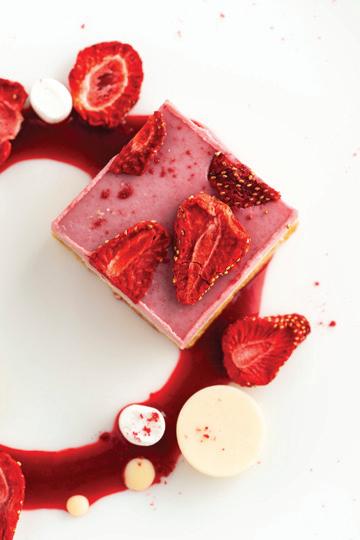
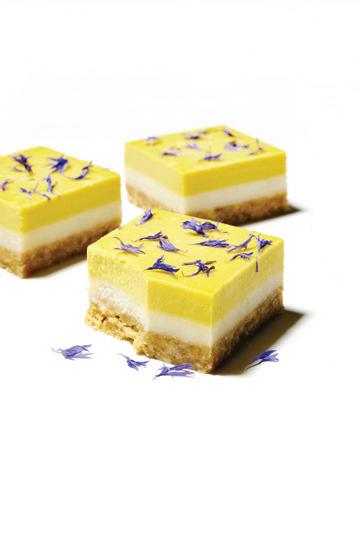
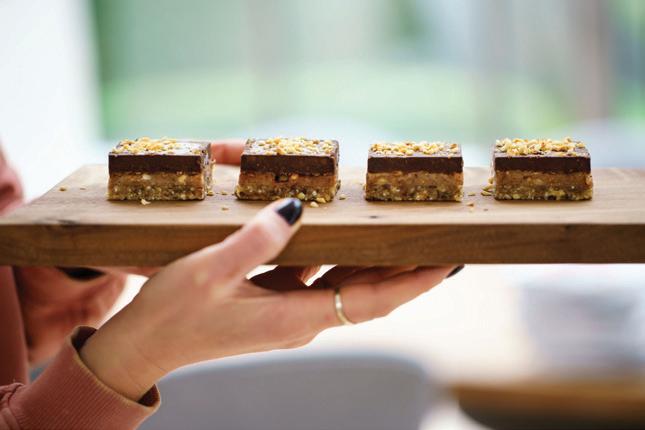
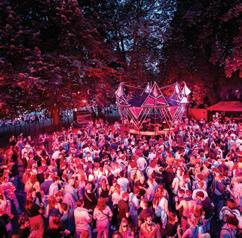
June 27-29, 2025
Over 80 artists spanning many genres will gather in Heysel under the banner of world music for the 2025 edition of Couleur Café. Little Simz, Denzel Curry and Omar Lay are some of the acts that will take the stage with the Atomium as the backdrop.
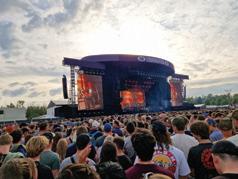
July 3-6, 2025
This annual rock music festival has been taking place near Leuven since 1976, drawing over 100,000 attendees over four days. This year’s headliners include Olivia Rodrigo, Linkin Park, Green Day, Gracie Abrams (who also plays at Forest National in Brussels on June 23), Underworld, Soulwax and Simple Minds, who first performed there four decades ago.
Kurt Karlsson selects the best current and upcoming events and exhibitions

June 30-July 1, August 14, 2025
Not so much a festival, but three seasoned artists performing in front of the palace. Veteran rocker Neil Young will rasp his set on June 30, followed the next night by French synth giant Jean-Michel Jarre, while on August 14, it is electro pioneers Kraftwerk.
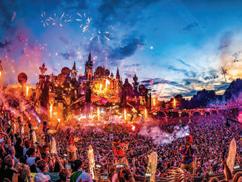
July 18-20 and July 25-27, 2025
Held in Boom, near Antwerp, since 2006, Tomorrowland is one of the most celebrated musical festivals in the world. The list of artists is massive and features some promising and lesser-known names: the line-up for this year includes Amelie Lens, Anyma, Charlotte de Witte, Martin Garrix, Swedish House Mafia, ANNA, Job Jobse and lots more.
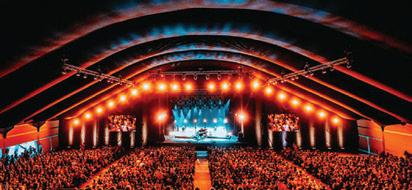
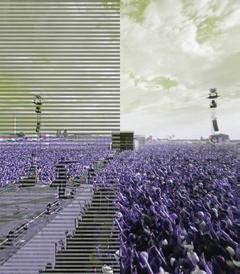
July 3-6, 2025
Four-day electro-rock festival Les Ardentes is relatively new to the Belgian music festival scene, debuting in Liège in 2006. It attracts more and more music fans each year, and the 2025 edition includes J Balvin, David Guetta, Gims, and Damso.
July 4-19, 2025
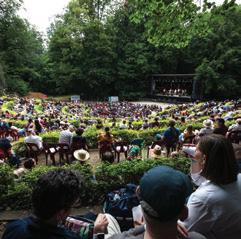
July 4-6, 2025
This urban jazz festival in Molenbeek features an international lineup, from Salif Keïta to Gabriel Ríos and Beverly Jo Scot. Brosella has been holding outdoor concerts in picturesque surroundings in Brussels since 1977.
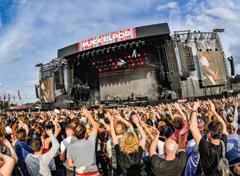
August 14-17, 2025
Pukkelpop is one of Belgium’s biggest musical festivals, held amid the forests just outside of Hasselt, attracting upwards of 200,000 fans of all sorts of music, from dance and pop to metal and rap. The 2025 lineup includes Chappell Roan, Queens of the Stone Age, A$AP Rocky, Chase & Status, Oscar and the Wolf, Jamie xx, Michael Kiwanuka and Pommelien.
Gent Jazz might sound like a niche festival, but for over a fortnight, it attracts some top-notch names, even if it stretches the strict definition of jazz itself. So, Herbie Hancock, the Roots, Max Richter and Baloji fit the description, but are Massive Attack, Bonnie Raitt, St. Vincent and Leon Bridges jazz? Not that it should bother fans.
Kurt Karlsson
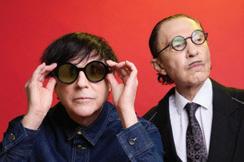
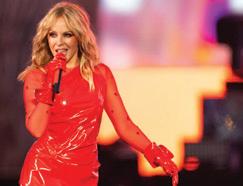
Sportpaleis, Schijnpoortweg 119, 2170 Antwerp
July 1, 2025
The Australian sex thimble has been part of our musical lives since she shifted from a bit part in the Neighbours soap to belting out hypnotic bubble-gum pop in the late 1980s. Her recent music is more sophisticated, but she includes her old faves in her tour.
Cirque Royale, Rue de l'Enseignement 81, 1000 Brussels
June 28, 2025
Ron and Russell, the so-called Sparks brothers, have been pushing the boundaries of music and spectacle since they formed in Los Angeles in 1971. Recently the subject of an Edgar Wright movie, the influential duo remains a mesmerising stage act.

July 9, 20925
Sportpaleis, Schijnpoortweg 119, 2170 Antwerp
He may have lost some lustre after coming second-best in his beef with Kendrick Lamar, but he is still a box office draw – and this year was recognised for receiving the most RIAA Diamond Certifications of any artist ever.
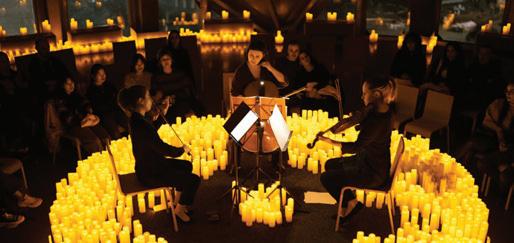
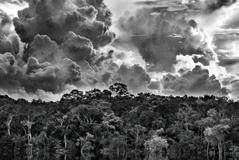
Tour & Taxis, Shed 4b, Avenue du Port 86C, 1000 Brussels
Until November 11, 2025
French-Brazilian Sebastião Salgado is arguably the world’s most celebrated nature photographer, whose black-and-white images of animals in barren landscapes suggest a pre-historic era. This exhibition features over 200 large-format photographs revealing the richness of the Amazon rainforest and the people who live there. It is accompanied by a soundtrack that was specially created by Jean-Michel Jarre.

September 18, 2025
Flagey, Place Sainte-Croix, 1050 Ixelles
The Brussels Philharmonic will perform John Williams’ Grammy-winning score of the 1980 The Empire Strikes Back (which many Star Wars purists say is the best in the series) as the movie itself plays on the screen. It will be led by maestro Dirk Brossé, who was chosen by Williams himself as principal conductor for the Star Wars in Concert World Tour in 2010.
Various dates
Concert Noble, Rue d’Arlon 84, 1040 Brussels
The Candlelight concept aims to adapt classical music concerts to younger audiences by diversifying offerings - and all in a lush setting with, of course, lots of candlelight. At the Concert Noble and the Planetarium of the Royal Observatory, its programme includes Vivaldi’s Four Seasons, Adele, Abba, Queen, Hans Zimmer and Bridgerton.
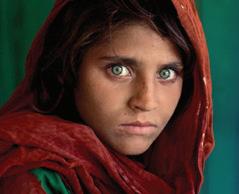
Grand Place 5, 1000 Brussels, Belgium
Until September 9, 2025
You may not know the name, but you have probably seen some of Steve McCurry’s photographs, like his haunting portrait of Afghan girl Sharbat Gula, which graced the cover of National Geographic in 1985. His retrospective exhibition at the Grand Place features over 100 large-format photographs from his 40-year career, and recent works.

KMSKA, Leopold de Waelplaats 1, 2000 Antwerpen
Until August 17, 2025
Visual artist Hans Op de Beeck has created a deserted nocturnal park peopled by life-size sculptures in flattening grey, black and white, making them seem hushed and frozen in time as if petrified or covered under a layer of dust.
WIELS, Avenue Van Volxem 354, 1190 Forest
Until September 28, 2025
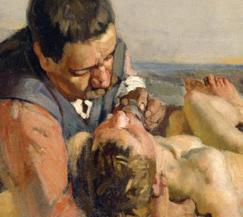
MAS Museum,
Hanzestedenplaats 1, 2000 Antwerp
Until August 31, 2025
MAS has collected contemporary art by Ai Weiwei, Berlinde De Bruyckere and Stephan Vanfleteren in an exhibition designed to make visitors reflect on the more difficult questions about the theme of compassion.
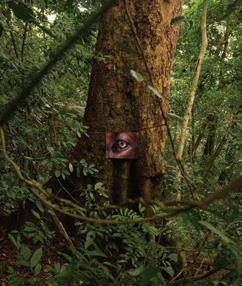
Some 30 artists examine the issue of planetary shifts and ecological challenges in this exhibition, including Karen Barad, Federico Campagna & Febe Lamiroy, Chris Cyrille-Isaac, Sofia Dati, Zayaan Khan, , Susan Schuppli and Dirk Snauwaert.
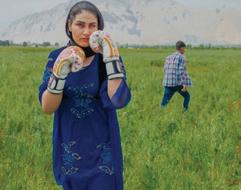
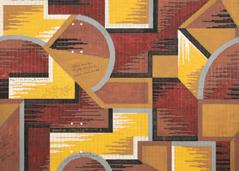
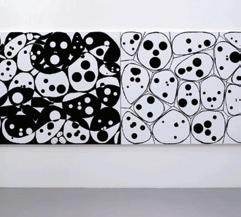
Centrale, Place SainteCatherine 45, 1000 Brussels
Until August 24, 2025
An exhibition that the curator says explores the tension between patience and action, blending art, installation, and thought-provoking narratives to engage visitors.
Bozar Center for Fine Arts, Rue Ravenstein 23, 1000 Brussels
Until August 10, 2025
Have Black and African artists been poorly recognised in the past? Inspired by director Ava DuVernay's television series When They See Us, this Bozar exhibition explores Black self-representation through some 150 works by 120 artists.
Hangar, 18 Place du Châtelain, 1050 Brussels, June 26 to July 13, 2025
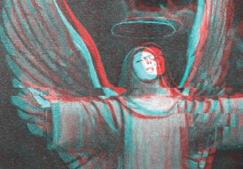
Museum PARCUM, Park Abbey, Abdij van Park 7, 3001 Leuven
Until November 9, 2025
There is, according to the curators of this exhibition, an “ageold human longing for transcendence through the lens of both medieval mysticism and contemporary art.” It features works by Marina Abramović, Jeremy Shaw, Laure Prouvost and others “to reflect on how mystical and modern paths toward ecstasy may still echo one another.”
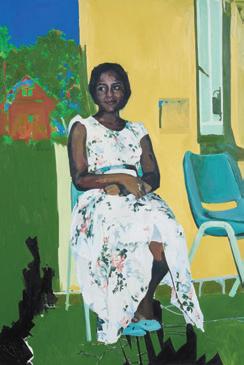
Reporters sans frontières (Reporters Without Borders), is a Paris-based NGO focused on safeguarding the right to freedom of information. On the eve of its 40th anniversary, this exhibition showcases the perspectives of 40 photojournalists from diverse backgrounds, looking at themes like the environment, exile, war and crisis.
Horta Museum, 27, rue Américaine, 1060 Brussels
Until November 2, .2025
As part of the Art Deco Year 2025 celebrations, the Horta Museum casts a new light on this period through the lens of design motifs, looking at how patterns, colors, decorations, and ornaments evolved and transformed between 1910 and 1940.
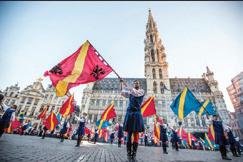
Various events of differing locations and times
Until July 4, 2025
The 2025 edition of the Brussels Renaissance Festival includes processions and performances harking back to the time when Charles V ruled over much of Europe. Ommegang, on July 2 and 4, involves 1,400 costumed participants recreating the aura of Brussels, when the Holy Roman Emperor himself called it home.
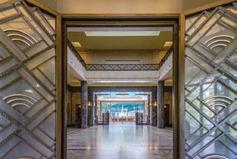
Various locations
September 13-14, 2025
A European initiative, enthusiastically embraced by Belgium, where the regions open the doors of key buildings over a weekend. For the Brussels region, the theme this year is Art Deco, reflecting the centenary of the style. Art Deco is also the theme in Flanders, while in Wallonia, it is “terroir”.
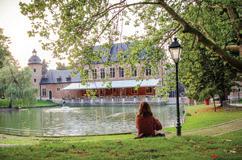
Château du Karreveld, Ave
Jean de la Hoese 32, 1080
Molenbeek-Saint-Jean
From July 9 to September 27, 2025
The 27th edition of the Festival Bruxellons features around 100 performances of 12 musical theatre shows, including the world premiere in French of Rebecca (inspired by Daphne Du Maurier's novel and Alfred Hitchcock's film) and Goodbye Norma Jeane, a tender dive into the life of Marilyn Monroe.

Grand Place, 1000 Brussels
September 5-7, 2025
Belgium excels in beer and this festival is a celebration of the country’s creations, with a chance to sample the lesser-known krieks, gueuzes, witbiers, bruins, saisons, dubbels, tripels and others.

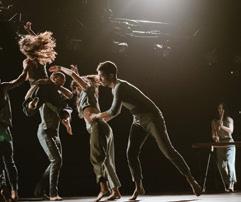
Les Brigittines, Petite rue des Brigittines, 1000 Brussels
August 14-30, 2025
A programme of “contemporary performances: innovative languages, bizarre universes, strange and original forms that speak to the imagination,” according to the organisers of their various music and dance shows.
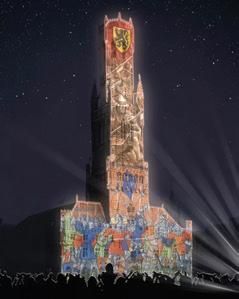

House of European History, Park Leopold, Rue Belliard 135, 1000 Brussels
Until January 11, 2026
How do Europeans engage with the past in their everyday lives? This exhibition of photographs from across Europe looks at the ways history and heritage are integrated into our modern worlds.
Markt, 8000 Bruges
July 1-11, 2025
This summer, the Belfry in Markt – or the Market Square – will be the canvas for a free light show twice a night that tells you the story of the city, from the past to the present.
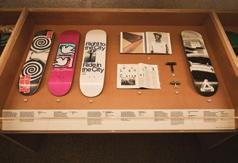
Design Museum, Place de Belgique 1, 1020 Laeken
Until September 14, 2025
The exhibition explores the development of skateboard design over seven decades, focusing on the technological, performative and aesthetic evolution of the skateboard. Curated by industrial designer and skater Jonathan Olivares, charts this evolution through an extensive collection of decks, trucks and wheels.
Brussels Expo, Palace 1, Avenue impératice Charlotte, 1020 Laeken
Until July 13, 2025
Want to swim with Nemo, cook with Remy the rat or blast into infinity and beyond with Buzz Lightyear? Then the Mundo Pixar Experience is for you: an immersive exhibition that recreates life-size scenes from these animation classics.
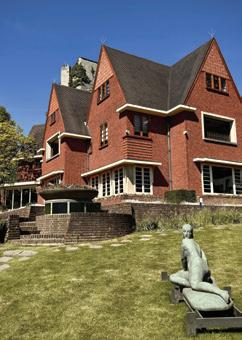
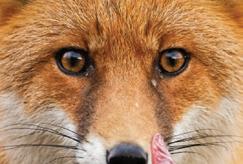
Van Buuren Museum & Gardens, Ave Léo Errera, 41, 1180 Brussels
Until September 28, .2025
The beautiful van Buuren house and gardens are worth a visit anyway but they include an exhibition of interwar sculptures, artfully scattered around the premises.
Royal Belgian Institute of Natural Sciences, Rue Vautier 29, 1000 Brussels
Until August 31, 2025
Combining the natural sciences with philosophy, anthropology and poetry, this insightful exhibition explores the concept of ‘wild’ and will awaken your curiosity and critical thinking. Visitors can learn more about Belgian wildlife, the history of the domestication of wolves and various other animals and enjoy films, scientific collections and more.
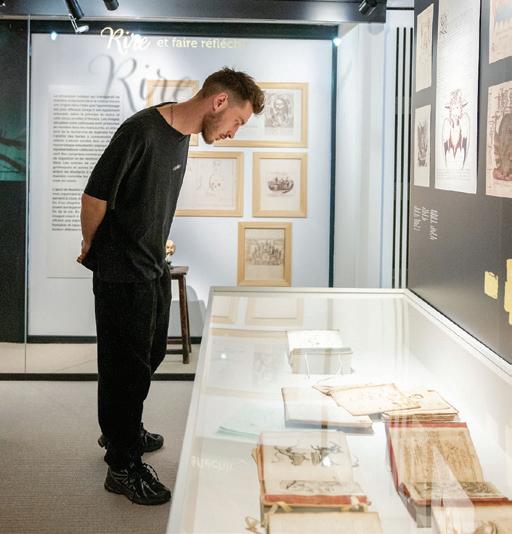
Musée L, Place des Sciences 3, 1348 Louvain-la-Neuve
Until February 22, 2026
The Musée L is as eclectic a museum as you will find. It showcases items from the archives of the University of Leuven, now UCLouvain in Louvain-la-Neuve, from ancient manuscripts to stuffed animals. This is a special exhibition celebrating 600 years since the university’s founding.

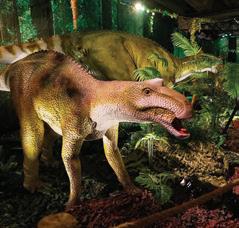
Brussels Expo, Palais 2, Place de la Belgique 1, 1020 Brussels
Until August 31, 2025
Billing itself as the world’s largest dino expo, with some 55 animated creatures from prehistory, this interactive show –coinciding with the latest Jurassic World movie – promises to take visitors back millions of years.
Fashion & Lace Museum, Rue de la Violette 12, 1000 Brussels
Until January 11, 2026
Conceived in the Dansaert district of Brussels in the 1980s, a handful of Belgian designers – led by Sonja Noël is with her STIJL boutique - began opening stores that set a new tone for fashion wear. This exhibition chronicles their influence through 68 silhouettes created by 46 designers.
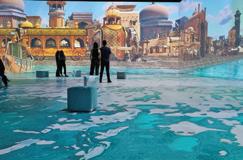
Horta Gallery, Rue du Marché Aux Herbes 116, 1000 Brussels
Until September 6, 2025
French author Jules Verne conjured spectacular worlds in the 19th century, and many of his imaginative adventures – Journey to the Centre of the Earth. Around the World in 80 Days, Twenty Thousand Leagues Under the Sea – still inspire. This immersive exhibition relives his steampunk stories.
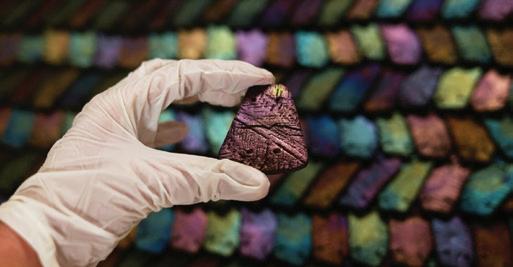
Z33, Hasselt, Bonnefantenstraat 1, 3500 Hasselt
Until August 23, 2025
Colour is everywhere - in our food, our clothes, all around our urban environment – yet few stop to consider where pigments come from, or at what cost. This exhibition brings together scientists, designers and artists to explore more sustainable, nature-inspired alternatives, with a focus on melanin.



FRIDAY
LITTLE SIMZ • OMAH LAY • DYSTINCT

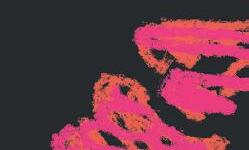

ODEAL • PA SALIEU • TAWSEN • JORDAN RAKEI
KIN'GONGOLO KINIATA • MAVEE • IFE OGUNJOBI
BALOJI • TH4YS • LOJAY • MARABOUTAGE • KANKA
ROSA PISTOLA • O'SIMMIE B2B KEVIN KOFII
JIDEH HIGH ELEMENTS • MALA • TOYA DELAZY
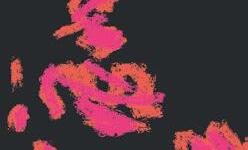





FEMININE HI FI • REGGAEBUS
HIGHER MEDITATION FT.
NIA SONGBIRD & JAH MARNYAH

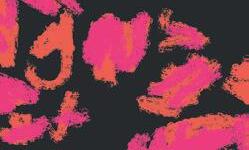
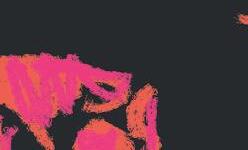
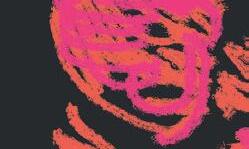
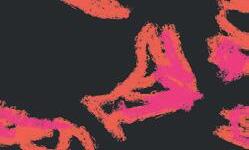
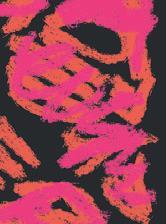
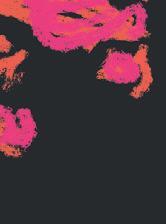
SATURDAY
NATHY PELUSO • SHENSEEA
WERRASON • BURNING SPEAR • JAZZ BRAK

DAVIDO • DENZEL CURRY
CA7RIEL & PACO AMOROSO • TIF
SAÏAN SUPA CELEBRATION • GROUNDATION
KOKOROKO • DINO D’SANTIAGO • GODSON

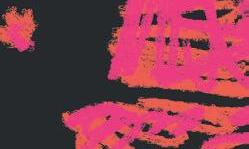
HEAVEN SAM • TSHEGUE • JUNGELI
KYBBA • BAMBII B2B BLCK MAMBA
SAMARA CYN • CRUCIAL ALPHONSO
CAMILLE YEMBE • SUSOBRINO
QUEEN OMEGA & THE ROYAL SOULS

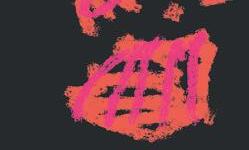
DOCTA G • JOE YORKE • MICAH SHEMAIAH
MANUDIGITAL FT. DAPATCH
LA CREOLE: SYLVERE & MISSY DA KUNT
SUPA MANA • CHATON


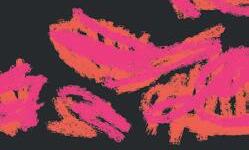
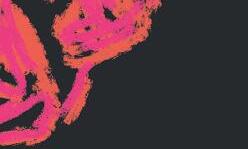
JALEN NGONDA • MAUREEN • NIVEAU4 • AILI
L’ENTOURLOOP • BNNYHUNNA • TIPPY I • MAHOM
MO’KALAMITY • KAREN NYAME KG • JAZMYN
CRYSTALLMESS • YOUTHIE • NOORIYAH
ONDUBGROUND • REGGAEBUS



KOFI STONE • JAH VERSION
RRITA JASHARI B2B CLARA! B2B LARYSSA KIM
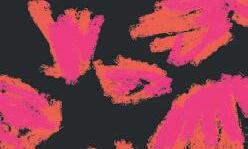
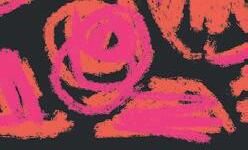
AND SO MUCH MORE...

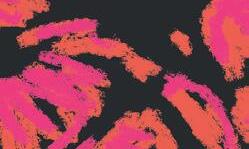

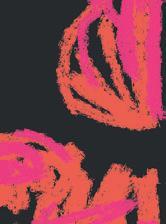
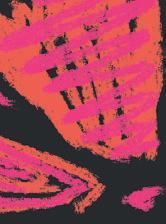
Every May, the European Commission throws open the doors of its Berlaymont HQ for a day of mascots, mock raids and Moomins. Geoff Meade joined the crowds, took the aptitude test—and failed spectacularly. Somewhere between a rocket launch and a tote bag, he discovered Brussels bureaucracy is more Comic Con than Kafka

That’s the kind of clever stuff they teach you at the College of Europe in Bruges, where the future talent behind the European project is nurtured.
Who wants to be a fonctionnaire?
I don’t, not anymore, not after miserably failing the entrance exam to join the elite squads of eurocrats who are shaping Europe’s future.
Of course, the kind people from EPSO, the European Personnel Selection Office, were much too polite to say so after I had completed a gruelling written test at the European Commission’s Berlaymont headquarters in Brussels.
When I’d finished the 10-question paper (beating the 15-minute time limit!), I apologised to one of the EPSO supervisors for only scoring a pathetic four correct answers out of ten. He smiled sympathetically and told me not
to worry because, as he smoothly observed, my score of four out of ten actually works out at an overall 40%, which doesn’t sound too bad at all. Now that’s the kind of clever stuff they teach you at the College of Europe in Bruges, where the future talent behind the European project is nurtured.
I immediately felt better about my score if not about myself, and I gratefully accepted the consolation prize of a rather elegant blue denim tote bag containing a gift of a copy of the exam questions and the right answers. It was the start of several hours spent in the Berlaymont for this year’s Open Doors Day event in May, when the public crowded in to Geoff Meade
learn all about what the Commission does, why it does what it does, and how it all works. Similar events took place at the other institutions in Brussels, including the European Parliament and the EU’s Council of Ministers.
It doesn’t sound like much fun, but imagine a bit of Disneyland, a few drops of Comic Con (one of those massive comic book-themed conventions, a version of which was coincidentally happening at Tour & Taxis downtown on the same day), a dose of school sports day, a sense of Walibi Belgium amusement park and a smidgeon of Plopsaland De Panne theme park and you get the idea. And you don’t have to pay anything to get in.
Admittedly Disney has Mickey Mouse and Donald Duck all year round, and Comic Con Brussels had real live celebrity guests including John Boyega from Star Wars, but the Commission matched that with a life-sized cardboard cutout of its president, Ursula von der Leyen, in a plum-coloured business suit and a big smile, for people to pose with for a souvenir photo.
In the absence of the real Ursula, who lives in a penthouse atop the Berlaymont but was not at home at the time, a steady stream of punters seemed genuinely chuffed to be in such company, albeit the pulped paper version.
There was also a cardboard cutout of Europa, the latest EU official mascot who looks like a mischievous schoolgirl with yellow haystack hair in a top-knot, wearing a Superwoman blue cloak with the EU gold stars on the back.
Her creators describe her as bold, intrepid and bubbly, embodying EU values of a sustainable, connected, inclusive and secure world, and blending European unity and Japanese-inspired style.
Why Japanese? Because, after spending much of this year so far on a world tour of EU delegation offices, Europa is, at the time of writing, in the middle of a six-month stint starring at the EU Pavilion at World Expo 2025 in Osaka, Japan which ends in mid-October. Her specific task is to inspire people everywhere with the EU’s mission to “nurture tomorrow”.
If all this promotional stuff seems a bit corny and over-the-top, just check out the number of visitors to this year’s open day at the Berlaymont. The lines of people, mostly families with young children, snaked up the slope beside the Commission towards the Schuman roundabout long before the event opened.
If bronze busts could smile, that of EU founder Robert Schuman at the entrance to Cinquantenaire Park, within sight of the Berlaymont, would be grinning from to ear. Either that or grimacing about the frivolous lengths 20th century politicians now go to win the hearts and minds of ordinary citizens.
What would he have made, for instance, of the jugglers and stilt walkers and the opera singers belting out the adopted EU anthem of Beethoven’s Ode to Joy, not to mention a live four-piece band and the Finnish Moomin
family parade, which, I had to be told, is a revered cast of comic strip characters who are described by their author as “white and roundish with large snouts” and were a big draw for the tiny tots.
And that was just in the Berlaymont grounds. Inside, most Commission Directorates-General (DGs) were represented, and exhibits ranged from a 1:20 scale model Ariane 6 rocket which launches EU satellites into space to a video game on fighting superbugs – lengthy queues of kids for that one. There was a mock-up café where visitors were invited to try to steal personal information so that they could hack the identity of someone who had supposedly left their belongings behind at their table.
There were more queues of excited kids waiting to jump into a search and rescue swing simulating a helicopter air lift winch from disaster, and a virtual reality experience tour of laboratories offering alternatives to animal testing.
There were real live search and rescue dogs from Spain and a three-by-three metre LED
If bronze busts could smile, that of EU founder Robert Schuman at the entrance to Cinquantenaire Park, within sight of the Berlaymont, would be grinning from to ear.
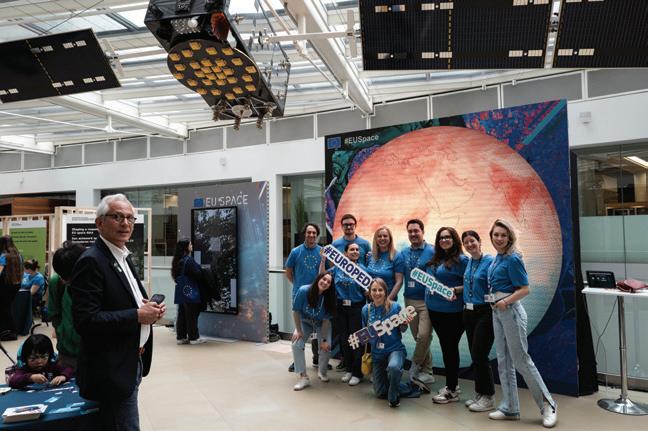
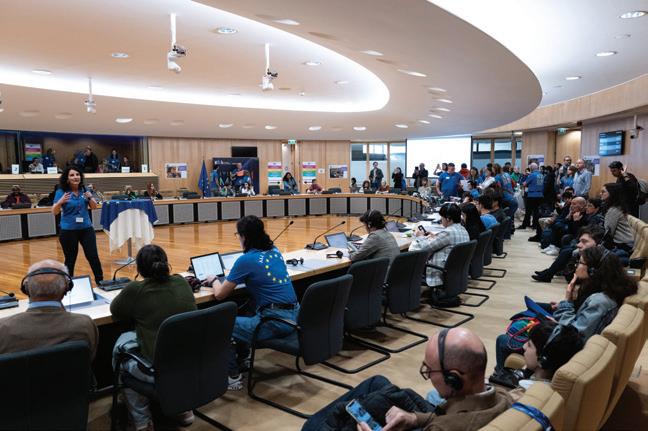
The clear public relations success of the venture means that more and more small and mediumsized children in Brussels are growing up with a glowing image of the institution a nothing more than a giant, exciting, thrillsand-spills playpark.
screen with climate earth views from satellites into space.
There was also a staged office where visitors were invited to take part in a dawn raid competition cartel.
Oh yes, and the Commission press bar, where I spent so much of my working life, had been partly converted into a mini hockey pitch for kids to take a swing or two, guided by a professional player from Sweden. The aim was to demonstrate the benefits of being an EU citizen.
When I asked how a hockey game reflects EU citizenship, the explanation was that the hockey player was multi-national who studied in a third country and then was able to play and work in multiple countries in the EU – a European free movement scenario which probably went over the heads of the delighted youngsters enthusiastically thwacking the hell out of the parquet floor.
And so, the carnival mood continued throughout the day, and by the time it was over the head count was, according to the Commission, approaching 18,000 visitors, compared with about 12,000 last year.
Some cynics said a lot of the visitors were current Commission officials feeling obliged to turn up with their families to wave the flag for the cause. But apart from organised groups of supporters from various EU fan clubs the bulk were ordinary folk on a day out with kids to entertain: they looked like people more likely to head for the Belgian coast or the Ardennes on such a day. Or Comic Con.
The authentic eurocrats that were present were those overseeing their particular sectoral policy displays, demonstrating working models and explaining why it all matters to an amazingly wide-raging audience including lots of genuinely interested visitors from way be-
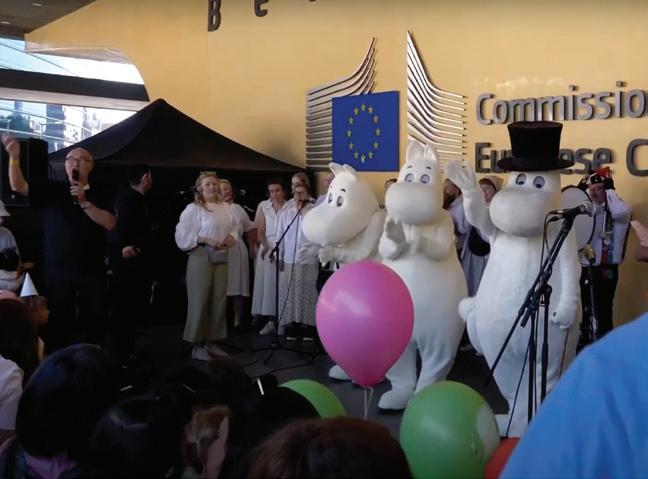
For centuries after, Eurocrats would speak in hushed tones the majestic Moomins
yond even the outer reaches of the EU’s member states and list of accession candidates.
Undoubtedly the least animated place of all –intentionally so - was the classroom-like feel of the EPSO stand where I started the day. No jolly games or music or make-believe scenarios here to catch the attention – just four ominous computer screens on a desk awaiting victims. As it happened, I was the first person to approach the EPSO team and ask to take an aptitude test for a position of high EU power.
I asked my host if I was allowed to take the EPSO test even though I’m way too old for a job unless the Commission creates a DG “Troisième-Age” which needs a Head of Unit, and he said that I could, so I sat down at one of the four computers.
And so, the nerve-wracking 15-minute countdown began.
I’m not sure what I expected: maybe a few easy questions, such as, who is the president of the Committee of the Regions and why?
Or, what does the acronym FEOGA stand for?
Or, how many windowpanes are there in the Berlaymont?
Or, averaged over a decade, how much money would EU taxpayers save if all EU institutions were in one European city at the same time?
Instead I was confronted with brain-numbing puzzles about relative GDP ratios between EU member states (“numerical reasoning”); choosing the next in a sequence of black blobs in boxes (“abstract reasoning”) ; and something to do with something called the Least Squares Method, described on the test paper as a statistical method for a straight line or curve that best represents a relationship between two measured quantities (“verbal reasoning”).
And as I puzzled over the puzzles, the clock in the corner of the computer screen was taking me relentlessly down to zero seconds. (How many seconds are there in 15 minutes? Um errr, hang on, errr 900!”).
Anyway, thanks to EPSO for reassuring me that I chose the right career path and for giving me a copy of my dismal exam paper. Next time I’m in the company of an established fonctionnaire or three, we will see how they score.
Meanwhile, I’m very good at logical reasoning and it’s obvious to me that there’s a clear recruitment flaw in this open doors strategy. The clear public relations success of the venture means that more and more small and medium-sized children in Brussels are growing up with a glowing image of the institution a nothing more than a giant, exciting, thrills-andspills playpark.
As a result, some of them will be encouraged in adulthood to pursue jobs in the Commission – until the shattering moment when they find out that, apart from one very special day every year, all the fun and games, and all the toys, have been taken away...
